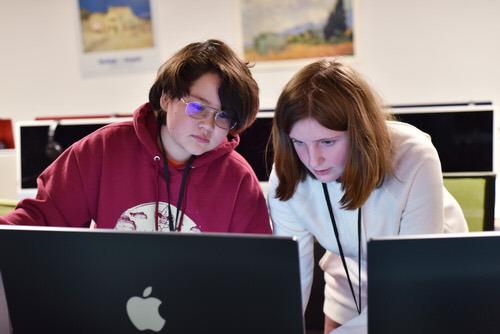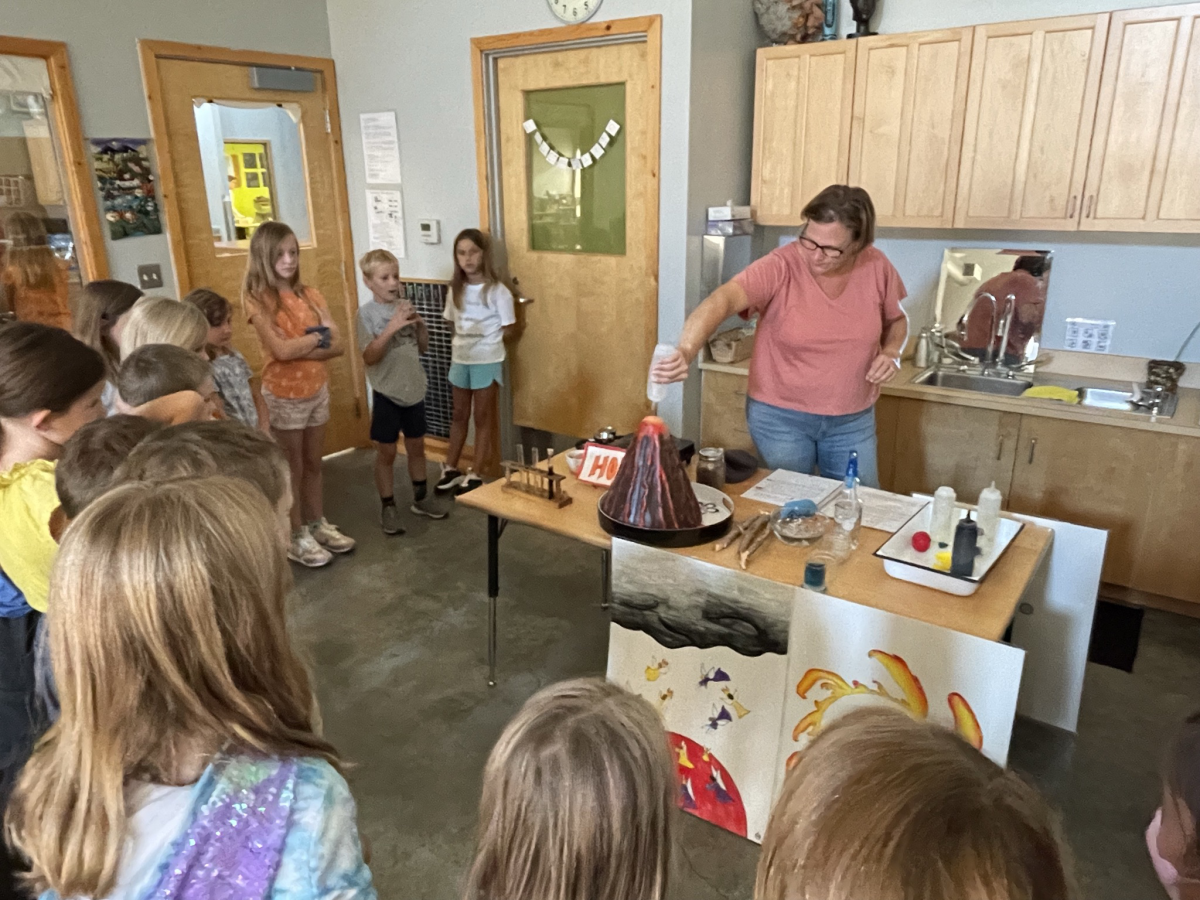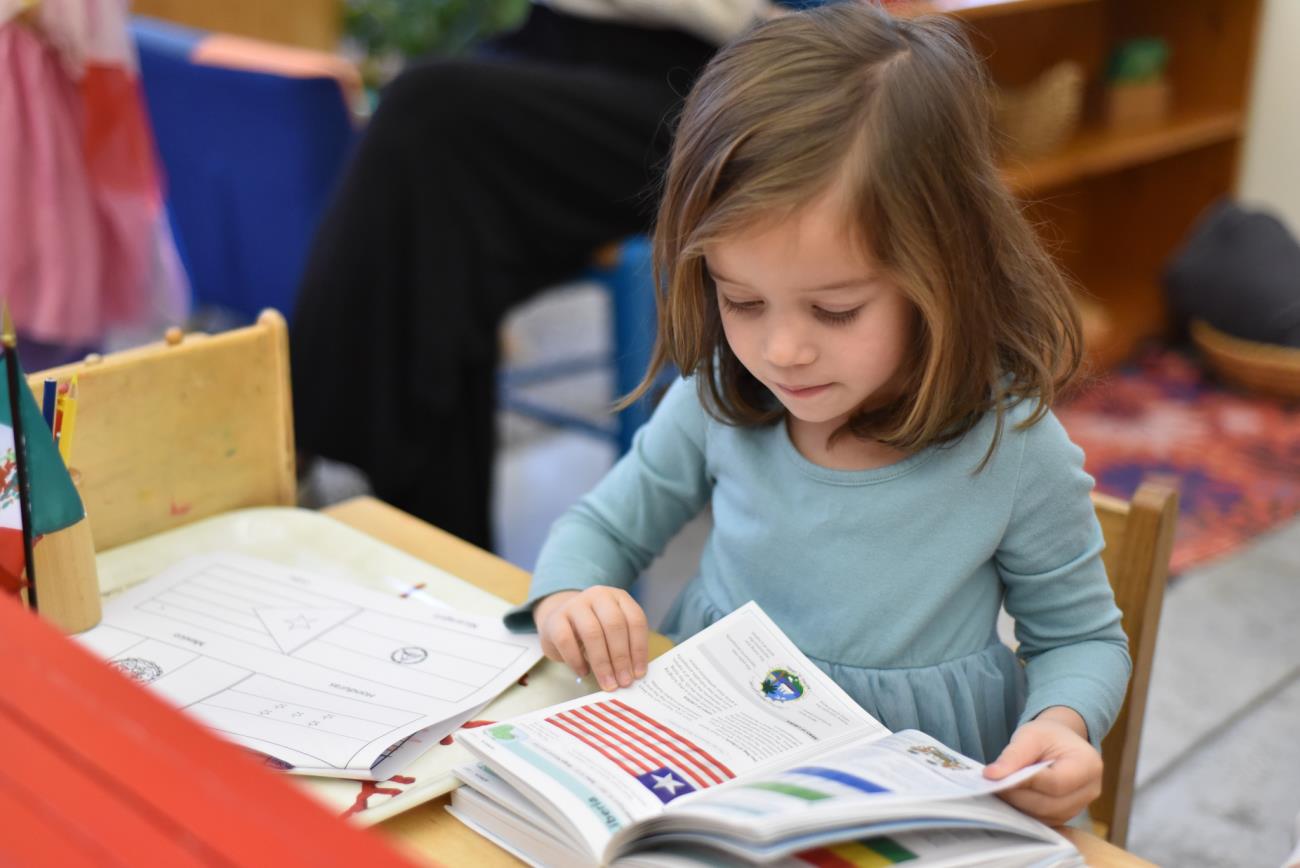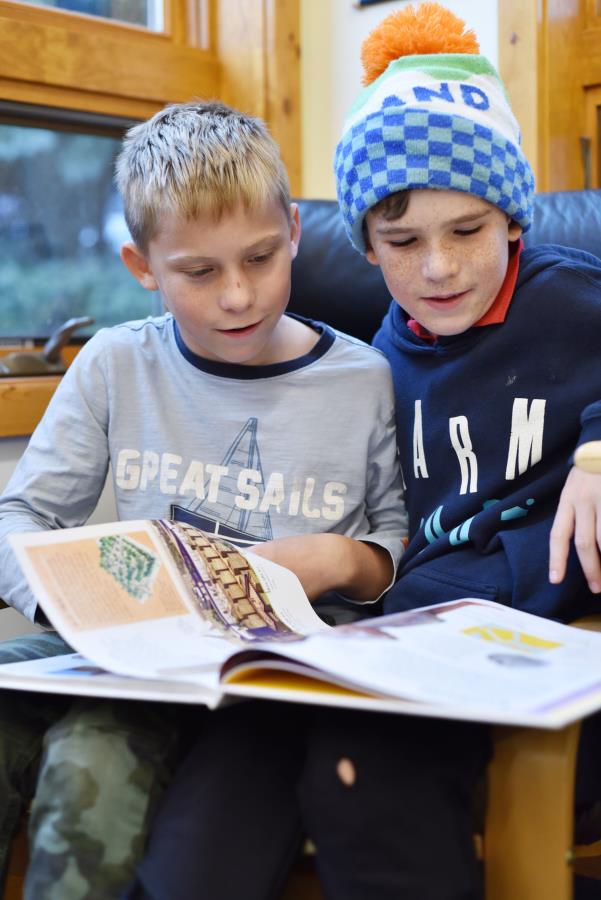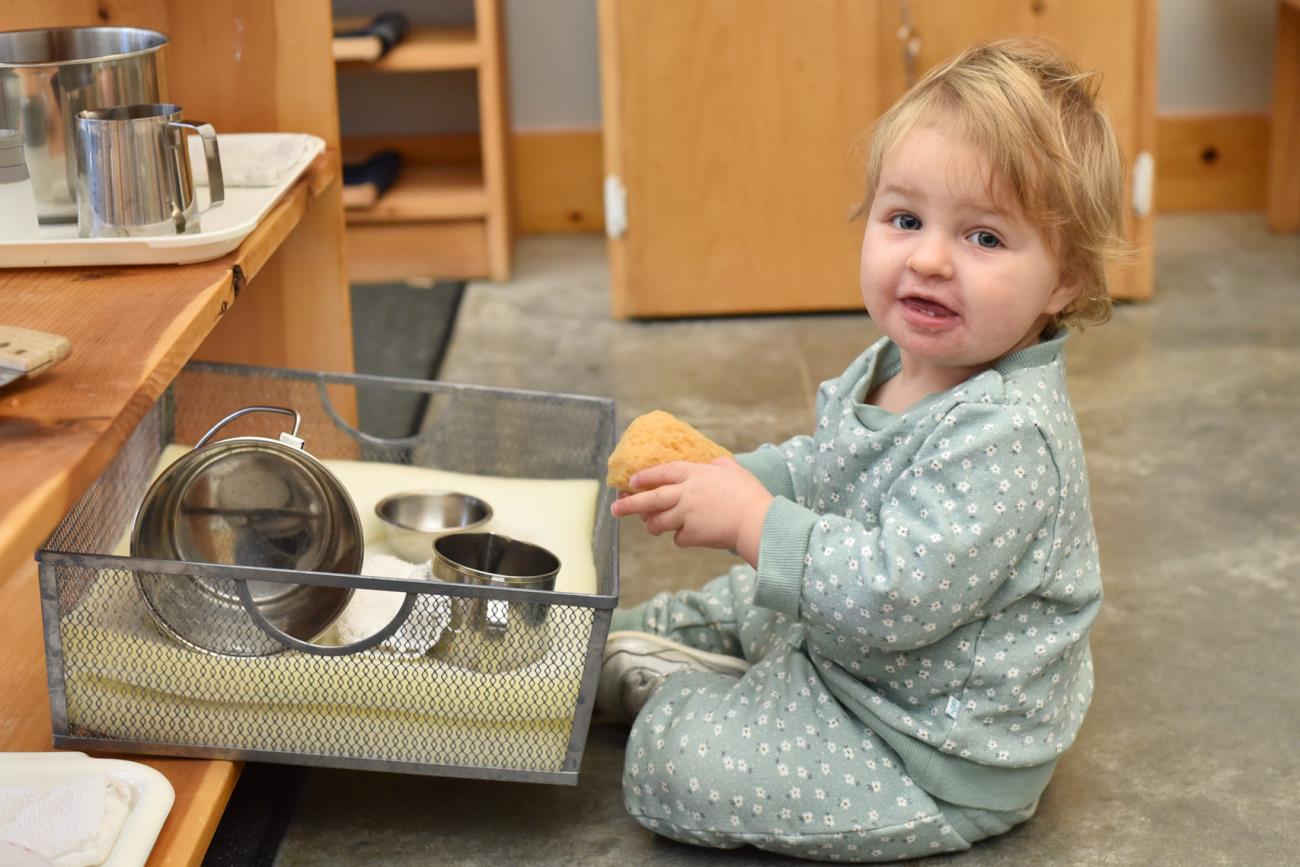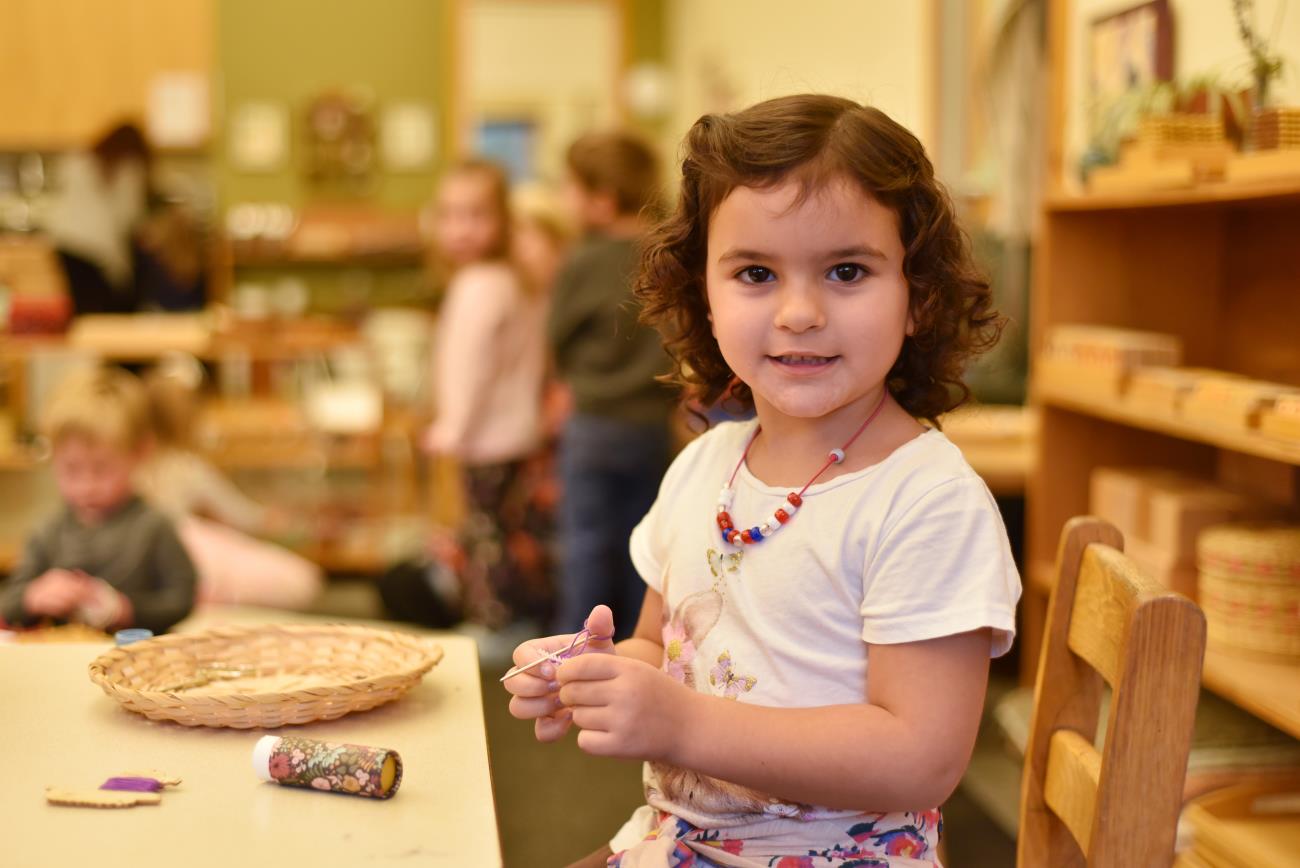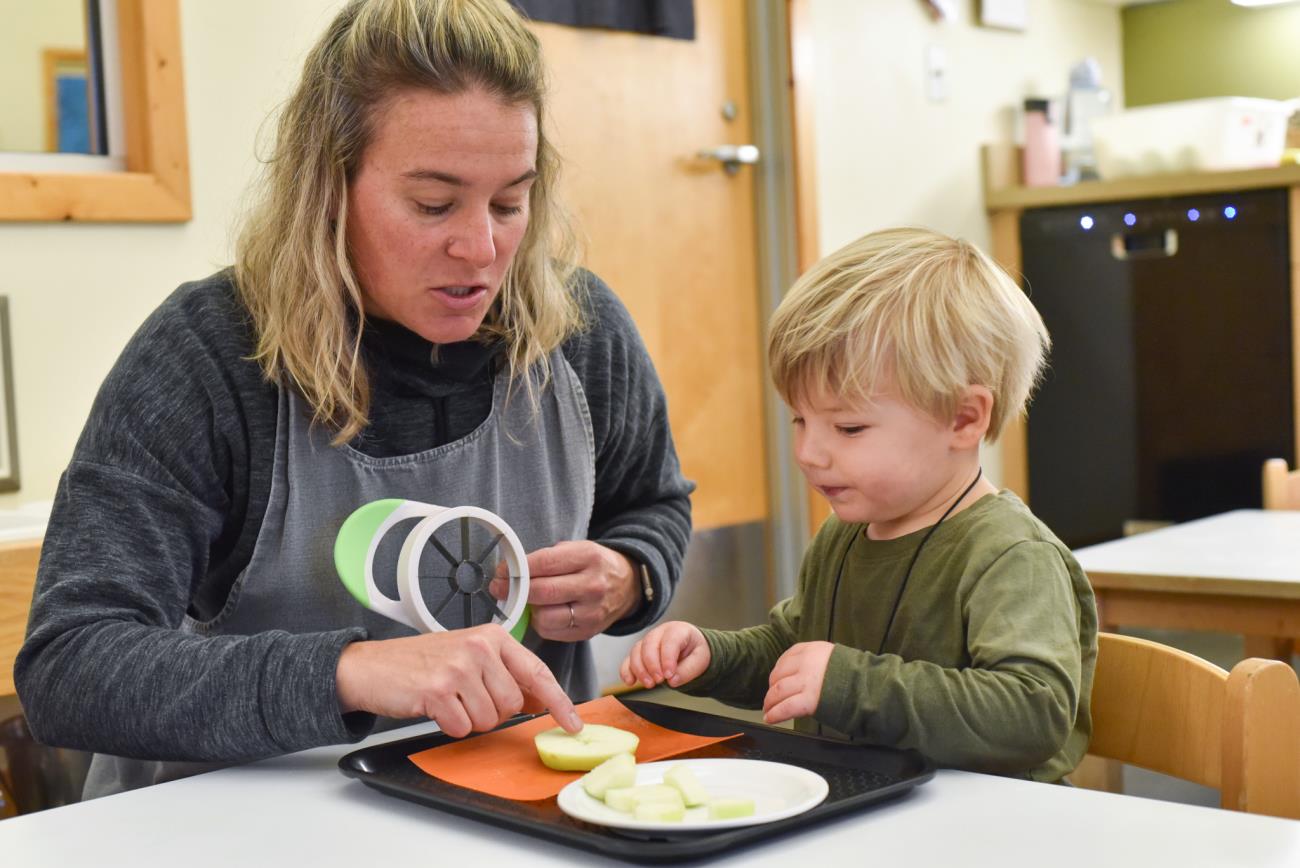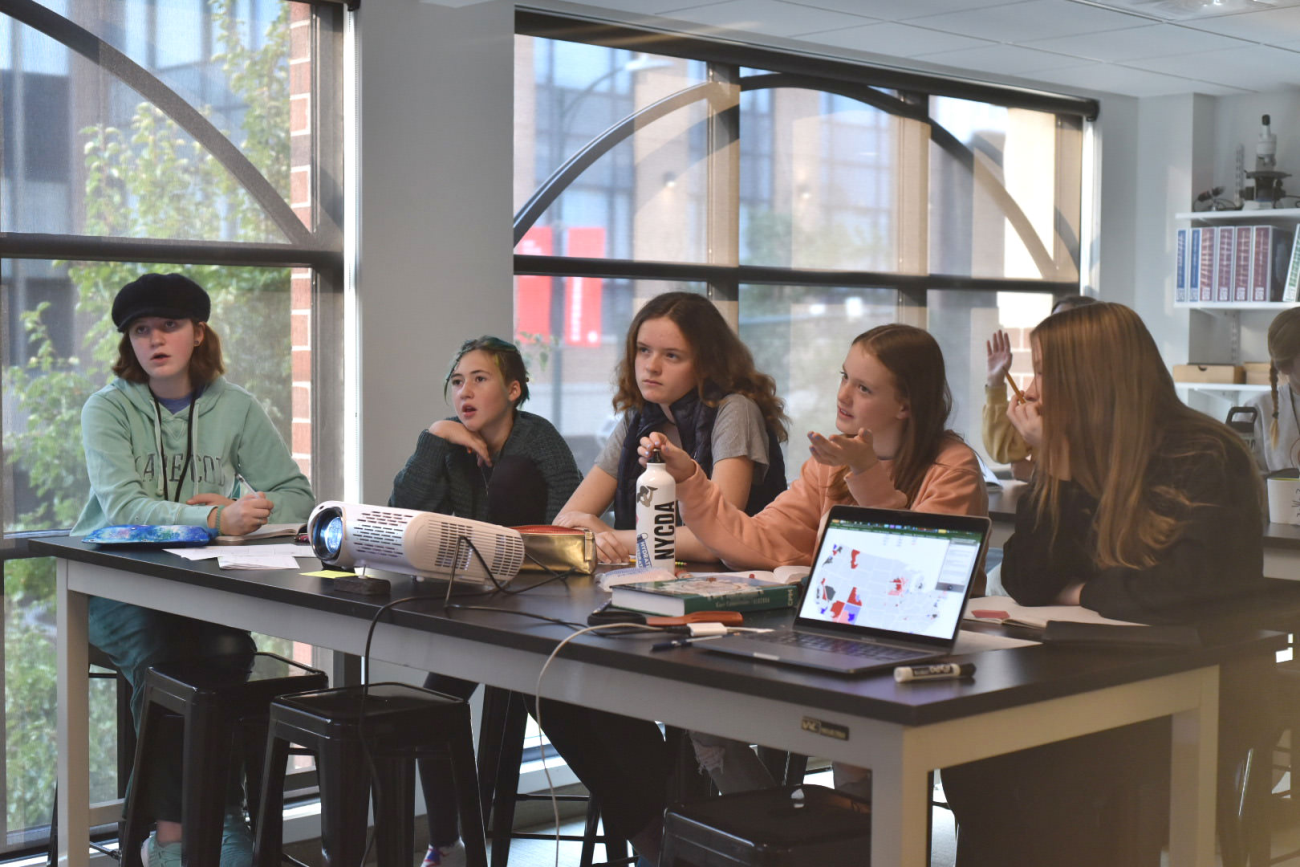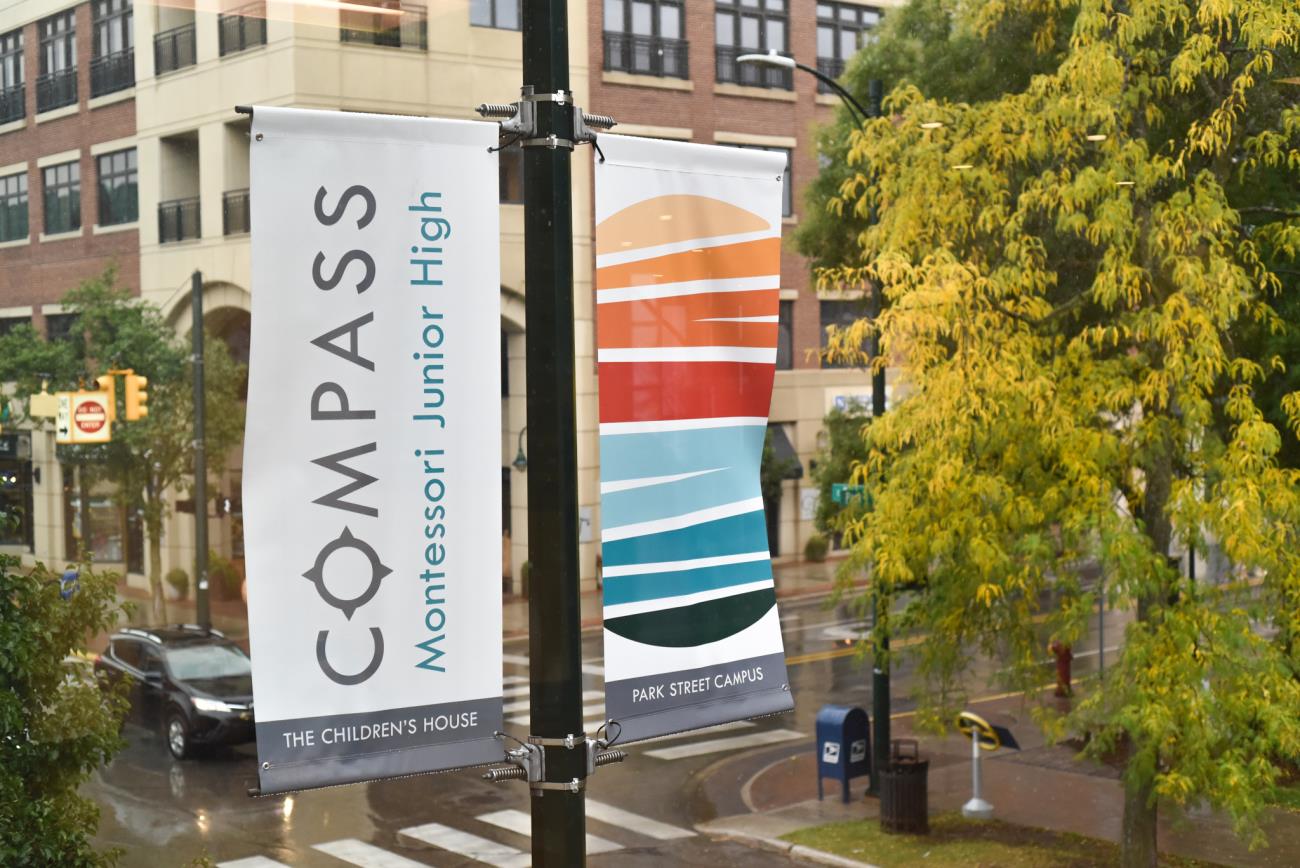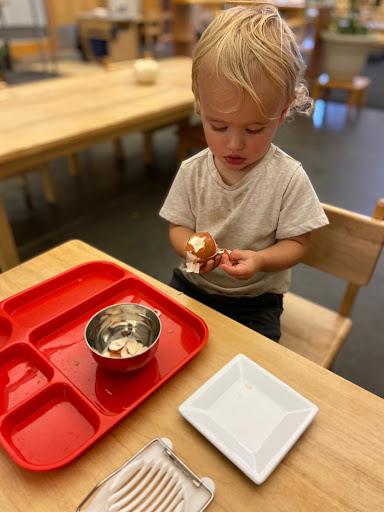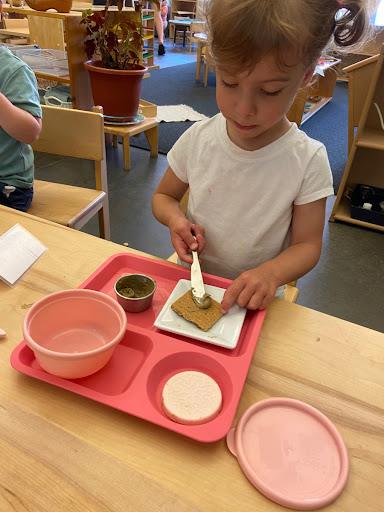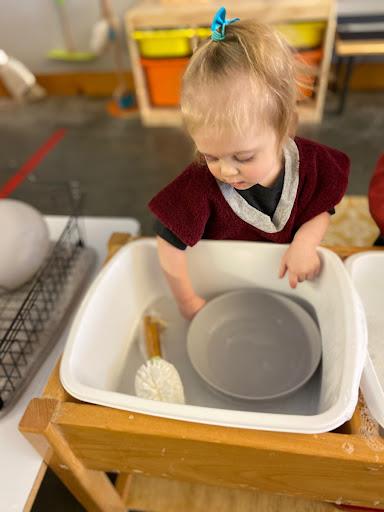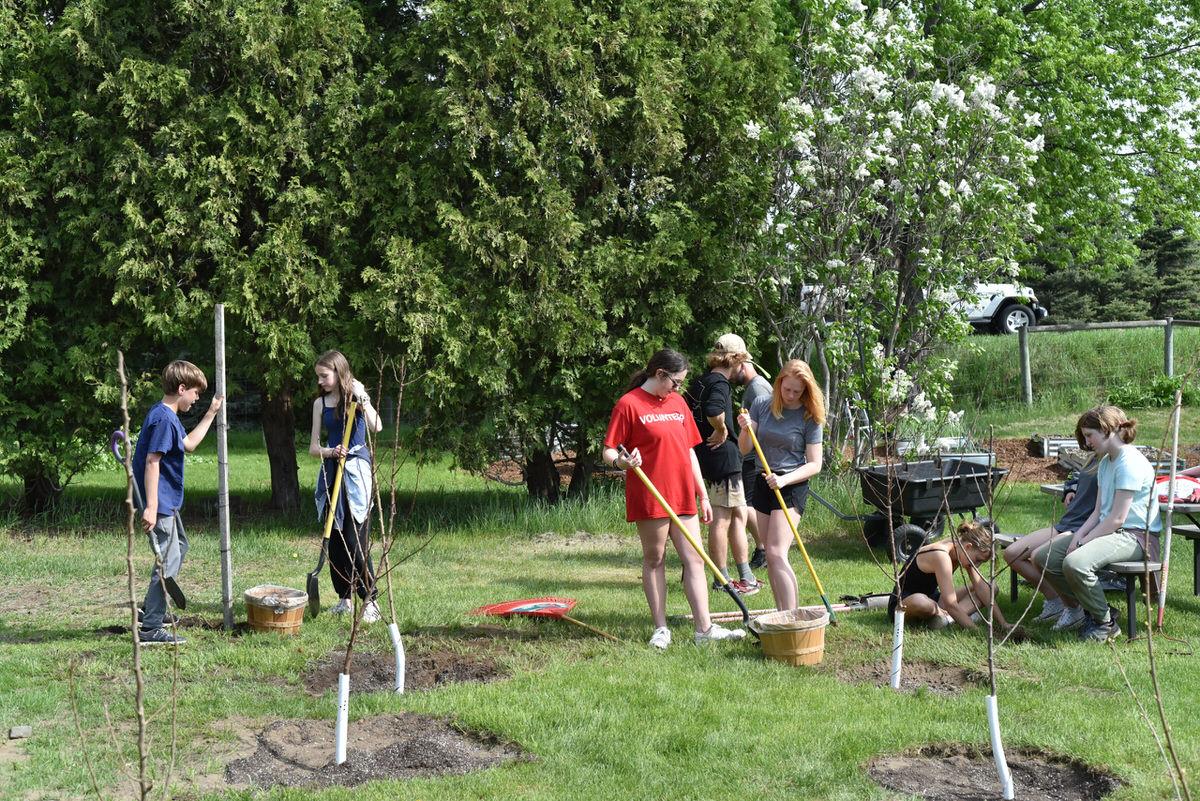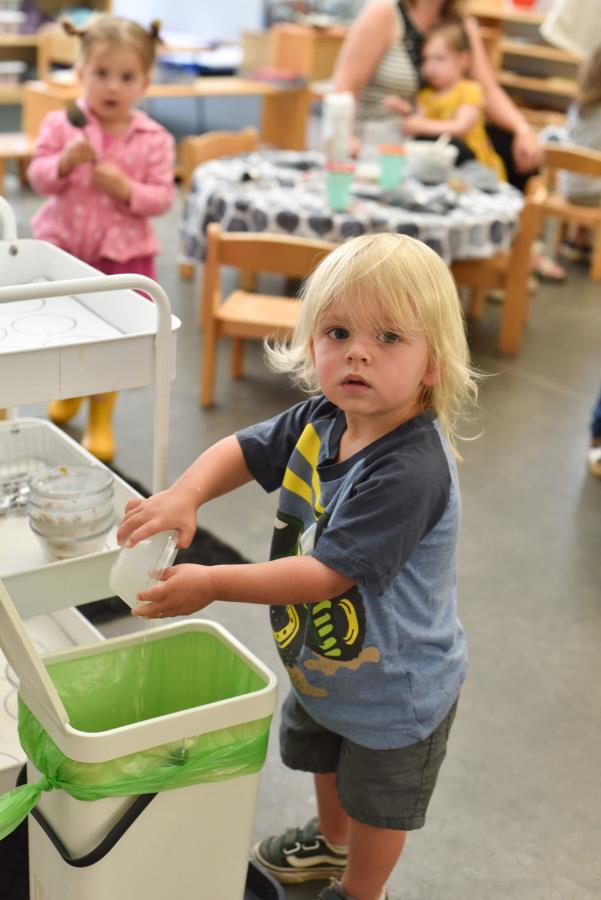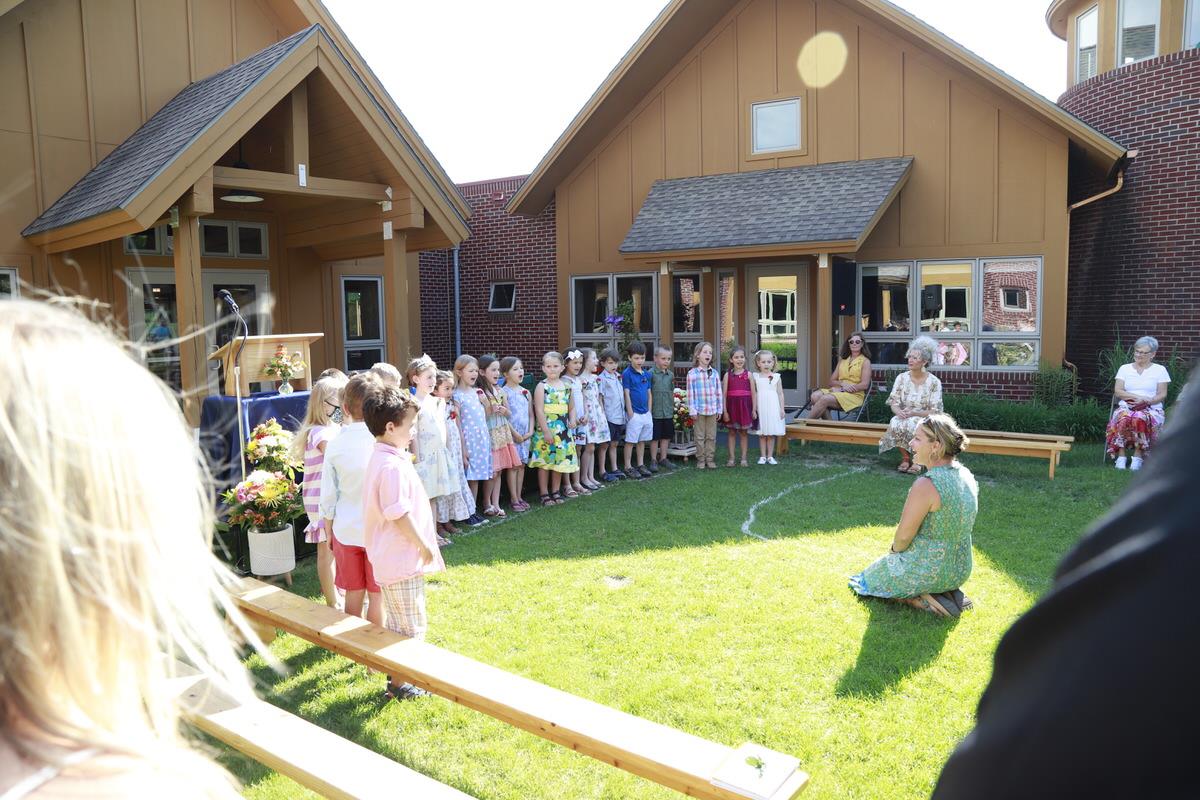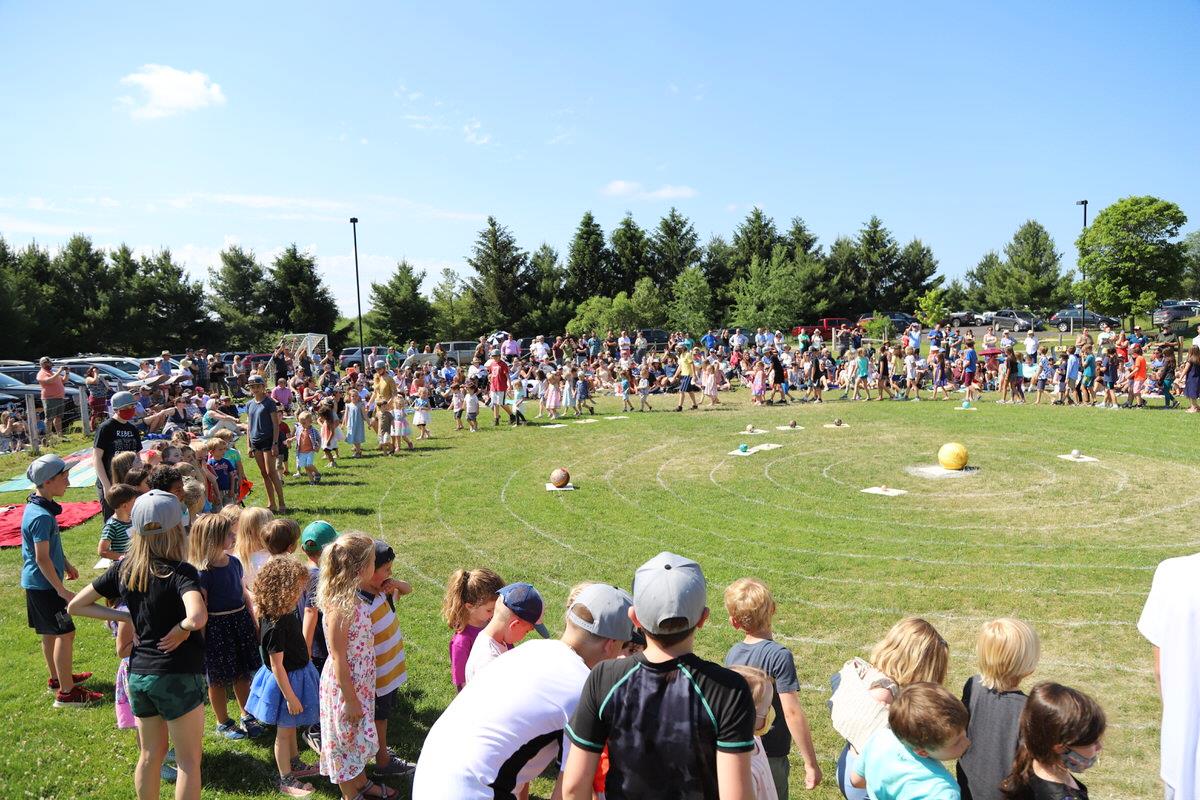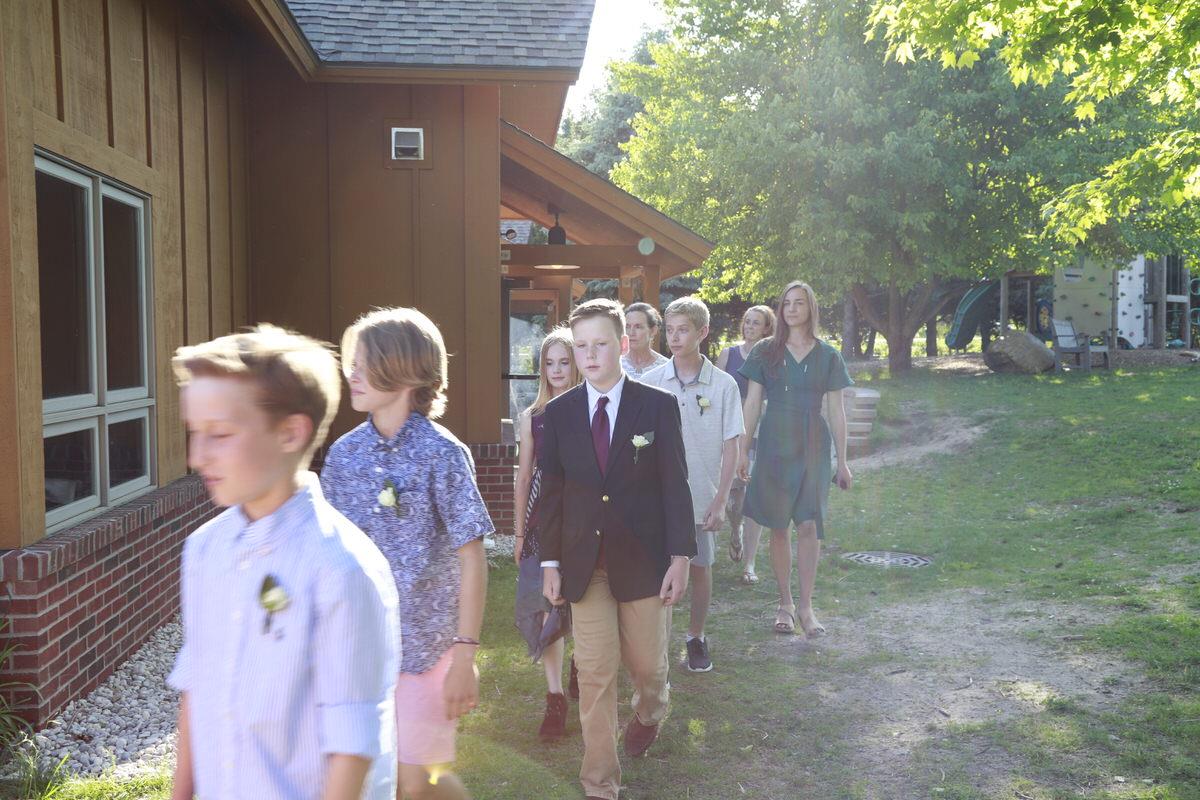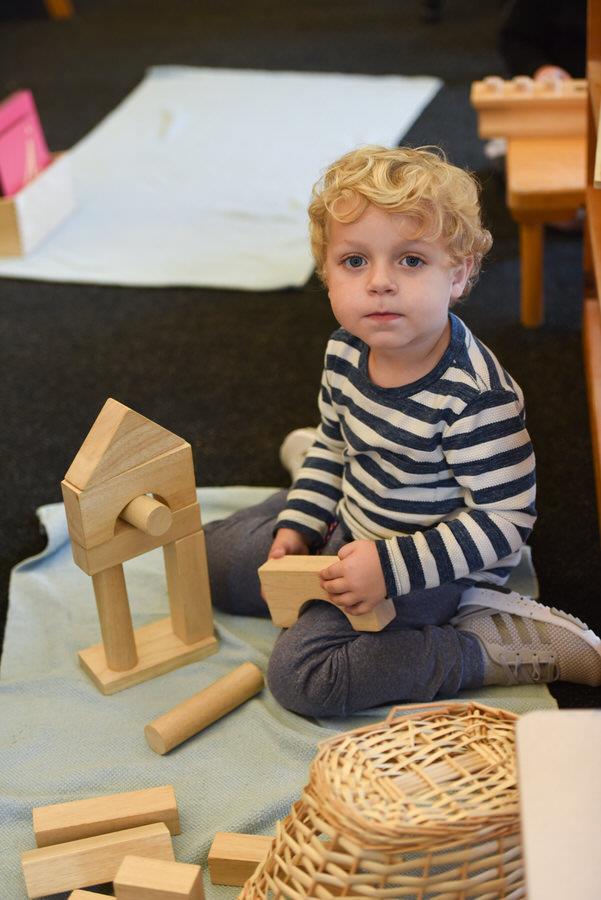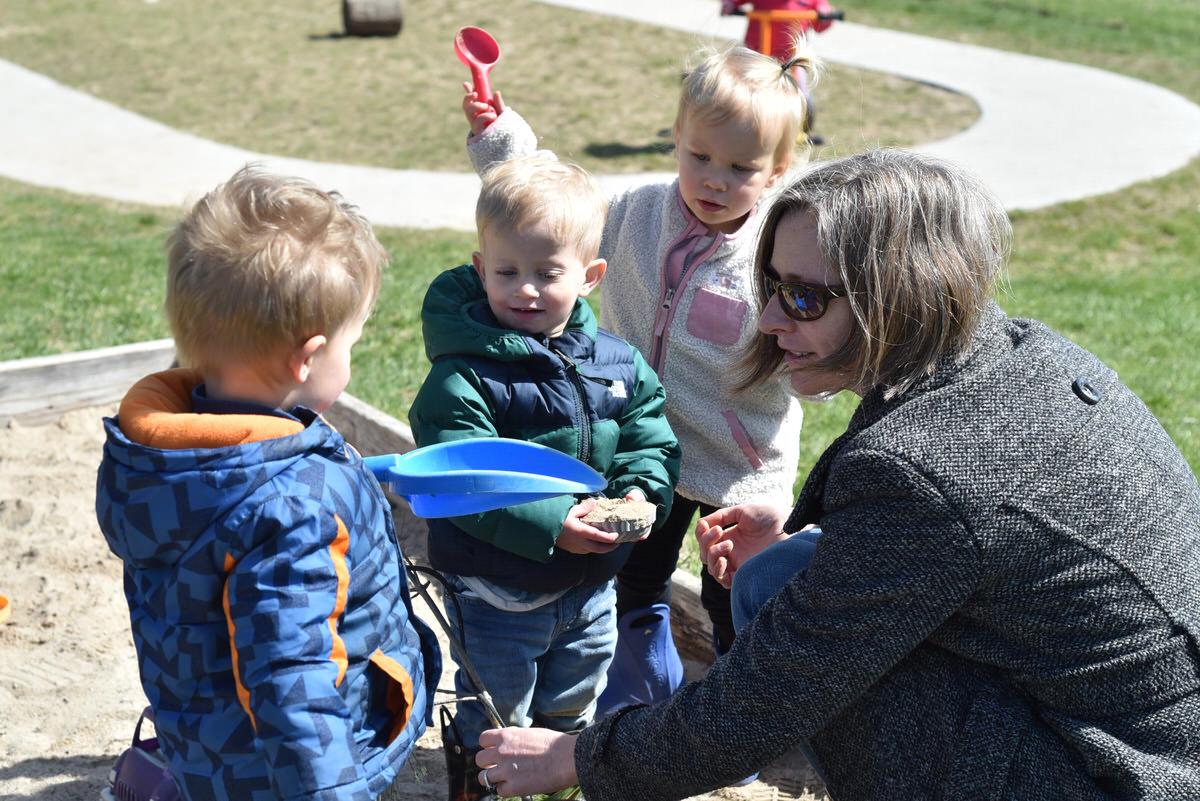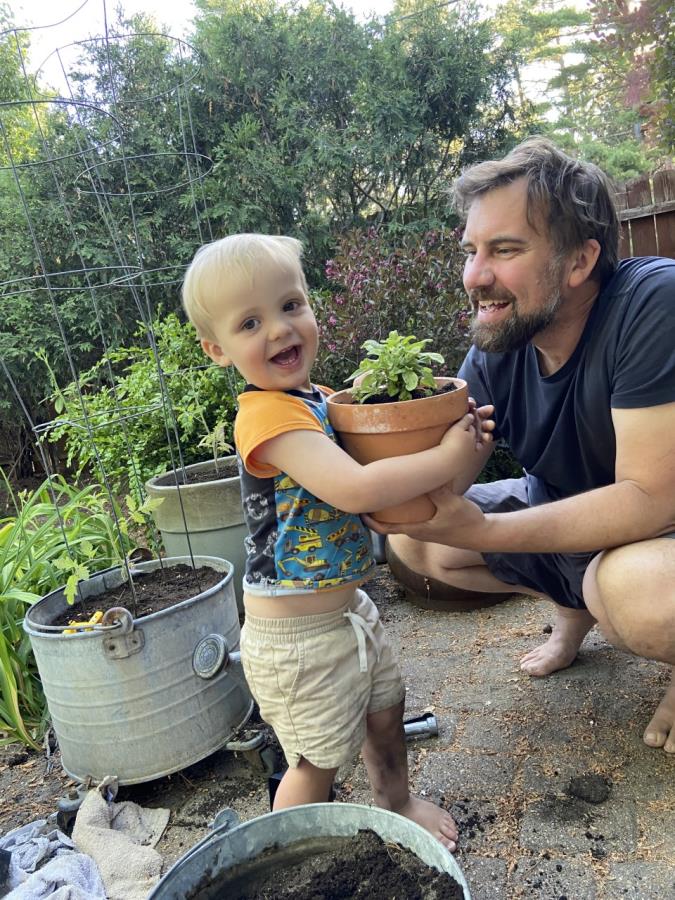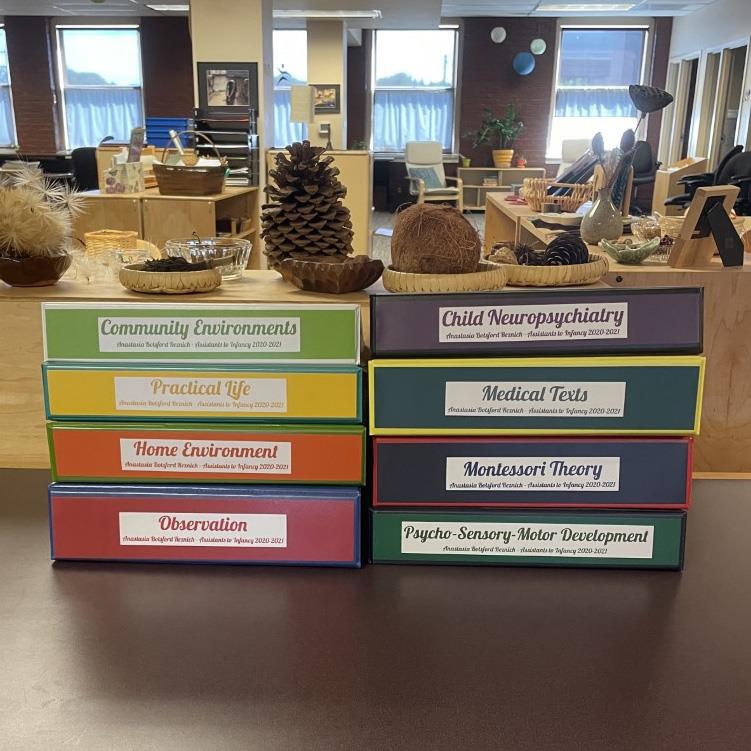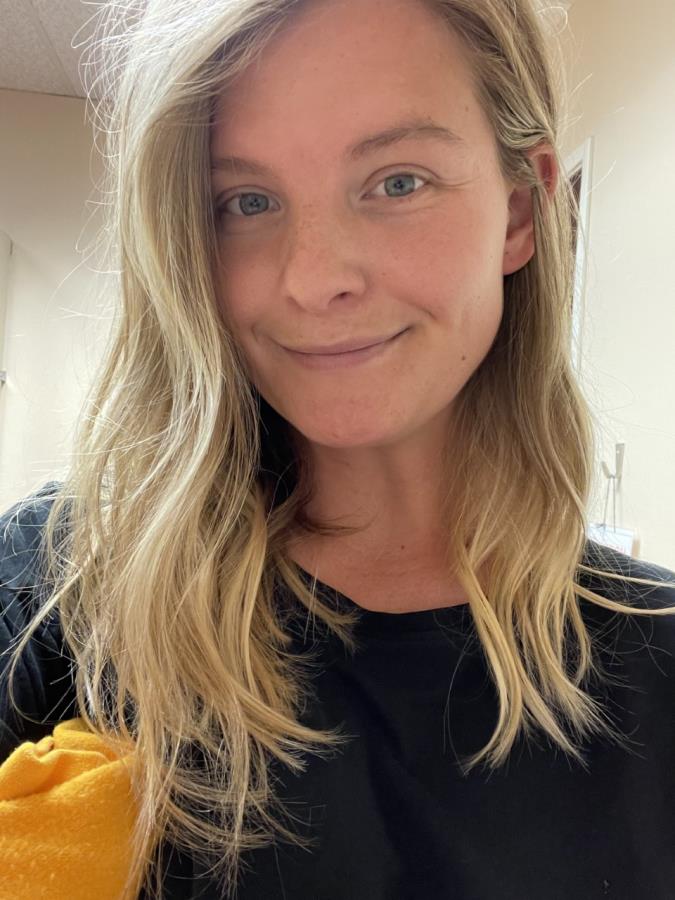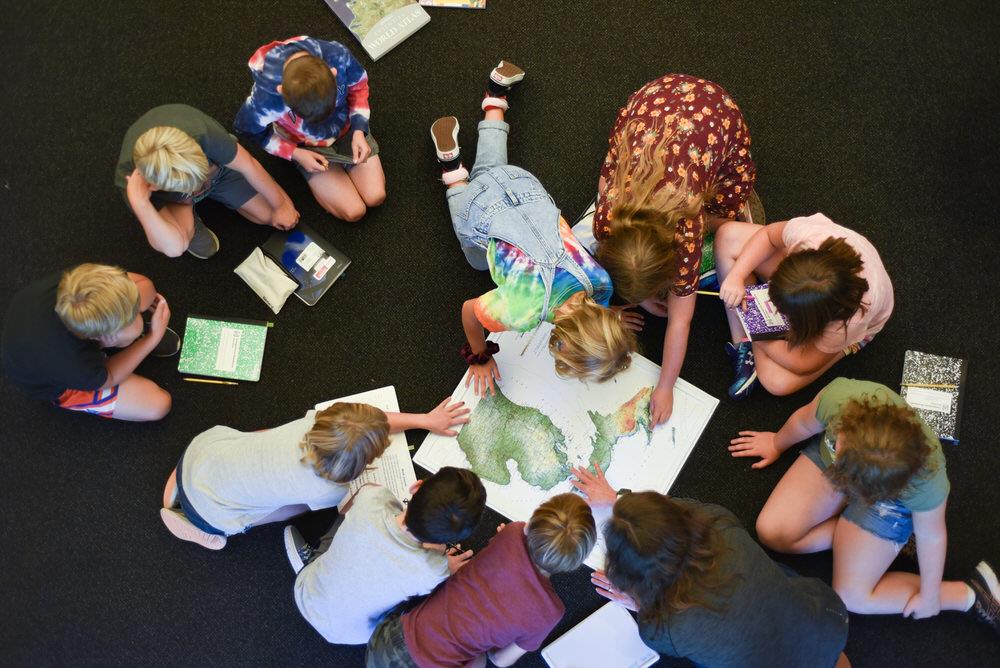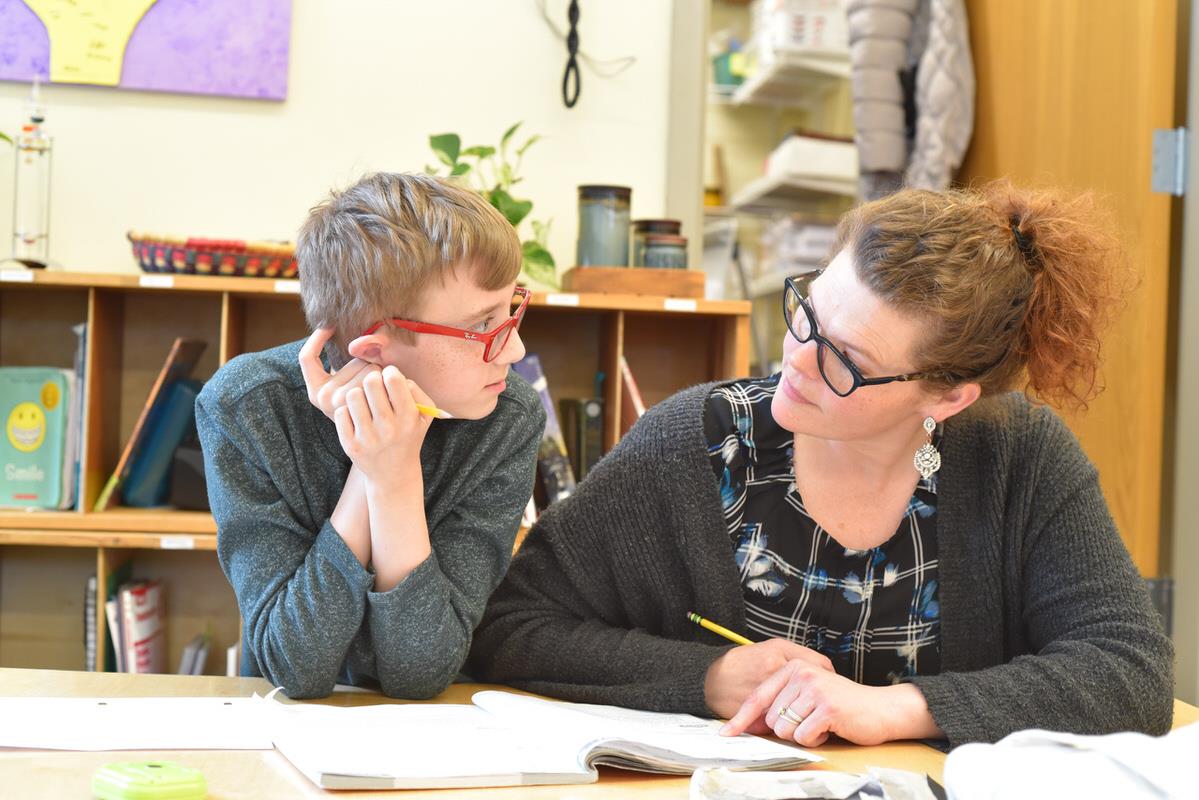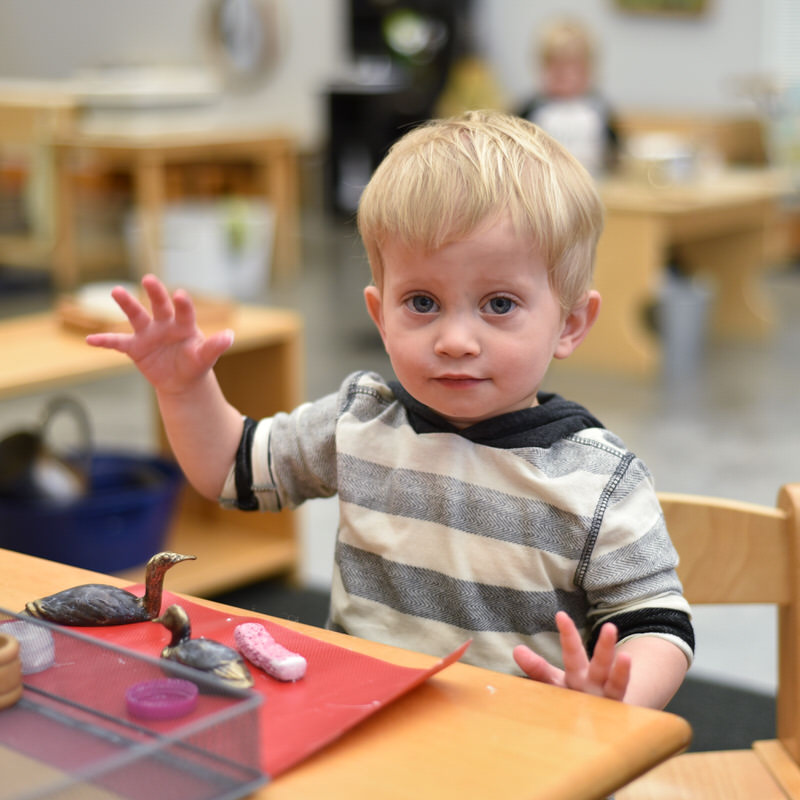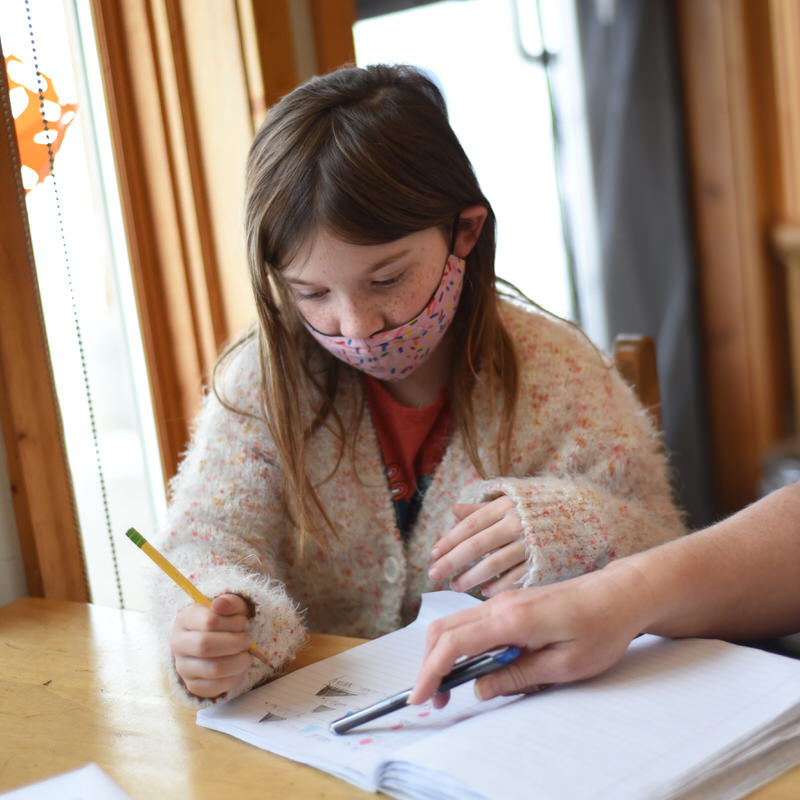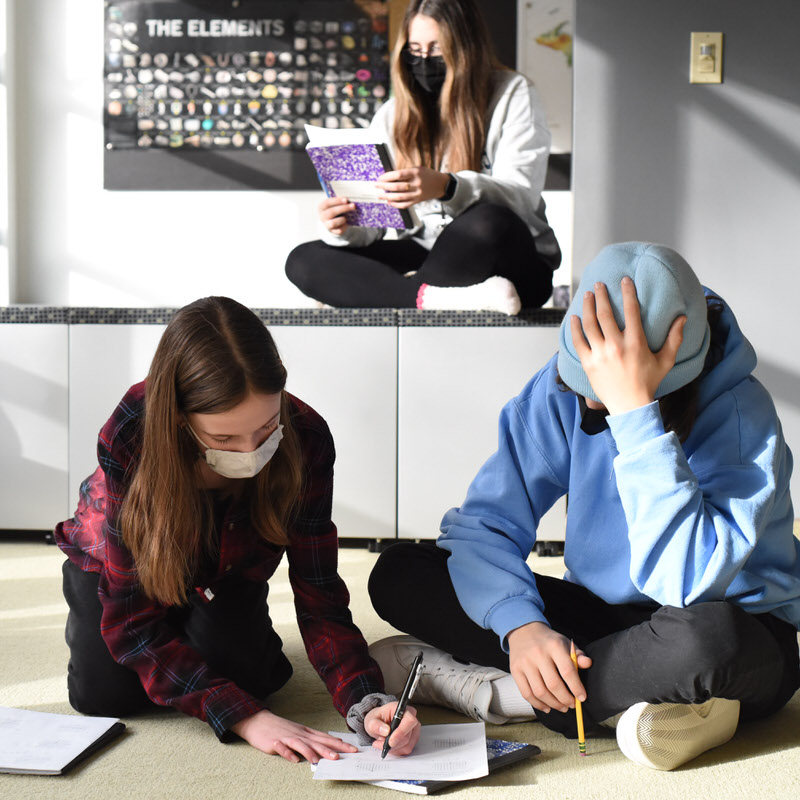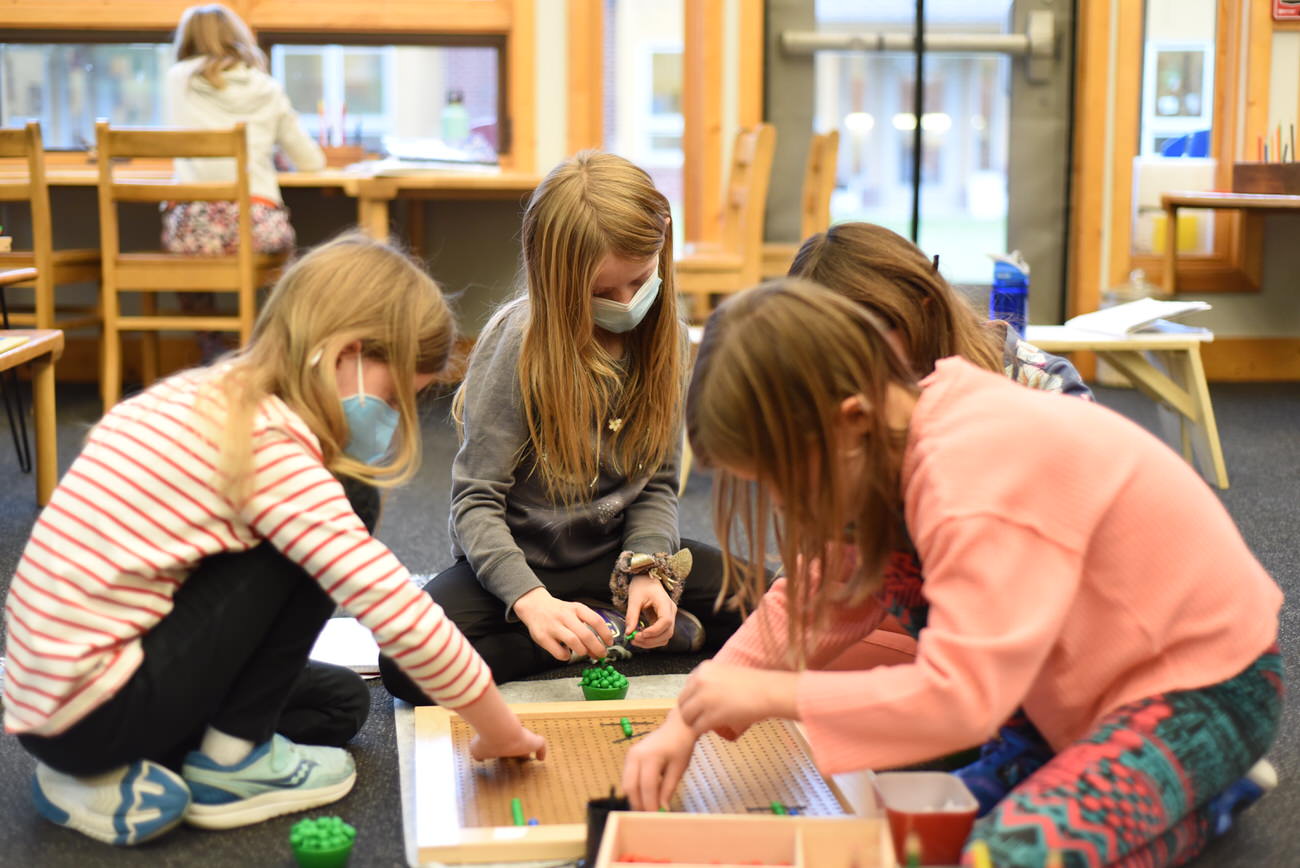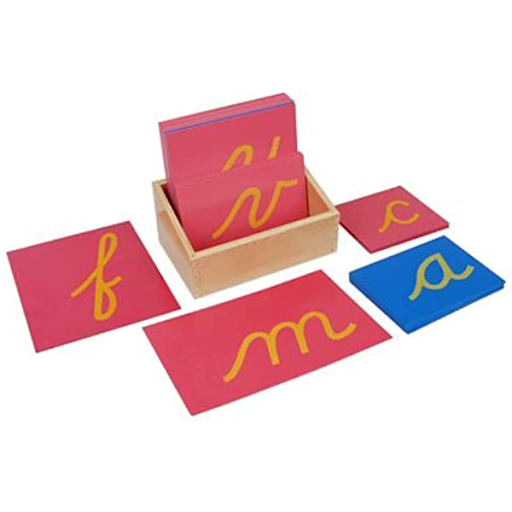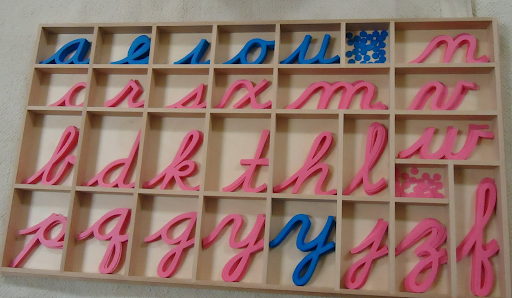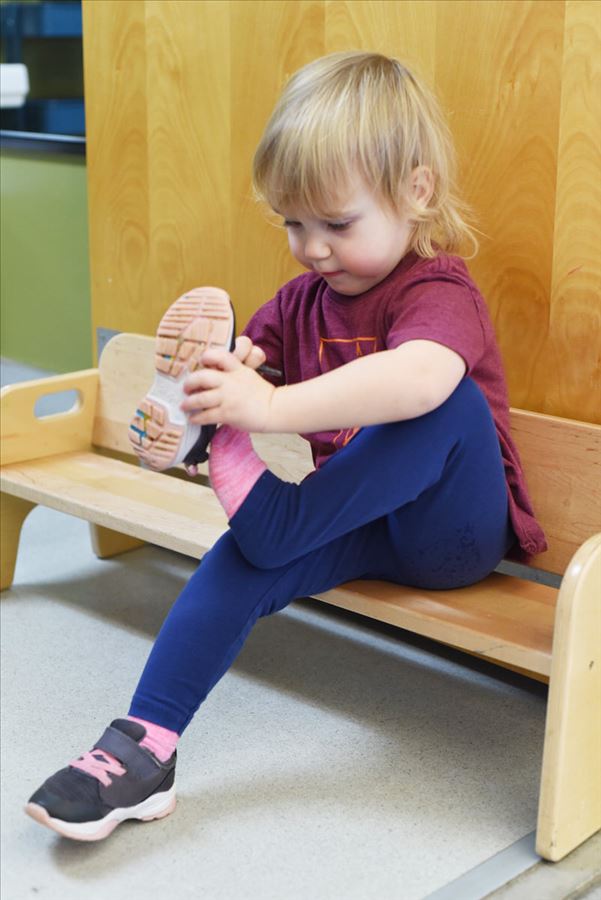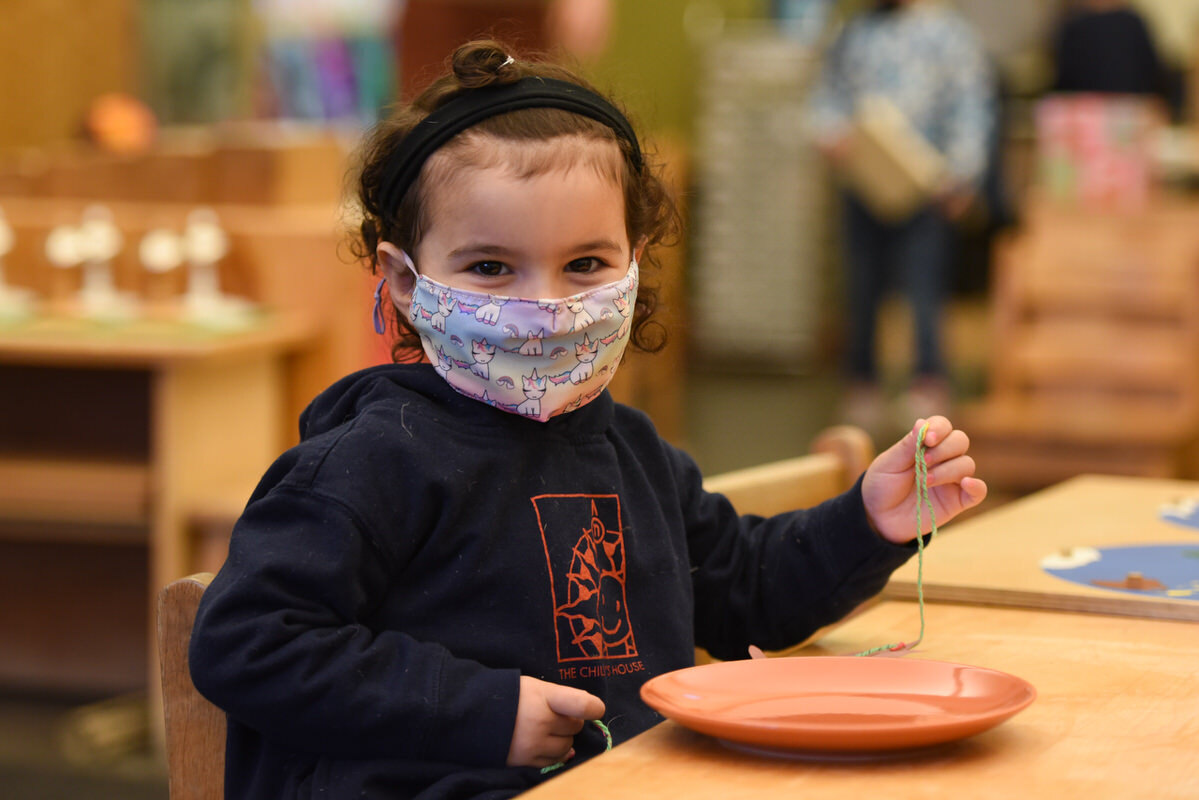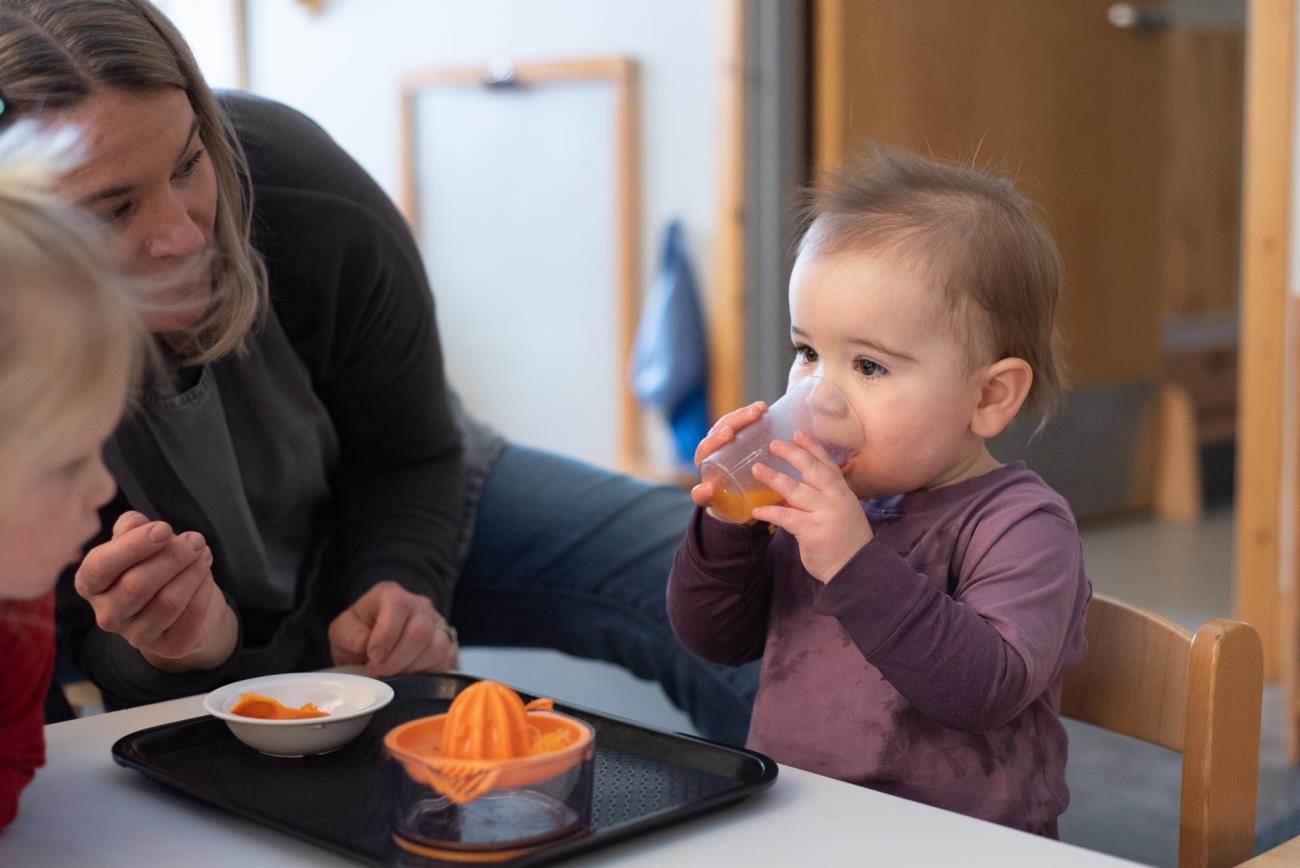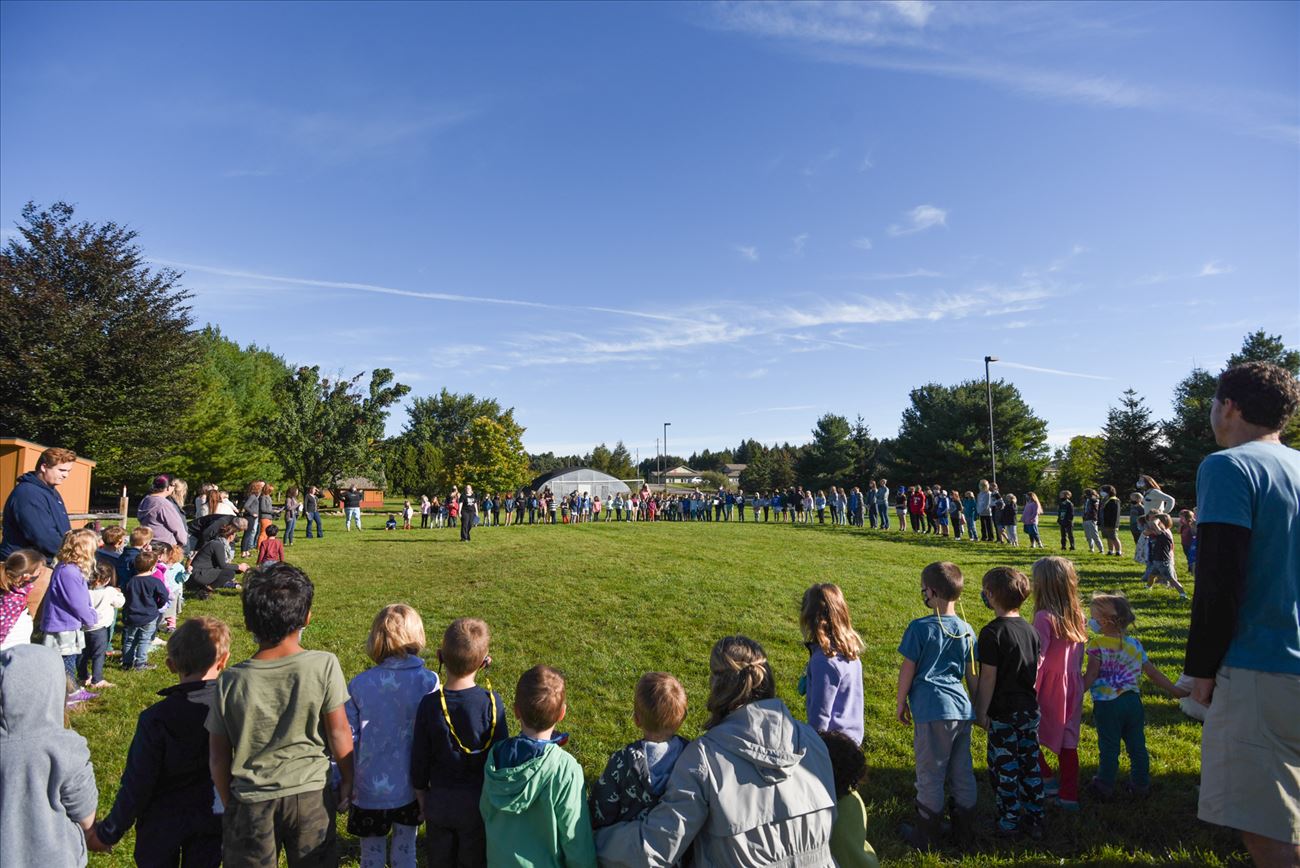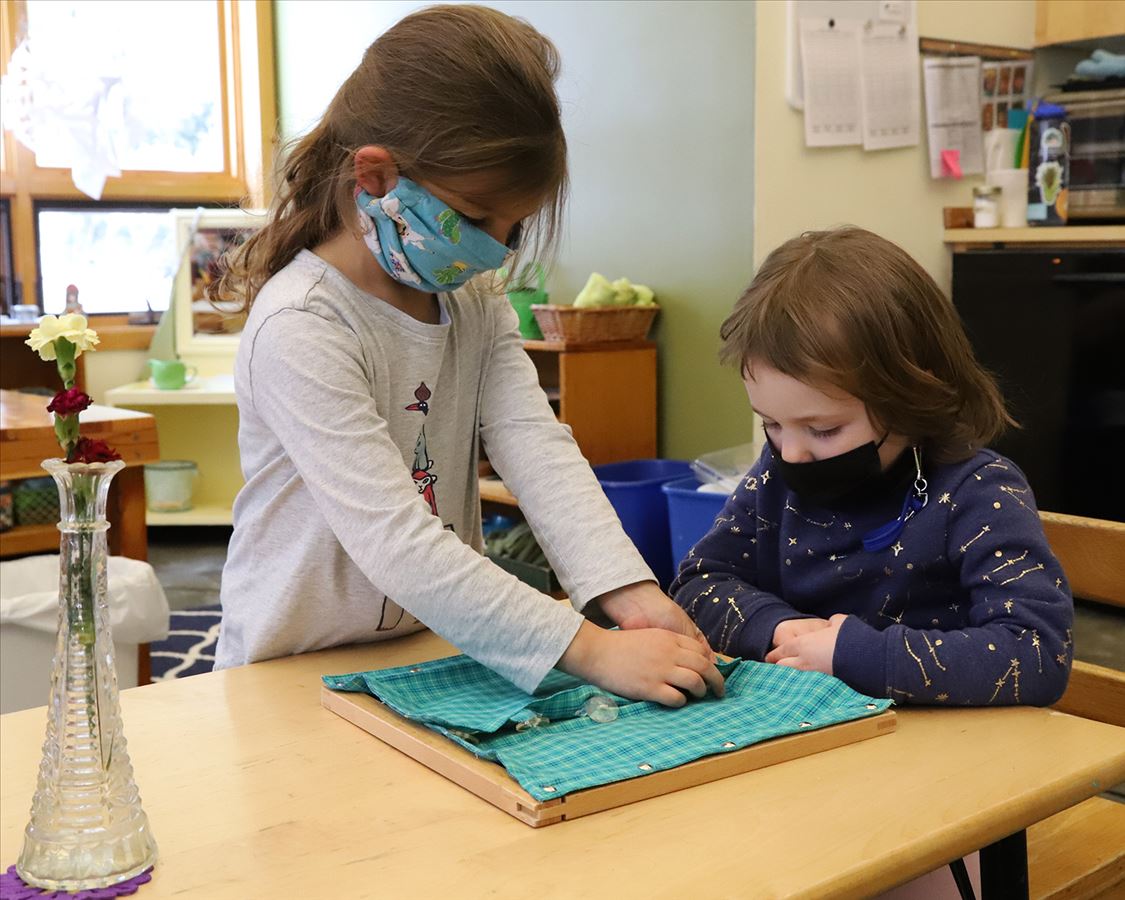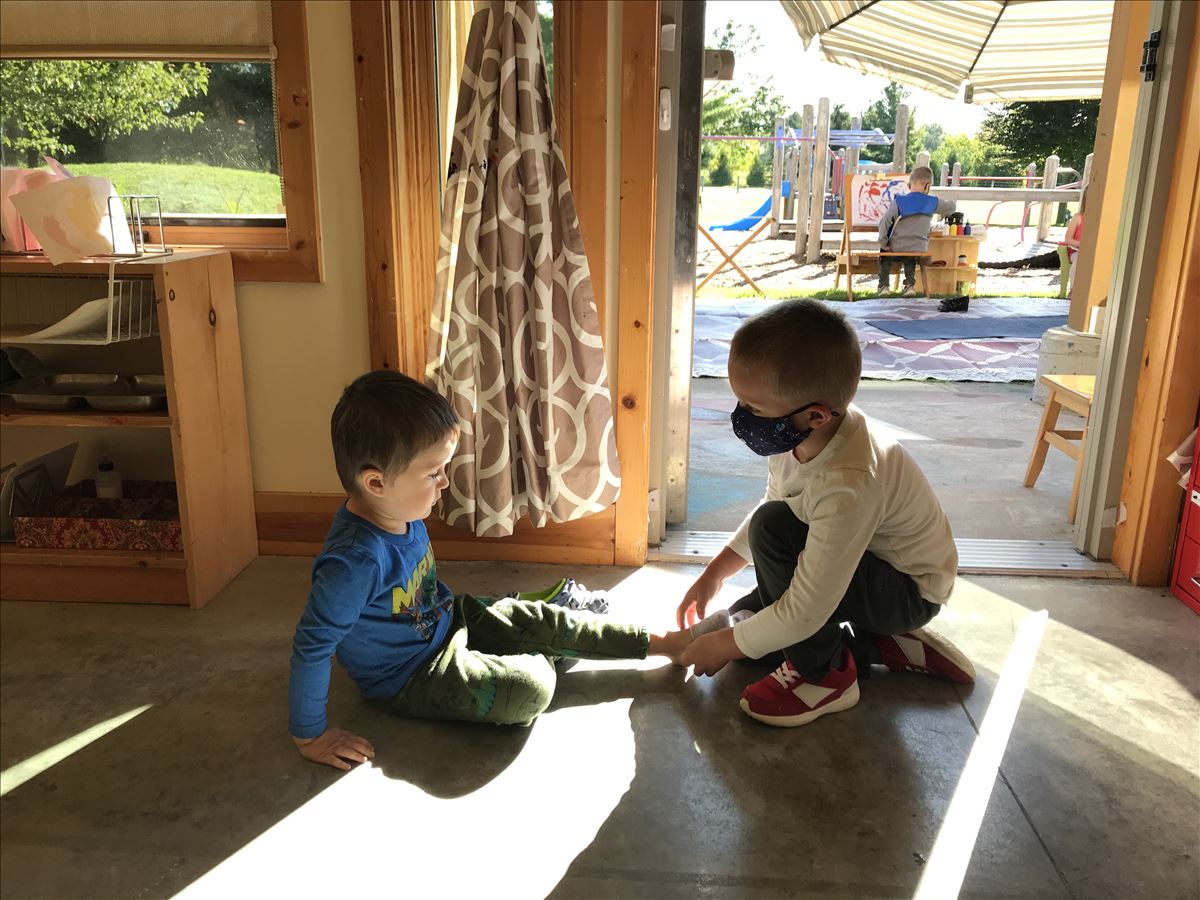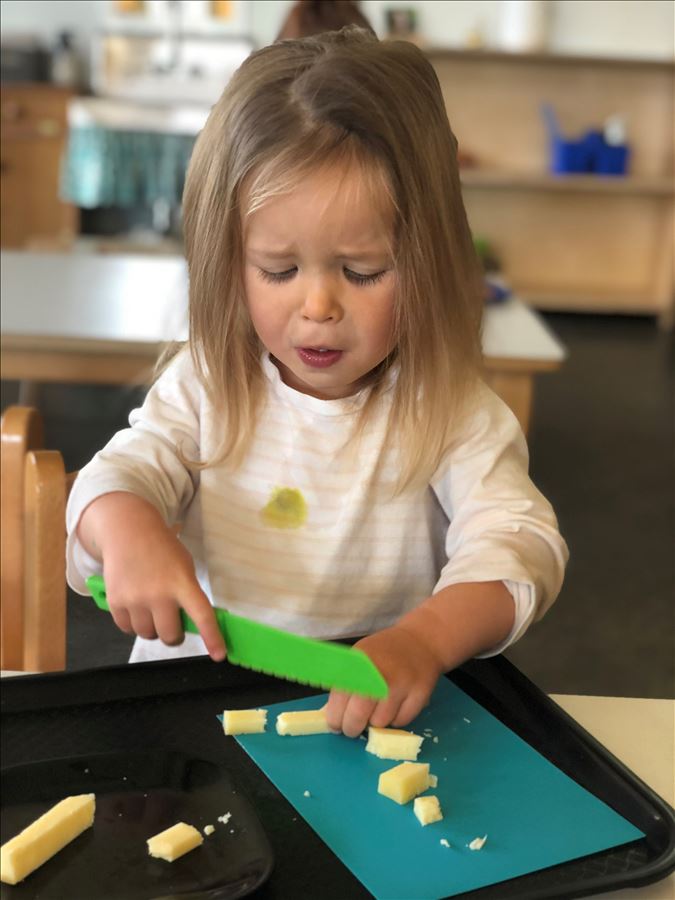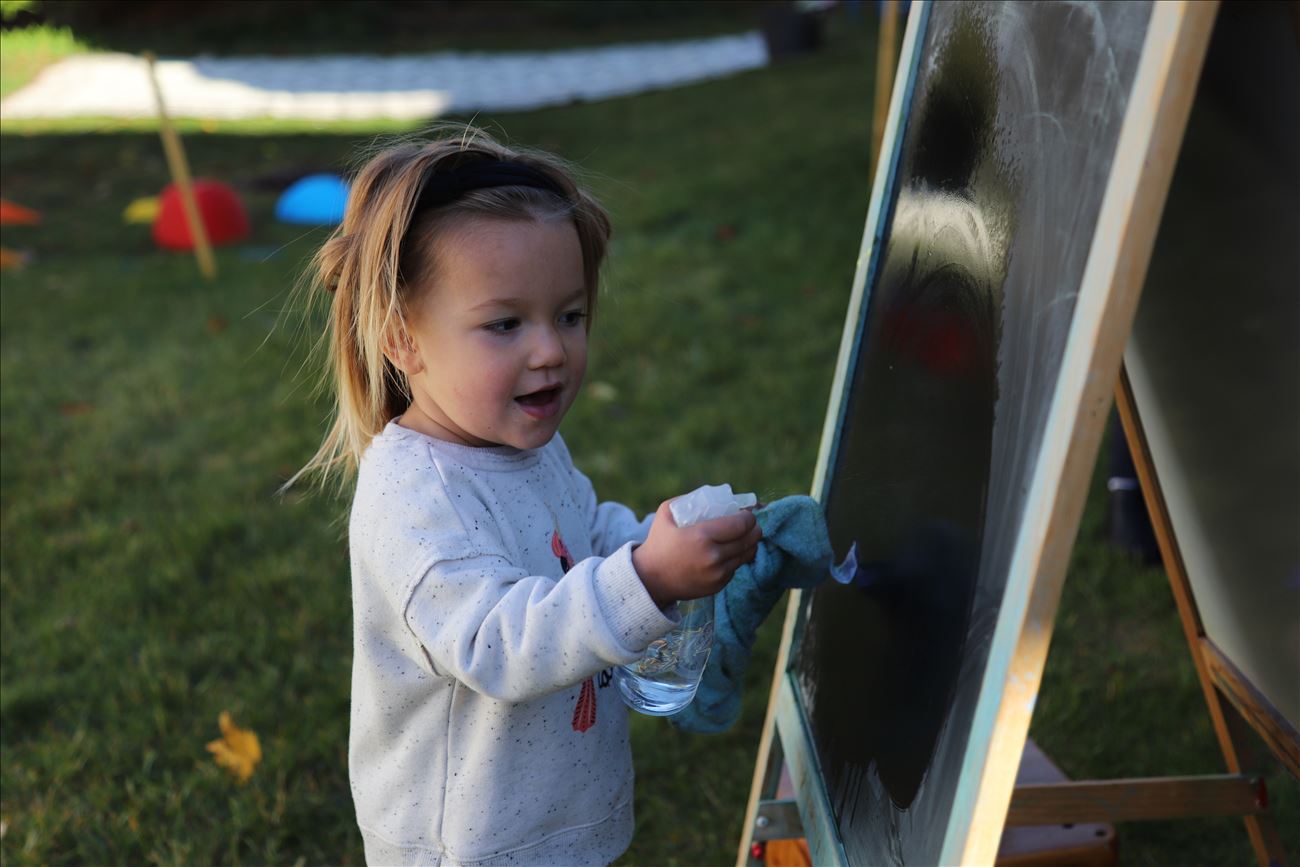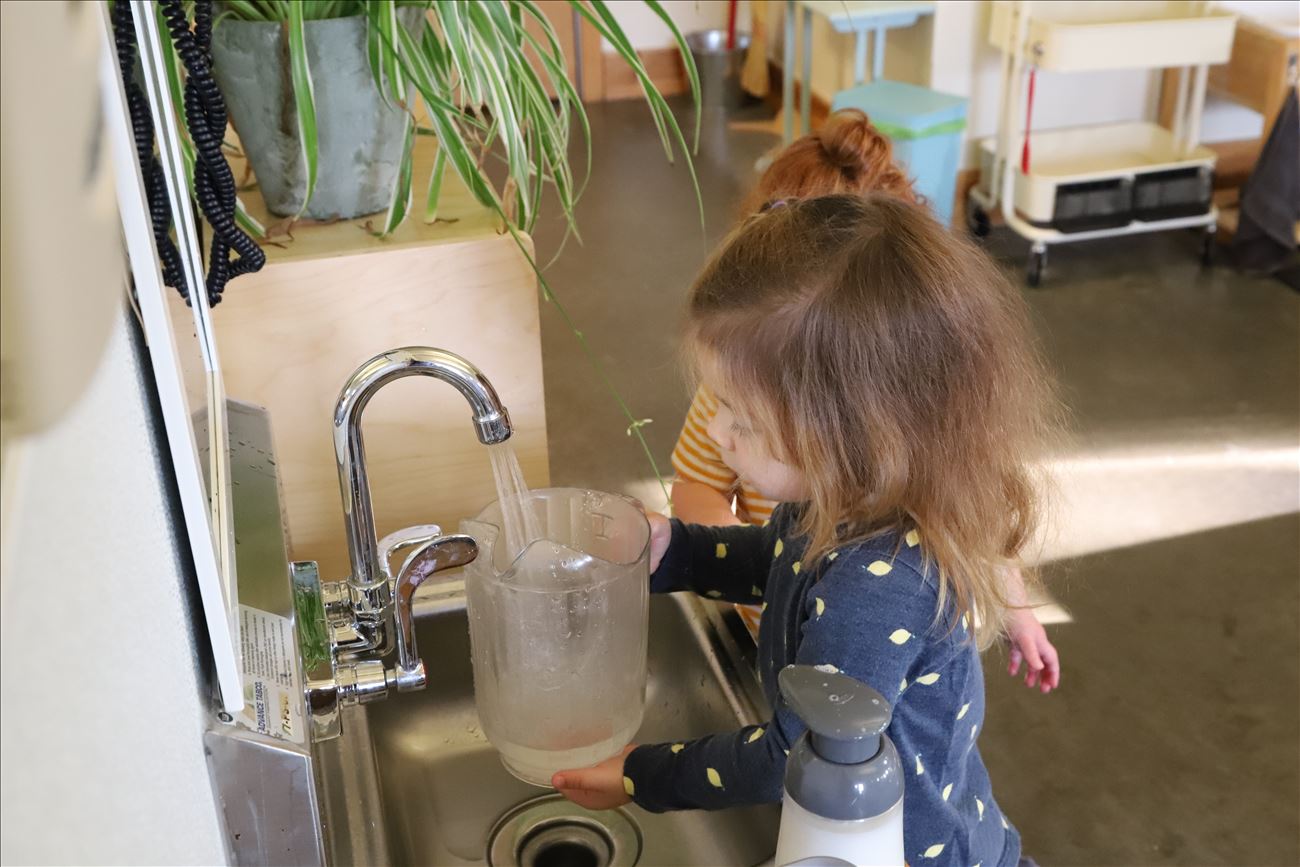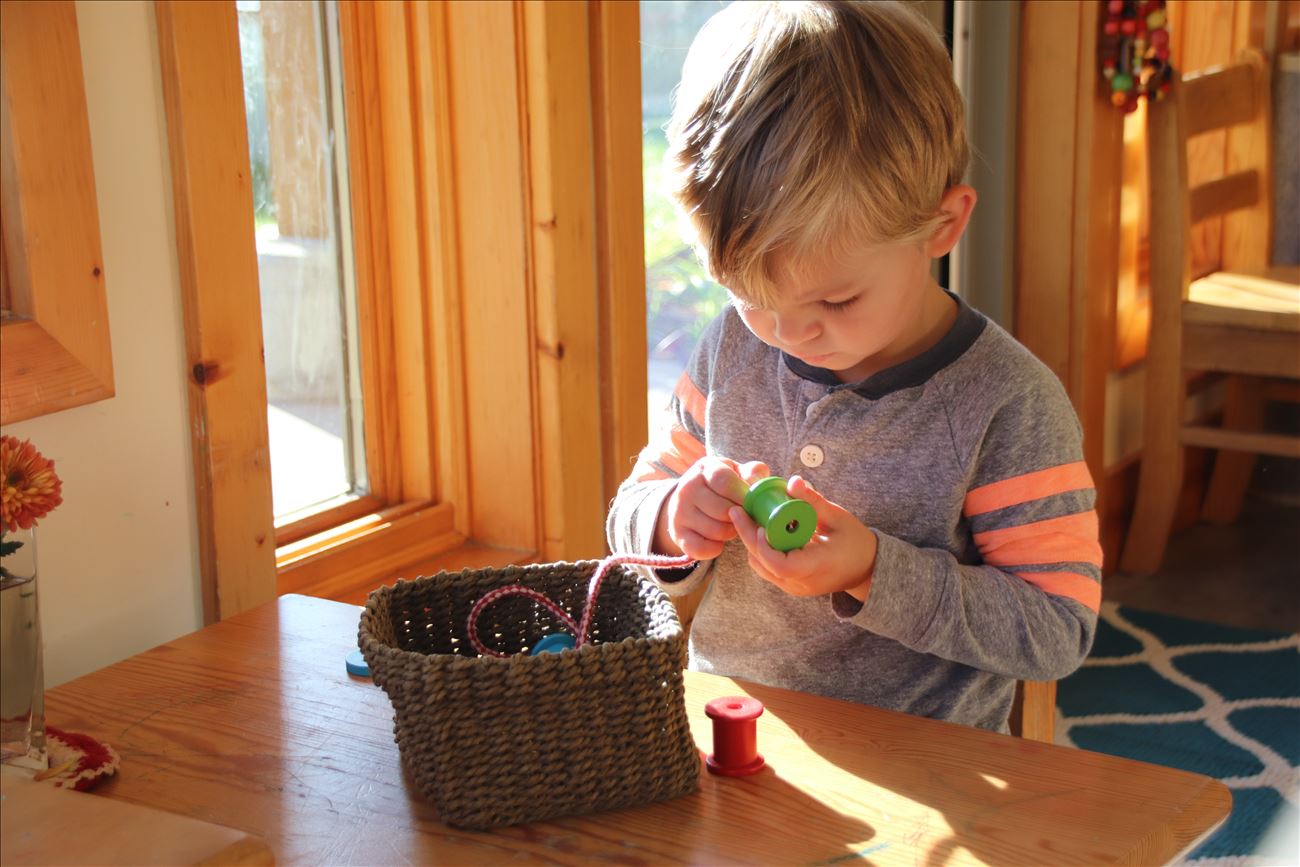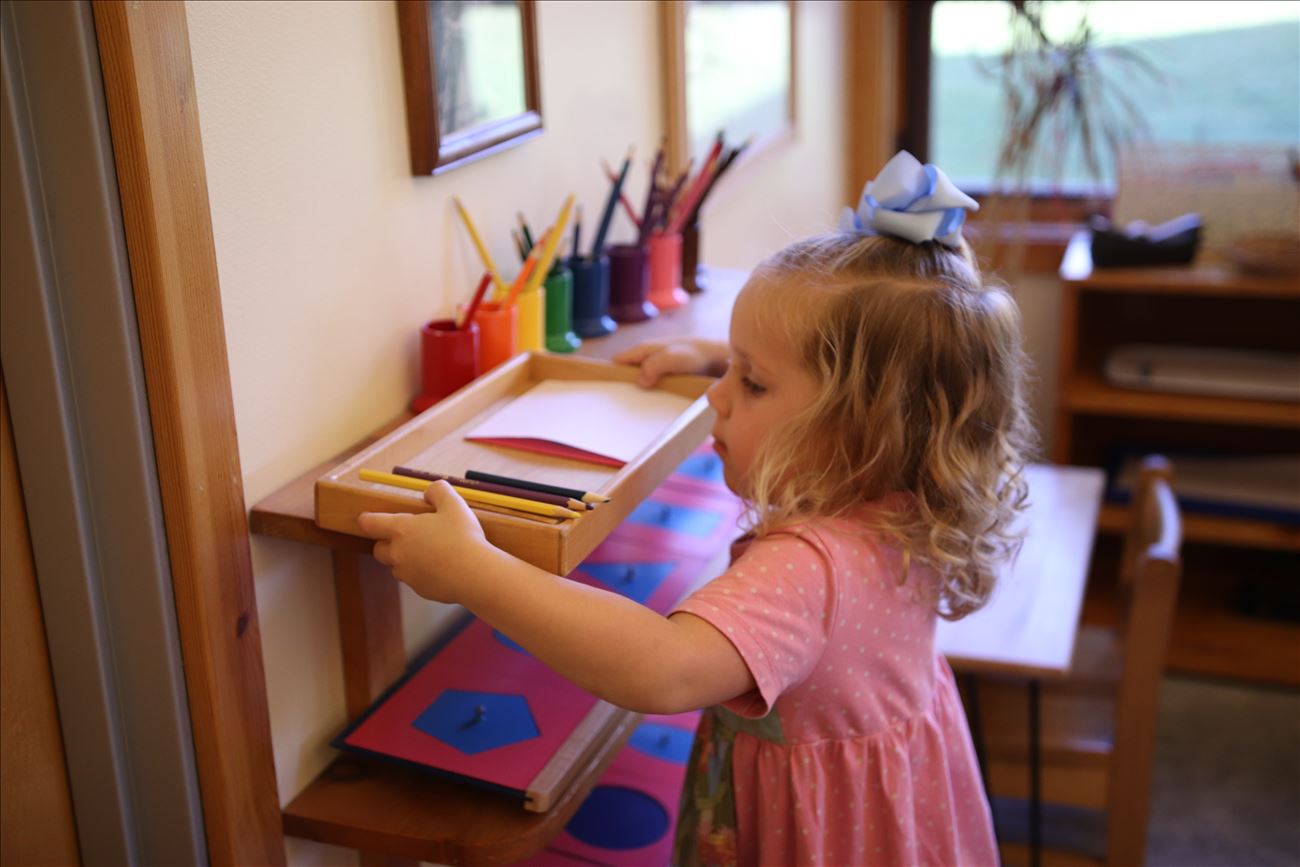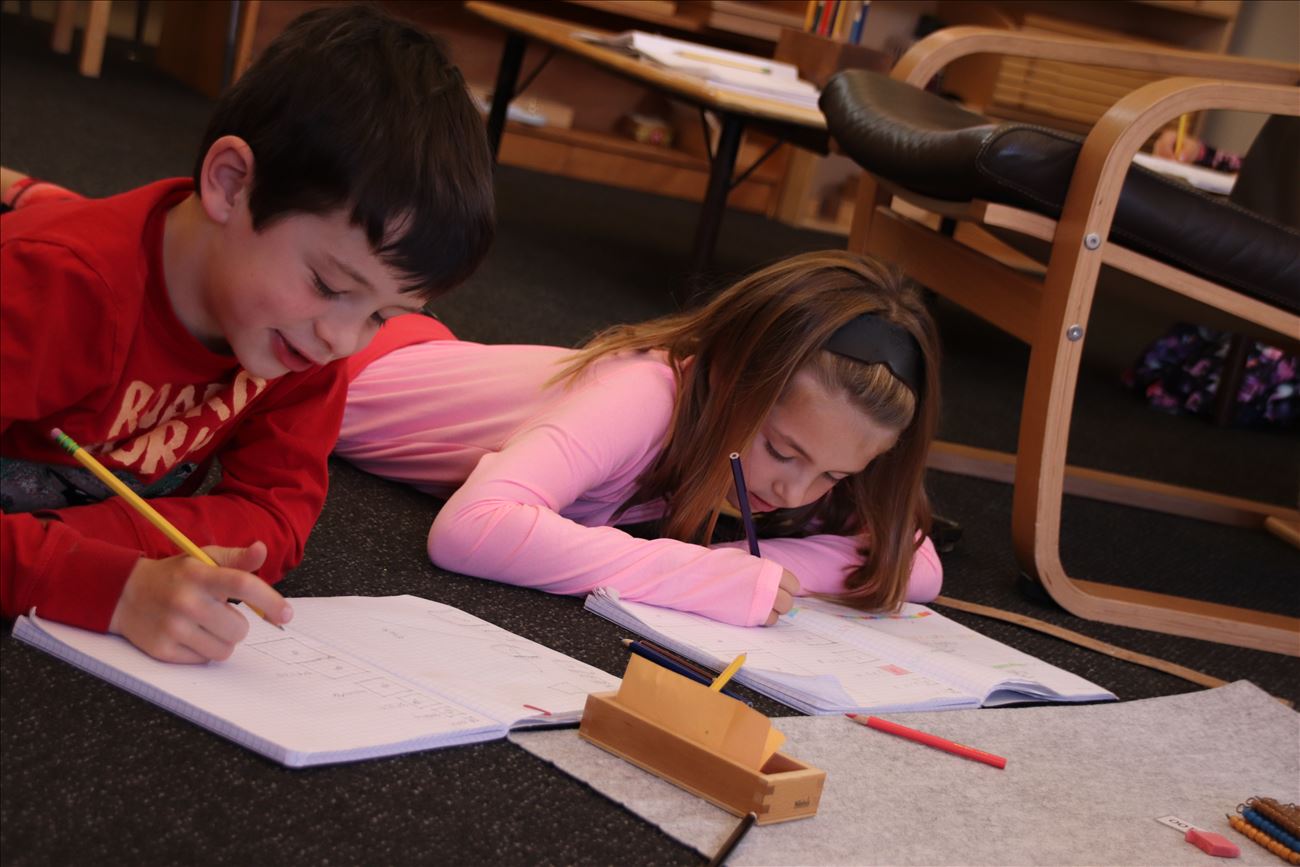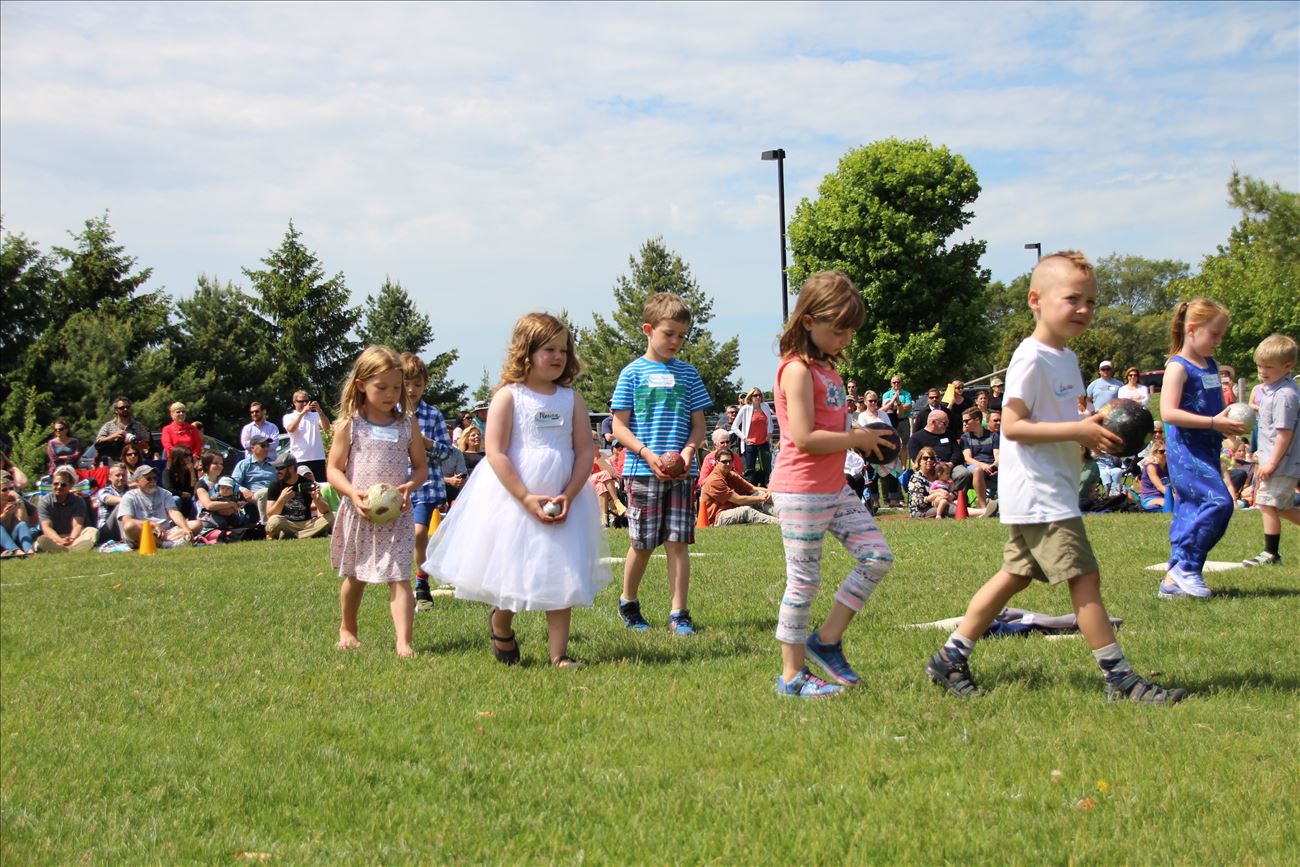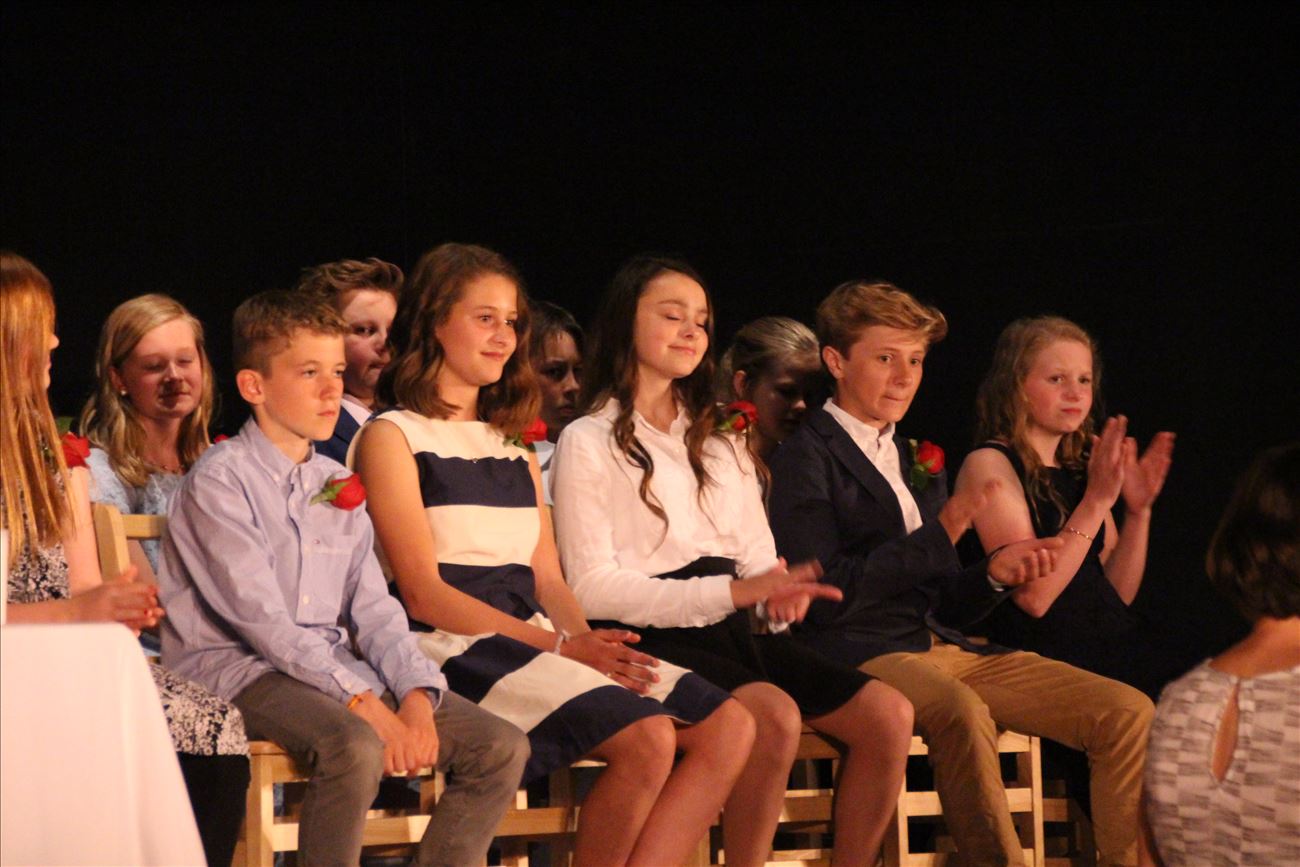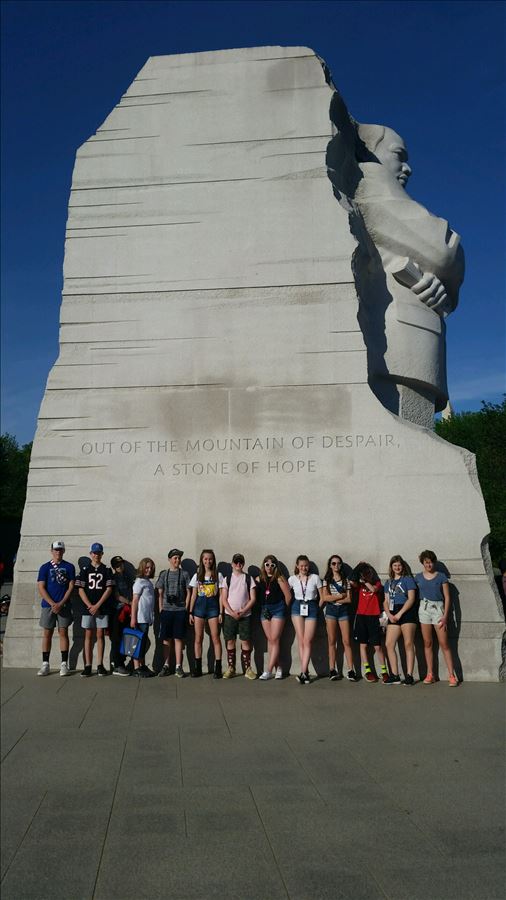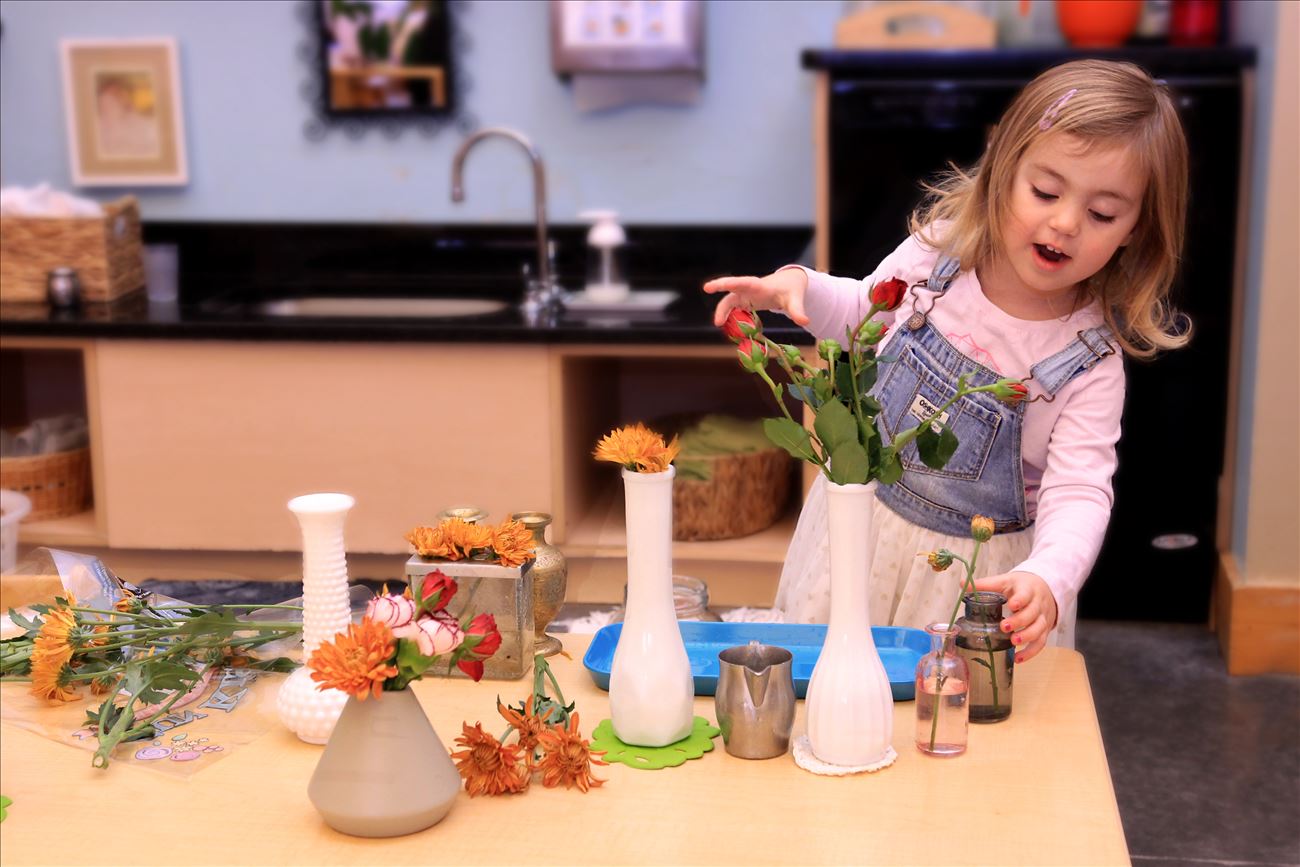I recently had a parent ask me about our food program; the “why” behind what we do. I found myself desperate to tell her about what we do now, what we want to do in the future, and most of all, the reason we have a food program in the first place. Since I live daily with the thoughts of how to make our food program better, more local, more delicious, and more of an experience that inspires our learners, I don’t often stop to think that many in our community may not be familiar with how we think about food and the role it plays in Montessori education.
The land that The Children’s House occupies was a nursery before we bought the property, complete with the greenhouse you see when you enter the driveway. For me, that greenhouse is a daily reminder of our commitment to Maria Montessori’s mission to foster voracious lifelong learners who are self-motivated, curious, and passionate about becoming contributing members of the community. Each step of the food chain process, from planting seeds to sitting down to a meal together, requires patience, observation, flexibility, craftsmanship, camaraderie, and investment in a positive outcome for everyone. I believe the more time we spend asking ourselves “what is the first step in this process,” the more we get to know the world around us, and the more invested we are in caring for that world. Growing food is a joyful step-by-step process we can see from start to finish.
As the program grows, I want to create more opportunities to engage our students in the garden and kitchen. Before working here, I had not spent much time with children, and cooking as a career can be quite stressful. I love that our students are always jazzed about Kitchen Classroom and Della Terra where they practice essential life skills in an environment that supports and encourages them to learn something new. To me, the “why” of our food program is the “why” of anything we do here at The Children’s House; to prepare our kids for life.
When sharing with friends or relatives that your child attends a Montessori school, you may have fielded the question, “They get to do whatever they want, don’t they?” This misperception of the concept of freedom with responsibility also invokes a more traditional definition and expectation of what discipline looks like at school. Just as the children build their skills and individuality by choosing where to work, with whom to work, and what work to focus on at a given moment within the parameters of their abilities, they are also expanding these freedoms as they develop the discipline envisioned by Dr. Maria Montessori in The Discovery of the Child, p. 51
“In our system, we obviously have a different concept of discipline. The discipline we are looking for is active. We do not believe that one is disciplined only when he is artificially made as silent . . . Such a one is not disciplined but annihilated. We claim that an individual is disciplined when he is the master of himself and when he can, as a consequence, control himself when he must follow a rule of life.”
From the youngest learners in Nido to the eldest at Compass Montessori Junior High, these individuals are on the path to reaching their potential as a contributing member of our world. The adults guide this growth by ensuring that the support provided serves as an “aid to life.” The infants explore their environment, gaining greater skills and awareness of their abilities and how to put them to use. In YCC, the young learners continue to develop their physical and cognitive skills as part of a community. They practice taking care of themselves and others, putting clothes on, preparing food, and pouring water. They ask you to “help them to help themselves.” This path logically leads to the primary child setting the table for lunch, beautifying the environment, and caring for the younger learners in their community. The patience developed by primary children observing the careful formation of a letter by the adult strengthens their discipline, which is further nurtured by their careful repetition of the lessons given until they are satisfied with their skills and are ready to move on.
In keeping with the changing developmental characteristics of elementary children, the adult continues to provide opportunities for them to develop self-discipline in a safe and predictable environment. Their freedoms grow exponentially as they exhibit the ability to properly handle the commensurate responsibility. They have worked together to create a classroom agreement that sets the expectations for themselves and others, thus acknowledging the reason for and necessity of having and following rules. These agreements serve as an anchor for the children when they venture outside of the classroom and interact with the greater community. The learners choose what research to pursue, contact resources outside of the school community, and organize outings to enrich their learning. These real world experiences develop social, organizational, and time management skills: skills necessary for them to develop self-discipline.
With this foundation in place, the junior high student continues to build these essential skills, taking on greater responsibilities for their learning and their community’s well-being. They are the keepers of their learning, which involves researching, planning, and implementing their trips abroad. They draw on their years of grace and courtesy lessons and practice and apply these principles to peer conflict resolution based on a foundation of equity and justice. They continue to practice their skills of self-discipline in a safe and predictable environment that they helped establish.
Mistakes will be made and are an essential part of the development of an individual’s moral compass and self-discipline. In contrast to the Oxford Languages definition of discipline as, “the practice of training people to obey rules or a code of behavior, using punishment to correct disobedience,” Montessori provides an opportunity for reflection and growth when mistakes occur while preserving the dignity of those involved. The “active” approach to discipline posited by Dr. Montessori takes the development of the whole child into consideration. It allows for, rather welcomes, those inevitable mistakes that come from being human. The learners (adults included) who make the mistakes learn to be accountable for their actions and repair what has been damaged. From the youngest age, children are engaged in lessons of grace and courtesy and social and emotional awareness, so that when they make a mistake, they understand why they need to take responsibility for their actions.
So, after you respond to your friend or relative that your child’s freedom at school is balanced with great responsibility that allows for your child to develop into the kind, loving, curious, contributing member of our world that they are meant to be, please invite them to come observe the development of self-discipline in action.
During the workshop, Applied Technology, we got the opportunity to travel to Pigeon Key and South Florida. The project we had to complete was fully submerging our team's ROV underwater and “flying” to the other side of the dock. The seven teams raced to see who could achieve the mission the fastest.
During this wonderful trip, we got to experience many different things. We enjoyed watching the Super Bowl, snorkeling in a beautiful reef, and waking up early for shark fishing. The first night we got to Florida, we drove down a beautiful road to our Airbnb while blasting “Miami” by Will Smith and sharing many laughs. As soon as we arrived at our house, we unpacked and enjoyed each other's company. The highlight of many people’s day was enjoying the one and only Super Bowl.
On day two, we enjoyed a slow morning that consisted of many fun conversations and delicious bagels. We then hit the road to Pigeon Key. After a long trek and enjoying looking out at the beautiful blue water, we arrived at the island. We loaded on a train and were greeted by a set of wonderful counselors. We explored the island and swam in the water. We all had a wonderful dinner and headed to enjoy a night of sleep.
While on the island we learned so much about the biology of fish and how to tell one from another. After all of our learning, we got to go out and snorkel at a beautiful reef which was by a lighthouse. The lighthouse used to be the tallest iron structure in the world until the Eiffel Tower was constructed. When we arrived at the lighthouse we jumped into the crystal clear water and explored the coral and thousands of fish. As soon as we got all the salt water out of our lungs, we headed back to camp. After all of our marine learning, we got to enjoy some downtime. We then had our ROV competition. As soon as the star of the show was over, we headed to the beach for the tide pools and snorkeling. We got to look at many cool invertebrates like starfish, jellyfish, octopus, and many animals we’ve never heard of. We also explored the biology of sharks. We learned how to detect sharks and how to keep them safe. We even got the chance to dissect a lemon shark as well as feed a nurse shark.
On the last day of Pigeon Key, we woke up bright and early for an hour of fishing at sunrise. We caught a variety of fish like a trumpet fish and even a black nose shark. After the amazing sunrise and slimy fishing, we enjoyed breakfast, packed up, and left our beloved island. We drove a tedious three hours on a long highway while blasting wonderful music and soaking in the colorful environment. Before heading to our house, we stopped at Sharky's Shark Bite Grill. Don’t worry, no sharks were harmed while dining. Soon after lunch, we explored the Florida Everglades. We took a short walk around the never-ending grassy Florida Everglades. We got to see many alligators, fish, and a variety of birds. That was a memory many people will never forget. I hope I can visit again soon. After our hike, we drove over to Robert is Here Fruit Stand. This fruit stand had every fruit you could imagine, including starfruit, mango, jackfruit, and many many more. Not only did we enjoy tropical fruit, but we got to hang out with cows, turtles, emus, and goats. After visiting Robert, we drove to our last place. When we arrived, we all got settled and enjoyed the last night of the trip with some pizza.
The last morning of the trip was bittersweet. We enjoyed the last drops of warmth at a local beach and park. We all shared many laughs and stories then loaded up to head back home.
Thank you to Tree, Kristina, Tori, and Brian for taking us on this wonderful adventure! And, a big thank you to the school for making this learning experience possible! Thank you!
“The needs of mankind are universal. Our means of meeting them create the richness and diversity of the planet. The Montessori child should come to relish the texture of that diversity”
- Maria Montessori
Maria Montessori was the ultimate advocate for peace education. She created a method that allowed all children to access their full potential, regardless of ability, background or learning style. She was a champion for diversity and knew our differences added opportunities, not setbacks. However, claiming that Montessori schools celebrate diversity by default of Montessori’s life work is a mistake. Classrooms that appropriately celebrate diversity require intentional teachers and purposefully tailored instruction. These are the top three ways we do this at The Children’s House:
-
Offer windows and mirrors. Windows offer insights into other people’s perspectives. Mirrors offer reflections of our own experiences. Every learner needs both to develop a full picture of the world.
Example: We include books, stories, music and art that represent our learners gender, race, family structure, physical ability and socioeconomic status. We also make sure to include media that highlights those not represented in our community. Classrooms make sure the library corner reflects the world at all times. When we are studying perspectives of those not in our community, we use primary sources and consult experts.
-
Affirm learners’ unique identities. We support learners to have a positive connection with the characteristics that make them special. This starts by getting to know our learners through careful observation.
Example: We do this by celebrating each other’s characteristics through art, like drawing portraits and mixing paint to create our unique skin tones. We are also intentional about sharing compliments with each other regularly.
-
Create a culture of curiosity. We encourage learners to ask questions and model seeking to understand. Young children have a natural desire to put information into categories. Questions help them make sense of the world around them without making assumptions.
Example: We model using phrases like “I wonder what pronouns our new learner uses” or “I can’t wait to learn more about which holidays your family celebrates”.
It is important to learn about people different from ourselves. Seeking to understand promotes empathy, perspective, and reflection. Learning about others often requires seeking out experts in our community. It also requires noticing the diversity already around us. Our staff is committed to cultivating an environment where everyone feels welcome and celebrates what makes each learner themselves.
Our Commitment to Diversity, Equity, Inclusion, and Belonging
Forever inspired by the wisdom of Dr. Maria Montessori, The Children’s House and Compass Montessori Junior High cultivate a learning community where we aim for everyone to feel safe, welcome, and included, and wherein all people are empowered to explore the richness and diversity of humanity, and in doing so discover who they are, where they come from, and how they wish to contribute to our ever-changing world.
Our society knows teachers. Teachers give information. Teachers provide an education. Teachers instruct.
In a Montessori classroom, however, the role of the adult is rather nuanced. The adult is there to facilitate, suggest, model, and observe. The materials teach. The adults advise.
Because the Montessori model is quite different from traditional education, the adults responsible for providing a Montessori experience have very different responsibilities, skills, and abilities than those of teachers in a traditional method.
Historically, children have been seen as blank or empty vessels that just need to be filled with information or knowledge. The teacher’s role has been to fill the vessel, to teach. Because the teacher passes information, correction, and validation to the student, the teacher is the material for learning.
Rather than seeing children as empty vessels, Montessori teachers see a bundle of potential just waiting to be realized. With this, the focus is on discovering these hidden potentials in children and supporting their development. This happens most effectively when children are actively engaged in their learning process.
In the traditional model, a teacher needs a number of tricks, including a system of rewards and punishments to keep children focused on learning. But this framework of grades and evaluations isn’t actually necessary for children to learn.
In Montessori, we see the deep intellectual, social, and emotional engagement that happens when children get to learn through their own activities. Children get to use a variety of hands-on materials to explore, discover, and internalize key concepts and skills. Montessori teachers introduce how to learn from the material in the classroom. As a bonus, because children are active participants in their own learning, they don’t have to sit passively while remaining focused on the teacher’s activity.
So, if a traditional model demands that the teacher’s presence is active and the student’s presence is passive, what does it look like in a Montessori classroom? When you look in a Montessori classroom, at first it may be hard to find the adults because the role of the Montessori teacher should be (or appear to be) a passive one. You may see an adult observing the room or particular children, inviting a child to a small group or one-on-one lesson, or sitting with children who are using the learning materials.
Sometimes it can be clear that the adult is presenting a lesson. In these moments, the adults do look a lot like teachers, just working with a small group rather than the whole class. Yet during these brief presentations, the goal is rarely to distribute information. Montessori teachers don’t want to teach the trick for compound multiplication, the names of all the countries in South America, the characteristics of mammals, or the function of a verb in a sentence. Rather, the true goal is to give the children just enough of the lesson to pique their interest or capture their imagination. We want them to return to the learning materials again and again so they discover the mathematical proof, scientific concept, geographical boundary, historical connection, or grammatical rule on their own.
Because this goal and the role of the adult are so different, we often refer to our teachers as guides. This change in terminology shifts our thinking. Montessori teachers don’t lead a class from the front of the room. Our guides provide paths for children to learn that the quantity of 10 feels bigger than the quantity of two, that nouns name things, that equivalent fractions really fit into the equal space, or that 81 actually forms a square.
Montessori guides are actually aware of how to support children on these varied and delightful paths of progress. Like the rudder of a ship, our guides allow children to embark on a journey of discovery while offering adjustments and changes to the course as needed. The result? Children flourish as active, creative, curious thinkers.
Having recently watched the new Bob Dylan biopic, A Complete Unknown, my mind is highly attuned to the realities of being a young person in a rapidly changing world. I left the movie deep in thought, thinking back at how I felt when I was first introduced to “The Times They Are A-Changin” when I was exactly the same age as my students at Compass Montessori Jr. High. Not unlike the early 1960s, the world today, and thus teenagers today, are experiencing massive cultural and technological transformations.
It is easy to forget that adolescents experience these changes very differently from adults as they are biochemically hardwired to blaze their own trails, question the status quo, and create their own culture that distinguishes them from the adults in their life (especially their parents). Moreover, adolescents’ brains experience a neuroplasticity that allows them to adapt to change much better than the fully formed adult brain. Add to this the as-yet-to-be fully understood impacts of fast-paced, high stimulus, globally integrated technologies, and you have the perfect combination for a profoundly different iteration of Homo sapiens. In short, adolescents today are as, if not more different from their parents and grandparents as Bob Dylan was from his.
In watching A Complete Unknown, I was not-so-subtly reminded that my job as an adult, and especially as a Montessori guide, is to “lend a hand” to these next generations and do my best to understand, not judge, and even better, to be curious about the way they experience the world. Dr. Montessori reminds us to “follow the child,” as they are, not as we might hope for them to be. With this in mind, we must remember that the adolescents that we once were, were essential to the adults we are today.
Having said all this, it remains essential to support adolescents in navigating new technologies, and to provide the boundaries young people have, and will always need in order to safely explore the parameters of their personal identities, as well as their aspirations for the future. At Compass Jr. High we do this by providing as many opportunities as we can muster for self-exploration and expression, while also pushing our students outside (sometimes well outside) their comfort zones. Our most powerful tool in this effort is building community, and engaging with a diversity of other communities here in Michigan, and well beyond the borders of our State. And while modern adolescents may, indeed have much to teach us about the future that they will create, we too have much to teach them about how to be a good citizen of that future, even if we ourselves may not quite understand it… yet.
If you’re the parent of an emerging adolescent, you don’t need to be reminded that they are experiencing the first waves of a fundamental shift. They are Montessori’s “social newborn”, working out who and how to be in the society they have inherited. Their brain is undergoing a flood of changes, all of which influence decision making.
You know your kid needs steady adult guidance to help them navigate the increasing complexity of their life. And yet, with the competing interests of friends, activities, and technology, plus a side of attitude, you may be struggling to find a way in.
Does your teen barely acknowledge your bids for connection until 11pm, and then have you hanging on the doorframe while they unspool the day’s drama? Psychologist Lisa Damour encourages us to leave the dishes for the morning and give them our full attention.
Damour’s book, The Emotional Lives of Teenagers, aims to help parents “stay connected to your teen and provide the kind of relationship they need and want”. This means being willing to meet them, sometimes, on their terms.
What Damour hears most often from her clients is the wish that their parents would listen to what they have to say. Really listening, without jumping to solutions or rushing to console, can feel counter to the instinct to protect your child. She writes that “the act of putting feelings into words [may] provide all the relief that’s needed”. When they come to you, ask what they need: do you want help, or do you want to be heard?
It is likely that often, they just want to vent. The better we get at articulating our feelings, the more clarity we feel after talking through them. Help your teen build their emotional vocabulary by drilling down - you’re “mad”; are you also irritated, apprehensive, disgusted, floundering? Supporting them to communicate through, and about, their emotions will increase their self-awareness and build a muscle that supports everyone in the home - empathy.
Giving their emotions our attention helps teens take their feelings seriously. Damour observes that adolescents doubt the validity of their emotions when they compare to how their peers seem to feel. A friend’s snippy comment at lunch really rubbed them the wrong way, but nobody else seemed upset, so they’re probably making a big deal out of nothing. Encourage them to trust their gut and talk together about how they could respond if they choose to.
Feelings are just one piece of data. Encourage them to tap into other ways of knowing, including logic and values, when making decisions. Take the initiative to bring up tricky situations they’re likely to encounter, and help them create a plan that aligns with their goals for themselves.
Often the solutions adolescents come up with are different from what we would have chosen for them. By empathizing, instead of rushing in, we are showing them that they can trust themselves. This is another step toward the independence they’ve been building since they started washing their own dish in the Young Children’s Community.
You may feel frustrated when your teen shows the ability to reason one minute, and makes a regrettable decision the next. They are likely to be frustrated and confused, too! This is part of the journey. All of the work you have done to build trust will help them feel safe to open up in those vulnerable moments.
This blog was inspired by Lisa Damour’s The Emotional Lives of Teenagers. Upper Elementary and Compass Junior High parents are invited to join us for a discussion at Compass on January 28th at 6:30pm.
Can you think of a time when your child was in a full-blown state of dysregulation? Have you ever found yourself trying to reason with them in that moment and then become frazzled yourself because they are not open to hearing you? Research today tells us that when any human is experiencing this level of heightened emotion, parts of the brain responsible for reasoning become inaccessible. This is beautifully explained with the “flipped lid” model.
How do we help our children learn skills necessary to cope? Dr. Montessori knew the importance of a neutral state of mind. It is through “Grace and Courtesy” lessons that an adult models certain desired/appropriate behaviors/movement. She understood the importance of allowing children opportunities to practice these skills before they need them. Practicing effective coping skills is a great way to prepare children for those big emotions.
Another tool that has proven to be incredibly effective for children is something called “social stories.” Social stories are books originally created by Carol Gray to help children experiencing Autism cope and find success with the world around them. We now know that these stories can benefit and support all children. They are visual and verbal reminders from the child's perspective of what to do or what to expect when specific situations arise.
A favorite social story of ours talks about anger. The social story:
- Gives language for the emotions such as: being mad, angry or frustrated
- Validates those feelings without shame
- Lists all the ways the child might express their anger
- Sets boundaries on appropriate responses to feeling angry (not hurting others)
- Gives ideas of how to cope
- Naming the emotion
- Talk to a friend or family member
- Ask an adult for help
- Taking deep breaths
- Listen to music, go for a walk, get a sip of water, etc.
- Statement that this feeling won’t last forever, and they can help it pass by quicker if they use a coping strategy
Other situations that social stories can be helpful for:
- Upcoming transitions
- Sleep
- Toileting
- Waiting my turn
- Hitting and pushing
- Change of routines
- Respecting other’s personal space
- Voice volume control
- Greeting others
- And so many more!
These books are meant to be read, not in the moment but rather routinely throughout their day during neutral moments. If you find yourself stuck on how to support your child through a challenging season, consider using the power of a social story. Here are few great resources if you would like to learn more:
https://www.andnextcomesl.com/p/printable-social-stories.html
Compass Montessori Junior High -
On Tuesday, October 22nd our class took our annual trip to Detroit. We stayed in Hostel Detroit for the week. The first day consisted of visiting The Detroit Institute of Arts and getting groceries at Meijer. The Detroit Institute of Arts came with many cool experiences. We split into van groups to tour the museum with our guides. One exhibit we got to enjoy was the Ofrenda exhibit. The beautiful altars pay tribute to loved ones who have passed away. Currently, we are learning about the Day of the Dead in Spanish.
On day two, we headed to the Zekelman Holocaust Center. We learned about the tragic history of the Holocaust. We heard from Holocaust survivors about their heart-wrenching stories and experiences. We also got the chance to view Anne Frank's tree. During World War II Anne Frank went into hiding and she wrote in her journal about this special tree that stood outside her window. This horse chestnut tree gave Anne Frank hope about the future. Scientists found this very tree and created saplings. The saplings were given to many museums around the country. The Zekelman Center was given one and we got an incredible view of this tree. After this museum, we explored the Children’s Science Museum. We explored all the different levels of this amazing museum. We got the opportunity to view a dinosaur exhibit. This exhibit showed us what dinosaurs looked like many years ago as well as interactive displays. During the museum, we watched a documentary on the life of whales. To wrap up day two, Jessica Sullivan kindly got us tickets for the Pistons basketball game. The Detroit Pistons played the Indiana Pacers. The Pistons sadly fell to the Pacers 115 to 109. But it sure was a great game! We enjoyed pizza and got to shoot free throws after the game ended. Our class was also featured on the Jumbotron. This was definitely the highlight of the night for most people.
On day three, we got to catch up on sleep with a late start to our day. Our first activity was at 11:00 when we drove to Historic Fort Wayne. Historic Fort Wayne was a five point star fort where the army would fire their weapons at the Canadian shore. It is also a sacred Native American burial ground which was very sad to see. After the tour we enjoyed a packed lunch and some recess. Once we had finished at the park we decided to walk around downtown Detroit. It was so fun to see all the buildings and sights. Before dinner, we made one last stop which was an old building and we learned all about the architecture. Dinner was at Detroit Shipping Co. It was so good and we had so much fun. We played bags, Connect 4, and of course we couldn't leave without getting the whole class to sing karaoke on two microphones. That was definitely an experience none of us will forget. Before the night ended we went to this pop-up shop called the Pink Flamingo where we bought treats like lemonade and cookies. This night and the game were definitely unforgettable.
On day four, (our last day in Detroit) we woke up very early to pack up. After spending the whole morning packing suitcases, washing sheets and checking everything we headed home. Before fully leaving we made one last stop to the state capital in Lansing. We heard from Betsy Coffia’s legislative director, Ashley. We heard all about how she got into politics and her life. After we heard from her we got a tour of the state capitol. It was very cool. We even got to see Governor Whitmer's office! After the tour, we drove the three hours back to Traverse City.
We would like to thank our guides and chaperones for the opportunity to take this amazing trip. We would also like to thank all of the tour guides that showed us the ropes during many of the museums! Thank you!
Written by Gwennie Goodreau and Ava Hagerty
If you were able to join us this past week for our Primary Deep Dive, you heard Alison Breithaupt mention the trio of elements that allow the Montessori ‘magic’ to flow in a classroom. Those essential elements are:
- the training of the guide
- the prepared environment
- and the materials in the classroom.
The materials cannot be used in isolation outside of the context of the other two elements … it simply will not produce the same effect. The topic of this blog is about ‘doing’ Montessori at home and it seems an impossible feat we set before you if all of a sudden the materials – the legacy of Dr. Montessori herself – are now off limits. What if I shared that another harmonious trilogy can be created within the context of your family? It may not produce the same magical melody as we sing in the classroom, but it is a tune of a different nature – and one just as powerful.
You are your child’s very first teacher – their most important guide in life. Schools often lay claim to building a child’s foundation in life. The work we do in the classroom certainly strengthens their base of knowledge, but it is by watching you that your child builds the pillars upon which their foundation rests. You model the values in life that are most worthy to prioritize.
This is a good time to do a quick self-reflection and ensure the habits you are modeling are the ones you want your children to mirror their life after. Is competition for attention at your house fiercely divided among work, household chores or responsibilities, technology, or hobbies? Is your child learning what a healthy work/life balance ratio is? Are they encouraged to make meaningful family contributions in a way that helps them feel valued and worthy? Are spaces in your home designed for your child to create independent routines? Are hooks low enough to hang backpacks and coats, clothes and utensils in accessible drawers, and healthy snacks within reach without support? These minor adjustments can have a resounding effect on your family's rhythms. Is your child learning to have a wholesome relationship with technology – one that teaches them how it can be used as a purposeful tool for progress? Is your family building a collection of hobbies together – ones that will create lasting connections and joint memories?
After looking at the values you model through your actions, the second element to consider is the words we speak. This directly correlates to the message above because sometimes the words our children hear come in through their ears, and other messages they feel directly pierce their heart. If you are familiar with Don Miguel Ruiz’s book, The Four Agreements, you will remember his first agreement, from which all other agreements stem, is to be “impeccable with our words.” This simple act of striving for impeccability will create a channel from which positive energy can flow freely. Just as the bell work in our classroom trains your child’s ear to hear Perfect Pitch, let your words train your child’s ears to listen for truth, wisdom, and love.
The final element needed to round out the trio of our good works and our words is that of presence. Know that every day you show up for your child is enough. The love we have runs so deep that just being there to share the laughs and catch their tears is enough. Teach them how to hold space in their heart for one another when you have to be apart and make the time you have with one another a gift simply by being present.
Authentic experiences come directly from the heart. They speak intentions and truths to your child in a way that no other lesson can. Incorporating Montessori’s philosophy into your home doesn’t have to involve doing anything other than checking the intention behind what you are already doing.
If you look to social media for ideas about Montessori for very young children, you will likely see lots of stuff. There are several materials in our classrooms that would be excellent in a home as well, but I would argue the best way to do Montessori at home is to include your child in as many aspects of daily life as you can. These activities are referred to as the practical life curriculum in our classrooms.
Practical life encompasses all of the activities and actions that we do every day to take care of ourselves, others, and the space that we live in. Some of these activities are related to our basic survival, such as preparing and eating food, and many of them are what we would think of as chores to be done to keep our households running smoothly.
We talk a lot about practical life in the Montessori environment because those exercises encourage so many aspects of development in the young child. Practical life fosters growth in fine motor, gross motor, language, and social-emotional literacy. It also highlights one of the most important skills for a young child to develop: independence.
The most important aspect of doing practical life activities with babies and young toddlers is to have the house prepared for them. This does not mean they need to have a beautiful IKEA kitchen like you may have seen on Instagram. Having a basket of towels that they can access and a place for the wet/dirty ones to go is enough. Smaller utensils are great, but it is more important to allow them to be involved when you feel comfortable doing so than wait until you have all the perfect items.
We do these practical life activities every day in our own homes without thinking about it. Children start their lives with these activities being done to or around them. The child absorbs who does those activities and how that person does them. As children get closer to pulling to stand and walking, they become intensely interested in participating in these activities.
Even the youngest babies watch and absorb everything around them. We can include babies who aren’t able to sit up yet by doing appropriate activities next to them and narrating the process. They are frequently happy to observe us as we move about cleaning our homes and are that much more likely to participate where they can as they are physically able.
Here is a non-exhaustive chart of activities that you might be able to incorporate into your home routines with your children:
| 6-12 months | 12-24 months | 24-36 months | |
| Cleaning the table | -Wiping spills while seated in their high chair | -Retrieving cloth and placing soiled cloth in the laundry basket | -Clearing plates to the sink |
| Laundry | -Load individual items into a front-loading washing machine |
-Loading the washing machine -Flipping laundry to the dryer
|
-Sorting -Folding -Putting their clothes away -Hanging clothes on hangers
|
| Cooking, baking, and meal times |
-Pouring water into cup -Transferring items from cutting board to bowl -Self-feeding -Washing vegetables in a bowl of water
|
-Slicing -Spreading -Adding ingredients -Stirring -Peeling oranges -Shucking corn -Sprinkling (seeds, herbs, etc.) -Using a fork -Setting the table
|
-More advanced knife skills -Scooping -Measuring -Filling muffin tins -Grinding pepper -Peeling vegetables
|
| Care of Home |
-Unloading dishwasher -Water outdoor plants
|
-Loading dishwasher -Watering plants -Dusting shelves -Sweeping -Vacuuming -Mopping -Arranged flowers in vases -Restoring order with help
|
-Sweeping into a dustpan -Cleaning windows and mirrors with vinegar spray -Dusting plant leaves -Cut flower stems -Repotting plants -Restoring order independently
|
| Care of Self |
-Participating in dressing and undressing -Giving two choices for clothing options for the day
|
-Brushing teeth -Brushing hair -Washing hands -Pulling zipper up -Closing velcro on shoes -Independent dressing and undressing -Wiping their nose
|
-Cleaning shoes -Buttoning clothes -Threading zippers -Independently changing shoes
|
Our class traveled to Harbor Springs to learn about the Anishinaabe and their incredible and inspiring history. Eric Hemenway was kind enough to teach us about his culture and the history of Holy Childhood, a Native American boarding school. We stayed at Wilderness State Park for the night and enjoyed Odawa classics that consist of wild rice, squash, and for a main, delicious fish.
When we arrived at the campground, Eric met us and we discussed the history, culture, and traditions of the Anishinaabe. The campground we stayed at was once called Little Fox. While we stayed there, some of the class saw a little fox run across the beach. It was pretty incredible. After dinner, we finished the night off with a closing circle and the option to go to the beach and enjoy the stars. The stars that night were so enlightening.
Day two had many adventures. First, we got up early and enjoyed cornmeal pancakes with blueberry preserves and freshly made eggs. After, we headed to the sight of where Holy Childhood used to stand. Holy Childhood is one of 400 Native American boarding schools. Holy Childhood's goal was to strip Native Americans of their language, culture, traditions, and their family. Many of the survivors expressed how cruel and humiliating the conditions were. After learning about Holy Childhood we drove to Charlevoix and went to an Anishinaabe church and learned more about the tribes. After exploring, we headed home to Traverse City.
We would like to thank our school and teachers for taking us to Harbor Springs to learn about the Anishinaabe. Also, a big thank you to Eric Hemenway for taking time to teach us about his incredible culture.
In the second week of school, our class took a trip to the Michigan Upper Peninsula. First, we visited Fort Michilimackinac. Fort Michilimackinac is a military outpost located in Mackinaw City. After, we visited the famous Soo Locks Boat tour. The Soo locks use gravity to move water in and out of lock chambers, allowing boats to travel through the Great Lakes. For dinner, we ate at this incredible place called “The Wicked Sister”. To wrap up the first day we camped at Tahquamenon Falls. Tahquamenon Falls has over 50,000 gallons of water and has over 500,000 visitors a year.
Day two had many amazing adventures. First, we took a boat to sightsee the beautiful Pictured Rocks. Pictured Rocks was established on October 15, 1966, and is known for its beautiful sandstone cliffs. For lunch, we enjoyed the local delicacy, pasties. After, we drove to our campsite, Baraga State Park. To finish the day off, we enjoyed pizza and hung out at a park.
Day three, we went to a key spot for the economy in 1845 through 1887, The Quincey Copper Mine. We went underground and explored the life of a miner as well as their critical working conditions. For 8th-grade student Henry Davis, we enjoyed ice cream at the Copper Scoop for his birthday. After our delicious treat, we went to a museum about the mining community in the Upper Peninsula. After that, we drove up to an incredible lookout on Brockway Mountain. We enjoyed the golden hour on the mountain. Then we headed to our campsite, Wilkins State Park Where we settled in for the night.
Day four, to start our day off we woke up really early and went to Horseshoe Bay to watch the sunrise. It was so beautiful. After the sunrise, we started the three-hour drive to Cliffs Iron Mine where we learned all about the mine and things that happened in it. We learned a lot of different stories, like one day when the minors were working in one of the shafts it started flooding and three men tried escaping by climbing a ladder. Two of them got sucked into the water but the third made it out. It was a really sad event that killed multiple people. After we learned about the mines, we got into the vans to eat dinner and go to our new campsite, Indian Lake Campground. Since it was the last night we got to do a campfire and smores.
Day five, when we woke up we got in the vans and headed to Kitch-iti-kipi. It is a very beautiful spring and we got on a floating dock that traveled across the springs so we could get a good view. After we finished looking at the gorgeous springs we got in the van and started the long drive back to Traverse City.
We would like to thank our school and teachers for taking us on this incredible trip with many memories and experiences we will never forget. We are forever grateful that we got the opportunity to experience the beauty of the Michigan Upper Peninsula. Thank you!
Written by: Ava and Gwennie, Compass Junior High Biographers
Photo credit: Olivia, Compass Junior High Photographer
Every year the intention of September is to orient new members to our community, challenge our returning 8th years with increased responsibility, and then unite the two groups into one. Week one begins with a staggered start with the 8th years arriving first to discuss their vision for classroom roles and responsibilities. We talk about what it means to be a leader, a mentor, and a role model. They prepare an orientation and a “job fair” of sorts focused on care of the environment as well as the leadership roles such as trip planning, photo, yearbook, and conflict resolution to name a few. Seventh year students then choose their “top three” interests, are interviewed, and ultimately offered apprenticeships.
Our first full day together is focused on creating agreements for living and working together over the course of the year. How do we want to feel? What do we need to learn? How will we work through conflict when it arises? These agreements set the foundation of the conflict resolution process, helping discussions turn us toward the promises that our “best selves” aspire to. Thursday and Friday of the first week, we introduce classroom routines, expectations, and general logistics, as well as an overview of the “NoMi Experience.”
The NoMi Experience is the name given to our week-long excursion that takes place the second week of school; this year our Northern Michigan Experience was a visit to the Upper Peninsula. Why do we travel together for a week to start off the school year? Travel provides challenge, challenge provides opportunities to support one another, as well as reveal our “not so supportive” tendencies. What happens when you’re grumpy? Tired? In need of space? How do you handle it? How do you set boundaries? How do you respect each other’s boundaries? Throughout the trip moments arise that require working together to find solutions that align to our classroom agreements. These discussions also inform changes, or refinements necessary to better understand what our classroom agreements mean and what they look and sound like in practice.
NoMi Highlight Reel
We live in a beautiful place. Michigan’s motto is, “If you seek a pleasant peninsula, look around you.” Our state is made up of two pleasant peninsulas, and we had the opportunity to hit the highlights in the Upper Peninsula.
- Fort Michilimackinac, (the better of the two)
- Soo Locks boat tour where we wave to Canada
- Tahquamenon Falls and the river mouth
- Munising, Muldoon's Pasties (eat like a Yooper)
- Pictured Rocks Boat tour; an overview for the end of the year hike
- Chutes and Ladders in Houghton (the craziest play area I’ve ever seen)
- Quincy Mine, Copper mining near Calumet
- 4Suns- Fish and chips!
- Prospector’s Paradise Rock shop; you want it, they got it!
- Cliff’s Shaft Iron mining; the story of iron mining in the U.P.
- Kitch-iti-kipi; DIY rafting over a natural spring
- Singing on the way home, playing at the rest stops, and sharing meals
In summary, history, engineering, geology, economy, water, culture, immigration, natural resources, stories, food, and fun. And, we had lovely weather to boot.
All of these places play a role in our curriculum over the course of the two year cycle. From industry to stewardship, from first peoples to Democratic movements, and everything in between.
As we wrap up the third week and head into the fourth, systems are starting to settle into place. Our first workshop, FreshWater Ecology, is underway. Tuesday and Thursday we spent at the Timbers learning about the diverse water systems on the property, as well as starting a writing piece based on observations.
This year we have a new opportunity to connect to the Little Traverse Bay Band of Odawa Indians. Monday we will be on our way north to meet with Eric Hemenway, a tribe historian. We will be eating traditional foods, hearing about the Odawa connection to water, and learning about resilience through the story of the Holy Childhood Boarding School.
As humans, storytelling is how we share information, memories, and lessons. It is also how we connect to each other. Throughout human history stories have helped us progress, from knowing which berries to eat, to knowing when to plant or harvest. Stories also help us find common ground, and unite our efforts to imagine and create new things, as challenges arise. In our travels and conversations with the many people we meet along the way, we get to hear so many stories from the past and present, as well as stories of hopes and dreams of the future. In the few weeks we’ve had so far this year, we’ve heard stories about generations of mining in families, immigration, preservation, shipping on the Great Lakes, peace, conflict, Indigenous people, and so much more. These stories connect us to the past, bring us into the present, and help us write our future.
One of the wonderful things about sending your children to school is that they get to experience a whole world outside of their lives at home. They are experiencing what it’s like to be a part of their school’s community, make friends, connect with the adults, and change and grow as individuals. As parents, we understand the importance of our children having these experiences on their own, but we also want to know about what goes on during their time away from us.
Some parents struggle to get a response from their children when they ask questions like, “How was your day?” It's helpful to have a guide on how to engage with your children so that they feel comfortable opening up and sharing the good (and not-so-good) details about their day at school.
Picking the right moment: Consider your child’s mood and if it is a good time to ask your questions. Give them time to relax. Try not to bombard your child with questions right away after school. Start by just saying, “I am so happy to see you!”
Lower your expectations: Remember that the school day is long and your child is in close quarters with many individuals throughout the day. This can be challenging and exhausting to navigate these relationships and interactions with others.
Celebrating accomplishments: Asking your child when they felt proud of themselves in the day allows your child to focus on their accomplishments and not to focus solely on pleasing others. This fosters a strong sense of self-esteem, intrinsic motivation, and resilience, allowing them to develop a healthy identity based on their achievements rather than external validation.
Hold off on friendship questions: As parents we want our children to feel included and have friends. However, sometimes questions like “Who did you play with today?” or “Who are your friends?” can put pressure on your child that this is important to you and it may not be important to your child or might not be a developmentally appropriate question for their age. Developmentally, children before the age of four, do not feel the need for “friends.” They may prefer to work or play independently. As we all know, social interaction is a basic human need. It is as important as food, water, and shelter when it comes to laying the foundation for the ability to thrive and survive. Rest assured, these needs are being met throughout your child’s day. Friendships may not be a crucial part of this right now. Also, neuro-divergent children may not presently have the skills to develop these relationships. As parents, it is important to meet our children where they are. Unless they voice these needs or concerns around friendships, try to refrain from asking these direct questions.
Many of the questions below may spark this desire for your child to share their social interactions with others.
Ask open-ended questions: Avoid questions that can be answered with a “yes" or “no.” Instead, ask questions that invite more than a one-word answer. Here are some examples of questions you could ask:
“What was the best part of your day?”
“What made you laugh today?”
“What made you happy today?”
“Did anything feel hard today?”
“Did anybody have a hard time today?”
“What was something new you tried today?”
“Did you have any challenges or tough moments today?”
“Did your teacher say anything funny today?”
“What are you looking forward to at school tomorrow?”
Check Your Teacher’s Classroom Highlights: Your child’s guide will be sending you monthly updates on the activities in their classroom. This is a great way to be informed about the classroom and gives you questions to ask your child about school. Please, look for them in your email and on the Classroom Pages.
As I sat in a Lower Elementary classroom observing during the morning work cycle, three children surrounded a rug working on a math material.
“It is my turn to move the beads on the bead frame,” one student says.
“No you went last time, it’s my turn,” says another.
The conversation continues and things escalate a bit, with both students believing their perspective is right. One of the adults comes over when she observes the students struggling and acts as a mediator in support of them resolving their conflict. She doesn't offer them the solution, just helps them take turns in the conversation hearing one another’s perspectives. The students come to an agreement and continue the computation.
The Montessori classroom, known as the Prepared Environment, is thoughtfully created to not only support students in their independent learning of academic subjects but also to learn from the earliest stages what it means to work and live in a community. Opportunities for conflict resolution, understanding the perspective and needs of others, friendships, self-care, and mentors and mentees are all an integral part of their daily life at school – even in the Nido.
As the children mature, they begin to learn the language of feelings and emotions and can express them to others in the moment. There is time to pause when situations arise to work through conflicts in real time. Learning about oneself and others occurs organically throughout the day with adult support when needed. Because of this, children learn what it takes to be in relationships with others in a very authentic way, rather than social and emotional learning as a stand-alone curricular element.
Step into any Montessori classroom and observe. Undoubtedly, you will see countless exchanges where social learning is taking place. Not because it is being explicitly taught, but because it is being experienced and supported.
Read more about how our school supports social and emotional learning on this new page in our Family Portal.
Every step of my journey to becoming a guide has felt fortuitous, and I attribute much of this to the unwavering support of my colleagues, family, and friends. Their efforts, going above and beyond, have made my training and my first year in the classroom a genuinely enriching experience.
I began my work here as a substitute across every age group, which solidified for me that elementary was where my heart belonged. I served in an assistant role for two years while going through training, which offered incredible insight into my future practice. I entered my new classroom community with an experienced assistant who provided support, graciousness, and a sense of adventure. I inherited a group of positive parents who have made serving their children daily a joy. Finally, I entered a classroom filled with eager, smiling, giggly, happy, fun students who made every moment (even the hard ones) worth every ounce of effort. It truly takes a village of people to make the journey possible and worthwhile.
But what are my takeaways?
Be friendly with error! One of the most valuable lessons I've learned is to embrace mistakes, not just in the classroom but with the learners and myself. This lesson, repeatedly stressed by my trainer, has been a guiding principle in my practice. Mistakes lead to the most significant learning.
Trust in the 3-year cycle! If I trust in the beauty of the Montessori 3-year cycle, there is time to absorb, synthesize, practice, and master.
Observation is key! Honing this skill takes practice, time, and thoughtful reflection. Observation led Montessori to design, redesign, change, adapt, and perfect each material and lesson. Observation is vital to knowing the child. Observation is a critical component of any Montessori classroom, and it takes effort to be consistent.
Hold tight to what I learned in training! What is Montessori pedagogy? Why did Dr. Montessori do things the way she did? She invested decades of her life in the observation of children. She transferred that observation into concrete materials and a learning method that guides children to become their authentic selves. I can trust in that science.
One of the most rewarding lessons I've learned is that the joy and enthusiasm I bring to the classroom mirrors the pleasure the children experience in their learning. I feel a deep sense of fulfillment and gratitude as I enter the classroom daily, realizing how fortunate I am to be in this role.
As the 40th school year of The Children’s House comes to a close, we prepare to participate in some of the time-tested, community-building, heart-warming traditions that make our school what it is to the children, the families, and those who work in this community of learners. These traditions and others throughout the year enrich all of our lives and create the culture that binds us together from the youngest child in Nido to the graduating 8th year. Sharing our traditions with those who are new to our community helps them obtain a deeper understanding of what matters to us and hopefully connects them to our community on a deeper level.
Traditions exist and are developed in each classroom to build community within these smaller groups of learners; however, the traditions that are practiced on a school-wide basis are the connecting fibers that link each classroom community to the whole which is The Children’s House and Compass Junior High.
The school year opens with the Fall Festival, in preparation for which elementary and junior high learners work with our amazing kitchen staff to welcome the entire school community to a day of celebration. We gather in the Barn and partake in a delicious meal made from the local harvest and then head outside to play games and participate in arts and crafts. Family members can volunteer to help set up, clean up, or support an activity. In starting our year together this way and celebrating the abundance of our harvest and the joy of being together, we begin the year knowing that we are all part of something bigger that aims to support our learners in the most loving, kind, and thoughtful way.
As the year progresses, the children participate in activities within their classrooms in ways that are meaningful for their developmental stage. Lower Elementary celebrates Pumpkin Fun Day (which falls on Halloween) but other classrooms recognize this time of year too, in ways that make sense for them. Elementary also celebrates the 100th Day of School, Primary has an annual pajama day, and Valentine’s Day is celebrated as well. (Classroom Highlights and Waypoints are great ways to know what’s coming your children’s way!)
Before we gather for our Harvest Feast in late November, our school plants daffodil bulbs on Daffodil Day in memory of Anna Maas, Sierra Fetterolf, and Rowan Sanford. Later that month, Elementary and Junior High students gather in the Barn for a meal inspired by the story Stone Soup, while all the other classrooms feast potluck-style. Less than a month later we gather as a whole school once again for the Seasonal Sing before we leave each other for winter break.
Celebrations abound at the end of the school year. They bring us together to sing on May Day, sing and share our community on Grandparents and Special Friends Day, and, finally, acknowledge the wonder and majesty of it all on our last day of school Dance of the Cosmos. This year we will establish a new tradition, Nadine’s Day, in honor of Nadine Elmgren and the years of love, inspiration, and commitment she brought to The Children’s House. You’ll find us outside on this day, playing, picnicking, and beautifying our campus: the place where all the people who make these traditions meaningful come to gather. See you again soon!
If you have spent any time with small children, you have likely experienced a not-so-pleasant mealtime. Perhaps your child refused to eat, threw food, or completely melted down at the table. Mealtimes can be stressful and overwhelming. While I don’t expect this blog post to eliminate power struggles at the table, I do think there are a few things to implement that can support your child’s relationship with food and improve your family’s experience around mealtimes.
For starters, less is more. Children are often overwhelmed by large portions of food. When plating your child's meal, start with just a few items. A single carrot, a small scoop of pasta, and a few berries can go a long way. With these smaller quantities, your child is more likely to finish a part or all of the meal and ask for more. Not only does this method help with overwhelm, but it also sets your child up for success.
Try to include something in each meal that you know your child likes. They don’t have to like all of the parts, but at least one item should be “safe” and appealing to them. They might start by eating this familiar food and then branch out to the other items on their plate.
Eat with your child; as with anything, children love to imitate the adults around them. If you are eating the same food, they are much more likely to give it a try. It is also important to eat at the same place as your child – whether you sit at a low table with child-sized seating, or bring your child up to an adult-sized table with a Tripp Trapp Chair or something similar.
Avoid attaching morality to food. Food serves many different purposes; a source of energy, comfort, celebration, and a reason to gather. While not all food supplies the same amount or kind of nutrition, all food has value. For this reason, avoid labeling things as “good” and “bad”. This does not mean that you should not provide a well-rounded diet for your child, but you should abstain from creating feelings of shame or guilt around food/eating. Remember, your child has a much stronger sense of intuition than you and me. As adults, we have been swayed by judgments and messages in our environment. It is our job to protect the pure, intrinsic drive of the child while providing them with a variety of flavors and experiences.
Involve your child in the before and after parts of mealtime. With proper child-sized and child-safe tools, they can help chop, stir, peel, etc. Your child can also help set the table, clear the table, and wash dishes. This involvement will help your child feel like a valued member of the family and will increase the likelihood of them being excited about the meal. Having a routine before and after eating also helps your child know what to expect, and young children thrive off of predictability.
Gathering around food is such a universal experience. So much beauty can come from these moments together: the start of a conversation, the shared enjoyment of a flavorful bite. These good feelings around food and eating start from the day your child is born – beginning with the eye contact and comfort they experience when being breast/bottle fed. Take the time to connect during these moments and enjoy the abundance that food can bring to you and your child.
A few months back, Alison Breithaupt wrote a blog post on The Evolution of Guiding, in which she shared her observations of children, throughout her career. At one point, Alison discussed the effects of technology on our children and how important it is for children to make sense of their worlds through real-life experiences and limiting access to screens. Does the mere mention of this cause you some anxiety, stress, and worry? Well, I am here to say I am right there with you! This blog post is an honest recount of our family’s journey through excessive screen time, a diagnosis of ADHD, and the shift to a screen-free childhood.
I will paint a quick picture. We, as adults, work all day, pick the kids up from school, and get home. We have a laundry list of things to do, dinner to make, e-mails to write, and all your child wants is your full, undivided attention. What is a little screen time? No worries! No more fighting. We can cook and answer emails without fighting. It is a win-win.
For our family, it was not the weekdays that felt so hard but rather the weekends. Saturday morning, my child would wake up, run downstairs, and sit in front of the television. Everything else went by the wayside. They were not interested in food, playing, outside, toys, helping out with tasks, etc. I could not pull them away from the screen! Every second of our time together became, “When can I watch a show?”
The lingering effects of my child watching any amount of television did not feel typical. They lost their ability to control their impulses. Emotional reactions began to not fit with the events that had taken place. In school, they shied away from anything that felt like it would take too long or could be too challenging. This did not feel like my child. It felt more like an addiction. We tried everything. We tried TV only on the weekends. I told myself I was doing great because my child did not watch any screens on weekdays. We tried only documentaries (educational, right?). We tried thirty minutes a day in the afternoons when downtime took place. Screen time was a constant fight and power struggle. None of the solutions we came up with produced a positive outcome.
Around this time last year, my 6-year-old was diagnosed with ADHD and Dyslexia. The more I read, the more I understood the intensity of this issue with screens. My child with a “race car brain and only bicycle brakes (a child psychologist’s explanation to my son about ADHD)” was merely self-medicating with screens. I still had no idea how I could possibly break this habit. However, upon our arrival here in Northern Michigan, we started to see a new pediatrician, who held our hands through our new diagnoses. One of the first questions she asked was about screen time. I clammed up, took a deep breath, teared up a bit, and was completely honest. Her advice: cut it out cold turkey! That is just what we did, and the results have been beautiful!
Please know it was not all sunshine and roses, nor is this meant to be a judgment on how others should parent. It was one of the hardest things we have done as a family. We now fill our time with the outdoors, board games, drawing, reading, coloring, painting, and much more. Without screen time, we all had to find other ways to fill our love of stories. The results: we all grew closer together and found new interests! Sometimes it is okay to be bored and not know how to spend your time. Incredible growth comes from that place. My child, who once shied away from a challenge, started to take on more and more. They still struggle with taking on challenges by themselves at times and we have been delighted in how often they take on these challenges more willingly. Their attention span grew. Their desire to be a contributing member of the family grew. Academic skills that once felt too hard or unattainable began to flourish with all the effort and hard work our child was pouring into themselves. It felt like we were seeing our child in a whole new light.
As for us, we are learning to put our phones and computers down more and be present. It feels lighter and more joyful. There are certainly harder days than others. We still have family movie nights about once a month, and it feels so different for us all to sit down together. We do not know if this is forever, but for now, we could not be happier with this drastic change!
Dr. Maria Montessori addressed the United Nations Educational, Scientific and Cultural Organization (UNESCO) in 1950. She stated, "It is the young people, the children, upon whom we may base our hopes of building a better world since they can give us more than we have today, and more than we, at one time had, but have since lost.”
From the beginning, Montessori education has had a focus on world peace. At The Children's House peace education is woven into many daily activities. Even the youngest children in our school, the Nido infants, begin learning to be part of their community in a calm, peaceful environment. The Young Children’s Community (YCC) learners begin to explore the world together and contribute to their group by helping to clean, prepare snacks, and assist classmates- along with other responsibilities. Once in the Primary classroom, children begin to look at the world outside our campus through maps, books, and oral stories, while continuing to work on grace and courtesy skills. The Elementary learners begin to go out into our community, learning how to help by delivering meals and collecting food for local food banks, partaking in environmental clean-up days, and visiting the elderly- among other activities. All of this is the beginning framework for creating lasting peace.
During their final year of Elementary, sixth-year students have the opportunity to act as UN delegates in the Montessori Model United Nations program, where they collaborate with students from five continents! In September, they begin studying their selected country and they take that country's perspective in solving some of the world's biggest issues. This year, for example, our learners looked for solutions to issues such as the implementation of the United Nations convention to combat desertification, empowering youth in inclusive and sustainable food systems, and disaster risk reduction, among other topics. The learners spend many hours researching and writing position papers for their topic. Once they have laid out their country's position they write speeches to be delivered in their committee sessions, which are then shared with the Secretary General of the United Nations. This is huge work- the work of creating a pathway to world peace! There are no awards for the best position paper or highest quality speech, it is truly a collaborative experience. We are raising the leaders of tomorrow. I encourage you to learn more about how the Montessori Model United Nations helps students take part in our global community.
Power struggles between children and caregivers are a common part of a toddler’s development. Early on they develop a strong sense of order, which helps them make sense of their world. They observe how things are to be done and this becomes their perceived reality. However, this reality does not always align with the adult's reality and often a power struggle ensues.
How can we manage a toddler power struggle?
We must understand that what most toddlers want is power, control, and autonomy. We can offer them those things through opportunities to make choices. During a power struggle, the adult’s role is to help guide the toddler in a patient, firm, and loving manner. We must not join them in their fury. This is done by having clear, concise, and consistent expectations. Our job is to support their autonomy while simultaneously setting clear boundaries.
Below is an example of how to work through a power struggle:
A child is trying to cross the street without holding an adult’s hand.
The adult says, “I can’t let you cross the street without holding my hand, my job is to keep you safe. I see that this is upsetting you and I know you really want to do this by yourself. I will let go of your hand once we have reached the park.”
If the child refuses to walk while holding your hand, you could first offer a choice. Say to the child, “You choose- hold my hand or we don’t go to the park, which will it be?”
Maybe that logic will work and that’s great, or this might make things escalate, in which case you’ll have to decide what to do for them. You may need to pick them up and try again another day. The important thing is to stick firmly with the expectations you have laid out and the next time this situation arises, your child will know that if they do not hold your hand, there will be consequences (of their own choosing).
Power struggles often look like a moment of angst. The child may get mad or sad when something doesn’t go their way. They may show they are upset by lashing out physically; kicking, hitting, screaming, or pushing, and while they are allowed to have an array of big emotions, certain behaviors do not have to be accepted. The adult needs to stick with the established plan/limit, restate the expectations, and be patient with any recalibration the toddler needs.
As an adult it is hard to see children be upset, our hearts often want to fix everything for them. But, it is important to remember that children thrive inside clear guidelines, it makes their world feel safe. When a child feels safe they feel free and able to act independently.
Preparing food with children is my favorite activity in the classroom. Seeing their enthusiasm about making food, tasting it, and eating the finished product is very rewarding.
Why is teaching children about preparing food so important?
Involving children in preparing food not only shows them how things are made, but also develops many fine motor skills such as: spooning, scooping, dumping, precise pouring, tonging, ladling, cutting, spreading, scraping with a spatula, whisking, mashing, etc. Food by itself is motivating for a young child and the process of preparing it develops concentration, patience, persistence, and memory (due to many steps involved), in addition to comprehension of sequencing. Sharing food with others fosters a real sense of community. Lastly, children are often more willing to try something that they made by themselves.
When cooking with young children, it is important to remember a few things that will make the whole process easier:
- Plan ahead and know your recipe. Have all the ingredients ready and premeasured. Toddlers have short attention spans, and their skills are just developing. The ingredients should be lined up on the tray or table in the order in which they should be added to the mixing bowl. Organize them horizontally from left to right. Combine dry ingredients: flour, salt, and rising agents in one bowl, to limit the amount of containers/bowls.
- Children present different abilities, based on age and frequency of practice. The very young child (14 months) might be only able to dump/vigorously pour ingredients with our help. The older child (18 months) is capable of spooning and scooping. The older toddler is capable of performing the whole baking project independently.
- There will be misses and messes. Be patient and friendly with errors. Involve the child in the cleaning process.
When preparing food with children, it is important to provide tools that are child-sized and easy for them to use. Manipulating kitchen gadgets strengthens the hand muscles and satisfies gross motor needs, especially tools with cranks.
I would like to share a few of my favorite tools that we often use in the YCC when preparing meals with children:
Cutting tools: crinkle cutter or plastic knife. The children chop bananas, sticks of cheese, slices of apple/pear, melons, carrots, grapes, and strawberries. When the children develop the skill of rotating the wrist, they use the knife to cut.- Ceramic vegetable peeler: works well on carrots and cucumbers. Toddlers are very successful with using it!
- Grater with crank: my favorite thing about this grater is that it keeps a child focused and occupied for a long period of time. We use it for grating cheese, carrots, apples, and zucchini for muffins, or cucumbers for tzatziki sauce. For a toddler, it works better when food is chopped into smaller chunks. Because it takes a long time to grate, we usually prepare cheese or carrots a day before we need to use them in the recipe. Your child can grate the cheese for the next day’s meal, while you are busy cooking.
- Non-slip juicer or juicer with a crank. The second juicer works with melons, watermelons, grapes, and kiwis.
- Garlic chopper and silicone garlic skin remover: we often use it for preparing garlic for hummus, tzatziki, etc
- Grape cutter for toddlers makes round produce safe for toddlers to eat by cutting it into four pieces. It's a fun activity for toddlers and works with grapes, cherry tomatoes, strawberries and blueberries!
Video by Tree Sturman, Junior High Guide
Last week marks the third time we have traveled to Georgia and Alabama for our “Civil War to Civil Rights” Workshop. Each visit is a unique, one-time experience that is shaped by geography, location hours, restaurant hours, and special events in the area, not to mention the personalities and interests of twenty-three young people. Since our trips are not curated by a travel company, we are able to linger longer when there is interest, or add a stop if we stumble upon something interesting or unexpected. We are also able to experience local fare, as opposed to visiting large chain restaurants (don’t worry, we call first!!). So with all of this latitude, what did we do? Well, here it goes!
Monday
The vans rolled out at 7:30. Not to jinx us, but this crew has been very punctual this year! After an uneventful drive to Grand Rapids, we boarded a flight for Atlanta. The plane had “screens,” so it was a nice quiet ride. If you’ve flown into Atlanta, you know it was a half-day journey from our gate to our rental vehicles. We stopped off and did some Kroger-ing for breakfast and lunch supplies and then continued on to our rental abode for the week. After settling in, we got to work on roasting chicken for wraps, and baking breakfast casseroles. Each night, we sit in circle to reflect on our day, as well as prepare for the next.
Tuesday - Atlanta
We started our day with wonder. The Georgia Aquarium is one of the top aquariums in the nation. They have tanks large enough to house not one, but two Whale Sharks, along with a couple of Manta Rays; both beautiful, graceful, and so peaceful, gliding through the water, paying no mind to the onlookers. The Beluga Whales and penguins, on the other hand, wanted to check out our faces and inspect these creatures on the other side of the plexiglass. After a peaceful morning at the aquarium, we enjoyed our first packed lunch in the shared space between the aquarium, Coca-Cola, and the National Center for Civil and Human Rights. Of course, we had to drop into Coca-Cola to check out the swag, and share a Coke.
The National Center for Civil and Human Rights is a museum designed to guide visitors through the time of segregation and Jim Crow up through the present. Visitors can hear stories from Freedom Riders, participants in the Lunch Counter Sit-ins, interviews with government officials and police officers from the time period, and students who were the first to desegregate the schools. One part of the exhibit is an interactive lunch counter sit-in, where visitors can sit at the lunch counter with headphones on, close their eyes, and hear what those student activists may have heard when they sat at the “whites only” counters. The exhibit ends with human rights offenders and defenders throughout history and around the globe.
After an afternoon of some pretty heavy experiences, we bookended the day with Hamilton, at the beautiful Fox Theater in downtown Atlanta. Ironically, the calls for freedom from the founding fathers were echoed in the stories of civil and human rights that we had been listening to all afternoon.
Wednesday - Atlanta
We started our day at the Atlanta History Center, the home to the “Battle of Atlanta” Cyclorama. Cycloramas were the “virtual reality” or “IMAX theaters” of their time. The cyclorama gave the visitor the feeling of standing in the middle of a battle. Originally created by Europeans to be displayed in Minnesota, it depicted the victory of the Union over the Confederate forces. It has been altered throughout its existence for marketing purposes- at one point the blue of the Union was painted red to show a Confederate victory!
After a packed lunch, we headed to Kennesaw Mountain National Battlefield Park, to see the backdrop of the battle for ourselves. Two students helped set the scene when they volunteered to dress up as soldiers to help us learn about the similarities and differences between infantrymen of the Union, and those of the Confederacy. We ended our visit by getting a glimpse of what those soldiers saw as they ran into battle: a large open field to cross, and a mountain to climb.
Our next stop was Marietta National Cemetery. After the war ended, the federal government sought soldiers buried at field hospitals, on battlefields, and near railway stations. Marietta was one of the first places those bodies were reinterned. We learned that Marietta holds only Union soldiers, as at the time, the animosity was still so high that the locals did not want their dead buried with “Yankees.” We finished our night enjoying various cuisines in downtown Marietta at the Marietta Square Market.
Thursday - Birmingham
Road trip! Bright and early we headed for the Birmingham Civil Rights Institute. We had seen this place from the outside on previous trips, but this was our first opportunity to visit. We started our tour by meeting a “Foot Soldier” of the Children’s Crusade. Miss Ann was 16 years old when she skipped school to join a march to talk to the mayor about segregation. “Bull” Connor, Birmingham’s commissioner of public safety at the time, sent the police force out with water cannons, hoses, and police dogs to end the march. He sent so many children to jail, they had to use school buses to transport them. The outcry from the nation who saw children being hosed and jailed led to the tipping point for President Lyndon B. Johnson, who soon signed the Civil Rights Act. Kelly Ingram Park, across the street from the museum, commemorates that day with sculptures of the events.
After our tour of BCRI, we met with Miss Dee, who works locally to bring resources into the community with the support of the Brookings Institute, which is investing in Birmingham specifically for its segregated communities and large African American population. She talked about how Birmingham is more segregated now than it was back then, because after the Civil Rights Act was signed into law, Whites left the city center. Staying downtown, we headed over to Yo Mama’s Fried Chicken for lunch, and honestly, the best fried chicken and waffles I’ve ever had.
After lunch, we visited the 16th Street Baptist Church. There, our docent, a former Michigander and graduate of Wayne State, shared the history of the church, as a place of community, and Civil Rights work. This is where the Children’s Crusade was organized, and where four little girls were killed when a bomb was planted outside under the steps. Dr. Martin Luther King, Jr. came to the 16th Street Baptist Church to deliver the eulogy for those little girls. They are memorialized in Kelly Ingram Park with a statue depicting a vision the lone survivor had of the souls of her sister and friends who were murdered that day.
Friday - Further south to Montgomery
Before leaving for our trip, we read the book “Just Mercy” by Bryan Stevenson. The book recounts his experience as a young lawyer working on death row in Alabama. The Legacy Museum and The National Memorial for Peace and Justice were started by Bryan Stevenson. He also founded EJI, the Equal Justice Initiative, a human rights organization in Montgomery. EJI, the museum, and the memorial are all paths for justice. The museum and the memorial work toward justice by providing the history and identification of those who lost their lives unjustly, either from enslavement, lynching, or unjust incarceration. EJI works to “end mass incarceration and excessive punishment in the U.S..”
We spent “recess” along the Alabama River at Riverwalk Park, passing a statue of Hank Williams (not Junior!), a famous Montgomery native, along the walk. To close out the day, we visited the old Greyhound Bus station, the site where a busload of Freedom Riders stepped off to be met by an angry mob that proceeded to attack and injure the Riders. The station now serves as a museum, exhibiting information about the Freedom Riders initiative. As we strolled the area, we saw the Alabama Capitol building, with the First White House of the Confederacy just across the street. The Capitol has two prominent monuments, one to those who fought for the Confederacy, and one to Jefferson Davis.
Our last stop before home was Pannie-George’s Kitchen for hot soul food - catfish, creamed corn, cornbread, and more.
Saturday - Last day, Atlanta
We enjoyed sleeping in and having a leisurely breakfast. We loaded the vehicles and headed for the National Center for Puppetry Arts. Four performers, in conjunction with the puppets, told the story of an eight-year-old girl, traveling from Chicago to Alabama to see her Grandma - a Black family traveling south in 1952. “Ruth and the Green Book” detailed the challenges Black folks faced as they traveled across the country, especially in the “Jim Crow” South.
Wow! In a cozy theater, we were dazzled by the combination of singing, dancing, staging, set design, and of course, a multitude of puppetry! Puppets included tabletop puppets, shadow puppets, and marionettes.
After lunch in a park, we continued to Martin Luther King Jr. National Historical Park. We toured the visitor center and attended a history talk at Ebenezer Baptist Church, the church where Dr. King grew up and where he eventually served as pastor, like his father and grandfather before him. The church lies just off of Auburn Avenue, also known as “Sweet Auburn,” which, before the Civil Rights movement, was the center for African American finance, entrepreneurialism, and culture. Our Park Ranger, Jake, told us the story of the King family as we sat in the pews, looking at the organ and the surrounding stained glass. The church was also the site of Dr. King’s funeral, where 200,000 people, including Robert F. Kennedy, waited outside to accompany the casket, being pulled in a cart by a team of mules, for a three-mile procession to Morehouse College. Being in the space and hearing the story was a profound moment for many in our group.
Contrast? We’ve got it! Our next stop took us to Stone Mountain, referred to as the “Mount Rushmore of the Confederacy.” Stone Mountain is a pluton, an upwelling of magma, or in other words a big hunk of granite, a REALLY big hunk. From a distance, it looks like a huge stone (800 feet high) sitting on the ground. Up close, you see a carving of Robert E. Lee, Jefferson Davis, and “Stonewall” Jackson, riding horses and surrounded by a theme park. Under Georgia law, it is protected as a monument to the Confederacy. This proved to be the most surreal moment of the trip; we walked through a closed theme park, past a group practicing a performance for the Lunar New Year, up to the face of the mountain that is flanked by statues commemorating the “Valor” and “Sacrifice” of the Confederacy in their “fight for freedom, in the footsteps of the founding fathers.”
How do you begin to process the ever-changing landscape and history of one area? We went for dinner. Sweet Potato Cafe, just a stone’s throw from the mountain, welcomed us with fried green tomatoes, fried chicken, sweet potato fries, and black bean and sweet potato hash. The restaurant is locally owned, and farm-to-table. The owner, who is Black, asked us, “Why Stone Mountain?” It is always a challenging question to answer. The Confederate carving was not completed until 1972. It has been the location of KKK rallies. Its funding was provided by the Daughters of the Confederacy. The shortest answer? Because it’s still here. Georgia altered its state flag in 2001, but this monument and theme park are still here. Why does it still remain? With the ideals of the Confederacy still in the landscape, what does that mean for the people of Georgia? What does it mean for the U.S.?
In processing our trip, over the course of this week, our group shared a range of adjectives, adverbs, and abstract nouns to describe the experience which covered the entire range of emotions: courage, forgiveness, hopeful, sad, activist, humble, wondrous, reliable, inspirational, resilient, dangerous, rebellious, equality, terrorism, grief, hatred, fearless, determined, passionate, honorable, charismatic, sorrowful, faith, persistent, and peace - just to name a few. We discussed the similarities and connections we saw and also noted the contrast. We look forward to further exploration as the students begin their independent research and final projects.
“Where words fail, music speaks”
- Hans Christian Andersen
Where we have been -
This has been a year like no other. While I was preparing to begin my 4th year teaching at The Children’s House, there was some reflection upon what had come before- different projects, programs, focuses, etc. One thing I noticed was the impact that Covid had on the curriculum choices. These were not necessarily second tier choices, but projects that I may not have been drawn to if health concerns did not exist. As it was, the Primary got to learn about and try a new percussion instrument every week in group time. Lower Elementary embraced the ukulele and Orff instruments. The Upper Elementary built violins, and the Junior High created instruments out of found objects in the woods. The students’ creativity and ability to make music and art, in the face of adversity, is something I am grateful for.
Where we are -
This brings us to what we are doing now, this year. We have studied and learned how to play several different instruments these last few years, but there was one thing that was left out, a focus on singing. Partially for the obvious reasons stated above (I am avoiding saying the dreaded C---- word again). But, because singing as a group can be a tricky thing. Not everyone is comfortable being so vulnerable and open, to what can feel like, a critical ear. Our school community needed to be able to embrace the sounds we could make together before we could think about growing them.
The students seemed “game for it” this year as we started to focus on learning to sing better on pitch by using tuned bells and the piano to train their ears. Through singing short, new songs and introducing Kodaly solfege the students have developed a strong sense of high and low pitches and matching their voice to a pitch played. One of the best comments I heard while preparing for the Seasonal Sing was, “This part is too high for me.” That was music to my ears because that demonstrated a clear understanding of their vocal range and ability, identifying the issue, and then feeling comfortable enough to voice it to me as their teacher. While it may sound strange, I was extremely proud at that moment- that student had just shown me how much they had grown as a young musician and that we can work together toward a solution! The sense of pride and accomplishment the students had after the Seasonal Sing was one of the best moments to be a part of.
What’s next –
So, what do we go to next? Do we follow the model of constantly striving for something bigger and better? Do we go back to basics and focus on strong foundational skills? Ask the students what they want to do?
I am inclined to a mixture of those three. Give the students an option to work on all three ideas, allowing them to have a sense of ownership over what they are focusing their time on. The idea of working on larger long-term projects gives everyone a goal to work towards and working on fundamentals is incredibly important too. Furthermore, having a performance or showcase at the end of the hard work provides closure, or satisfaction, of a job well done. Thus, allowing one’s music to “speak for them”.
In June 2022, The Children’s House became an accredited member of the Independent Schools Association of the Central States (ISACS). Obtaining membership was a lengthy process in which every staff person and many other members of the community participated. Membership in ISACS is not a once-and-done process but enters the school into a continual cycle of accreditation and improvement. There are many reasons why being an accredited member of ISACS is valuable to the school community.
Who is ISACS?
ISACS is a non-profit organization that serves more than 240 member schools in thirteen states. The mission of ISACS is to lead schools to pursue exemplary independent education. Its vision is that ISACS schools empower all students to contribute and thrive in a diverse and changing world. Its core values are equity, integrity, and continuous improvement.
Why is accreditation important?
ISACS accreditation allows The Children’s House to reflect, learn, and grow as a community. It forces the school community to set aside time dedicated towards improvement based on what the school has been doing well, and opportunities that arise. It gives the staff a process to paint others a picture of what TCH strives to accomplish as a school community.
Accreditation is a group effort. To complete the process, it takes participation by the entire staff, and the wider school community including board members, parents, alumni, and donors. This is the one time in the community when everyone comes together to identify the school's strengths, acknowledge its challenges, and establish the priorities for school improvement moving forward. This collaborative process focuses on the entire institution, not the individuals within it.
Accreditation holds The Children’s House accountable for giving families the education that is promised when they tour and enroll. The self-study is a 100+ page report written every seven years and documents the school’s purpose and goals, its strengths, challenges, and plans for the future. The self-study is made up of many small reports, each examining different aspects of the school such as governance, curriculum, the community, administration, etc. The self-study is followed up by a visit of peer educators from other ISACS schools. This peer-review committee evaluates whether TCH is carrying out its mission and vision for educating. It allows others to take a deep dive within the organization, and make recommendations for school improvement based on observations and the self-assessment. The peer-review committee makes sure that TCH adheres to the ISACS Standards of Membership, which are elements that should be common to all independent schools. Opening up the school to this rigorous and continual review process gives it credibility and assures its integrity.
Seven-Year Cycle of Accreditation
Every year, the school is in a different stage of the 7-year accreditation cycle. Year one is preparation for the accreditation, which includes a school-wide survey. This is followed by the self-study process in year two. The following year is the year of accreditation when the self-study is published and an accreditation team visits the school. Year four gives the school time to write a reaction report to the ISACS Accreditation Review Committee and make plans for improvement. Years five and six are used to implement any changes and track the school’s progress. Year seven offers a year of review and reflection on what has been done in anticipation of the next accreditation cycle. The Children’s House is currently in Year 5 of its accreditation cycle.
Being an ISACS member school makes a statement that TCH is a school that takes learning and growth seriously. It gives the school community a larger independent school group that values this as well. TCH faculty have the opportunity to observe and review other schools. They can learn best practices from a larger network of educators. ISACS offers great learning opportunities for parents, administrators, and board members. The accreditation process makes the entire community lifelong learners, working together towards improvement. It is just one of the ways that The Children’s House works to fulfill its mission to the best of its ability, to prepare a Montessori environment that supports and respects the development of each unique child and nurtures them to become independent, curious, confident, lifelong learners who strive to contribute to their communities and the greater world.
Traditionally, school quality is judged by class size. Many believe a lower teacher-student ratio means more individualized attention and larger class sizes are thought to be a sign of less instructional time. This perception is founded on the idea that children learn more when they are one-on-one with an adult. Traditional schools view teachers as knowledge transmitters and children as empty vessels waiting to be filled. Montessori schools turn this accepted theory on its head. You won't hear us promoting small class sizes at The Children's House because we know larger communities with specific principles in place promote a different kind of individualized learning - one that educates children for life. Primary and elementary classrooms have around 25 children, so how do we do this and make sure each child's interests and needs are being met?
1. We have mixed-age classrooms.
Children stay in Montessori classrooms for at least three years. This creates communities of mixed ages, which means there are a variety of needs in one classroom and the guide is not overwhelmed by many with the same need at the same time. It also means younger children have older peers to model behavior, teach lessons, and facilitate problem-solving. Peer-to-peer relationships not only alleviate the need for adult help but also allow older peers to solidify their learning and develop leadership skills. Montessori guides don't aim to be constantly available to children because it leads to dependence on adults. They do, however, nurture mixed-age relationships so children become comfortable solving problems on their own, debating, listening to other perspectives, offering help, and having responsibility within a community. These are lessons they can take with them outside of the classroom.
2. We offer self-correcting materials.
Larger student-teacher ratios work because Montessori teachers don't need to be as available to correct children's mistakes. The materials do most of the work. Many Montessori materials were scientifically designed to have a built-in control of error. This means the material gives the child feedback about their work without adults having to say a word. For example, the Cylinder Blocks in a primary classroom have 10 cylinders and 10 corresponding crevices. If a child completes the puzzle and a cylinder is left at the end, he automatically knows he needs to try again. Students at almost every level also use ceramic and glass dishes. If they fall and break, the student receives feedback about their movements without an adult having to step in.
3. We promote intrinsic motivation rather than rewards and punishments.
Montessori guides are careful to nurture children's inner desire to do well. When a child feels a sense of ownership and belonging in their environment, teachers don't have the task of doling out rewards and punishments in hopes the class will obey out of fear. A large community of intrinsically motivated children creates a natural system of checks and balances. They hold each other accountable, removing the traditional teacher's time-consuming job of keeping up with sticker charts and bad grades. Even better, children carry this inner drive to succeed and help the greater good when they leave the classroom.
4. We shift the focus from the adult to the child.
When an entire class is listening to an adult teach the same concept, the students either move along together or individuals are left behind or unchallenged. Whole group learning means teachers are required and their time is a limited resource. Montessori classrooms shift the focus from the teacher to the student. Learning is set up to happen individually, in small groups, and from peers. When children are set up to learn from each other rather than with each other, interests are honored and instructional time is amplified. If this principle were applied in a small classroom, students look to their teacher for guidance and the teacher would be tempted to over-correct, interrupt concentration, and solve their problems.
In September of 2020, the staff of The Children’s House was privileged to virtually host Britt Hawthorne for an Introduction to Anti-Bias Education. Every time we have an adult learning opportunity as a staff, I try to make an intentional change to the way that I think about things in my classroom and my worldview in general. Some of these have been small adjustments that help with interpersonal relationships; my big takeaway from this discussion was to make sure I am representing the children in my classroom materials. I created a survey asking families to share information and then followed up with questions as needed that helped me learn how to better represent their family in our classroom. The biggest way I found to do this was through discussions around the holidays celebrated by the families who spent time in the YCC and Nido.
In the fall of 2021, The Karen Circle generously donated funds towards several sets of language cards centering around holidays and celebrations. My goal was to purchase digital downloads made by creators who celebrate these holidays for the most accurate representation possible. I spent several hours during various afternoons while the children napped preparing these language cards, and they are used in the Young Children’s Communities to have conversations around holidays during different parts of the year.
We also added recipes for foods for our many holidays and celebrations to add more sensory experiences to our lessons about celebrations. As we frequently discuss, sensory exploration is a critical part of learning for young children; kneading dough for povatica, smelling pancakes, and feeling sticky honey on apples are all parts of how young children experience holidays.
After transitioning to Nido this past September, I had to reimagine my discussions on holidays and celebrations for an even younger group of learners. I’ve been sourcing and laminating single images to represent holidays to begin conversations and share details of holidays celebrated by the children currently in our classroom, as well as those who have already moved on.
If you’ve ever gotten Classroom Highlights from me, you’ve likely heard me asking for you to send me a note about holidays or events that your family celebrates so I can follow up with you on how to do that in our classroom. If there is something you’d like to share so I can learn more and then bring that knowledge into our classroom, please feel free to email me. I truly love learning about how other families celebrate.
When I started my Elementary Montessori training I remember my trainer boldly telling us (maybe even yelling), "You have to be interesting to the children!" She went on to explain that we needed to have our own interests, lives, wonders, activities, and learning pursuits so that we have stories to share with the learners. Naturally, children wonder about the adults in their lives whether it is their teachers, caretakers, parents, aunts, uncles, etc. We are helping children to become life-long learners, and we need to model this ourselves!
Often I ask at my opening meeting about hobbies. I am interested in what the families in my room like to do. Perhaps some of these activities can be shared by the families in the classroom later on as well. Sometimes families have shared that they don’t have personal hobbies anymore. While I’m sure something like reading books, running, or listening to music might have slipped their minds, I want to encourage all of you to consider something you used to do, or aspire to do, and commit to giving it more of your time. Of course, depending on your children’s ages this may be more or less accessible to you.
For example, this week with the fresh snow I mentioned to my learners, who were so eager to play on recess, that I was also looking forward to the snow because I like to skijor with my dog Rue. Of course, their faces lit up imagining the dog they love pulling me on skis. This opened their imagination, made them wonder, and helped them get to know me a bit more.
Being interesting was just another way to say that we needed to have our own interests. This is as much for our own mental health as it is for our relationships with the children. In training, they call this "the preparation of the adult." Dr. Montessori wrote about how adults must be calm, peaceful, engaging, and interesting. She talked about how we need to be prepared – physically, intellectually, and spiritually. We need to take care of our bodies, minds, and spirits. Not only do our interests inspire what we teach children, but they also help them get to know us as humans and help the children think about what they are interested in.
I suppose I am writing to encourage you to be life-long learners alongside your children and to take care of yourselves physically, intellectually, and spiritually.
I remember the very first time I stepped into a Montessori Environment. I was touring Intercultural Montessori in Oak Park, IL. I was five months pregnant. The sunlight poured into the East windows, it glistened through plants and the fish tank. Children were walking, playing/working, and speaking Mandarin. They were purposeful and full of concentration. I was like a moth to a flame, I had to know more. I began to read or listen to all of Dr. Montessori's books that I could get my hands on- Education for Peace, The Secret of Childhood, and The Absorbent Mind. I absorbed it all like a sponge.
The most important piece that stood out to me was not only how to observe the children growing and developing, but also asking ourselves the question, "How can I grow too?" "How can I prepare myself spiritually, for the massive undertaking of raising and educating the next generation to inhabit the Earth?" "How can I be a prepared parent?"
After my life epiphany, I left my job as a manager at an International PR company in Chicago and began working in the kitchen at Guidepost Montessori. My beginnings were humble. Having a college degree and private education my whole life, I was told, "You can't be a teacher–they don't make enough money." While this is true, I was fortunate enough to be able to follow my calling, with the financial and emotional support of my husband, Matt. After two years doing dishes, substituting, and working my way up as the "Friends Club Director" and assistant, Matt and I decided it was time to leave the big city and move to a place that reflected our values.
Moving was a path with peaks and valleys, but somehow we found our way to this precious nook, here in Traverse City. My most recent career ventures have been becoming an AMI certified assistant for the Primary and Elementary ages. I have humbly turned down opportunities to become a lead guide because, as an assistant, I can show up every day for these children with a clear head and a clear inbox. Their passions and emotions are my compass and determine my success.
Through the assistant programs, I have learned the essential role of the support adult in the classroom. It is often backbreaking, but always fulfilling. We prepare the environment, repair materials, sweep, dust, mop, sanitize, vacuum, change wet clothes, protect the lessons, and prepare snacks, but we are also the ones the other 24 children in the room turn to when the guide is otherwise engaged. We are the huggers, the band-aid providers, the watchers, and the "guardian angels of concentration." We do this job because we love the children. Parents, the state, academic achievement, and social expectations are not necessarily our number one. Our main focus is the children and their love of being at The Children's House.
I highly encourage all to take an assistant training course, even parents. Not only does it teach you how to be an assistant, but it also inspires you personally to show up for these young humans as best you can.
Being an educator for the past 27 years at The Children's House has taught me a lot about children, parents, and the influence of our changing world on education. First, I want to reflect on the positive changes I have witnessed. Parents are much more involved in their child's education. They are taking more of a stand in what they want for their child educationally. There are more choices out there and parents want to give their child what is best to serve them as a whole. Secondly, children seem to know more about the world around them globally. They have a desire to preserve what will be their world in the future. Not only in the simple ways of recognizing the preservation of our water in their daily lives but also in ways that will affect the earth as a whole. Children have also become much more aware of the choices available for their future. They have dreams for themselves and know there are no limits to what they want to be. The opportunities that await them are limitless. They are also more in tune with their rights and strive to fight for equality and fairness to protect themselves and others around them.
With the changes I have witnessed in these years, I also feel the need to share some negative developments that directly affect many parents these days. Many parents are afraid to say “no” to their children and do not allow them to work through challenging moments. Some parents have a hard time watching their children be sad or struggle. As parents, we need to set limits, be consistent, and follow through. I want to stress to you the importance of allowing your child to struggle through these challenging times. Young children know that they don't know everything about the world or how to take care of themselves, but they believe that you do. Being assertive will reassure them that you do, and will make them feel safe. Not setting boundaries can lead to an unhappy child who doesn't know how to cope with difficult feelings which is an essential life skill. By setting limits on what they can or cannot do you are giving your child a chance to practice managing their emotions. Let your child make mistakes and allow them to work through hard moments. This is important for them to gain knowledge, get through difficult moments in their life, and feel more confident. Teach them to be strong and to become problem solvers. But just like failure, embracing uncomfortable moments can boost mental strength.
Another important point I want to touch on is the effect technology has on our children. I have watched children lose interest in school, struggle with focusing on school academics, give up on hard things too quickly and as they get older are challenged with developing social skills in their relationships. The CDC (Center for Disease Control and Prevention) advises parents to not give any screen time to children under the age of two. The CDC asks parents to remove screens from a child’s bedroom and limit screen time to 1-2 hours daily for children between the ages of 8 and 14. Dr. Maria Montessori believed that our intellect and knowledge of the world have their beginnings in the senses. As human beings we are all sensory-absorbing our knowledge about the world through seeing, hearing, touching, smelling, and tasting around us. As technology is important for inquiring information about the world, let this be a resource to them when they can make sense of the real world around them first before introducing this as a research source. Encourage them to find this information through reading books or through hands-on experiences. Screens do not ask our children to exert themselves. When your child is asked to use their brain and challenge themselves, it becomes too much work for them and they struggle with focusing.
We live in an increasingly stressful world, which is why it has never been more important to foster emotional and mental resilience in our children. Not only are mentally strong children better prepared to tackle future problems on their own, but studies have found that they're also more likely to be engaged in school and their future jobs. Stimulating the senses helps with a child's creativity and imagination, it allows children to regulate, and develop motor and social skills with peers such as cooperation and turn-taking, and teaches self-expression. Give your children the gift of learning through their senses.
I am grateful to have had these years with all of the students and their families. I have learned so much through all of my experiences. I continue to have passion for my work and the future of our children. It's a wonderful thing to have past students who are now parents in my classroom. It's the beauty of witnessing this full circle of education.
“Education is a natural process carried out by the child and is not acquired by listening to words but by experiences in the environment.” – Dr. Maria Montessori
As I settle into my third year at The Children’s House, I finally feel I trust myself to take some of our past traditions and modify them to work with the changes that our school has undergone through the years. The many traditions at our school have grown organically, a mish-mash of cultural interests and the love that our staff feels for the children here. The teachers, staff, and administration are always striving to give the children something delightful and meaningful to participate in. The Fall Festival is one such tradition, handed down to the Kitchen Director through the years as a celebration of our Earth to Table program. As I begin to steer not only our kitchen program, but also our greenhouse and gardens (with much help from Steve, DiAnn, and Shea) toward my own interpretation of the Della Terra program, I find myself reflecting on what matters at the heart of the Fall Festival. To me, this meal is a chance for the whole school community to break bread together at the beginning of the year and celebrate our love for this school, each other, and this beautiful place where we live.
Feeding the entire school community, while featuring local produce and our own garden crops requires a lot of planning. We work hard during the week leading up to the festival, and we plan and plant crops in the spring and summer that are harvestable at the end of the season. As far as our own crops go, this year we focused on revamping our garden beds and getting them ready to grow basil and lettuce for the coming school year instead of worrying about supplying bushels of food for the festival. So far, we have made ten gallons of pesto we put up in the freezer for the cold months ahead. The rest of the produce for the meal came from Second Spring Farm, a wonderful organic farm near us in Cedar that has the capacity to keep up with our significant volume needs.
We are so lucky to have such a large and participatory school community here, and it truly warms my heart to feed so many people. While it's difficult to know exactly how many folks ate at the Fall Festival this year, our RSVP numbers were nearly 380 people. During the week we feed around 160 daily, so more than doubling that amount poses some logistical challenges in our already cozy kitchen. The children helped the week leading up to the festival by mixing 10 gallons of corn muffin batter, washing and cutting 30 bunches of kale, slicing a bushel of apples, and blanching and peeling over 50 lbs of paste tomatoes. On Sunday, I whipped up 16 gallons of beef and squash chili while my wonderful friend and chef Emily Stewart, mom to Daniel Stewart and owner of Modern Bird, in addition to donating all of the pumpkin pies, baked off 300 plus muffins and tossed bus tubs full of salad. Many other parents volunteered or stepped in and helped when we needed a hand that day.
As school traditions go, I believe the Fall Festival embodies the values that The Children’s House holds so dear, those of love, growth, and health. One of the reasons this job brings me joy is because of the support I feel from the staff and the parents who trust me and my team to nurture their children every day. I am always interested in finding ways to make the food even better, more locally focused, and seasonal, and I hope in the years to come our garden can contribute significantly to that goal. As I grow more into my role over the years, I hope to both make new and carry on traditions that contribute to our values of love, growth, and health through the food we cook and grow here at The Children’s House.
How does the process of learning to read look in a Montessori classroom? Montessori has what can be called a balanced literacy approach to language. This means that there are both spoken and written components that come together in a variety of ways, over time, and in all areas of our school.
Montessori classrooms are language-rich environments. At every level, children hear a wide variety of words spoken and repeated. It can be the names of clothing needed to go outside or the animals that live in the grasslands of Africa. Songs are sung to help with remembering the names of the continents or learning about being a good friend. Children freely move and interact with one another which gives ample opportunity to listen to what others are saying, practice new words with one another, and share new information. Conversations between child and adult and between child and child are constantly happening in every classroom. Concrete experiences like finding a fossil, baking, slicing bananas, and going down the slide, reinforce the vocabulary taught in Montessori classrooms.
Writing usually begins in the Primary classrooms. There is a very recognizable material called sandpaper letters, which is where the connection between a written letter and a sound is introduced. Another Montessori material, the movable alphabet, is used to teach children about reading and writing. There is not enough room in this blog post to share all the ways that the child’s hand is prepared for writing in Montessori classrooms. Briefly, all of the sensorial and practical life work that the children do is helping to prepare them to write.
In the Elementary environment, lessons continue from prefixes and suffixes to nouns and verbs to support the growing reader and writer. A notable shift begins to happen in older elementary students from learning to read to reading to learn. Yet, learning to read is a process. Many of these steps happen at the same time, or readers move through the steps again and again as they grow their reading skills.
The steps to reading include:
Phonemic awareness: understanding that words are made of sounds. This may look like rhyming, clapping syllables, or thinking of a word that begins with a specific sound.
Phonics and Word Recognition: the connection between the symbol (letter) and sound. This is where spelling lessons, decoding skills like syllable types, and practicing steps to figure out a word are taught.
Fluency: the ability to read words and sentences at a rate similar to speaking. Fluency is an important step to practice because it creates the opportunity to understand what is being read.
Experiencing Rich Text: carefully curated classroom and wing libraries with diverse books to cater to various interests and reading levels. This exposure to different types of literature nurtures a love for reading.
Comprehension: The ability to read a word or sentence and then be able to talk or write about it is the goal of the reading process.
My Montessori training, in addition to training in an Orton-Gillingham approach to systematic reading, allows me to come alongside the teachers and the students to provide support through these different reading steps. Sometimes that looks like materials or lessons coming into the classroom and other times it looks like the student coming for direct lessons with me.
Learning to read is a profound and ongoing process, filled with wonder and discovery. Even as children master the fundamentals, the world of language and literature continues to offer new horizons to explore. Montessori education embraces this journey, nurturing a lifelong love for reading and language.
Twenty-three years ago when I was starting my career in education, I swore I would teach elementary, maybe high school, but NEVER middle school. My first job? Middle school. They’ve been my favorite ever since.
One of the first things I learned about working with teens is that teens are challenging to parent. Parents would come to conferences in tears. I would try to assure them that everything would be okay. I would share the one piece of wisdom that I had heard would help: “Keep a toddler picture of your teenager in your wallet. Anytime you feel frustrated, hurt, or hopeless by what your teen just did, said, or didn’t do, look at the picture, count to ten, and then respond like you would to that sweet little toddler face.” Although toddler behavior can be equally frustrating, their size helps us remember that they are just learning. Teens are learning too.
Toddlers and Teens exhibit similar behaviors externally because they are coping with similar conditions internally. Both ages are experiencing intense growth, physically, emotionally, and intellectually. Their minds and bodies are exhausted. Even though both require more sleep to combat the increase in energy expenditure, getting sleep during regular sleep hours can often be a struggle. As a result, being tired, sore, hungry, and overwhelmed, makes every little thing, well, a “thing.” Tying shoes? Too hard. Eating Breakfast? Ew. Putting trash in the trash can? Impossible. As the “things” become overwhelming they may spill over into a tantrum. Toddlers and Teens can fall asleep anywhere, anytime, or be wired until the wee hours of the morning. Sleep often occurs following bursts of wild energy or illogical grumpiness. Both groups refuse to be helped and wholeheartedly devalue any suggestion/recommendation/or pearl of wisdom you may want to share. In moments like this, there is no reasoning with a toddler or a teen. Apply food, sleep, and have patience at the ready.
How are toddlers and teens different? Teens are too big to carry out of a public place if they have a tantrum. Teens also have more experience with your “buttons” and a larger vocabulary with which to break your heart, and, because they look more and more like adults, it feels and seems more and more like they actually mean what they say. A toddler saying, “Go away!” is almost funny, whereas a thirteen-year-old saying the same words feels like a gut punch.
Toddlers are mainly developing vocabulary to describe their external environment along with physical needs and basic words for their emotions, such as happy, mad, sad, or excited. Teens are trying to learn vocabulary to describe their internal and interpersonal environment such as frustrated, disappointed, nervous, excluded, embarrassed, ashamed, proud, empowered, capable, independent, and needed. For teens, understanding their emotions, processing their emotions, and forming their sense of who they are in the world, separate from their family is their “big work.”
Rapid growth physically and mentally creates confusion in the body. Both toddlers and teens are clumsy while they adjust to their “new” bodies. They tend to be adventurous, exploring their environment fully; including climbing as high as they can, running as fast as they can, carrying the heaviest weight that they can, etc.. It is a way for them to test out their new abilities. For caregivers, it can be scary. Toddlers and teens can amass a great deal of injuries and broken items. As adults, our natural response to a toddler running into something or breaking an object is, “Uh-oh!” but, for a teen, our knee-jerk reaction is often, “What were you thinking?!?” Both individuals are testing the limits of their abilities and the environment, both need grace. As for what they were thinking? It’s generally nothing, they’re not thinking, they’re trying.
“Watch me! Watch this!” Toddlers and Teens like to show off what they can do, and they love to tell stories that revolve around their favorite main character, themselves. With toddlers, the stories may have an element of fantasy, with teens we may call it “an altered perspective.” In either case, the stories may be long, repeating, and get more exciting as they continue. Grab the popcorn, get comfortable, and be a great audience member. They are busy forming those stories that make them, them. In these moments, remember to face the speaker, make eye contact, nod, and not get hung up on facts, or reality.
Teens and toddlers are both striving for independence. Toddlers are looking for more physical independence, doing the tasks that they see the adults in their lives doing like making food, cleaning, and self-care. Teens are too, but those tasks are bigger and usually done with peers. For parents, it may be difficult to watch either your toddler or your teen try something new, or do something on their own that they have never done before. What if they fail? What if they get hurt? It happens, and it is how they learn. They are creating themselves through their experiences, we have to let them have those experiences. If we don’t, they will rebel anyway. It’s their job to gain independence.
Finally, a difference that cannot be disputed is that teenagers are being assaulted by their hormones. Luckily, due to the magic of hormones, most of us don’t remember exactly how horrible it felt (think pregnancy brain). We think we do, but we don’t. Our brains have chosen to make memories for us that it feels will suit us for “survival.” We remember things about hurt feelings, toxic friendships, or feeling left out. Teenagers are social beings and these memories are intended to help navigate relationships in the future. As humans, happy memories are more difficult to recall, because there was no danger to us. Hormones make everything a little more complicated for teens; hair is growing in weird spots, your body is morphing, and your feelings are only the “really, really” variety, such as “really, really happy” or “really, really, sad.” In parenting teens, “emotional rollercoasters” are similar to toddler tantrums; stay present, don’t take it personally, and wait for it to resolve on its own before trying to have any follow-up. Their brains are trying to sort it out, without enough sleep or fuel, and amid hormonal onslaught.
In summary:
| Toddlers | Teens | |
| Intense growth | x | x |
| Intense brain development | x | x |
| Hunger | x | x |
| Exhaustion | x | x |
| Big Emotions | x | x |
|
Developing Vocabulary to describe their world |
x | x |
| Figuring out relationships | x | x |
| Need our patience | x | x |
| Need hugs | x | x |
| Need to feel heard | x | x |
|
Want to show you what they can do |
x | x |
| Need extra time for transitions | x | x |
| Want help doing it themselves | x | x |
| Are totally awesome to watch learn | x | x |
| Puberty/hormones! | x |
For caregivers, watching a toddler or a teen struggle through intense, rapid change is both scary and exciting. It is difficult to not rush in to save them. When you have a toddler, you are usually present to see all the events that they are experiencing, and even though you may get angry at the kid that didn’t share with yours, or be embarrassed if your child takes someone’s toy, you are able to take the event in context. With teens, quite often you are only privy to the perspective they share with you; a story about themselves where they choose to cast themselves as they want to be seen. The feelings you experience will be the same, except you will have a lot less information to act on.
Caregiving is the hardest, and most rewarding job there is. Toddlers and Teens need their caregivers’ grace, patience, and presence, so that they, the individuals, can do the work of forming the adult they will be.
Coming back to school each fall provides a wonderful opportunity for our learners to return to their Montessori prepared environments to connect with one another, the teaching staff, and the work that inspires them to challenge themselves. It is also a vital time for the school and parents to establish a parent-school partnership in support of an optimal educational experience for the children.
Caregivers know their children better than anyone else. And, the highly trained staff at the school are the experts in Montessori education. These truths act as the perfect opportunity to create strong relationships with one another in support of our mission of respecting the development of each unique child and nurturing them to become independent, curious, confident, lifelong learners who strive to contribute to their communities and the greater world. They are the reason for our partnership.
Families can expect that the students are always at the center of our goal-setting and decision-making. To that aim, we strive to establish and maintain strong communication with families about all aspects of the child’s development; academic, social, emotional, and physical. Regular clear, honest, observation-based information respectfully communicated from the school is the key to understanding how we are supporting every child.
In turn, we expect families to support the school by engaging in these conversations, supporting the policies and procedures that the school has in place, and participating in school life through volunteering, sharing expertise and resources, and remaining engaged in relationships.
By establishing strong connections between families and the school from the beginning, we stand together in supporting every unique learner along their journey of growth. We look forward to a wonderful school year of partnership with you.
In our Montessori classrooms, each child actively collaborates and contributes to the community in unique ways. Each child is an important and valued community member. This beautiful manifestation is apparent from the earliest learners, who toddle down to the kitchen with their baskets to gather snacks to share, to the teens meal-planning for their upcoming class trip. The adults in the classrooms and throughout the school team together to prepare a communal setting that supports and respects each child, one another, and each family.
Over my 35 years at the Children’s House, I have been so blessed to be a part of and witness community in a myriad of ways. I’ve watched children rub each other's backs with tenderness during challenging times, walked into our classroom in the early morning to find a bouquet of fresh flowers left to comfort me, and listened to children speak brave words of honesty because they trusted they would be heard. I’ve been fortunate to observe so many accounts of thriving children and loving acts of kindness that don’t often exist outside our school walls.
Our school community is the epitome of love. As I walk through the doors for my final days before retirement, I am eternally grateful. I will carry the spirit of our community with me always. I know each of us is touched daily by that spirit, and I urge you all to take a minute each day to nurture it and revel in the goodness of it.
Becoming a Montessori Guide at any age-group level is a rather significant undertaking in one’s life. Prior to working at the Children’s House, I was a professional athlete. I was fortunate in that my dedication, work ethic, and accountability as a teammate took me all over the world. I am speaking honestly when I share that training to become a Montessori Guide was the hardest thing I have ever done. It is also my greatest accomplishment.
By the time I graduated from Montessori Training Center Northeast, I had spent two summers writing 1,119 pages to create my own Primary lesson albums. Guides call on these albums frequently as each material has a precise set-up, introduction, carefully analyzed movements, and restoration of materials used. Following a lesson, the guide relies on observations of the child for an opportunity to gain insight into where they might lead the child next.
Some people enter into training with little to no experience in a Montessori classroom. Others, like myself, come with years of experience as an assistant. Regardless of the experience prior to training, there is nothing that prepares a person for the transformation they will undergo. Children are forever seen through a different lens.
Take a moment to imagine the following:
You walk into a room. There are many children. One child is in the middle of the classroom. They are wearing a purple apron. They have a chair next to them holding their tray of similarly colored materials; a basin of water, a sponge, a bar of soap and a brush. Water and soap is on the table, on the child, on the floor and maybe beginning to flood underneath the table of the next child over. Water continues to drip over the side of the table and soap flies as the child feverishly makes a circular motion with their arm. The basin has plenty of water in it, but the child keeps adding to it. You notice the towel hanging on the back of the chair and are itching for the child to use it. Next, the child goes to empty the basin and the puddle under the table is turning into Lake Michigan.
Now as you’re imagining this, your instincts are probably asking you: why didn’t someone stop this child? How on earth would the adults in the room allow a child to make this mess? Who is going to clean that up? What if someone slips on all of the water? Is no one really seeing this? Has this child even had the lesson?
Don’t worry! These are all typical reactions from adults. Especially when we watch children take part in a task that we know exactly how to do. Montessorians often recall their trainer sharing to “sit on their hands,” for that very reason. At times we can be in a rush to step in and help a child. However, sometimes it’s also important to ponder, is the child really asking for or needing my help? We have a few guiding principles in the classroom that assist us in making the decision to step in or not. We intervene when a material is being misused in a way that is not purposeful, and when a material or child is at risk of harm. If misuse or harm is not occurring, then our work is to observe.
As adults, we have gotten to experience water in the way it moves, absorbs, washes, tastes, feels, etc. Children on the other hand are just at the very beginning of exploring all of these qualities in water. More significantly, children are experiencing characteristics and qualities in the entirety of the world around them. To call an alarm to the puddle of water on the floor could have been stripping the child to whatever path of discovery they were on. The puddle being tidied is not more important than the focused child creating themselves through activity.
Becoming a Montessori Guide showed me how to find joy in the messes created. I have gained a much greater appreciation for all the work a child does in creating themselves. After all, children are born dependent on adults to guide the way. I am amazed at how very quickly their dependency begins to shift with each passing day, each skill acquired and the words they are eager to share, “I want to do it!”
“Before such attention and concentration have been attained, the teacher must learn to control herself so that the child’s spirit shall be free to expand and show its powers; the essence of her duty is not to interrupt the child in his efforts. This is a moment in which the delicacy of the teacher’s moral sensitiveness, acquired during her training, comes into play. She must learn that it is not easy to help, nor even, perhaps, to stand still and watch. Even when helping and serving the children, she must not cease to observe them, because the birth of concentration in a child is as delicate a phenomenon as watching with the aim of making her presence felt, or of helping the weaker ones by her own strength. She observes in order to recognize the child who has attained the power to concentrate and to admire the glorious rebirth of his spirit.”
-Dr. Maria Montessori, ‘The Absorbent Mind, Clio Press, Pg. 248
As Montessori teachers, we are trained to anchor our service to the child in the foundational principle that education should be an “aid to life.” To achieve this lofty, yet practical goal, we strive to foster the development of lifelong learners through the joyful discovery of specific skills and concepts, the wonders of the expanding world around them, and what matters to them and what type of person they want to be.
Whether you observe a Nido or Junior High classroom or any Montessori classroom in between, you see an environment carefully designed to optimize the development of critical skills and the acquisition of key concepts. Dr. Montessori’s observation of children in action confirmed that they are in the process of self-construction. Infants need the freedom to move and explore in order to strengthen their gross motor skills and discover the immediate world around them. Young children continue this discovery, building their physical, emotional, and cognitive skills, as they walk down the hallway to the gym, combine ingredients to make muffins, or sing songs with friends. The Primary environments allow children to continue this development of skills that aid in their everyday life. You can’t learn how to tie your shoes, zip your coat, or clean up after yourself if you don’t get to discover how to do so. These practical skills continue to be encouraged in Elementary and Junior High. Keeping track of a home folder, making your lunch, completing your classroom job, navigating the highs and lows of friendships - only by doing can you discover your strengths and areas of challenge. Yes, not all of these discoveries come about joyfully. However, once the skill has been mastered or the concept grasped, joy is clearly a by-product of this hard work. The smile that appears at the end of the thousand chain says it all!
In addition to the environment, Montessori materials foster a joyful learning experience and discovery of the vast possibility the world has to offer. The concrete materials of Nido exist, too, in Junior High. The infant and the adolescent have hands-on experiences every day. These concrete materials span the developmental stages and create a bridge of discovery. For example, the trinomial cube of Primary that allows the child to build sensory and spatial skills in a puzzle-like manner, later allows Elementary children to hold the cube of the sum (a + b + c) in their hands and, from that, derive the formula. These concrete materials allow for the discovery of concepts and the development of an abstract understanding. Using all the senses strengthens neural pathways and makes learning more enjoyable. Ask your elementary child if they enjoy the grammar command cards and you’re sure to elicit a smile.
As the children grow, their environments expand, thus allowing for further discovery. The Primary child ventures outside the classroom to plant seeds in the raised beds, care for them, and watch them grow. The elementary child plans an outing into the local community or interviews a specialist to expand and deepen the learning that started with research in the classroom. The adolescent learner travels to historic sites to make “real” the events that occurred and the lessons learned.
Even the way we are trained to give lessons allows for discovery. The Primary guide silently completes a sequence of skills while the attentive child observes. The child then models these actions, internalizing the lesson and constructing themselves. In Elementary, we use concrete materials to support the children’s discovery of patterns and to allow them to experience those lasting “ah ha” moments of learning. Their faces light up when they see the pattern created by multiplying or dividing fractions or when they can physically see the Pythagorean theorem by manipulating the metal insets. As guides, we do not give all the answers. We wonder along with them. We plant seeds of inquiry through our Great Stories of the Creation of the Universe, the Coming of Life, the Coming of Humans, Communication through Signs, and the Story of Numbers. These stories are intended to spark curiosity and encourage the children to enthusiastically pursue their interests.
It is through all these methods of discovery and real-life experience that the children construct themselves and begin to discern what matters to them and what kind of person they’d like to be. Mistakes will be made in all areas of learning. As previously stated, this process may not always appear joyful to the observer or feel joyful to the participant, but an “aid to life" would not be helpful if it posited that existence is easy, rosy, and perfect. The ultimate goal is to support the child’s development into becoming a lifelong learner, so when joy is not part of the equation, they can use their skills and intellect to find those parts of being human that bring them joy more often than not.
Lifelong learning through joyful discovery. What a gift and valiant pursuit for all of us to embrace and support. Thank you, Dr. Montessori, for providing a framework from which we can all continue to grow and discover.
The role of the adult is not to pave a pathway for the child, but to make sure that the child has what they need to forge their own way. The greatest way for us to support children is to treat them with constant love, trust, and respect. It is so important that each child feels loved just as they are.
Expectations of who a child should be and what choices they should make, often greatly conflict with the direction of their inner guide. Because of this, the child may receive the message that they are not okay as they are, and as a result, they will attempt to change themselves to meet the standards of the adult. When we are able to trust the child, we can relinquish control over their life.
When the responsibility of navigating life is placed back onto the child, the child will learn to listen to and trust themselves. If we constantly make decisions for the child, the child will lose the ability to listen to their intuition and may struggle greatly when presented with choices in life. To respect the child is to acknowledge that they are their own unique individual and may make different choices than the ones we would make. A respectful adult will let the child form their own personality, make their own decisions, have their own experiences, and develop their own values.
Our goal is not to shape the child into a particular type of person, but to let the child figure out what kind of person they want to be. With constant support in the form of love, trust, and dignity, the child is given the immeasurable gift of freedom which allows them to live a life based on internal motivation versus a life guided by external forces. “To serve the children is to feel one is serving the spirit of man, a spirit which has to free itself.” (Maria Montessori, The Absorbent Mind, Holt, p.258)
We had a lot of talk in the classroom about candy and treats upon our return from the Easter weekend. I thought this would be a great time to open a discussion about how we handle the variety of foods we make available to children. There is a shifting trend, particularly in the parenting arena, where we are asked to stop placing foods into a hierarchy. When we remove the labels that certain foods are good, better, or best, we can also remove the negative feelings of guilt and shame that develop around our food choices.
Also, outdated phrases like, “clean plate club” or “no dessert until you finish all your food” are being removed from our language at the table. Rather than external control from others, we must encourage people to listen to their bodies and decide for themselves when they are full or satisfied.
Consider this graphic:
How does each side make you feel? Are there any historical or cultural notions that come up for you?
In the course, Feeding Littles, I was introduced to the phrase, “we provide, and they decide.” As parents and caregivers, we can provide the kinds of foods we want the children to be exposed to but then we must allow them to decide how much. And sometimes, children need to be exposed to certain foods dozens of times before they will agree to try them.
Do you have a picky eater?
Many families have fallen into the trap of making two meals at a time - the children’s meal and then their own adult meal. One solution is to make one meal for everyone (exposure) and include something you know your child will eat in the meal. Eating together is another good way to role-model healthy food habits.
In the classroom, I tell the children, who are participating in school lunch, that, “I have to put everything available on your plate, it’s my job.” I just state it as a matter of fact and move along. In this way, I have witnessed several children decide to try something unfamiliar, after telling me they don’t want that on their plate. Once they see their friends, or the adults sampling the food then they become inspired to try too.
We will certainly continue talking about how different foods help our bodies in different ways, but the stigma around certain food choices will strategically be removed.
Maria Montessori said, “Play is the work of the child”. When children are allowed to learn through play they can satisfy their curiosity about the world, learn, and have fun all at the same time. Often, children think the reason to play a game is to win. Over 70% of children quit organized sports by age 13. Most stop playing because it is not fun anymore and they are being pressured to perform at a high level. I hope we can play a part in changing this statistic. Most young people love to be active. But sometimes adults can take the fun out of the game. I hope the Montessori method provides a guide toward achieving the goal of having fun while getting better and competing all at the same time.
Yoga, mindfulness, and individual skills activities are common in our gym. When we play games in the gym, they are mostly small-sided and include many opportunities for all learners to participate in a variety of ways, a floor hockey game, for example, may include multiple pucks. When we play badminton we rotate opponents often and don’t keep score. The goal is to provide as many chances to hit the birdie as possible in the 30-minute session, not to find out who is best so they can join the local elite team.
Montessori’s peace education is at the core of each activity. Respect for yourself, others, and the environment are the most important rules we all follow each day in the gym. These rules are simple and general for a reason, they mean different things to a kindergartener than they do to a junior high learner. Even as adults, if we can follow these three simple rules, peace will often follow.
Physical education provides an opportunity to learn how to be a positive member of the community through problem-solving, self-reflection, and conflict resolution. The main goal of physical education is to help learners feel confident in their abilities so that they will remain active throughout their lives and can contribute in positive ways to their community.
“Help me to do it myself” is a well-known Montessori expression referring to a core component of the philosophy, encouraging and nurturing independence.
In the Young Children’s Community (YCC), independence can be as simple as hanging belongings on a hook in the coatroom or a more complex project such as baking bread for a snack the next day. These small lessons in independence scaffold bigger moments of independence. Big or small, these moments are integral in the formation of the child's inner voice, and their confidence in their day-to-day rhythm.
An easy way to encourage independence is by involving the child in daily life tasks, toddlers love to be included in what most adults find to be the mundane part of their days. Tasks such as wiping the table after a meal or washing dishes. Another way to nurture a toddler's need for independence is through self-care activities, such as having an area designated for them to easily brush their hair, wipe their nose, or dress. They want to do things for themselves and making these activities easily accessible shows your respect and trust in the child's abilities. This trust will strengthen the scaffolding process.
To build independence the child needs time, space, and accessibility. When support is needed the littlest bit of help can encourage but not hinder their self-confidence. We as the teacher sit on our hands and wait for an invite from the child which may just be a simple verbal breakdown of the steps on how to remove or how to latch a shoe. ‘First, pinch and pull the velcro, then push down.” simple concise words. Go slow, and move your body purposefully when demonstrating a skill.
Following the child, providing trust, patience, and encouragement will build the child's guide to lifelong independence and self-confidence.
It sometimes feels uncomfortable for adults to set up limits and discipline the child. We all carry baggage from our childhood when it comes to memories of being disciplined. The word “discipline” brings negative feelings, and as a result we are sometimes reluctant to set limits to a child's actions, worrying that it may squish their personality. As a result we end up negotiating endlessly with a child who quickly learns that all limits are negotiable.
So what can we do instead?
-
We can start by understanding that young children need to adapt to life and they need to know clear limits in order to feel safe and to belong. We live in a community and this obliges us to respect the laws and rules. Our role as parents, caregivers is to prepare the children for joining a bigger world. You start with your little community - a family of three. Whatever rules you implement in your own house, try to think about the message you are giving to your young child. If you allow the child to run in the house, make sure that your child understands that it may not be ok in other people's homes. During the next visit to grandparent’s house ask them if it is ok to run in their house. It is ok for grandparents to say no and you can help your child understand that sometimes different houses have different rules and although it is ok to run in our house, when we are visiting other people we need to follow their rules. This is the example of helping your child to adapt to life in society.
-
It is very important for parents to respond in the same way to a child's misbehavior. It takes a lot of practice but there are a few things that you might be able to prepare yourself for. Make time to sit down with your partner and discuss what are the rules in your house (example: we use table manners during meals, we don’t hurt pets or others, we don’t break objects on purpose in our house, etc) or what are the behaviors of your child that bother you? Sometimes one of the parents may be more tolerant of certain behavior than the other. Remember, you are preparing your child for a life in a bigger community. If one of the parents feels irritated by the child throwing food at the dinner table this probably is the right reaction. Patrons of a restaurant would appreciate not being hit by flying broccoli while trying to enjoy their meal. I would say that any time negative actions of the child may impact others is an opportunity for addressing behavior. Establishing a few rules will help you come up with the words or action that you will take when children test the bounderies.
-
We need to teach children from a very young age that words have meaning. Sometimes we tend to talk too much to the children and they tune out our voices. Sometimes the child simply tests the situation and does not want to do what we asked. But it is crucial to follow through and show with action what our words mean. We use different approaches for children at a different age. Children under 2 years old respond well to redirections and showing how. Older children are offered choices and consequences. When a verbal direction is not followed up by the child we need to physically intervene. For example, we would take a child's hand and say: “You are running, I am going to hold your hand and walk with you in the classroom.” Here, the action was stated: “running,” the child was shown what is expected instead: “walking.”
-
We can guide the child with a calm and patient voice. Sometimes the voice needs to be a matter of fact voice. Sometimes we need to say: “No, you cannot do it, but this is what you can do instead” or “We don’t do it here” or “I will not let you hit me.”
-
Try to avoid asking questions: “Would you like to clear your plate?” “Can you put away your blocks before dinner?” Remember, these questions leave room for negative answers. Instead say “Please, take your plate to the dishwasher.” “Dinner is ready, it is time to put your blocks in the basket.”
-
Remember that you are a role model for your children. If you want to correct their behavior, you need to first look at yourself. Is my child copying something I am doing?
“Order and discipline must be aimed at the attainment of human harmony, and any act that hinders the establishment of a genuine community of all mankind must be regarded as immoral and a threat to the life of society.”
-Maria Montessori
Education and Peace, p. xiii
Dr. Maria Montessori believed in the value and worth of every child from the beginning of developing her pedagogical model for education. In Montessori schools, community is based on the assumption that every human being has value, gifts, and contributions to make. Classrooms are carefully prepared to promote inclusion, collaboration, valuing the perspective of others, and fostering a strong sense of self-worth.
Based on this foundation, The Children’s House staff have been actively educating ourselves in diversity, equity, inclusion, and belonging (DEIB). Since 2018, we have worked with speakers, and consultants and engaged in dialogue with one another through shared experiences and readings. We believe that to be a place to support the raising of children who will establish a future that truly is a community of all humankind, it needs to start with the adults.
Currently, our DEIB committee is meeting regularly to engage in intentional focus to ensure our children have opportunities to learn, grow, and understand the greater world and all people in it. Fortunately, as a Montessori community, we were not starting from the ground floor. Our classrooms are rich with elements that expose and inspire them to see and be the beautiful diversity that is humankind.
In Nido and YCC, beautiful artwork hangs representing diverse artists and mediums, songs are sung from all over the world, and vocabulary is shared from many cultures, religions, and places in the world.
In Primary, books are carefully curated to ensure the representation of many different peoples, cultures, abilities, and family make-ups. Geography folders enable the exploration of the diversity included on every continent, through conversations inspired by photographs.
The Elementary classrooms include history lessons that broaden perspectives of how history is told. Students are encouraged to conduct studies of a diverse range of people and learn and share about how they have contributed to our global community. Read-aloud books representing a broad range of authors and characters inspire deep conversations among students.
Junior High students study history and movements throughout history, based on their interests. Itineraries for trips across the country are inspired by these studies and take students to real places where extraordinary events have occurred over time that have shaped the world we live in today. Critical thinking and understanding other perspectives unfold through shared reading and group discussion.
These examples just scratch the surface. Our classroom environments are rich with opportunities to build adults of the future who uphold Montessori’s vision of a peaceful world. We look forward to continuing our work together and offering ongoing ways to work together as parents, caregivers, and educators. Our commitment to DEIB here at The Children’s House has no point of arrival. Today, and for generations to come, we strive to be a community where every person feels valued, seen, and belongs.
A parent of a current student recently asked us: “If you had to describe Compass Junior High in ten words or less, what would you say?” This question got us thinking about all the things that make Compass unique – and there are a lot of them. We are the only school in downtown Traverse City; we are an independent Montessori school; we don’t operate on a bell schedule; we don’t grade our students (A+, B- and so forth); we travel extensively; we blend seventh and eighth grade into one classroom community; etc. These were all important details, but they were small pieces of a much bigger picture. We soon realized the better way to answer the question was to focus on the outcomes for our students:
Compass Junior High fosters capable, compassionate, resilient teenagers who are curious about themselves, and the world around them.
Not quite ten words or less, but if you have a teenager of your own, or have any experience with high school freshmen, then you understand just how big a statement this is.
Let’s talk about the word capable for a minute. When we say our students are capable, we mean that our graduates can take on whatever challenge is presented to them and seek out the supports they need to do the best they can in any given situation. In high school and college, this translates to independent students that care about their learning (not simply their grades).
Compass Junior High also cultivates a high level of compassion for others. This compassion is rooted in two years of intensive travel, cultural studies, and community building. Our students are compassionate because our curriculum and methods necessitate and nurture empathy: for themselves, their peers, their community, and those outside their community (aka “others”).
Resilience is another quality that Compass cultivates in spades. When we talk about resilience, we are speaking broadly about a culture that celebrates failure as the primary pathway to growth. Our students are routinely pushed beyond their comfort zones and are supported in overcoming their fears. As such, when they hit high school and college, they are less daunted by fear and more interested in the possibilities that lie beyond the horizon of productive failure.
Finally, we come to a quality that Montessori graduates are so well known for, and that is curiosity. So often when children hit adolescence they are overcome by social pressures to fit in, don’t ask questions, and “stick to the script.” In our safe, supportive, non-judgemental Compass community, students are encouraged to explore, unapologetically, who they are, what they are interested in, and how they wish to contribute to the world beyond the walls of the classroom. They learn what it means to be human, throughout time and in a variety of places, cultures, and contexts. Consequently, Compass graduates are prepared not only for high school but for the world!
At Compass Montessori Junior High, we believe that our future is global, filled with complex challenges that require capable, compassionate, resilient adults – people that are curious about those who are different from them. Rather than judge or fear differences, Compass graduates seek to build understanding, work in community, and traverse the inevitable failures that come when people undertake any worthwhile endeavor.
In ten words or less:
Compass is in the business of building better adults.
If you want to see how we do this, we invite you to visit us (that is, if we’re home) at our downtown campus at 101 Park Street. We’d love to see you!
Dr. Maria Montessori’s development of Cosmic Education came out of her observation of children. She recognized the characteristics of elementary children by how they interacted with one another and listened to the questions children asked. Cosmic Education begins with the presentation of the first great story, which tells the story of the universe, and hopefully gives the children a sense of awe, wonder, and connection. With this presentation, the children have a place to begin organizing the information about the world around them and can begin to study the past in order to understand the present and where they fit into it.
“If the idea of the universe is presented to the child in the right way, it will do more for him than just arouse his interest, for it will create in him admiration and wonder, a feeling loftier than any interest and more satisfying… The knowledge he then acquires is organized and systematic; his intelligence becomes whole and complete because of the vision of the whole that has been presented to him, and his interest spreads to all, for all are linked and have their place in the universe on which his mind is centered.” (To Educate the Human Potential 6).
The second plane (ages six to twelve) child’s imagination takes them beyond the story that is being told. During the telling of the second great story, the Timeline of Life, a child said, “It’s like the earth was preparing this big party. Just for us.” The child’s wheels were turning, and they were thinking about the preparation that Earth had gone through just for them to be able to enjoy. The third great story goes on to explain that humans came with a mind to think and reason, a great capacity to love and care for one another, and hands that can create. Elementary children have a great curiosity surrounding those who came before us in history. Through these stories and explorations, and their unlimited imagination, children begin to recognize their responsibility and capabilities as human beings.
When Cosmic Education is in place, the classroom allows for a child’s exploration beyond a prescribed set of exercises, worksheets, and walls with determined outcomes.
Cosmic Education is interdisciplinary lessons, stories, and studies that leave impressions and spur curiosity. The Montessori elementary classroom is meant to capture the child’s attention and ignite their imagination. Within this context, the children can see their possibilities, gifts, and potential within the community and world around them. Possibility and potential cannot be taught, told, or formulated for a child. It is only through their own discovery and self-construction that this can be found. This can be messy and loud. Fully exploring requires the children to be able to move, share, talk, and debate about the discoveries and truths they are finding.
The Montessori Method would not exist without Dr. Montessori’s careful and scientific observation of children. Although the first Montessori environment was not designed for an educational experiment, the children revealed new characteristics of human development that were previously unknown. Dr. Montessori observed that children are far more capable than adults often assume, and they have inner needs that must be satisfied in order to continue developing in an optimal way. Montessori describes her observations as a “series of surprises” that led her to study the conditions that made the phenomenon possible. These conditions are now the guiding principles for Montessori classrooms and observation continues to be the most important tool in our work.
During observation, your child’s guide writes detailed and objective descriptions of the children as they work, socialize and move around the classroom. They write only what their eyes see and are trained to avoid making assumptions or drawing conclusions. Guides later analyze the information to inform lesson planning, create engaging materials and assess understanding. We remind ourselves that, “the less we act, the more we see”. Without formal observation, adults would miss some of the most magical windows into children’s understanding of the world.
Observation, however, is not just an isolated task of the guide during the school day. It is much more than a daily responsibility of the adults in a classroom. Observation is the key to understanding the true nature of the child in any environment. It is the tool needed to change adults’ perception of the child and erase many prejudices. It is also one of the vital components missing from traditional education.
As a caregiver at The Children’s House, you have a unique opportunity to observe your child at school. It is not often that a caregiver can carefully and unobtrusively watch their child without having to supervise or intervene. Treat the experience as a gift. During observation, you will be sitting quietly, not directing or interacting, not asking them to show you something and not rescuing them during challenges. This will feel really different. Here are few reminders to think about as you prepare to observe:
- Remember you’re bringing your own memories and past experiences with you. Try to come without expectations and avoid judging. Be aware of the limitations and be as objective as possible.
- Find gratitude in being able to watch your child create himself through activity.
- Ask yourself these questions while observing:
- Are they able to go back to their work after being interrupted?
- How long have they been concentrating?
- What do their social interactions look like?
- When do they seem joyful?
- Observation does not have to be limited to the classroom. Try it at home too!
- Please make an appointment to observe through our two-way windows by emailing Renee Hintz.
Do you want to dive a little deeper into the topic of observation? Head to our adult library in the administration wing and check out Mary Caroline Parker’s essay on the art of observation!
In Montessori classrooms we talk about how we are a community and what that word means. We collaborate, learn to communicate and solve conflicts by listening, and get to know each other individually. We celebrate our uniqueness and allow each other to be ourselves. We talk about the need to help and support each other. We contribute to the community by cleaning our classrooms together, offering help when a classmate needs it, and talking softly and moving intentionally so that we do not disrupt others. We talk about how a community can comfort each other. Students learn to write thank you notes, invitations to visit for lunch, and cards for someone who is hurt, sick, or celebrating something.
In elementary classrooms, children are searching for and enamored by role models and heroes. I often find my Upper Elementary students reading from a book of diverse biographies, absorbing their stories and photographs. They feel inspired by those who have changed the world for the better, and overcame difficult experiences. Every week, I switch which books are on display near the cozy chair in the nook to vary who they are reading about.
Recently we have been reading the book “Human Kindness” written by John “the Planetwalker” Francis. Books are incredible tools for helping children understand compassion, generosity, and activism. I love that this book gives definitions, gives examples of small and big acts of kindness, and shares stories.
People and stories spark children to have their own creative ideas to help others. They become curious about the injustices in the world and want to help in some way. By reading about people who have helped, they are able to envision themselves doing something to make a difference or a change.
Another way community kindness shows up in our classroom is our Random Acts of Kindness notebook. Students write down when they notice someone being kind. This book is read aloud at the end of the week and a glass bead is added to our Kindness Jar. This helps students recognize each other acting in a positive and helpful way, it also helps them share compliments and inspires them to act in generous ways.
Once the children are inspired we listen to their ideas, offer suggestions to help them make their idea/project/campaign a reality and connect them to others who are experts or can help in some way.
An intentional community that cares for the space and each other combined with books containing examples of generosity and activism help lead children to learn how they can be generous community members now and in the future.
A few years ago I developed an interest in woodworking. I purchased some hand carving tools and an instruction book on how to use them. I watched a lot of YouTube videos on the subject and joined a few woodworking groups on social media. Eventually, I was able to carve a very rugged cooking spoon. Not yet satisfied, I took a class on how to use machinery for woodworking. In doing so, I built a very rudimentary step stool. My quest to become a skilled woodworker was quickly diminishing with each piece I produced. I was not feeling satiated by my projects. I wanted to feel more intimately connected to wood and the art form of shaping it into beautiful objects. I was frustrated. I almost gave up. And then I stumbled upon a class that our local college was offering. The workshop was how to make a Windsor, comb back, rocking chair. The course description explained that techniques for planing, shaping, wedging joints, levelling, and assembling would be included. I was not particularly fond of the rocking chair style but I was excited by the idea of immersing myself in a woodworking challenge of this caliber. Finally, through this course, I was fulfilled in my woodworking exploration. By the time the class was complete, I had made a darn good rocking chair! I was both relieved and pleased. I also felt competent and encouraged to try a few other projects that had previously intimidated me.
The desire I had to satiate my call to action, in woodworking, came from an intrinsic place of motivation. Meaning that the challenge was not put upon me by an outside entity - extrinsically. I was able to lose myself in the work, and it felt good. I had an intense impulse to push through. I needed to feel and understand the whole experience from start to finish. I did not care one bit about the results, only the need to fulfil my urge to know more and do more.
When parents and educators know their children well enough, through observation and listening and questioning, we have a chance to match them with activities that inflame that intrinsic desire. We can help them arrive at a place where the motivation comes from within – and not because they will find praise or a tangible reward at the end.
This is largely the aim of Montessori education. In the book, Dr. Montessori’s Own Handbook, Maria Montessori states, “Notice that the child has a personality which he is seeking to expand; he has initiative, he chooses his own work, persists in it, changes it according to his inner needs; he does not shirk effort, he rather goes in search of it, and with great joy overcomes obstacles within his capacity.”
When an activity is met with that intrinsic value, and the child can own their course of learning, they are able to bring their knowledge and retention to a level beyond passive understanding. Where extrinsic motivation would bind a learner to that outside pressure or reward, intrinsic motivation brings a learner to a significant place of learning. A place where the lessons become ingrained in every fiber of our being and will forever change us.
Can you recall a time when you were intrinsically motivated?
Dr. Maria Montessori observed that children develop at their own pace and according to a series of highly predictable transitory sensitive periods. At each period they are susceptible to aspects of their own environment and acquire distinct characteristics.
Through her studies and observations, Dr. Montessori developed several critical periods that can overlap and do not necessarily follow a sequential order. Up until the age of about four and a half years old, learning is unconscious construction of themselves and has an emotional component. Sensitive periods act as inner guides to what is necessary for living and show up as a learning opportunity. Learning is never as easy, permanent, or perfect as it is when a child is particularly receptive to it.
When a three-year-old child arrives at The Children’s House, the prepared environment is like nourishing food because the sensitive period for order is very strong. This period can be stormy at times because of the urge for order. It is a challenge for the child to make sense of all of the stimuli around them. If the order is upset in any way, it greatly upsets their sense of security.
Sometimes adults get frustrated during this period because of the child’s need for order. Rather than being frustrated, we need to observe and find out what the child needs. The Montessori classroom, with its high level of order and structure, is very appealing to the child. This environment grants the child a feeling of security, which is so important because it allows them to feel free. They can trust and depend on the environment.
The development of the senses depends on the sensory information attracted to color, size, smell, and touch. By three years old, children begin to have refinement for sensory information. The idea of being able to determine light blue from dark blue is an example of this refinement. Also, during this period they have a great need for movement and the refinement of that movement. Children establish coordination of movement through continued practice. The child is attracted to physical exercises because it is a challenge to them. They are working on building themselves. While we know that children need movement, it is the refinement of these movements that is necessary for the child’s development.
Social behaviors are also learned from the group, culture, and environment they are a part of. They are naturally interested in what words to say and what gestures to use. As adults, we have a great obligation to show them how to be graceful and courteous.
As a Montessori guide, my greatest work is to observe children so that I can recognize their sensitive periods and give them the activities that will fulfill them. When a sensitive period is over, they have an urge to move on and learn more. Whatever we may call the sensitive periods, we have to be able to recognize them and give the child what they need to be constantly and unconsciously building themselves. The child will develop more fully if we are in tune with their needs during these great opportunities for learning.
Think back to when you first considered enrolling your child at The Children’s House. No matter the reason you chose to be here - and surely, there are a million - you have selected an environment that is not just a beautiful place for your child to spend their days; you have also joined a loving, supportive school community. As I welcome new families into the Young Children’s Community, I share with them that the community within our four walls will become your child’s new home away from home. It will become a place where both you and your child will develop strong, lasting friendships, and a place where you will feel supported as a parent and as a family. For some of you, this partnership is in its infancy; for others, we’ve had the privilege of sharing this partnership for many years. Regardless, this partnership is our commitment to the child.
In the Young Children’s Community, the home-school partnership begins early on, but the toilet learning process really illustrates the importance of the collective efforts between the adults in the child's life. Later on, this collaboration will take a different form - it could look like choosing a snowsuit that your child can put on independently, it could look like taking a moment to listen to your child read to you, it could even look like practicing concepts around fractions and measurements by baking a batch of cookies. As they grow, the tasks with which they engage, the challenges they encounter, their inner work as a growing young person - all of this will evolve, but the home-school partnership remains the same. We are rooting for you, we are rooting for your child. And we are looking forward to meeting with you soon at Parent Teacher Conferences.
Thank you for this privilege to partner with your family. We are so happy you’re here.
The Children’s House, an independent Montessori school, has renamed its junior high program. It is now named Compass Montessori Junior High and is located at 101 N. Park St.
After expanding its campus to downtown Traverse City in January 2022 and closing on the purchase of the 6,000 square foot space in August, the school wanted the name of the junior high to more accurately represent the students' experience.
“The downtown location gives our oldest students the space, independence, and access to the real world they need while they are learning to become adults. And, the new name and logo better reflect who these students are becoming and what this type of education is all about,” said Michele Shane, Head of School.
Jennifer Lake and Audra Tompkins of Brand Tonic worked with The Children’s House through a six-month process that involved the students from start to finish. The new logo represents the sun, water, and collective pieces of the whole. Each different shape represents the individual students and this critical transition in their education.
“We enjoyed working with the students to develop this new branding, allowing them to incorporate their ideas to create a logo that is a more mature version of The Children’s House logo,” said Lake. “In the process, the students learned about brand messaging, color theory, icon development and marketing.”
The Children’s House started its Junior High program in 2014 with four pioneer students, one teacher, and a single classroom. The program’s curriculum includes extensive travel to provide place-based educational opportunities for its seventh and eighth grade students.
Every aspect of the curriculum of the Young Children’s Community culminates within Food Preparation. There are big movements like carrying bowls to and from tables and dish carts. There are small movements like peeling the rind off of a clementine or holding a knife to spread jam on a slice of toast. There is so much language around smells and tastes as well as all the verbs that go along with preparing food. We express ourselves through the food that we choose to make for our friends, and we also experience traditions through the types of food that we make. Young children learn the manners of their culture through modeled grace and courtesy at meals and by preparing food for their peers. The exercises in the food preparation area are great for practicing sequencing because there are so many steps that need to be done to complete each task. Sequencing leads to focus, which is the ultimate goal of all work in the Young Children’s Community.
In the classroom, we offer individual activities for the children to prepare food for themselves and also a larger activity wherein the child prepares food for the entire group. Some of the individual activities include peeling an orange or an egg, slicing pickles, olives, or cheese, spreading on crackers, peeling and slicing a banana, and juicing citrus. We think about how to make these activities accessible for toddlers to do independently and then place them on the shelf. After a few presentations, many of the children can do these activities from start to finish with little to no adult assistance.
In YCC West, the food preparation activities consist of a lidded container with the food inside, a plate (or cup), and the tools needed to prepare the food. The entire activity is self contained so that the child does not have to locate any extra pieces. When we present an exercise, we do so by slowly opening the container, removing the food, and then carefully proceeding with the activity. This gives the child the opportunity to observe how our fingers and hands move to make the food.
Assisting in the kitchen is not limited to preparing food. Toddlers enjoy any experience with water, so washing dishes is a natural way to include them in the kitchen. We tell them that they can wash the dishes and we will use the dishwasher to sanitize them. The young child’s love for order makes them the perfect candidate for helping put dishes away. If there is an area of the kitchen at home that they can reach, such as a silverware drawer or lower cabinets, they likely know what goes in there already and would be thrilled to be invited to help unload the dishrack or the dishwasher when things are dry.
Even the youngest toddlers can be involved in helping to set the table. This may start with transferring dishes and cutlery to one spot on the table, but they eventually learn where each piece goes and can help count how many places need to be set at the table. Having a spot for the dishes that need to be transported to the table can help with the independence of this task, but you can also hand them plates one at a time and ask your child to carry them to the table if that works better in your home.
The joy of experiencing food with toddlers can extend from the classroom to the home environment. Here are some ideas for how to involve your child in preparing food for themselves and your family.
| Food preparation for 1 to 2 year-olds | Food preparation for 2 to 3 year-olds |
|
|
Baking with young children is a great way to involve them in celebrations with your family. When baking with very young children, it can be helpful to pre measure as many ingredients as possible. They can add these ingredients to the mixing bowl one at a time. This is a great opportunity for language development because we can talk about the names of the ingredients, their colors, smells, textures, etc. Older toddlers can help measure ingredients, which provides an opportunity to discuss quantities.
Once all the ingredients are added, the child can help mix them together. A younger child will likely need help remembering to scrape the sides of the bowl. If it is a dough that needs to be kneaded, many toddlers are very enthusiastic about pushing and folding the dough until it is soft and elastic. In our classroom, we then put the dough in a bowl and “tuck it in so it can rest” with a wet cloth. The bread dough recipe we use in our classroom is very forgiving. Once the dough is made, I have added cinnamon and sugar to make cinnamon rolls or topped a rising loaf with herbs to then dip in olive oil and balsamic for a savory snack.
|
Swedish Yeast Bread |
|
|
1¼ t yeast (small jar) 1½ t sugar (small jar w/ yeast) 3 T olive oil (oil carafe) 1 c warm water (large jar) |
2 c flour (large canister) 1 t salt (large canister w/ flour) ½ c oatmeal (small canister) |
|
|
“The land is where our roots are. Children must be taught to feel and live in harmony with the earth.”
- Dr. Maria Montessori
From Cosmic education in the Elementary to the “erdkinder” or “earth child” of Junior High, Dr. Montessori envisioned an education that demonstrated the interconnectedness and interdependence of humans among each other and with their environment. We are small yet significant parts of a vast universe. Our acts or inactions affect the whole.
One way our school puts this vision into practice is by being a certified “Green School.” Green School certification by the Michigan Department of Environment, Great Lakes, and Energy (EGLE) demonstrates the actions we take as a school to protect the environment. The certification requires us to identify the ways in which we conserve energy, reduce waste, promote sustainability, and model stewardship. For the past several years, our list of “green” activities has certified us at the highest level, “Evergreen.”
With each trip around the sun, learners at The Children’s House and Compass Junior High take part in various activities, large and small, that model eco-conscious behaviors. Over the years, we have focused on recycling, reusing, and reducing. Paper, plastic, and cardboard may be sorted for commercial recycling, or may end up as a diorama or art project. Plates, cups, cutlery, napkins and hand towels are washed and reused everyday. School forms and documents are stored and accessed digitally to reduce paper consumption. Lights turn off when not in use. We’ve hosted Wings of Wonder, built raptor boxes, learned about freshwater ecology on the Inland Seas. We’ve raised salmon and sturgeon. We’ve planted native species in the uncovered bottom lands along the Boardman River, planted trees along power line trails, and removed invasives. Students have started their own organic lettuce business, using a soil block maker for seeds to cut down on plastic. We’ve used drip irrigation on our gardens and solar energy to run the fan in the greenhouse.
Covid-19, a universal game changer, led to more single-use items, more disposables, more waste, all in the name of sanitation. It led to less connection with the organizations, projects, and group events that were mainstays in our Green School identity. Sustainability was swapped for survival. As we reemerge from the pandemic, we look forward to a Green Renaissance, a return to our roots.
The Fall Harvest Festival is a community celebration, a green celebration of local food and the harvest season. It has been three years since our last gathering. Traditionally, students work with both staff and parent volunteers to design and create a community event with delicious food and fun games, bathed in beauty and whimsy. Please join the celebration and be part of our Green Renaissance. (Be sure to bring your own place settings to make this a zero-waste event!)
Happy 2022-2023 school year! We are delighted to be welcoming all of the new and returning families for a year of learning and connection.
TCH is a community not only for our 260 learners, but for families and caregivers as well. Over the 38-year history of our school, we have been dedicated to creating partnerships with families in support of our students. An important aspect of our partnership are the opportunities for learning that we provide for the parents and caregivers in our school community -- a year-long calendar of offerings in family education, discussion groups, and webinars with the experts.
This year, we offer a wide range of topics in several formats. From Junior High family discussion groups on social, emotional and physical development, to Montessori 101 for those of you just joining our community, we hope you will find something that suits your interests. Additionally this year, we are providing a lecture series curated by our accrediting body, Independent Schools of the Central States (ISACS), from experts in child development, psychology and diversity.
We know from experience that parent engagement supports every student in their growth and development. Demonstrating to your child that school is not just a place for them to learn but also for you, models the importance of community and lifelong learning. We hope you will find opportunities during the 22-23 school year offerings that fit with your interests and curiosities.
The Children’s House was founded in 1984 in a small farmhouse in Sutton’s Bay. In the early years, the school consisted of one Toddler community and one Primary classroom. When the children completed their Kindergarten year, they moved on to different schools for elementary. During this time, traditions were created that have continued to be celebrated throughout these past 38 years.
As our school has grown to include elementary and junior high, our final weeks of school now include day trips, overnights at Leelanau Outdoor Center, and camping and backpacking trips. Endings are celebrated with moving-up ceremonies and graduation. But the signature all-school event that has remained the same at its core is Dance of the Cosmos.
In the beginning, kindergartners assumed the role of the planets in our solar system. An extension of the birthday celebrations in Primary, children have a tangible experience of walking around “the sun” as they begin to learn about the universe and their important place in it. Sometimes, parents would fill in to play roles in the solar system to supplement the single group of kindergarteners.
As the school make-up expanded to include elementary and junior high, distant galaxies, black holes, and a supernova were included, all choreographed to the music of Gustav Holst. The current iteration of this beautiful year-end celebration is a symbolic homage to our past and present.
Our year-end celebrations have expanded and changed to reflect the evolution of this incredible school. They are an honoring of our beginnings and ground us in our past, while demonstrating the growth of our present. Over the inevitable changes of time, these traditions root us all back to our origins that reflect the roots of this community. And every year, we are reminded that the universe is a wonderful place. It goes on, and on, and on…
We often hear the terms “praise” and “encouragement” in a wide variety of school settings. Praise is typically defined as expressing approval or admiration whereas encouragement is a more supportive action that points out facts without tying them to an evaluation of one’s work. In a Montessori classroom setting, we provide encouragement by noticing. This may be as simple as “You spent the whole morning on your cursive handwriting,” or something more complex such as, “It felt helpful when you cared for our community by setting the lunch table.” Maria Montessori recognized observation as a tool to know and understand the child. By using an observational approach to encouragement in the classroom, we are able to provide an unbiased report of the work a child does.
Children in a Montessori classroom setting build their independence as they grow in each multi-age classroom. Not only are they able to practice skills, they are able to meet their own needs independently. These opportunities help a child build self-confidence and intrinsic motivation to complete tasks or care for themselves without adult intervention. By providing opportunities for success such as child-sized furniture and accessible resources, the adult is able to help build into this motivation for independence. In nurturing a child’s spontaneous development and innate interest to become independent, we are helping children to build skills of self-confidence that will serve them for a lifetime. Maria Montessori said, “The aim of the children who persevere in their work with an object, is certainly not to "learn;" they are drawn to it by the needs of their inner life, which must be organized and developed by its means. In this manner they imitate and carry on their “growth”.” (Spontaneous Activity in Education).
Encouragement is a beautiful tool in a mixed age classroom. It becomes important as each child is practicing different skills and bringing a variety of abilities to the community. By providing support and sharing observations, the component of comparison is removed. Rather than hearing “You’re a good reader!” about a peer and automatically reverting to a low level of confidence in their own reading abilities, children understand and have support to confidently improve themselves. Hearing encouragement such as, “You really practiced reading today. Practice makes challenging books feel easier.” can provide a directly supportive fact without tying the child’s ability to a positive or negative connotation. This may aid children who are resistant to difficult materials or skills and allow grace in the process of learning. When a child is offered praise, they may be conditioned to then seek this approval in future work to deem it “successful”. When we offer sincere and specific observations about a child’s work, we are able to offer encouragement that may help them to build skills.
Creating an environment of encouragement rather than “praise” goes hand in hand with the Montessori philosophy. In a classroom setting, you may hear your child’s guide talk about the process of work over the product. Montessori knew that children learn best by using concrete manipulative materials, so the process and work completed during the work cycle are of utmost importance. A child may paint daily only to spend the majority of their time cleaning the paint palette and easel or choose to carefully peel and chop a carrot without the intention of eating it. This interest in the process and the opportunity to encourage a child’s effort become paramount in helping to form a child’s abilities. Children may not always bring home physical manifestations of their work each day, but the formation of this process is the most important part of their work. When we offer children praise, we attach a need for external response in order for a child to deem their work successful. When offering encouragement, one is able to provide sincere feedback and focus on the effort rather than the final product. Without providing external evaluation of work quality, children are able to notice their own interests, abilities, and merit.
What language can we use to provide encouragement to children? Here are some examples:
“I noticed…”
“How do you feel?”
“You’re almost finished!”
“You did _________ all by yourself.”
“It felt really helpful when you…”
“You put your jacket on!”
When we use the language of encouragement, we can sit back and observe, ask open-ended questions for opportunities for reflection, model a task, or simply describe effort, materials, and action. The confidence that we can help each child achieve when they feel supported and encouraged rather than evaluated is an incredible gift that Montessori recognized and integrated at each level of development.
As a parent of a child attending a Montessori school, you have heard the phrase “freedom and limits” many times during conversations with your child’s guide. What does it really mean? What is freedom and why do I need to apply any limitation to my child’s actions?
Dr. Montessori said that “discipline must come through liberty.” She meant self-discipline, which develops naturally when a young child is allowed freedom.
In Montessori classrooms, every child is free to move, and make their own choices, and mistakes. They move freely around the classroom performing meaningful, purposeful activities, which often are the same activities of the adults in their life. Being trusted to open a cupboard and get the plates for setting the table or push the button on the washing machine are only a few examples of young child “privileges.” Allowing the child to perform the real everyday activities of practical life boosts their self-esteem and develops self-discipline and self-control.
Often, when young children seemingly misbehave, what they really are doing is following their “horme.” Dr. Montessori used that term to describe the “life energy” which is the power that moves the children forward in their development.
When the child discovers that he can open the door of the cupboard he often tends to stand in front of the cupboard, opening and shutting the door an endless amount of times. Is there something wrong with it? At home, when the child is the only young person in the family I probably would let it go until the urge of closing and opening the door is met. At school, it could be slightly problematic in the classroom with twelve young toddlers. This activity may take a long time and it keeps other members of the community from access to the cupboard, which eventually delays the moment of setting up the table for snack, which affects some of the youngest children who are hungry and not able to focus on the group time. As a teacher, I need to “apply limits” to the activity of opening and shutting the door of the cupboard by redirecting my young friend to some other activity. It can be a work on the shelf, a box with latches.
I would say “I see that you want to open and close something. You can work with a latch box.” Or I would introduce the latch box later during the day and bring the child back to help with setting up the table for snack: “Do you remember? We need a plate for Teddy, can you take one plate from the cupboard?”
Around two years old, the child experiences a self-affirmation crisis. During that period the child exhibits a strong need for exercising his will, they aren’t able to reason yet and simply want what they want. It is our role to help children feel safe and applying limits helps with that. When we are clear and serious about limits and consistent with consequences, the child feels that we will take control when necessary. For example, when the child is running away from us on the sidewalk, we need to react in a clear matter-of-fact manner and stop the child from danger. “I am going to help you stay safe and hold your hand.” We may expect that the child will protest and we still need to stay consistent and clear. The child may try to run away again, but every time we will apply the same limit: the consequence of holding hands. The need for running away will eventually wear off and we will be able to trust our child to walk along with us.
Children learn through the limits of what is acceptable behavior. Later the limits will evolve into responsibility. If you are a parent of a child who attends an elementary program, you will be familiar with the terms freedom and responsibility.
There are many ways to prepare yourself how to set the limits, as there are many ways to say “no” to the child, which actually do not sound like rejection. But this is another subject. For more information, please visit the Aid to Life website or contact me.
One of the goals, when we prepare our classroom environments for the children, is to make it like a second home for them. We observe our learners so we can design an environment that acts as its own teacher or guide for the children. Each aspect of the classroom provides experiences that translate to learning opportunities for the child. Young children do not typically respond well to being given verbal limits; if we build the limits into the environment, we will not have to verbally tell them what is safe or expected. For example, if a child is climbing on tables, we can redirect the child to the area in the environment that is appropriate for climbing.
The primary focus when setting up your home environment to meet your child’s needs is to make space for your child in every area of your home. Every space is valuable to learning and young children are always observing what we are doing. Here are some suggestions for how this could look in different rooms:
Bathroom: Have a low mirror and cup available for them to retrieve their toothbrush and hairbrush. Set up a step stool so they can reach the sink and toilet independently.
Kitchen: Have their dishes available in lower cabinets if possible so they can retrieve them independently. Find child sized tools to allow them to participate in preparing family meals and snacks. Have a low work surface or find a way to raise them up to your work surface with a stool or learning tower. Allow children to help you load and unload the dishwasher and wash dishes at the sink.
Dining Room: Allow your child to help set and clear the table. They are used to doing this work in their classroom and would likely love to help out at home. At the beginning, this may look like all the cutlery and plates ending up in a pile in one place, but as children grow older they learn what goes where and can help with this task. For young children, find a raised chair that allows them to get in and out independently.
Living room: Display some of their toys in orderly shelves. Have a small book shelf with a few books (picture rails work well for younger children) or place a few favorites or current library loans in a small basket.
Bedroom: Try to keep the child’s bedroom as a place for sleeping and dressing if possible. Have a limited amount of clothing options available for them to choose between (two shirts, two pants, etc.), and make seasonally inappropriate clothing unavailable and out of sight. Allowing young children the opportunity to make small choices empowers them to make big decisions later on.
Mudroom: Have a low hook for your child to hang their coat. Make a designated space for their mittens, hats, and boots so they can be more independent in dressing and undressing. Have a low seat that they can sit on when dressing and undressing for outside. In the summer, try to put winter clothes out of sight.
Other ideas: Have a watering can available near where you keep plants or near the sink (for older children). Work with your child to know when the soil feels dry or moist. Have a designated space where your child can get cleaning tools like dust cloths, a broom and dustpan, and rags for wiping up spills.
Outdoors: Have a space for their shovel, rake, broom, and any other outdoor tool they may need to help with tasks outside. Involve your child in yard work, outdoor maintenance, and gardening. Allow them to scoop bird seed into your bird feeder.
Because young children have such a need for order, having designated spaces for their belongings really helps them know how to meet their needs. If they are carrying a cup of water to the table and it spills, knowing where to get a cloth and being able to do that independently helps them to take ownership and responsibility for their space. Hand-in-hand with this, it is important to limit clutter as much as possible so they are not distracted by excess things in their space. Adults can tune out visual clutter in a way that children cannot.
Another thing to consider when preparing your home environment is preparing yourself. Many of the suggested activities and ideas for setting up your home are based on having enough time to do them. Some days, there isn’t enough time for your child to spend the extra minutes to fully dress themselves for the day. If that’s the case, be honest with your child about when they will have the chance to do that work themselves and that you need to help them just now.
Dr. Montessori said “the best for the smallest;” the home environment is the child’s first environment, and it provides the major building blocks with which they will create themselves. Part of the child’s work during the first six years of life is to adapt to their family’s culture. They are gaining so much of what it means to be a human from their home environment. A prepared home environment encourages the child to trust the world and his experiences in it.
Over the past two summers, I had the privilege of pursuing my Montessori training. After a summer of virtual training due to COVID-19, this past June I eagerly loaded my Siberian husky into my Subaru Outback and headed to Montessori Northwest in Portland, Oregon. Despite the relentless 115° summer, I had a life-changing time. With full support and endless encouragement from The Children’s House community, I was able to successfully achieve my birth to 3 year old Montessori certification. My experience at training was nothing short of transformative. Not only did it solidify the importance of the first three years of a child’s life, it taught me how to be a different version of myself; a version that is aware that my actions and attitudes, no matter how insignificant they may seem, have an impact on the little humans around me. I now walk into the environment every morning completely aware of the magnitude of my job, which is not to directly teach the children, but to support and trust them as they take in everything around them. In a world where it can sometimes be hard to have faith, how beautiful it is to be surrounded by these little people who express nothing but positivity, passion and desire. I believe everyone could benefit from seeing the world through the eyes of a child and I am forever grateful for my experience at training which allowed me to do just that. This deep respect and appreciation for the child is what makes Montessori philosophy and The Children’s House so special - two things I will always hold dear to me.
Why do Montessori schools use the term “guide” instead of “teacher” and how is a guide’s role different from what may be expected of a traditional teacher? Word choice matters and helps all of us in the role of guide stay true to our training and the children’s needs. One definition of “to teach” is “to impart knowledge,” whereas “to guide” can be defined as “to show the way.” From the child’s perspective, a difference between approaches may be perceived as either being given all the answers or being shown how to find your own.
Whether we trained to become a Nido, YCC, Primary, Elementary or Adolescent guide, we were all imbued with the same fundamental Montessori principles: an unconditional love and respect for each child and their individual development, an understanding of how to create a prepared environment to foster this development and a commitment to our own lifelong learning and growth in order to optimally serve each child in our care.
The guide embraces wholeheartedly all aspects of each child who comes our way. Our task is to nurture the natural development of the whole child: socially, emotionally, physically, and cognitively. We set aside preconceived notions of who they should be and open our hearts to the possibilities that unfold before us. Valuing the children’s unique rhythms, work patterns, and senses of time allows them to do their great work of self-construction at their own pace and in their own way. When we communicate to them that they are loved for all of who they are, they can freely pursue those interests that meet their needs and create the person they are meant to be.
Our love for them and respect for their unique development require that we provide an optimal environment in which they can grow. Whether the activity is rolling over, climbing stairs, tying shoes, counting to 1,000, researching a favorite animal, cubing a trinomial, or planning an out-of-state trip to a historical site, the role of the guide is to provide the necessary materials for the children to achieve their goals. As the children progress through the prepared environments, a continuity of materials and philosophy exists. Just as the furniture gradually gets larger to fit the growing bodies, the materials change, or their uses are modified to meet the children’s social, emotional, physical, and intellectual needs. The fine motor and spatial skills mastered with the trinomial cube in Primary evolve into an exploration of the concrete representation and then to an abstract understanding of how to cube (a + b + c) in Elementary. Another common thread from Nido to Adolescent is the care of the environment. With guidance, the children care for the materials and each other, thus creating a community in which all resources and members are valued.
For guides to “show the way” to each unique individual we serve, we have committed ourselves to a life of learning and growing. We meet each child where they are and strive to provide what they need to reach their potential. Different children need different things at each stage of development, and the guide must continuously learn how best to meet those needs. Whether a YCC child shows a need for more focused gross motor development or an Elementary child requires a different approach to strengthen fine motor skills, the guide observes, assesses, adapts and/or seeks assistance to ensure these children receive the necessary support. This lifelong learning also enables the guide to inspire the children, either directly or by example, to pursue areas of learning that spark their interest.
Thus, the distinction between teaching and guiding is one that recognizes that learning is the child’s work. Our unabiding love of children and respect for their individual development, achieved through purposeful activity, coupled with an acknowledgment that learning is essential throughout one’s life, allows the guide to spread seeds of inspiration and provide a safe, loving environment in which the whole child can grow.
“The secret of good teaching is to regard the child’s intelligence as a fertile field in which seeds may be sown, to grow under the heat of flaming imagination.”
-Dr. Maria Montessori
To Educate the Human Potential, p. 51
Many people in our school community attended an elementary school where art, music, and PE were once-a-week opportunities that were earmarked as very special days. Perhaps this is how the term “specialist” was coined.
There are many parts of an elementary classroom at The Children’s House that might look different than we remember our experiences to be. The children are moving freely, placing themselves at different tables, working on the floor, some are engaged in small groups, while others are working alone. Within any moment it can be hard to tell what students are doing because of the variety of work. This is in part because the elementary guide is a generalist, meaning that she has a broad knowledge of information in many different areas, from history, to biographies, to how a seed grows to cubing of a binomial. Work in all these areas, and more, could be happening simultaneously in the classroom.
In addition to these well-trained elementary guides, The Children’s House has specially prepared guides for art, music, Spanish, literature, gardening, kitchen, health and physical education. The role of this guide, or the specialist, is to continue to support the engagement of the child. The specialist has a framework that allows the child to explore the area, maybe art, music, Spanish, for a precise, focused, time. These explorations continue the goal of the elementary child to discover the answer to the question “How do I fit in the world?”
There is an unspoken sense of gratitude for these experiences from the children. It is possible to hear the joy come from the children when they are finally able to play a piece in class that has different parts, where they collaboratively have come together to make music. The ah-ha moments in art when a student takes a chance, trusting the teacher, to try something new, and realizes that she is right, there are no mistakes in art. Knowing that some of the children depend on the large muscle work that happens in PE daily. They return to class sweaty and content. Learning how to use a knife and also contributing to the food preparation for your fellow classmates provides real opportunities to be helpful. Watching the process of growth and then experiencing harvest is a definite perk in our gardening program. It is easy to tell when students are going to or coming from a specialist lesson, their voices are higher, there is excitement in the movement of their bodies, and they usually have much to share about what they just learned.
During recent faculty meetings we've enjoyed lively conversations about how children at each level adapt and explore independence in our classrooms. It is fascinating to take a philosophical topic and see how it manifests in our learners across the span of their time at The Children’s House.
Through her observations, Dr. Montessori recognized that humans have four stages of development, which she referred to as The Four Planes of Development. She noted that children pass through these phases as they construct the person they are becoming, and that in each plane they have different needs and psychological characteristics.
Our discussions beautifully illustrated how our classroom environments are designed around the physical, psychological, social, and intellectual traits of each age group. Dr. Montessori divided each plane of development into three-year sub-planes.
The first plane (ages 0-3 and 3-6) is the setting of childhood, the structure, the foundation. The first plane of a child’s life is one of adapting to the world around them.
The second plane (ages 6-9 and 9-12) is the crystallization of childhood. These children are wanting to know “why”. Their work is independent thinking and moral and social development.
In the third plane (ages 12-15 and 15-18), the student is asking, “Who am I?” They seek to understand their place in society and to contribute to the community around them. (Being downtown is ideal for our adolescents to be able to do this in a real life context!)
The fourth plane (ages 18-24) is a time of setting out independently and achieving economic independence.
Our classrooms are prepared environments that directly reflect Dr. Montessori’s understanding of how humans develop. Having work suited to natural inclinations, leads to happy learners, which you can attest to when you step inside our school.
“Education is a natural process carried out by the child and is not acquired by listening to words but by the experiences in the environment.” ~Maria Montessori
Walking into a Montessori elementary classroom, you will more than likely find a group of children moving beads from tubes to a set of boards, as well as transferring these colorful beads between one another. From a distance, it may look like the children are playing with beads. But on closer observation, the children are actually discussing and working through a long division problem. At each level, the Montessori classroom is equipped with a wide variety of materials to assist the child in their learning. This group of materials is designed to aid the child as they pass from a concrete to an abstract understanding.
As children first learn about numbers, quantity is introduced first. This is concrete. The child can see and hold the quantity. Once quantity is understood, numeric symbols are introduced. When ready, the child is asked to associate the quantity (concrete) with the symbol (abstract).
When it comes to learning place value, operations, fractions, equivalence, area, etc, the child works with materials first. The colors and movement through the materials are an intentional progression to help the child understand mathematical concepts in their concrete form. Practice with the materials are repeated often as new steps and ideas are presented. It is in this concrete work, manipulation and exploration of materials, that the mind comes to a complete understanding of the concept.
Children work and grow gradually toward abstraction. Each child will need varying amounts of repetition using the materials. Eventually, they will come to the point of working with paper and pencil only, as most of us were taught to do from the beginning. This will be easy work for them because a clear, deep understanding has already been made with the materials. As adults, we have to be patient not to rush the process. It is in this process that children are also learning patience, perseverance, and teamwork.
This idea of moving from the concrete to the abstract is most easily seen in the area of math, but materials are used in many other areas of the classroom to aid in the understanding of other concepts. Even as children learn the parts of speech and begin to analyze (diagram) sentences, they associate shapes and symbols with each of these parts. Maria Montessori wanted children to have an experience while learning about writing. Impressionistic charts are used in biology and geography to give a visual representation of important ideas, appealing to the imagination of the child.
All of these materials are vital to the prepared elementary environment. They allow the children to access abstract concepts in a tangible way. The materials give children concrete experiences that make way for a deeper understanding of the world around them.
"Education is a natural process carried out by the human individual, and is acquired not by listening to words, but by experiences in the environment.”
~Maria Montessori
Many of us who grew up attending traditional schools learned to read before we learned to write. We were taught the names of letters before learning the sound made by each letter. However, the Montessori sequence of lessons gives children opportunities to write before they even begin to read.
The intellectual process of writing in the primary classroom begins with spoken language activities like storytelling, poems, songs, and sound games. These activities give children the vocabulary and ideas they need to express themselves through writing. Children are also directly prepared with the Sandpaper Letters. The Sandpaper Letters allow the child to use tactile, auditory, and visual modalities to identify the graphic symbols that represent sounds.
To understand writing in the Montessori environment, it is important to understand the process of reading and writing in general. When an individual reads, they are reading someone else’s thoughts rather than their own. They are also identifying symbols and attaching sounds in a short period of time. Therefore, reading involves decoding, fusing sounds and attaching meaning all while being under a time constraint. Writing, on the other hand, starts with a thought already known by the child and then involves identifying a sound, attaching a symbol, and transcribing. Dr. Montessori designed a material called the Moveable Alphabet that removes the challenge of transcribing, making early writing a much simpler process. All the child has to do is identify the sounds and corresponding symbols of a word. This material is unique to the Montessori Method and the key piece to early writing.
As the child works to identify individual sounds in words to write, they are also learning the code to reading. The child in a Montessori environment is given repeated and frequent opportunities to make their own words first. This eventually results in what Dr. Montessori described as a spontaneous explosion into reading. Once a child understands how to decode phonetic words, they begin to study and incorporate phonograms, sight words, alternative spellings, parts of speech, sentence structure, and the importance of word order. All of this work supports the child to reach total reading. Total reading is not only the mechanical ability to decipher letters and words, but also the intellectual ability to understand what we read, allowing us to create mental images of what is being described.
At around the same time a child is learning the intellectual process of writing, they are developing the mechanical skills needed for the art of handwriting. These handwriting lessons come after years of indirect preparation of the hand and support the child to eventually transcribe their thoughts without the Movable Alphabet. Children also learn to write in cursive because it lends itself to the natural movement of the hand and leads to fewer reversals of letters. When the child begins to read, they will read text in print and begin to differentiate the two styles.
The thoughtful progression of language presentations in a Montessori environment supports children to joyfully and effortlessly acquire the skills needed to write and read. Adults must provide a rich language environment but also recognize that every child will begin the process in their own time.
Have you noticed that all babies and young children tend to want to do things by themselves? This tendency is the beginning of independence, which promotes confidence and self-esteem as well as motivation and perseverance. It fosters self-reliance, allowing your child to feel they have control over their life. It gives your child a sense of importance and belonging which is essential for building social relationships and for contributing to the world. It develops their self-awareness and sensitivity towards others which teaches them to help those around them. It teaches them self-motivation as they have the freedom to find their own reasons to achieve. It provides them with the belief that they are competent and capable of taking care of themselves, which makes them resilient to external challenges. It allows them to become good decision-makers as they have the freedom to consider various options before the one they feel is best.
Through independence, children develop vital qualities such as patience, concentration, self-help, cooperation and self-trust. They establish the capacity for freedom to experience life fully, and learn its many important lessons. Independence makes a child experience joy as they feel a great sense of achievement and success as a direct result of their own actions.
Giving ‘our little people’ the gift of independence lets them know that we value them so that they grow up with a strong sense of self-belief that they can do anything they put their mind to. Not only does this help our children grow and develop, but it also fosters them to be confident and competent communicators, curious and resilient explorers, and creative thinkers.
How do we encourage independence as parents?
-
Stop Doing Everything for Them
Although it may be easier to just do things yourself, this teaches your child nothing about the task at hand. Show them, teach them, and then let them handle these tasks on their own. If they need help, they’ll ask for it.
-
Love, Respect, and Patience
Always show your child love, respect, and patience. When these components are present, a child’s confidence builds. As a result, they will be more apt to go off and try things on their own. If they know they are supported and will not be called out for making mistakes, they will feel more encouraged to try things independently.
-
Teach Them Life Skills
One day, your child will grow into a healthy adult. And, when they do, they need to have basic life skills which include things such as cooking, laundry, money management, and the ability to follow through.
-
Give Them Responsibilities
Since everybody is living under the same roof and are making messes, everyone should be responsible for keeping the home clean. Chores will undoubtedly help to teach your child valuable life skills, the value of hard work, responsibility, and respect for themselves and others.
-
Show Confidence
Acknowledge your pride in their accomplishments. If your toddler washed their hands on their own after using the restroom, that deserves a thumbs up! “I knew you could use the sink all on your own.”
-
Create an Independent Environment
Let your child figure things out. Using their own minds and capabilities to solve problems and accomplish tasks is huge. Also, give them space when they need it. Alone time is healthy. It allows your child to gather their thoughts, think about their next move and create a plan. Allow them to pick out their own clothing or pajamas; Allow them to choose their fun activity; coloring, book, painting, etc.
-
Let Them Make Mistakes
Your child is going to make mistakes…it is inevitable! We all do and we should model accepting our mistakes to them.. That’s how we all learn. Show confidence in their abilities. Even if they make a mistake, and they will, encourage them to keep trying.
-
Stop Trying to Raise a “Happy Kid”
Your job, as a parent, is to raise a well-adjusted individual who can manage life outside the safety net of your home. “Letting go” of needing to feel in control of your child’s happiness allows you to redefine parenting into teaching self-efficacy, which is a skill that has a much greater chance of ensuring a fulfilling and meaningful life for your child.
-
Set Boundaries and Expectations
These boundaries and expectations are opportunities to teach problem solving, relationship repair and accountability. Practice offering choices within your comfort level. For example, a small boundary could be, “If you oversleep this morning, I will have to stay at work later so I won’t be able to drive you to your friend’s house like you planned.”
You may not want your children to grow up too quickly, but independence is something they need to learn. If they don’t, then they may react with anger and resistance, suffer from feelings of abandonment and develop a seemingly indifferent attitude.
The last thing we want for our children is for them to feel insecure and to be vulnerable to external hazards, so start to encourage independence now. This will help them to develop into strong, competent, and capable adults ready to take on the world and its challenges.
“The greatest gifts we can give our children are the roots of responsibility and the wings of independence.”
- Dr. Maria Montessori
Your child’s transition into the world of Primary is an exciting, integral part in their development. The environment that awaits them is larger, filled with wonderful new materials to explore and new friends of various ages to lend a hand and engage in more mature social interactions.
An assortment of sensorial materials are likely among the first lessons to be given, along with new introductions to the practical life work they so love. The guides also provide familiar favorites, or “transisional materials”, such as more challenging puzzles, books with a wider variety of topics, and new art projects.It takes some time to adjust. This adjustment period is something I have observed many times over the years as I’ve transitioned my students, as well as my own children, from our Young Children’s Community to Primary.
Things to keep in mind…
-
Yes, there are more children, and yes, it seems like they would get lost. Yet, your child is ready for interactions with older children and these older children are eager to assist. The guides are skilled observers and are aware of your child’s needs.
-
Your child has developed an emotional maturity that allows them to be more independent when walking to class from carline each morning and putting their belongings in their cubby.
-
Physical evidence of their time in Primary looks different in some ways. In YCC, your child came home with more tangible items related to what they accomplished such as art work, a loaf of bread, maybe a beaded necklace (or 3) . The work in the Primary environment is less about a finished product. Rather, it’s the repeated practice on the knob cylinders until they have them placed just right, or the concentration that happens while working on the pink tower. It’s the table they scrubbed or the lunch dishes they washed all by themselves. It’s the pride they feel.
-
Wonderful experiences are happening daily. Although your child may come home and say, when asked “How was your day?” that they “played outside and ate a snack,” I remind parents to have trust in the process– they really did many amazing things as they went about their day.
So, take a deep breath as your child walks into the building on their first day in Primary. They are capable, independent, and very much loved. They got this! And so do you!
First, the stats:
The Children’s House Jr. High is “on the road” for nearly two months every school year. Included in our many adventures are two, week-long city trips, one, four-day backpacking trip, and two, three-day, “warm up trips,” one to Detroit, another to Beaver Island and/or various points north. The remaining day-long adventures surround our spring and autumn “freshwater” and “ecosystem studies” workshops, both of which take us to destinations throughout Northern Michigan and the Eastern Upper Peninsula.
Confused? We don’t blame you. It’s a LOT of traveling, and everywhere we go, people greet us with one or both of the following refrains:
“I wish I did this when I was in school,” or
“You must be crazy/saints!”
Well, we may be crazy and none of us are saints, but we do know just how important it is to take adolescents on the road. It all begins, of course, with Dr. Maria Montessori who made it very clear in her writings that in order to successfully transition to adulthood (e.g. practice and master independence) teenagers require meaningful time away from their childhood homes.
Throughout our eight years traveling with adolescents, we have witnessed an almost universal transformation from childhood to the beginnings of adulthood, and in some cases adulthood itself. Beyond simple separation from their parents, traveling, as we have devised it, provides adolescents with ample, “right of passage” opportunities to practice adult skills, such as planning, budgeting, navigating public transportation, and living in community, including and especially division of responsibilities (preparing meals, cleaning, establishing and respecting boundaries, and resolving conflicts when inevitably they arise).
For our students, living in the hinterlands of Northwest Michigan, traveling also offers the invaluable gifts of context, perspective, and diversity, the seeds of which are so important in our global society. Moreover, by venturing far afield we empower our otherwise isolated adolescents with opportunities to draw connections between the places where “big history” happened, and the local history that lives and breathes all around them. In doing so, our 7th and 8th graders are simultaneously rooted deeper in Traverse City while their minds are set free to imagine lives beyond the familiar.
Suffice it to say, we are hooked on travel, and continue to imagine new and expansive vectors for our students to venture outward. Presently, we are pleased to share the following examples of our Jr. High travels.
Pictured Rocks National Lakeshore, one of two destinations for our annual backpacking trip, takes place as the culmination of our school year during the week following Memorial Day.
Washington D.C. is one of two destinations for our spring Humanities workshop. This, student-planned experience culminates our workshop on Democratic Movements
The Timbers Recreation Area serves as our “Land Lab” and home away from home, 3-5 days a week every year for the month of September into mid-October.
The Mackinac region is one of two alternating destinations for our Northern Michigan Experience, a three day, two night trip that kicks off our first full week of school.
Beaver Island, and the Central Michigan University Biological Research Station, is the second of our two Northern Michigan Experience overnight locations.
Every autumn we stay in Detroit for three days and two nights to visit cultural institutions, learn about Detroit (and US) history, and acclimate to urban overnight experiences.
Follow the child. They will show you what they need to do, what they need to develop in themselves, and what area they need to be challenged in.
—Maria Montessori
Precisely. As Montessorians, we know this. We live this. Parent teacher conferences, historically, have been a place for parents to listen to their child’s teacher highlight areas in which they excel and areas in which they are challenged. In the early stages of development, guides observe with the intention of gathering each learner’s interests and proclivities in order to guide the learner along the path of building in areas of challenge, and exploring further their areas of great enthusiasm. As a learner moves into adolescence, they become more self aware of this process, and are capable and ready to describe it themselves.
Student led conferencing is a conference, or more aptly, a presentation, created and led by the student for their parents and guides. Students collect samples of their work, including notes, drafts, practice, and published works and organize their collection into a portfolio. The learner then presents their work by explaining what they did, evaluating their effort and performance, reporting what they learned, and more importantly, sharing what they would like to study additionally, as well as future expectations for performance.
The purpose of shifting the act of assessing a student’s learning from the guide to the learner is to recognize that the learning belongs to the learner; it is not a process dictated or coerced by the guide, parent, or other outside force. One’s successes, failures, motivations, and struggles are a personal experience, and therefore are best described, evaluated, and directed by the individual.
The benefits are infinite. Through verbalizing their learning process, students own it. They realize that they are in charge of and responsible for their actions, or inactions. The student, through their presentation, acknowledges how their effort and understanding created their results. Parents and guides are not left wondering why a student excels in math and struggles in writing, or vice versa; the learner explains. As the audience, we learn about what excites them and why, what their dreams are, what their worries are, and get a glimpse of what role they will play in the future. Guides gain insight to each student’s individual understanding and perception of their learning while parents get to see their children as self aware, independent learners. With all of this information, we then can best support each student as they continue to grow academically, socially, and personally.
Instead of leaving traditional junior high conferences exhausted, I leave student led conferences invigorated, and inspired. Invigorated by the love of learning described in twenty-five unique ways, and inspired by the twenty-five new perspectives I have gained looking through the eyes of young adolescent learners.
So, when the time comes for your child to present, be prepared to listen well, engage in their learning as a partner, and celebrate beside them.
Parent-teacher conferences are right around the corner. We genuinely care for your child and their development and look forward to our time together. We have lots to share about your child and, because no one knows your child better than you do, we look forward to hearing from you all about your child, discussing any questions you may have and supporting you at home when possible.
At The Children’s House, we believe that we are partnering with families to support the children. Because children are in the same classroom for 2-3 years, this long period together allows us ample time to develop a strong partnership and make plans, together, for your child’s learning. This parent-teacher conference is an opportunity to support our unique partnership and for each of us to share how we may better support your child, both at home and at school.
Over the years, we have found that the best conferences include a mixture of:
Before conferences:
-
Read your child’s progress report or any information that your child’s guide sends you
-
If you have questions, please email them to your child’s guide so you can be sure to discuss them during the conference
-
Plan ahead; conferences are scheduled at the same time every year (always Thursday evening and Friday). Schedule any trips to allow you to be in town during conference time
-
If you have an older child, talk to your child about anything they would like for you to discuss with their guide
-
If you have two children in one class, sign up for a conference slot for each child
On the day of your conference:
-
Do not bring your child (with the exception of Junior High)
-
Be considerate of time - being on time allows you to make the most of the 30 minutes you have with your child’s guide
-
Please share any events or changes that may impact your child (a new baby, move, vacation, divorce, death, etc)
-
Ask your most important questions first - in case time runs out
-
Relax, don't be nervous - this is just a conversation about your child, for whom we both deeply care
-
Remember, it’s not about you - your child’s achievements and behaviors are not a reflection of your achievements, nor your areas for growth
-
Please ask for explanations or clarifications for anything you don’t understand
We look forward to meeting with you to discuss your child. See you at conferences!
The Montessori environment integrates all aspects the child needs to be successful. Mastery over the environment begins when the child becomes aware of their actions in and on the environment and, for some, this may be their first experience outside of the home. The classroom supports all of what’s to come and is the physical, psychological, and social foundation for growth.
The materials in the classroom become the basis of the child’s activities so they have an opportunity for movement that’s directed by the mind with purpose resulting in concentration, independence, and control and coordination of movement. The child may not do it as well as an adult but the work itself gives satisfaction to the child. The process is the most important aspect of the work, not the product.
When you observe in a Montessori classroom you might not understand what’s happening at first glance. Children are walking around and working with everything from bead stringing (which builds hand eye coordination) to a child memorizing math facts (one of the first abstract experiences with math).
Here are some things to keep in mind when observing a Montessori classroom:
The children are working toward independence, concentration, and coordination and all of the materials meet those needs, depending on where they are developmentally.
-
The materials are all placed on the shelves from left to right/top to bottom (indirect preparation to reading and writing) and simple (few steps, not easy) to complex (many steps).
-
The materials are self-correcting. For example, if someone is scrubbing a table and there is water everywhere, the child learns to not use so much water next time; or if they are counting a number of objects and get to the end and don’t have enough or have too many, they learn something was miscounted.
During your visit you may notice:
-
The activities are self-chosen. On occasion, a child might need some ideas about what they might like to practice next, but they are never forced.
-
How the children interact with each other. The value of the multiage classroom really shines through with the beautiful things they say to each other or how they assist one another.
-
The adults sitting and observing, letting the children figure out their own problems. When offering support, do the adults give answers or simply guide them to find the answers for themselves?
Observing can be tricky in a Montessori classroom. Our goal as adults is to be a “fly on the wall.” But the children are curious when we have visitors and may gather around you to ask, “Who are you? Why are you here?” They are adorable and it’s really hard to ignore them. It’s ok to say “hello and my name is ______.” But after that, your line is: “I’m here to observe your classroom, so I’d love to see what you are going to choose next.”
Lastly, please remember that you are only seeing a very small part of our day. Children’s moods change and every day and every hour changes. It’s what makes my job so fun!
Perhaps you do not know that Maria Montessori lived during both World Wars.
Maybe you do not know that she was involved in the creation of The League of Nations, the precursor to The United Nations.
Dr. Montessori fiercely believed in peace. In her book Education and Peace, she said “establishing peace is the work of education.” She was truly convinced that through education we can attain lasting world peace.
You will hear Dr. Montessori’s peaceful intentions in our lessons and our stories in the classrooms. Montessori schools hope to inspire children to transform the world and make it a better place for generations to come.
Ideas of peace are present in our classrooms through:
-
Community responsibility as all children care for their classroom environments
-
Encouraging an attitude of respect for all
-
Showing examples of empathy and care
-
Reminders to slow down and to be thoughtful
September 21 is declared the International Day of Peace by The United Nations. This day was established to reflect on the ideas of peace and have a 24 hour period of non-violence and cease-fire. This year’s theme is “recovering better for an equitable and sustainable world.”
Each year our sixth year students travel to New York City to participate in Montessori Model United Nations, a program where children are asked to imagine the world they want. From a young age, children have a sense of justice and they love freely. These tendencies lead them to stand up for each other and what they believe, encourage their peers and help them, suggest solutions to problems, and dream of improved futures. They understand that they are part of a community and that they are needed.
“All humanity that works for the common good, even though it may be unaware of it, is creating the new world that must be the world of peace.” Maria Montessori, Education and Peace
Encouraging order, independence, and self-motivation is fundamental to the Montessori approach. At school, carefully designed classrooms allow students to develop competence in caring for themselves and their surroundings. Here are four ways you can support your child’s Montessori education at home:
-
Everything in its place: Having a place for everything means that children know where to find what they need, and have a place to put things away when they are finished. An ordered environment also has fewer distractions, allowing children to focus on the task at hand. For example, limiting toy choices and providing shelves at your child’s level allows them to see all of their options. Sorting smaller items such as puzzles, art supplies, and blocks by category into trays or baskets makes them accessible. Limiting the amount of items on the shelves allows you to swap out toys to continue to pique the child's interest in "new" choices.
-
Child-sized and accessible: Bedrooms for children of all ages should be free of clutter with clearly designated areas for rest, self-care, and dressing. To nurture independence and self-esteem, furniture can be child-sized and accessible. For example, a closet with low-hanging clothes and limited choices for the day will enable your child to make his own clothing choices and put away clothes independently. This sets the stage for maintaining tidiness and organization later on. In the bathroom, place a stool next to the sink and the toilet so your child can access them without assistance. Walk your child through a good hygiene routine and give them the space to do it on their own.
-
Real objects: Welcoming children into the kitchen is one of the easiest ways to support your child’s growing independence. Groceries can be placed on low, easy-to-reach shelves, so your child can make choices and be responsible for replacing items in their correct places. A stool or learning tower placed near the countertop will invite help with washing dishes or food preparation. If there’s enough space in your kitchen, consider a table and chairs that are child-sized, so that your young one can make their own decision as to when and what to eat or do since they have a place they can sit down and eat their food or do their activities. Allow your child to use “real” objects for mealtime and food preparation. For example, using a child-sized pitcher and small drinking glass prompts your child to pour water when they are thirsty, teaches them to exercise care using real dishes, and supports their growing autonomy in taking care of their needs independently.
-
Inner motivation: Children are most willing to apply themselves when they feel there is intrinsic value to their work. Unlike external rewards such as an allowance, gold stars, and merit based privileges, Montessori is based on the belief that pride and pleasure in one’s own work has a more lasting and meaningful effect. From a Montessori perspective, even praise is given sparingly – saved to acknowledge a child’s effort and encourage dedication and commitment to accomplishing a task, rather than the outcome of their work. By expressing encouragement and appreciation for your children’s efforts at home, you – like their guide at school – will help nurture an inner motivation that will serve them for life. Next time your child asks for praise, try saying "I see you used so many colors in that painting." Or "how does it feel to accomplish such a big work?"
When our daughter joined The Children’s House at sixteen months, one of the biggest takeaways from our initial visit was how very capable she already was at this young age and how, up until that point, we may have been getting in the way of her natural development. As she engaged in a community of children her age and older, we were provided with a glimpse of her trajectory; this exposure to younger and older children and activities were permitting her to develop her skills at her own pace. We loved learning from Betsy how best to support her growth over those years, and she loved learning from her peers and, as she became one of the older children in the class, supporting the younger children in achieving their desired tasks. There are many aspects of the Montessori philosophy that spoke to us when we joined the TCH community fifteen years ago, but one that has always made sense and enriched our lives and those of our children, is the multi-age classroom.
Whether your children start in Nido as infants or in upper elementary as ten-year olds, they will be surrounded by a community of younger and older learners. This structure serves many purposes, such as allowing children in the same developmental stage to learn and grow together at their own pace, fostering a nurturing environment and collaboration among learners, guides and parents, and providing every learner with the opportunity to transform from mentee to mentor, as they prepare for their next stage of development.
By grouping learners with others in their same developmental plane (i.e., 0-3, 3-6, 6-9, 9-12, 12-15), Montessori environments can be tailored to meet the needs of these learners wherever they are in their development. No matter which classroom you observe, the children are provided with the materials and lessons with which to build their skills. Because learners grow at their own pace, the guide can tailor lessons for each child, presenting them at the appropriate time and linking them to areas of the child’s interest, instead of requiring every child to work in lockstep on a fixed calendar. The learners see what their peers are doing and work toward being able to receive those same lessons and acquire those same skills. In lower elementary, the first year child may be on the cusp of reading when they arrive; the third year child may be reading to younger peers to help them gather facts on topics of interest. The multi-age classroom provides greater flexibility for each child to develop on their own timetable in a nurturing, inspiring environment.
The multi-age classroom also provides ample time for children, parents, and guides to truly know each other and focus on supporting each child’s growth in an optimal way. Over the three years that the children stay in a Montessori environment, they make remarkable progress and growth, cognitively, socially, emotionally, and physically. This time together allows the child to see this progress in the work they are able to do when they arrive as compared to what they can achieve and complete during their final year. The guide’s regular meetings and observations reinforce this process and foster increased improvement in skills; it also allows all parties to see when more support may be needed. This collaboration between home and school builds a trusting and safe environment in which the children can take risks and build skills in order to move on to the next phase of their development as prepared as possible.
At each stage, the children reach a moment when it is clear they are ready to move on to the next. When they arrived, however, it may have seemed like they’d never get there. From finally being able to tie shoes to confidently delivering an Opening Speech at the Montessori Model United Nations, over the three year cycles the children grow into who they are meant to be, ready for that next step. Not only does the older children’s assistance with lessons and follow up help the younger children and the guide, it helps them realize how much they have learned, solidifying their knowledge and establishing a confidence in their ability to handle whatever may come their way.
Both of our children are across the road now at the high school where they continue to make the most of the learning environment in which they find themselves. Having grown up in multi-age classrooms, they are comfortable with the wide variety of peers in their classes, on sports teams and in the workplace. They are comfortable approaching adults with questions because they have developed relationships with adults throughout their lives and understand they are there to support them. They also know that learning is a process that takes time and practice and they are able to experience the discomfort of not understanding a concept at first because they know that over time understanding will come. The multi-age classroom of Montessori has prepared them for the multi-age environment of life.
Joyful learners abound in every classroom at The Children’s House. You can see students happily skipping across the room, some fiercely engaged in their work, while others banter over the nuisances of their collaboration. I believe a key force in this engagement is the foundational principle of the balance of freedom and limits.
In my Primary training I still recall my Trainer stating that true freedom is the ability to choose “this” over “that”. All of us have struggled over making a hard decision, and our children inevitably will too. One of the biggest gifts that we can give them is the opportunity to gain experience now, while the stakes are low, and the practice builds confidence and autonomy. Our trust in them directly shapes their ability to trust themselves.
When we give children choices, we need to simultaneously provide limits to offer support. The choice respects their voice, while the limits offer the necessary scaffolding for success. In our Lower Elementary classroom, we discuss what this balance between freedom and responsibility looks like in our day-to-day activity. The children know that they are free to choose their work, their work space and partner, and to talk with one another. Additionally, they realize that they are obligated to use their time wisely, follow up their lessons, and give their best effort. There are checks and balances for the students throughout the day to support them if needed. The result is children who are deeply engaged and flourishing.
In our homes, this same respect for our children’s choices can occur. Equally important is the opportunity for them to experience the consequences of their choices. We all learn from our mistakes and swooping in to the rescue takes away from those opportunities. As Dr. Montessori so beautifully stated, “The greatest gifts we can give our children are the roots of responsibility and the wings of independence.”
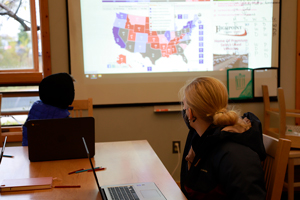 Dr. Jal Mehta is a Harvard University professor, researcher, and education reform advocate. Like Dr. Maria Montessori, Dr. Mehta believes that schools exist to equitably serve all students, and to help each child be successful and productive citizens that realize their responsibility and agency to bring about a better world. In 2020, Dr. Mehta published the book In Search of Deeper Learning in which he explores the qualities that make for deep, meaningful learning environments. Though his book focused on high schools, many of Dr. Mehta's conclusions are consistent with the practices we see throughout The Children's House, including and especially the Jr. High. We are sharing this particular article with you, not only because of Dr. Mehta's alignment with Montessori principles, but also because it highlights, amidst the Covid-19 pandemic, what continues to make our school such a special community.
Dr. Jal Mehta is a Harvard University professor, researcher, and education reform advocate. Like Dr. Maria Montessori, Dr. Mehta believes that schools exist to equitably serve all students, and to help each child be successful and productive citizens that realize their responsibility and agency to bring about a better world. In 2020, Dr. Mehta published the book In Search of Deeper Learning in which he explores the qualities that make for deep, meaningful learning environments. Though his book focused on high schools, many of Dr. Mehta's conclusions are consistent with the practices we see throughout The Children's House, including and especially the Jr. High. We are sharing this particular article with you, not only because of Dr. Mehta's alignment with Montessori principles, but also because it highlights, amidst the Covid-19 pandemic, what continues to make our school such a special community.
Dr. Montessori fought for peace among people and nations. She was part of the League of Nations - the predecessor of the United Nations. It is in our training as Montessori educators to create a community that is just, inclusive, and welcoming to all.
Author Blair Imani writes “kindness won’t end racism, anti-racism will end racism.” As Montessorians, we know that teaching kindness is not enough. That is why we are actively engaging in anti bias and anti-racist (ABAR) education.
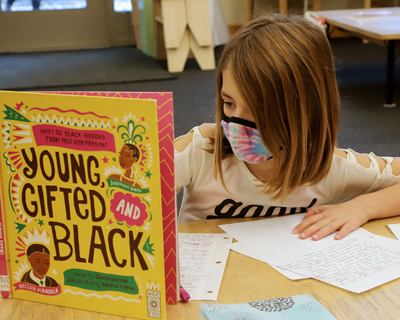 To continue the work we started when Jen Cort visited our school in October 2018, our staff read This Book is Anti-Racist by Tiffany Jewell and discussed it in small groups this fall. It is an impactful and meaningful book. It is also a guide in how to talk to young people about bias and racism. Many students in the school have read chapters with their teachers and engaged in the activities.
To continue the work we started when Jen Cort visited our school in October 2018, our staff read This Book is Anti-Racist by Tiffany Jewell and discussed it in small groups this fall. It is an impactful and meaningful book. It is also a guide in how to talk to young people about bias and racism. Many students in the school have read chapters with their teachers and engaged in the activities.
We learned from Britt Hawthorne, when she visited our school virtually in October 2020, that ABAR begins with the self. We name our own identities and we help the children with this as well. We uncover our biases and work to remove them. We have books and materials that reflect all people.
Our ABAR committee met throughout the summer talking about our dreams for the school. One of our biggest wishes was to engage with the families in our school community. During the recent months of civil unrest, I spent time gathering resources to share with you which are now present on our website. The ABAR committee stepped in to add resources for all age levels.
This work is critical toward creating a world that is inclusive for all people. We hope you will join us on this journey.
TCH Parent Book Club
Dec 10, Jan 7, Jan 21, and Feb 4 at 8 p.m. via Zoom
We will start by reading This Book is Anti-Racist by Tiffany Jewell. You can purchase this book locally through Horizon Books. Please let us know if you plan to participate by completing this Google form.
Children naturally want to do things for themselves. Regardless of their age, we have all seen this drive for independence emerge in our children and students. At times, it can feel like a great accomplishment; at other times, a challenge. For all of us who care for them, a real challenge exists in allowing children to encounter struggle. We love them and we don't want them to become frustrated. We want to protect them and not see them fail. This is a natural reaction. However, we know that it is through the act of doing that we learn about our abilities and strengths, about our challenges and areas for growth, about how to struggle and to overcome. And it is these daily lessons, experiences, and encounters that aid their belief in themself, their self-confidence, and their self-esteem.
As we guide with this perspective, we navigate the balance of providing just enough support, without becoming an obstacle in their independence. As they grow and change, this balance evolves and they often need less support than we realize. So today, take a step back. Observe. Allow your child to try. Allow your child to struggle a bit. They may surprise you in what they're able to work through on their own.
To allow young children to do things for themself is both an act of faith and an act of love - communicating we believe in them and their ability to succeed, and that we care about their growth as a human being.
To explore further, Nichole Holtvluwer has a well-written blog post on the topic.
In a Montessori environment, the goal for children at any age is independence. Dr. Maria Montessori envisioned a world where we live in harmony and are mutually reliant on one another. Still, she recognized that this is only possible when individuals are able to satisfy their own needs first. Montessori saw independence as a continuous conquest and defined growth as reaching successive levels of independence.
Young children have an inner drive to meet their own needs yet adults and the environment are often obstacles in their journey. Children need a strong emotional foundation and carefully prepared environment to develop independence. Recently, I gave a presentation on this topic as part of our Montessori Up Close parent education series. Watch the whole presentation to get practical ideas and reduce the obstacles in your child’s path towards independence.
Over the past several months, I have been participating in online forums with other Montessori school leaders where we discuss and collaborate on opening safely during COVID-19 and how to successfully return to in-person learning. While there are many health and safety details to address, there are fundamental characteristics of Montessori education that set our schools up for success.
Fortunately, here in Northern Michigan, we are experiencing different circumstances than schools in other parts of the world for whom the restrictions related to the pandemic are more strict. We are also fortunate to have the space and resources to facilitate our adaptation.
Regardless of the place we find ourselves, whether learning is in-person or at home, our Montessori principles can be applied to create a learning experience that fosters the development of every child.
Recently, Association Montessori Internationale (AMI) published an article that lays out eight ways in which our educational model fosters learning for the child, even under these difficult circumstances. Click here to read the article.
Maria Montessori taught us to believe in the potential and value of every child. As Montessorians, it is our intention to provide an environment where children and adults alike are seen and respected, and to seek to understand others for their differences and similarities. We believe a future that is genuinely equitable for all is in the hands of the children.
On September 3, 2020, our staff of 54 people engaged in an all day virtual workshop with Britt Hawthorne, a Montessorian and Anti-Bias Anti-Racism (ABAR) consultant from Houston, TX. Britt took us on a journey of self-reflection, deep discussion, and mutual agreements resulting in our commitment to ABAR education at The Children’s House.
During the 2020-2021 school year, we will facilitate age-appropriate opportunities for conversations, materials in the classrooms that reflect the experience of every child, and opportunities and resources to support discussions at home.
The approach will be different at each level, as we want to be thoughtful about developmentally appropriate topics and content for the children. Most importantly, we want every child to feel safe to ask questions, share opinions, and learn to listen to others, and be their authentic selves.
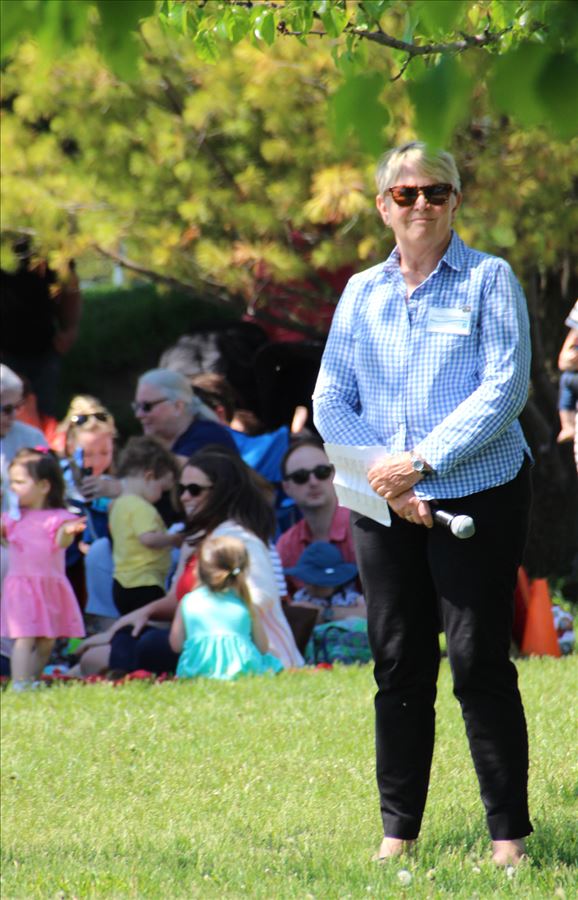 The Dance of the Cosmos celebration has marked the end of the school year every year since the school’s inception in 1984. Obviously, I was looking forward to that day to say farewell to all of you and to begin my retirement, but when COVID entered the picture, I began to shift gears. My disappointment of losing our typical year-end traditions was met with a flood of memories and emotion about my 36 years at the school. I thought about how the Dance of the Cosmos concretely shows us that we are all parts of a vastly larger picture. Our meaning and value is not based on a single event or tradition, rather it is based on the collective spirit of community we have lived over many years.
The Dance of the Cosmos celebration has marked the end of the school year every year since the school’s inception in 1984. Obviously, I was looking forward to that day to say farewell to all of you and to begin my retirement, but when COVID entered the picture, I began to shift gears. My disappointment of losing our typical year-end traditions was met with a flood of memories and emotion about my 36 years at the school. I thought about how the Dance of the Cosmos concretely shows us that we are all parts of a vastly larger picture. Our meaning and value is not based on a single event or tradition, rather it is based on the collective spirit of community we have lived over many years.
The Children’s House is the epitome of what the Dance of the Cosmos represents. TCH thrives because of the people who, from the very beginning, supported the vision and culture of the school. TCH has weathered some difficult challenges – logistics, financial uncertainty, and heartbreaking tragedy from which we thought we would never recover. What we learned was that we would recover and would actually grow closer and stronger as a result. The community has always been able to carry the school forward. TCH is living proof that the whole is truly greater than the sum of its parts.
Some of you are new families and staff that I don’t know well and many of you I know like family. I want to say to all of you that The Children’s House is much more than a school – it is a community that will support you and enrich your lives. It may take a few years to understand this, but you will see it in the strong leadership from a Board of Directors and Head of School who have created a plan for financial sustainability (yes even through a pandemic) while holding on to the culture of community that has carried this school over the years. You will see it in a teacher who loves your children as unique people who deserve a chance to discover who they are. You will see it in your fellow parents and colleagues who put their hands up to do more and more for the good of the community. You will see it in the way someone notices that you are having a bad day and reaches out to you. You will feel it when you walk into the building and know that this is truly a house devoted to the enrichment of lives of all ages.
Yes, this ending is not ideal, but the memories of all of the other years are intact in my brain. I have developed friendships here that will last for the rest of my life. My own children came with me to “work” in 1984 and my grandson is beginning in our Junior High program as I retire. These family bookends to my TCH career represent what is at the core of our school. We are here because of our children – yours and mine – and because we want this world to be a better place. I know that it will be.
I recently did the math and realized that I have been at The Children’s House longer than I haven’t been here. People ask me what I’m going to do next and I honestly don’t have an answer because I can’t quite imagine doing anything else right now other than being here. Regardless of what is next, I am one lucky person to have had the privilege of going to work every day to support this community and be with all of you. Thank you for that.
Colleen Christensen
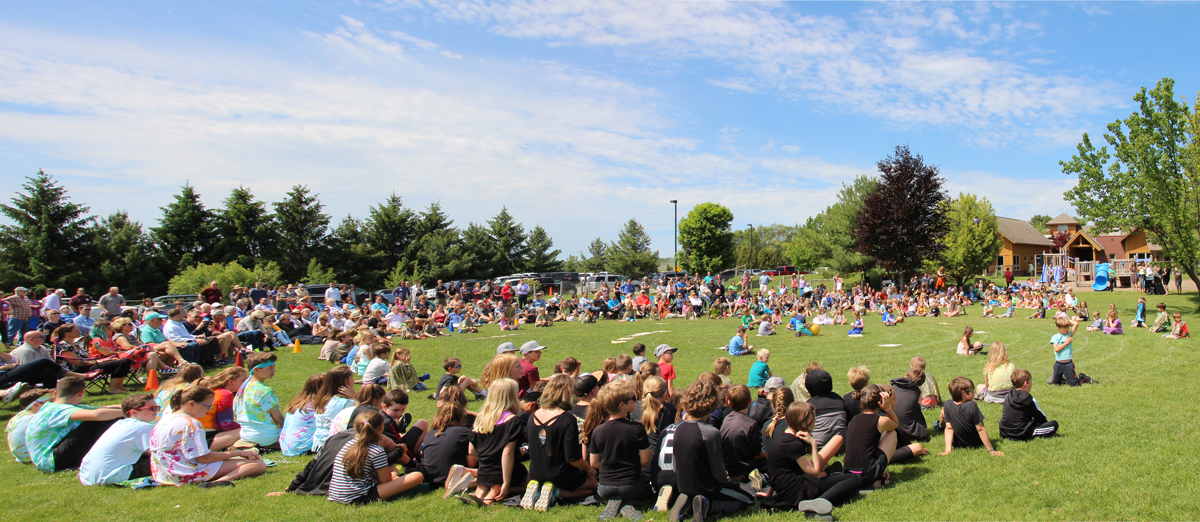
One of the fundamental and most important aspects of the work of Dr. Montessori was her tireless work toward peace. She believed that the hope for a more peaceful and equitable world lies in the child.
Over 100 years later, we are still facing injustices and inequities that shake the core of our humanity. As a school community with the privilege of helping to raise the next generation of people that take a stand against violence and mistreatment of those who have long been marginalized, it is our responsibility to help our children learn, discuss, and affect change.
We have spent time over the past few years as a staff learning about how we can evolve as people ourselves through working with experts and reading literature on anti-bias and anti-racism. I believe we have a responsibility to educate ourselves to be as equipped as we can to support the children.
In addition, we have been discussing resources (see links below) that will help you as parents find ways to have conversations and respond to your children when they ask questions around these topics. This is certainly not an exhaustive list, but it is a start.
We stand with you in support of the children as they learn about what is fair, kind and just in the world. Please don't hesitate to reach out for support from the teachers or me in navigating this challenging time to be a parent in our country.
Resources:
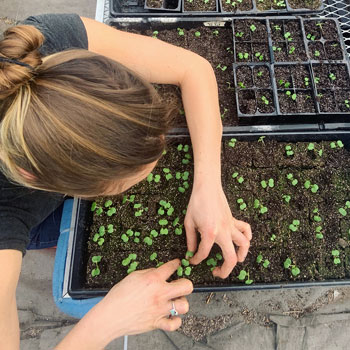 Right now we have over 1,500 plants started in the greenhouse that will grow to provide produce to local food pantries.
Right now we have over 1,500 plants started in the greenhouse that will grow to provide produce to local food pantries.
Since 2017 I have spent my summers helping manage Poesis Farm on the SEEDS property in Historic Barns Park at The Commons. This project focuses on growing food and flowers for donation, seed saving, and education. Many Children’s House students have helped on the farm and processed seeds at school. Some of our students are currently growing plants at home from our seeds.
Right now Poesis Farm is busy in the greenhouse at TCH! We have been fortunate to start our plants in the greenhouse over the last few years and this year we are able to start even more. We are partnering with local food pantries in order to give away plant starts for people to grow their own food, and we plan to give away fresh produce as well. We are also giving away our seeds by front porch pickup.
At this time with so much uncertainty and struggle, I feel excited and inspired to help by providing food for people. We know that many are unable to work and therefore purchasing food will become more of a challenge. I am happy to use my skills to lessen that burden in our area. I am grateful that The Children’s House continues to collaborate with Poesis Farm, and therefore the community, by allowing us the use of the greenhouse.
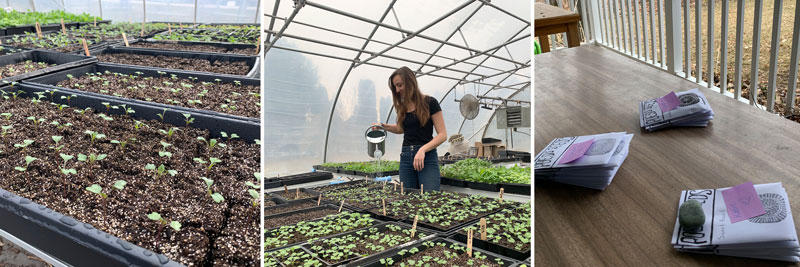
The beauty of the three-year cycle is never more apparent than when the 6th year children attend the Montessori Model United Nations conference in New York. It is not just sixth months of preparation, but years of preparation, starting well before they enter the walls of our upper elementary classroom. They’ve been developing their interests, their skills and their independence, following their unique paths to becoming who they are meant to be.
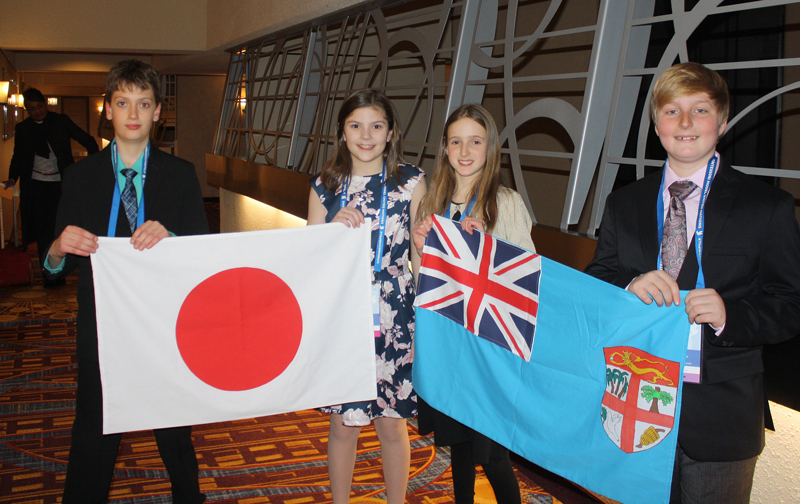 Entering as 4th year students, some fear the hard work and responsibilities of their 6th year classmates. Nevertheless, they research what interests them, broaden the scope of their worlds, and develop confidence in their ability to stretch themselves out of their comfort zones. As 5th years, they begin to accept that the challenge lies ahead and even look forward to the freedoms and responsibilities that accompany this great work. When they arrive as 6th years, they already have an air of “I’ve got this”. Yes, it wanes from time to time and the work and challenges may feel overwhelming at others, but they have faith in what they can do because they’ve been practicing and they have each other.
Entering as 4th year students, some fear the hard work and responsibilities of their 6th year classmates. Nevertheless, they research what interests them, broaden the scope of their worlds, and develop confidence in their ability to stretch themselves out of their comfort zones. As 5th years, they begin to accept that the challenge lies ahead and even look forward to the freedoms and responsibilities that accompany this great work. When they arrive as 6th years, they already have an air of “I’ve got this”. Yes, it wanes from time to time and the work and challenges may feel overwhelming at others, but they have faith in what they can do because they’ve been practicing and they have each other.
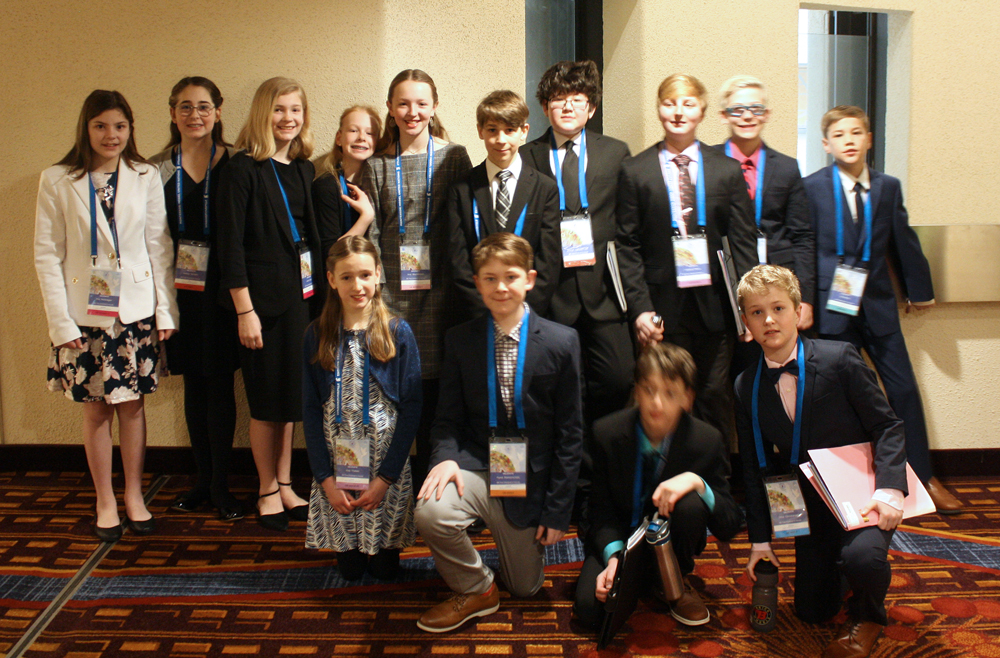 The 6th year group traveled to New York this year and followed a schedule of transportation, entertainment and dining that they created. They took the Q70 bus to the R line subway and ended up in Times Square, ready to absorb the world around them. They interacted with warmth and sincerity with children from Peru, Canada, Australia, Mexico and many states in our own country. They spoke in front of hundreds and danced in front of thousands, inspiring others to get out of their seats and dance as well.
The 6th year group traveled to New York this year and followed a schedule of transportation, entertainment and dining that they created. They took the Q70 bus to the R line subway and ended up in Times Square, ready to absorb the world around them. They interacted with warmth and sincerity with children from Peru, Canada, Australia, Mexico and many states in our own country. They spoke in front of hundreds and danced in front of thousands, inspiring others to get out of their seats and dance as well.
Tired? Yes. Satisfied, proud and accomplished? Yes. Did they see themselves achieving all they did as 4th years? Maybe. Do we see our current 4th years following in their same footsteps? Definitely.
Maybe you’ve seen the glow of the greenhouse in the morning, maybe you’ve seen students running around with lettuce at carline, or maybe you are already a valued TCH Organics customer- at any rate, you may wonder, what is all this lettuce growing about? Is it botany? Soil science? Carbon footprint analysis? Business education? Yes! And so much more!
In From Childhood to Adolescence, Dr. Montessori stated, “The essential reform is this: to put the adolescent on the road to achieving economic independence. We might call it a ‘school of experience in the elements of social life.” She found that the real work of the adolescent is to achieve social and economic independence through refining their personality and identifying their role in the future of humanity. To support this process, Montessori put forth what she called the “Plan of Study and Work,” which is intended to be a guide to designing a “prepared environment” best suited to support the adolescent’s self-construction in their current time and place. The “Plan of Study and Work” consists of practical structures of the environment that provide opportunities for this work as well as connections to the academic curriculum. In the case of lettuce, two of these structures are at work; the “farm” and the “store.”
The role of the farm in the prepared environment is to provide real work that connects the head and hand, and integrates the personality. This “work in a social context” is referred to as “occupation.” Social work means work in a society, in this case a mini society; it is not to be confused with the work of catching up on the latest events, trending fashion, or TicToks, although that does seem to happen simultaneously. The role of the store is to demonstrate in real time and experience that all of humanity is dependent on each other to produce and exchange goods and services necessary for survival (a concept introduced in elementary). In the prepared environment, this societal work is scaled to a level appropriate for the adolescent, with scaffolding for success and friendliness with failure. It provides real life experience with resource management, understanding interdependency, division of labor, and moral decision making regarding resource use.
In short, through growing and selling lettuce, students are provided with a wide range of opportunities to share their own interests and skills. Art, music, science, organization, communication, writing, research, mathematics, public relations, and problem solving are just a few of the talents or specializations required to successfully grow and sell lettuce. Not everyone can or wants to play the same role in this microeconomy. Each person gets a chance to realize their own special role as a contributor, a necessary part of the whole. Through working together on real work, adolescents develop a true sense of community, social organization, and their own value as a part of it. And, as a bi-product, we get to enjoy fresh, green, organic lettuce in February!
This past week I received an email containing an article about banning homework nationwide from a popular teacher website. The article asked us to weigh in as lawmakers contemplate this controversial topic. Another article, shared by a colleague, discusses how homework time has increased dramatically, especially for teens, yet shows no benefits for elementary students and little benefit for middle and high school students. As parents, we all want what is best for our children, but to me the real question to think about is “does doing more equal being more”?
Having no homework has been a cornerstone of our Montessori philosophy for over a hundred years. Just as we don’t dictate the work the students do in class, we don’t do so at home either. Instead, we encourage using the hours outside of school to nurture interests and enjoy leisure time together as families. Home is a place to explore curiosities, and to share in the responsibilities of the household. Skills are naturally honed by cooking alongside a parent, writing a shopping list or playing a board game. Time spent curled up with a good book, or tackling a challenging jigsaw puzzle together is invaluable.
As children walk out the door the final day of school they often share with me the topics of future studies they are excited to pursue independently over the summer. Parents have sent pictures of their child’s cardboard creations held together rolls of tape, paint and glue. I hear tales of fantastic tree houses built, bread baked, trails hiked, books read and bike rides taken. To me this is real homework. Given the time and space, our children challenge themselves and investigate what is meaningful to them. This in turn develops happy, well-balanced human beings that we all are striving to become.
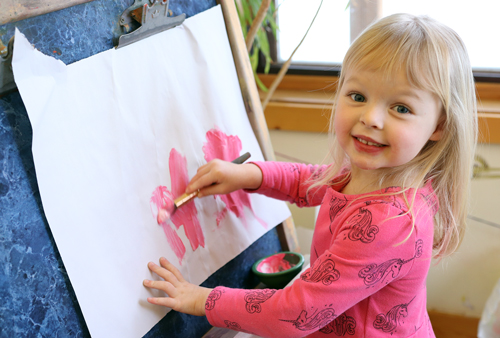 One of the most challenging parts of being a “Montessorian” is explaining the method to other people. We’ve all tried to come up with the perfect elevator speech and the most compelling case to sway a skeptic. However, it seems that most of the push-back is founded on misunderstandings. Among the points of contention is the idea that Montessori environments are too structured and don’t allow for creativity. It is true that Montessori materials are rooted in the real world rather than fantasy (research shows most children under five can not distinguish between what is real and imaginary); yet, a fundamental principle of the Montessori method is to value process over product.
One of the most challenging parts of being a “Montessorian” is explaining the method to other people. We’ve all tried to come up with the perfect elevator speech and the most compelling case to sway a skeptic. However, it seems that most of the push-back is founded on misunderstandings. Among the points of contention is the idea that Montessori environments are too structured and don’t allow for creativity. It is true that Montessori materials are rooted in the real world rather than fantasy (research shows most children under five can not distinguish between what is real and imaginary); yet, a fundamental principle of the Montessori method is to value process over product.
Creativity is defined as, “the use of the imagination or original ideas, especially in the production of an artistic work” (Oxford Dictionary). The clearest example of this is on a primary art shelf. We value the child’s process by choosing art mediums for them to explore rather than paint by number type crafts. Your primary child might bring home an easel painting from their Montessori environment but probably not a perfectly made snowman that looks just like the model an adult made. Where would the originality be in that? If a child didn’t come up with it themselves, they are not exercising their creative brain.
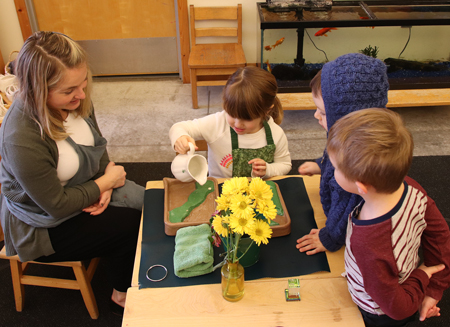 The Montessori method is also inherently creative because we only provide children with the keys to the world. Rather than providing the child with every experience, we give them the sufficient minimum of information needed to learn the remaining elements on their own. For example, Montessori primary guides only directly teach six land and water forms so the child can independently discover the rest. They are given the opportunity to see a new water form in a book, research it and feel the joy that comes with unearthing new information. Similarly, children are invited to explore materials in new ways and even combine multiple materials as they innovate and imagine new possibilities. Our exact presentations are intentionally designed to be a jumping off point that pushes the child to exercise their creativity.
The Montessori method is also inherently creative because we only provide children with the keys to the world. Rather than providing the child with every experience, we give them the sufficient minimum of information needed to learn the remaining elements on their own. For example, Montessori primary guides only directly teach six land and water forms so the child can independently discover the rest. They are given the opportunity to see a new water form in a book, research it and feel the joy that comes with unearthing new information. Similarly, children are invited to explore materials in new ways and even combine multiple materials as they innovate and imagine new possibilities. Our exact presentations are intentionally designed to be a jumping off point that pushes the child to exercise their creativity.
So how can we support children’s creativity outside of school? Ask open-ended questions. Let children explore to answer questions on their own. Let them take risks and make mistakes. Allow them to problem solve. Allow children to complete a task in a different way. Accept imperfection and embrace imagination rooted in the real world.
In November 2019, Megan Andrews, Karin Church, and I attended a professional development workshop with Marc Brackett, founder and director of the Yale Center for Emotional Intelligence. The day reminded us of the importance of emotional intelligence and provided us with new ways to help our students learn about their emotions. We know that emotions impact learning and were reminded that there are no bad emotions and that emotions provide information. We can use that information to help ourselves and each other. Providing students direct instruction on how to Recognize, Understand, Label, Express, and Regulate emotions can help in many ways. This R.U.L.E.R. approach is the basis of Brackett’s work. If our kids can know and manage themselves and consider the perspectives of others, they may be able to make sound personal and social choices.
Being patient, responsive, and loving, while holding children to a high standard, is much easier if we as adults are able to manage, understand, and accept our own emotions and know that our emotional state will affect how we perceive a situation. Learning is a social activity and is most productive through collaboration. Maria Montessori gave us a solid foundation with many lessons on what she called grace and courtesy. Young children are shown how to quietly push in a chair, walk through the classroom without disturbing another child’s work, and even how to blow their nose. The Montessori curriculum at every level explicitly uses modeling and stories to teach social behavior. Children have many opportunities daily to collaborate with classmates and practice social skills. Older students act out social situations demonstrating successful or unsuccessful ways to interact with others. Adults tell stories hoping to inspire good deeds.
We learned that one in five American children will experience a mental health issue before they reach eighteen. By taking the time to get to know children and building strong relationships with them, we hope to help stem this tide. Greeting each student in the morning with a handshake, allowing time to discuss feelings, and guiding actions all help to build trusting caring relationships.
Over the years, we have hosted several discussions on the topic of child development and digital technology. I continue to be interested in the topic and have recently read books by Nir Eyal and Anya Kamenetz. Kamenetz, in her book, The Art of Screen Time, How Your Family Can Balance Digital Media & Real Life, mentions differential susceptibility. Or, dandelions versus orchids. Most children, like dandelions, are hardy, resilient, and do well in a wide variety of situations. Some children, like orchids, are more susceptible to harmful effects without close supervision. That being said, I think it is smart to notice what is being missed when large amounts of time are spent alone looking at screens. Kamenetz also points out that all screens are not created equal. Facetime with grandma is not the same as whatever educational app they use or watching another episode of Peppa Pig. My key takeaway from Kamenetz’s book is: enjoy screens; not too much; mostly with others.
Indistractable; How to Control Your Attention and Choose Your Life, is a book by Nir Eyal that discusses our actions being either traction toward or distraction from what we really want. We can think about what we truly want to happen in our days, weeks, and years of our lives and then decide if our actions are helping or hindering our goals. Even young children can begin to have conversations about how and when to best use digital technology. If children are involved in setting priorities, they can learn to make time for what is important to them and how to avoid distraction.
Maria Montessori believed that learning happens through observation. Our children learn how to use digital media by watching how we use it. I am trying to make more time in my life for traction toward the things I value and hope my children, both adults now, still learn a bit by watching the old man.
Last year, Lisa Thauvette, TCH parent, moderated two round table discussions about children and digital technology with our school community and has since written an article on the topic. If you’d like to gather as a group and discuss this further, let me know. I think it would be time well spent.
The Montessori work cycle happens in every prepared environment at The Children’s House. Depending on the age group, the work cycle can last from two to three hours in the morning and an additional period of time in the afternoon.
Why is this work cycle so important for the children?
Engagement.
The work cycle is when deep concentration and learning occurs. Children have the opportunity during this period of time to choose activities and work, uninterrupted, to the point of self-satisfaction. Sometimes, that activity may last just a few minutes, and other times, several hours. If the child is using the material for its intended purpose, adults do not arbitrarily end the child’s engagement with an activity.
At each developmental level the work cycle looks a little different.
In the early childhood years, children are typically offered presentations on an individual basis by the teacher during the work cycle. Children work at individual tables or rugs, using the material until they feel satisfied before replacing it on the shelf.
During the elementary and adolescent years, students join in small group presentations. Because children of this age require a great deal of socialization, activity typically happens collaboratively with peers. Students keep work logs and meet regularly with their guide one on one to ensure progress is being made with academic expectations.
At every age group, Montessori guides are keen observers of student work choices. They keep careful notes on each child’s activity during the work cycle and plan lessons accordingly. They also make note when a child seems to be avoiding particular activities and may give a follow up lesson on a material or invite the child to get support from a peer.
Ultimately, the uninterrupted work cycle offers children the opportunity to engage deeply in work, and to develop a sense of independence and confidence. The children learn to love learning because of the freedom they are given to choose what is of highest interest to them. Creating an environment where students can become passionate learners who go out in the world to make a difference doing what they love, is precisely what we aim for.
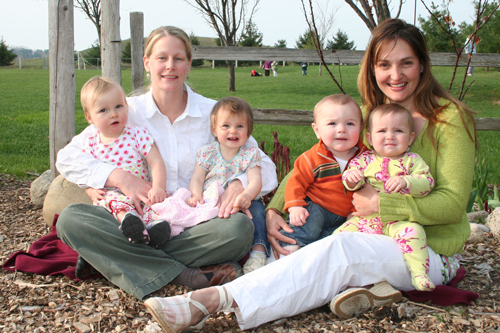 That year, I was given the chance to do something I had longed for many times. In September of 2007, I took charge of the Nido program at The Children’s House, and my dream of guiding infants came true. The Nido program itself was still in its infancy and just four babies, Alexander, Dillyn, Elise, and Lola, were put under my care for the school year.
That year, I was given the chance to do something I had longed for many times. In September of 2007, I took charge of the Nido program at The Children’s House, and my dream of guiding infants came true. The Nido program itself was still in its infancy and just four babies, Alexander, Dillyn, Elise, and Lola, were put under my care for the school year.
Each one of them joined me at about twelve weeks old, Lola was even younger. At the time it did feel as though I had my own set of quadruplets, it was just me and the four of them all day, all year. Of course, I could call for backup but I rarely did. Dillyn’s mother called them my four calling birds. And because the word Nido is the Italian word for “nest” that made perfect sense to me.
So, these freshly hatched humans and I got to work getting to know each other. I remember thinking about them day and night, and how I could make their first year of life the best that I could. I sourced new activities constantly, in order to meet the growing needs and interests of each one of them. I planned our days to include walks, and a variety of sensorial experiences. I made sure we participated in gross motor and fine motor work everyday. We sang, we read, we ate, we rocked to sleep. I went home pretty exhausted everyday but we were a happy flock, and I loved my job very much.
And like all baby birds do, mine outgrew our cozy nest. One by one each one learned to walk, and talk, and do for themselves and I had to say goodbye.
Luckily they didn’t fly too far. I was able to witness their continued growth from afar. Each of them moved through the toddler and preschool programs at TCH and I would see them on the playground or at our all-school gatherings. Eventually, Alexander and Dillyn would leave our school for a different elementary experience but would return every year for our school’s summer program. Elise and Lola both stayed on through elementary and would often visit the Nido, to read and play with the babies.
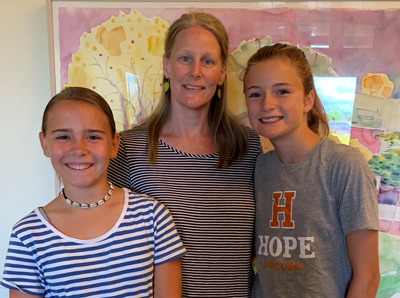 But last summer, the summer of 2019, the most wonderful thing occurred. Dillyn and Lola migrated back to their original nest as junior counselors! Now they were twelve years old. They each took turns being assigned to help me in the Nido. My sweet calling birds took on their new roles with confidence and ease. Their care of the infants and their strong work ethic impressed me each day. I often found myself overjoyed and beaming with pride in seeing their maturity and effortless care of infants. I would even tease the girls that they were so good at their jobs because of the great foundation I laid out for them early on.
But last summer, the summer of 2019, the most wonderful thing occurred. Dillyn and Lola migrated back to their original nest as junior counselors! Now they were twelve years old. They each took turns being assigned to help me in the Nido. My sweet calling birds took on their new roles with confidence and ease. Their care of the infants and their strong work ethic impressed me each day. I often found myself overjoyed and beaming with pride in seeing their maturity and effortless care of infants. I would even tease the girls that they were so good at their jobs because of the great foundation I laid out for them early on.
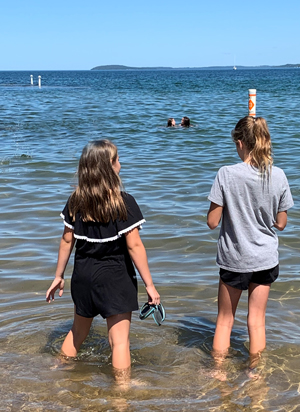 During the last week of the summer program, I decided I wanted to do something special to thank them for their hard work. I arranged a surprise outing for the three of us. I picked them up at school and we went out for ice cream, dipped our toes in the lake, and played games at the local arcade. We chatted about their lives as young adults and about their hopes for their future. We had a wonderful time. I made them promise to stay in touch and should they ever need a personal reference I’d be pleased to give them a glowing one.
During the last week of the summer program, I decided I wanted to do something special to thank them for their hard work. I arranged a surprise outing for the three of us. I picked them up at school and we went out for ice cream, dipped our toes in the lake, and played games at the local arcade. We chatted about their lives as young adults and about their hopes for their future. We had a wonderful time. I made them promise to stay in touch and should they ever need a personal reference I’d be pleased to give them a glowing one.
“Two of the greatest gifts we can give our children are roots and wings,” wrote Hodding Carter. Alexander, Dillyn, Elise, and Lola - I am in awe of you. Your TCH roots are strong and sturdy, fly on my little birdies!
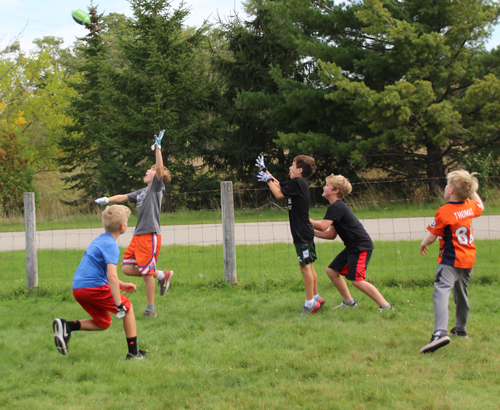 Maria Montessori said, “Play is the work of the child.” One of my favorite topics is play. I define play as: activity for enjoyment or recreation rather than for serious or practical purpose, it is self directed. Play helps our children develop curiosity, social intelligence, creativity, and both physical and mental health. These skills are at least as important as IQ when looking at future success in life.
Maria Montessori said, “Play is the work of the child.” One of my favorite topics is play. I define play as: activity for enjoyment or recreation rather than for serious or practical purpose, it is self directed. Play helps our children develop curiosity, social intelligence, creativity, and both physical and mental health. These skills are at least as important as IQ when looking at future success in life.
Dr. Peter Gray, an evolutionary developmental psychologist, wrote in his book, Free to Learn, “Research studies have shown repeatedly that adults who have a great deal of freedom as to how and when to do their work commonly experience that work as play, even – in fact, especially – when the work is difficult. In contrast, people who must follow others’ directions, with little creative input of their own, rarely experience their work as play. Moreover, dozens of research studies have shown that when people choose to perform some task, they perform it more fully and effectively than when they feel compelled by others to perform it.”
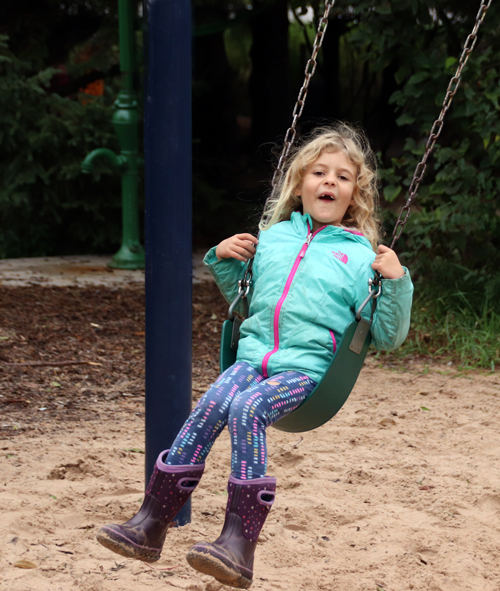 At The Children’s House, play is valued as an important part of children’s development. We have recently extended recess and the children have always had the ability to play with things of their choosing, they just call it “work.” Students at The Children’s House do not have a teacher telling them which activity to choose or how long to use it. You will often see things being left out overnight so the work can resume in the morning. There are very few products of their work because it is undertaken for the joy of doing it and not in order to create a product. I have often observed children polishing a mirror to a fine shine only to see them start right back at the beginning. They are not polishing the mirror to make it shine, they are building themselves and working on mastery.
At The Children’s House, play is valued as an important part of children’s development. We have recently extended recess and the children have always had the ability to play with things of their choosing, they just call it “work.” Students at The Children’s House do not have a teacher telling them which activity to choose or how long to use it. You will often see things being left out overnight so the work can resume in the morning. There are very few products of their work because it is undertaken for the joy of doing it and not in order to create a product. I have often observed children polishing a mirror to a fine shine only to see them start right back at the beginning. They are not polishing the mirror to make it shine, they are building themselves and working on mastery.
“Education is a natural process carried out by the child and is not acquired by listening to words but by experiencing the environment.”
- Maria Montessori
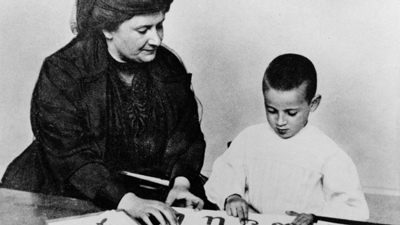 We know Dr. Montessori was a scientist, she observed children and made groundbreaking observations about the way they learn. Perhaps, more admirable is the way she connected childhood to being human. She made it possible for adults to see children as extensions of themselves, working towards the same goals and deserving of the same treatment.
We know Dr. Montessori was a scientist, she observed children and made groundbreaking observations about the way they learn. Perhaps, more admirable is the way she connected childhood to being human. She made it possible for adults to see children as extensions of themselves, working towards the same goals and deserving of the same treatment.
It is easy for us to see children through an immediate lens, as little people trying to meet their basic needs. They search for food, clothing, shelter, defense, and ways to move. They also long for love and other spiritual needs. If we zoom out, the child’s tasks are much bigger. In the first six years of life, the child has two key duties: to construct themselves and to adapt to their environment. What is driving the child to do this? Dr. Montessori saw and wrote about the human tendencies, defined as urges or natural inclinations that drive humans to meet their needs.
The fourteen human tendencies are hereditary, unchanging, and interrelated. They are universal to all humans regardless of time and culture, but are significantly powerful during the first six years of life. If we want to understand what guides our children to become who they are, we need to recognize and understand the fourteen human tendencies. I will outline them below and invite you to reflect on how they might inform the way you support your child.
Exploration: The more we explore, the deeper we understand the world and the more we can improve the human condition. The adult can support this tendency for the child by ensuring freedom of movement, freedom of choice, and a beautiful and orderly environment.
Orientation: To be comfortable, humans need to place themselves in relation to their environment. This is the inclination to find a point of reference. Young children are very new to their environment and need a predictable, safe and reliable space with minimal stimulation.
Order: Physical order brings mental order. Order gives a young child comfort and freedom, which are essential for engagement and learning.
Communication: Communication allows humans to correspond about satisfying their needs, transfer knowledge, and share stories. The adult can provide a clear model of language. Freedom to communicate in the environment is also essential.
To Know/To Reason: The tendency to know and to reason is especially prevalent in the elementary mind. The adult should inspire children to reason for themselves by providing resources for children to find their own answers.
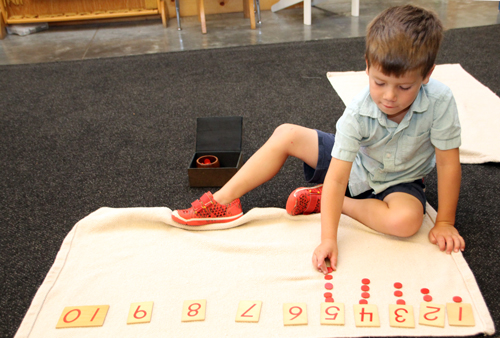 Abstraction: Abstractions are concepts that are not tangible in the child’s reality. Maria Montessori made abstract concepts, like quantity, color, and subtraction, concrete by creating materials that the child could manipulate with their hands.
Abstraction: Abstractions are concepts that are not tangible in the child’s reality. Maria Montessori made abstract concepts, like quantity, color, and subtraction, concrete by creating materials that the child could manipulate with their hands.
Imagination: The Montessori environment provides the child with a strong basis of the concrete world as a springboard for imagination. The adult must allow for the child’s own creativity by providing quality tools and letting children choose how to use them.
Mathematical Mind: We use mathematical thinking to measure the amount of flour in a recipe or the length of a table that is to fit through a doorway. To nurture this human tendency in the child, the adult must provide presentations in sequential order so concepts build off of previous understandings.
Work: Work is needed for survival, satisfaction, happiness, capacity, spirit, and turning ideas into reality. The adult must know how to choose inspiring, authentic, purposeful, and constructive work that will satisfy the child, rather than busy work that might satisfy the adult agenda.
Repetition and Exactness: Repetition and exactness are key characteristics of work that are very apparent in children. The adult must provide freedom to repeat activities that require exact movements.
Activity and Manipulation: Activity unites the mind and the body. Children need opportunities for movement and motives for movement, including activity of the hands.
Self-Perfection: Humans have a natural tendency to persevere and an inner compulsion to be self-disciplined. In order to support the child’s search for excellence, we must provide appropriate freedom and allow children to self-correct.
The first days of a new school year usher the children in with the promise of extraordinary potential. As they settle back into the routine of classroom life with one another, the guides take great care to establish a positive tone, respect, and care.
Grace and courtesy lessons are one of the most fundamental aspects of a Montessori classroom. These lessons provide clear and tangible guidelines for how to care for one another, the classroom and themselves. As we reestablish routines, these lessons are offered frequently to the children to establish expectations for behavior.
In the Young Children’s Community (YCC), a lesson may simply be quietly helping a child learn how to carefully walk through the environment. The guide may simply say “I am showing you how to carefully walk in our classroom.”
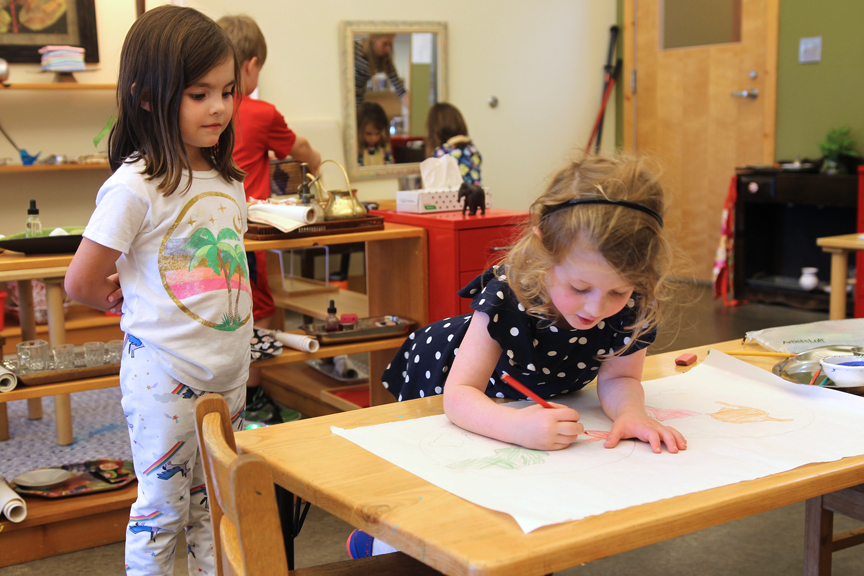 In a Primary classroom, these lessons become a bit more formalized. The guide gathers a small group of children to sit on the floor. She would say to the group “I am going to show you how to observe someone’s work.” She would then demonstrate how to ask a working child if she may observe, and then stand quietly with her hands at her sides as she observes. She then would offer a child or two the opportunity to demonstrate the skill, and end the lesson by saying “Now you know how to observe someone’s work.”
In a Primary classroom, these lessons become a bit more formalized. The guide gathers a small group of children to sit on the floor. She would say to the group “I am going to show you how to observe someone’s work.” She would then demonstrate how to ask a working child if she may observe, and then stand quietly with her hands at her sides as she observes. She then would offer a child or two the opportunity to demonstrate the skill, and end the lesson by saying “Now you know how to observe someone’s work.”
Lessons in grace and courtesy are offered to children to provide opportunities to practice the skills needed to coexist with others. It can be as simple as how to walk around someone’s work, or as complicated as what you could say to someone who was feeling sad or left out. I once offered a grace and courtesy lesson on what to say to someone if their nose was running. It was so fun to see that lesson carried out in the life of our classroom. Children were offering one another tissues every day!
Sometimes, adults expect children to know how to be graceful and courteous and when they aren’t, they correct the behavior in the moment. In our classrooms, we make note when we observe a child who may need a lesson and, at a time later, invite them to join a lesson that teaches that skill. In this way, a child doesn’t feel corrected or ashamed for simply not knowing the appropriate action in a situation.
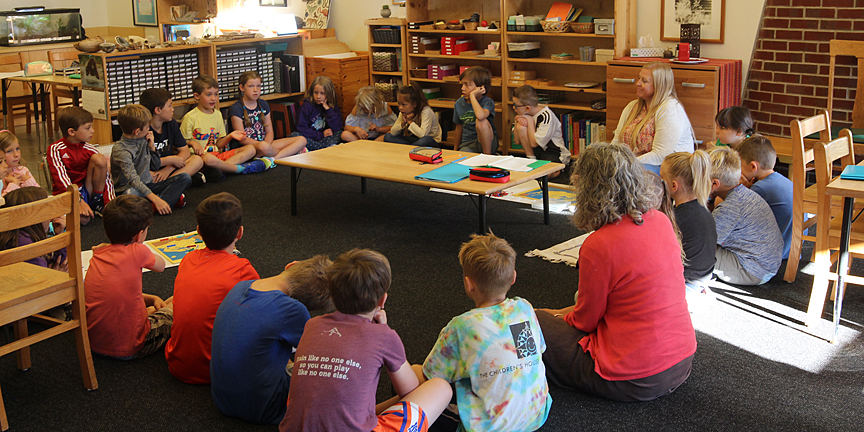 Once children are in Elementary and Junior High, conversations occur as a group to create mutual expectations of one another. Rather than having rules imposed from the teacher, children discuss how they want to coexist in their classroom and create a class creed through their conversations.
Once children are in Elementary and Junior High, conversations occur as a group to create mutual expectations of one another. Rather than having rules imposed from the teacher, children discuss how they want to coexist in their classroom and create a class creed through their conversations.
When we grow graceful, courteous children, we offer the promise of a society where humans can peacefully coexist with compassion, empathy, and peace. I love the thought that Montessori schools all over the world are providing these opportunities for children every day— to learn the skills to care for themselves, one another, and their world.
The end of the school year at The Children’s House brings celebrations, traditions, and endings. It is important to note the passage of time by honoring each developmental milestone. It helps the children to mark their place in the continuum of their development with memorable experiences.
During her countless hours of observing children, Maria Montessori noted very distinct characteristics in each developmental age group. She called them Planes of Development. The first plane spans from birth to six years, the second from six to 12, and the third from 12 to 18.
The “Stars” of The Show
The first plane of development encompasses a child’s most profound period of physical and cognitive growth. In just six years, a child goes from being completely dependent on adults to being able to ride a bike, read, independently meet her own needs, and care for the environment and those around her. Because the change is so great, this first plane requires three separate classroom settings: Nido, Young Children’s Community (YCC), and Primary.
At The Children’s House, we respond to this developmental growth by providing children with increasing freedom and responsibility—from walks on the school grounds to community field trips and tasks that help them learn to care for one another and their environment. At the end of this plane, we celebrate the children by giving them prominent roles of the planets and comets in our Dance of the Cosmos celebration. It only makes sense for them to be the “stars” of the ceremony as we honor the completion of this foundational developmental plane.
Spreading Their Wings
Around the age of six, children move into the second developmental plane. This plane is marked by a move from concrete to more abstract thinking, the development of reasoning ability, and a focus on social relationships. In the elementary classroom, students work collaboratively, utilizing the strengths of every individual to complete work and care of their physical and social/emotional environment.
The culmination of this second plane at The Children’s House is the trip to Montessori Model United Nations (MMUN), where all of the skills they have acquired during this plane culminate in the writing of position papers and working on teams of children from all over the world to ponder solutions for real life issues. They are certainly ready to spread their wings in this way and prove to themselves and others their level of maturity that has come from this conscious phase of development.
The Middle Years
The third plane of development marks the ending of childhood and the passage into adulthood. In early adolescence (ages 12 to 15), young adults are exploring and coming to terms with integrating different aspects of themselves. This is a period of rapid growth and early adolescents need enough food and sleep, as well as time to process and reorient. All Montessori classrooms nourish the whole child—academic, emotional, social—but the adolescent experience adds personal reflection to particularly support students at this phase of growth.
Our school provides these experiences through a variety of outings and overnight trips to give real life, hands-on experiences with the topics they study in the classroom. They are given the responsibility to independently plan and execute itineraries of their outings. Students support each other and work together to problem solve when mistakes happens or conflicts arise. Graduating eighth years get the spotlight and take the stage to deliver speeches reflecting on what life at the school has meant for them and who they aspire to be as they move on to high school and older adolescence.
The Bittersweet
Being the parent of a high-schooler who spent her life at The Children’s House from three months through eighth grade, I can tell you firsthand why marking the passage of each plane of development with traditions and celebrations is so important. My daughter looks back with clear memory of being a comet in the Dance of the Cosmos, traveling to New York City the first time to discuss the rights of the child at MMUN, and, her final speech reminiscing and giving thanks for the experiences—thanks to teachers and friends—and the lasting memories she made here.
Traditions and celebrations are a deeply-rooted part of our school community. As the school has grown over the last 35 years, these events have evolved along with it to appropriately represent growth through all three planes. Endings can be bittersweet, but we choose to celebrate them to mark the completion of one chapter of life and the potential that held with the passage to the next plane.
In 2015, The Children’s House published a strategic planning document, Strategic Plan 2015, that guided our decisions through the 2017-2018 school year. The plan was generated through a comprehensive phase of discovery that included input from focus groups, research on best practices from independent schools nationwide, an organizational assessment, and goals set by our Board of Directors.
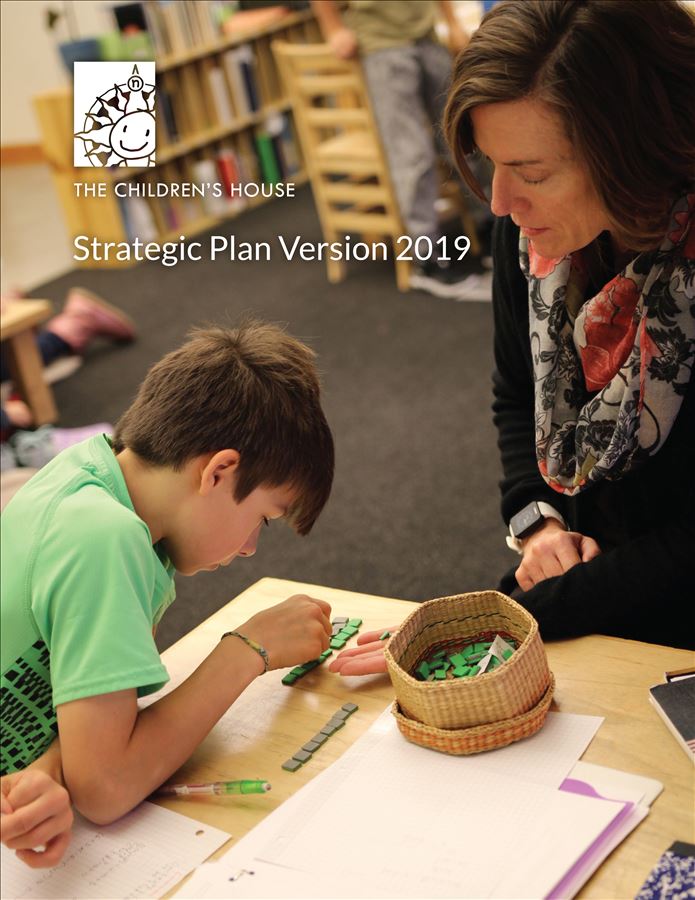 Over the last four years, this strategic document was integral in creating priorities to strengthen and grow our school community. Major accomplishments include launching our adolescent program (TCHJH), adding 2,600 square feet of classroom and fine arts space, strengthening our fiscal health and building cash reserves, and implementing new methods of communicating with families.
Over the last four years, this strategic document was integral in creating priorities to strengthen and grow our school community. Major accomplishments include launching our adolescent program (TCHJH), adding 2,600 square feet of classroom and fine arts space, strengthening our fiscal health and building cash reserves, and implementing new methods of communicating with families.
With the dedication and focus of the board, administration, faculty, and staff, we were able to accomplish all of our goals, putting us ahead of our expected timeline. It took every member of this community to reach these goals and we are proud of where we are today.
In the fall of 2018, we gathered again to generate the next iteration of our plan. Building on the thorough strategic planning work carried out in 2015, the board set to work to create a vision for the next 3-5 years. Valuable input from our dedicated staff was collected to generate a new vision for the future of our school community.
We are pleased to share our Strategic Plan Version 2019 which will be used to uphold the vision of high-fidelity, independent Montessori education for all of our 247 students. We are excited by what the future holds for The Children’s House and look forward to sharing the journey with you.
As part of my morning routine, I read “The Management Tip Of The Day” from the Harvard Business Review. This recent entry (from February 25th)—which I think applies to business and the way we educate our students here at The Children’s House—so piqued my interest that I thought I’d share:
We all need to keep learning new things to grow in our careers. But sometimes the urgency of our schedules gets in the way. To find time for learning, make it a part of your day-to-day tasks. One way to do this is to look for ways to pick up skills from those around you. Notice how your boss handles a negotiation; ask sales people about industry trends; get feedback from your peers after you give a presentation. Of course, there will be times when something piques your interest but you’re too busy to explore it. When this happens, try creating a “to-learn” list: write down concepts, ideas, and practices that you want to return to at a later time. And create a learning channel for your team, whether it’s through Slack, SharePoint, or somewhere else. Add links to resources you’ve found valuable — it will encourage your colleagues to do the same.
Learning how to negotiate by observing other students and adults…Get feedback from peers after a presentation or an action…Take note of something you want to learn later when there’s time to explore it.
Doesn’t this sound like a typical Montessori classroom?
One of the beautiful things about a Montessori classroom environment is that learning for children is interactive, joyful, and often effortless. Never forced. Rich learning experiences are happening constantly, from a multitude of angles. And the real beauty is that sometimes children don’t even know it’s happening. The idea of “weaving learning into work” is fundamental and a function of daily life in the Montessori classroom. It’s natural. And as our students grow and, eventually, move into higher education and adult life, learning is what they love because it’s part of who they are, something they have always done, and found joy in everyday of their lives.
Think back to a time when you were a child, passionate about learning something new. Whether it was experimenting with new words, creating art, riding a bike, or how a science experiment worked, it is likely that you practiced repeatedly to a point of great satisfaction. By continuing to have interest and engage in the activity, you mastered the skill without even knowing you were working hard to learn.
 Children are born with an innate sense of curiosity. They look at the world with wonder, excitement, fresh eyes, and an insatiable desire to explore their world and learn. Wouldn’t it be incredible if we could do something to help perpetuate that wonder and love of learning as they continue to grow up?
Children are born with an innate sense of curiosity. They look at the world with wonder, excitement, fresh eyes, and an insatiable desire to explore their world and learn. Wouldn’t it be incredible if we could do something to help perpetuate that wonder and love of learning as they continue to grow up?
The greatest gift we can give our children is to provide them the time and space for their curiosity to work its magic-- to slow down, encourage exploration, provide them opportunities to engage with the world, and be patient. Learning is a natural process that happens best when we provide them with the right conditions and don’t interfere.
When I talk with parents about their hopes and goals for their children, one of the things that is at the top of nearly every parent’s list is that their child is happy and loves learning throughout his or her life. Naturally, in Montessori, we revel in the chance to talk about life-long learning. Our environments and methodology provide the perfect place for every child to learn through interest, freedom to act on their curiosity, and uninterrupted time.
Activities, or what we call “work” in our Montessori setting, is beautiful, orderly and inviting. The materials beacon the children to explore them through their order and simplicity. Every activity is specifically designed to aid the child in learning a specific concepts. No bells, whistles, or complicated instructions included.
 With support from a Montessori teacher or “guide,” the child is encouraged to choose work based on their interest and ability. When the perfect balance of challenge and interest is achieved, a child becomes deeply engaged in their work and concentrates to a point where they hardly notice the activity of other children around them. And, this “sweet spot” of engagement, is what keeps the child coming back for more-- to explore new challenges and continue to be interested in the world around them. And to love their work.
With support from a Montessori teacher or “guide,” the child is encouraged to choose work based on their interest and ability. When the perfect balance of challenge and interest is achieved, a child becomes deeply engaged in their work and concentrates to a point where they hardly notice the activity of other children around them. And, this “sweet spot” of engagement, is what keeps the child coming back for more-- to explore new challenges and continue to be interested in the world around them. And to love their work.
The world’s leading researcher on positive psychology and happiness, psychologist, Mihaly Czikszentmikalyi, referred to this deep engagement as flow, or a state of concentration or complete absorption with an activity at hand. He describes it as being in the grove, fully immersed in the task at hand. He states:
“The best moments in our lives are not the passive, receptive, relaxing times… The best moments usually occur if a person’s body or mind is stretched to its limits in a voluntary effort to accomplish something difficult and worthwhile.”
In a world that is increasingly becoming more fast-paced, technology driven, and distracting, there has never been a more important time to provide opportunity for our children to have uninterrupted time. In their Montessori environment, the children have long, blocks of time to be curious, choose work that is interesting and challenging, experiment trying things, fail and repeat.
Step into a Montessori classroom and observe sometime. You will see children engaged with their work, happily learning on their own or side by side with a peer or two. The activities they will be working on will be as varied as the individual children are themselves, chosen based on their interests, abilities and curiosity. And, given uninterrupted time to engage doing things they enjoy, the natural consequence is that they love what they do.

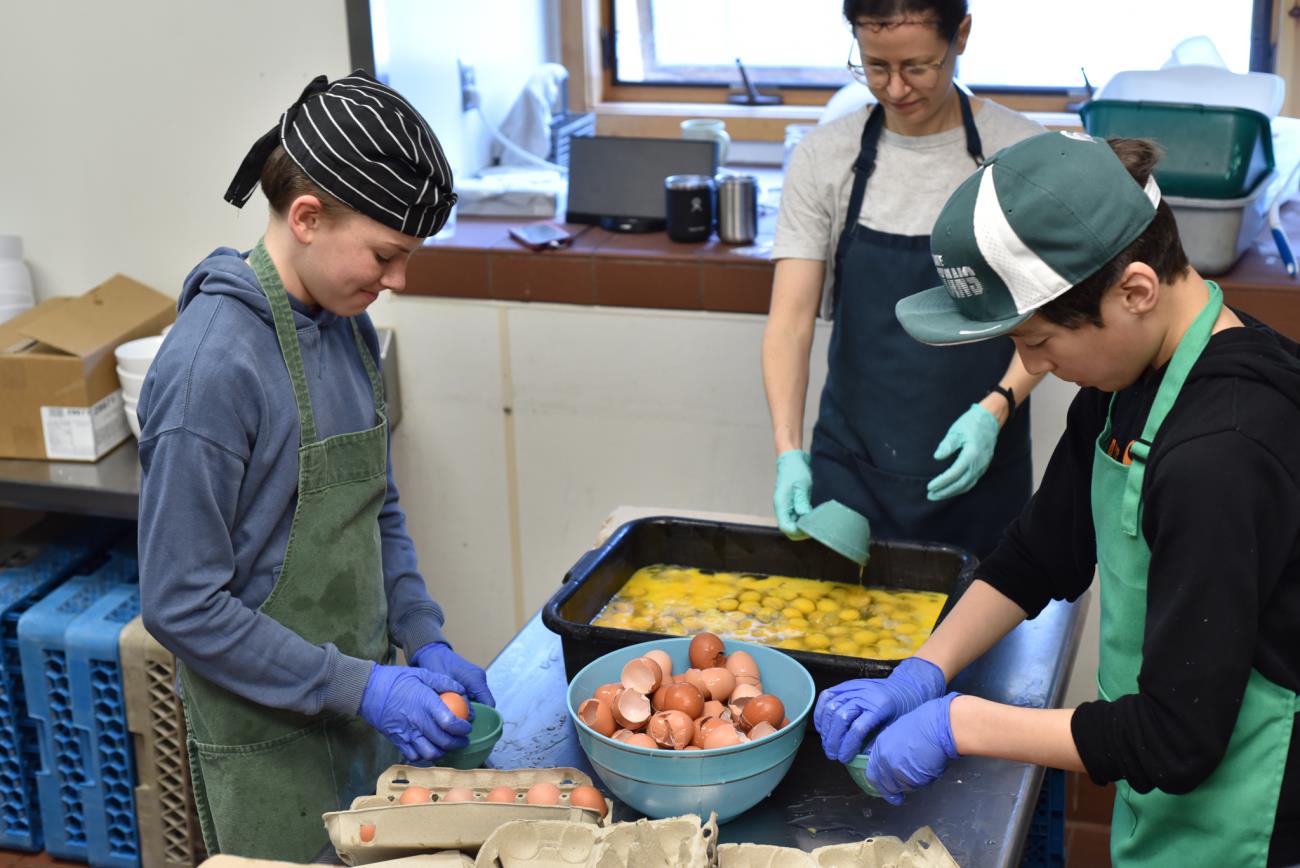
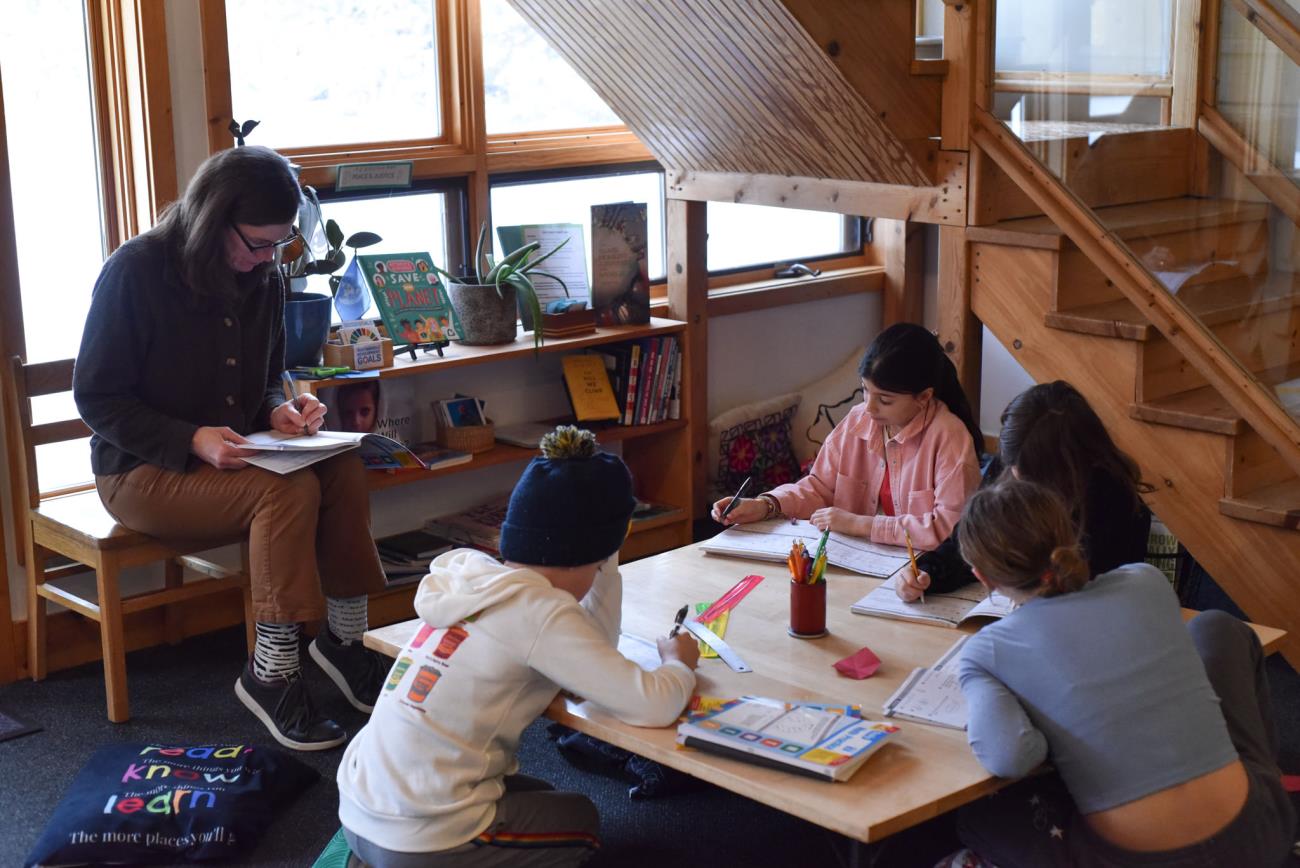
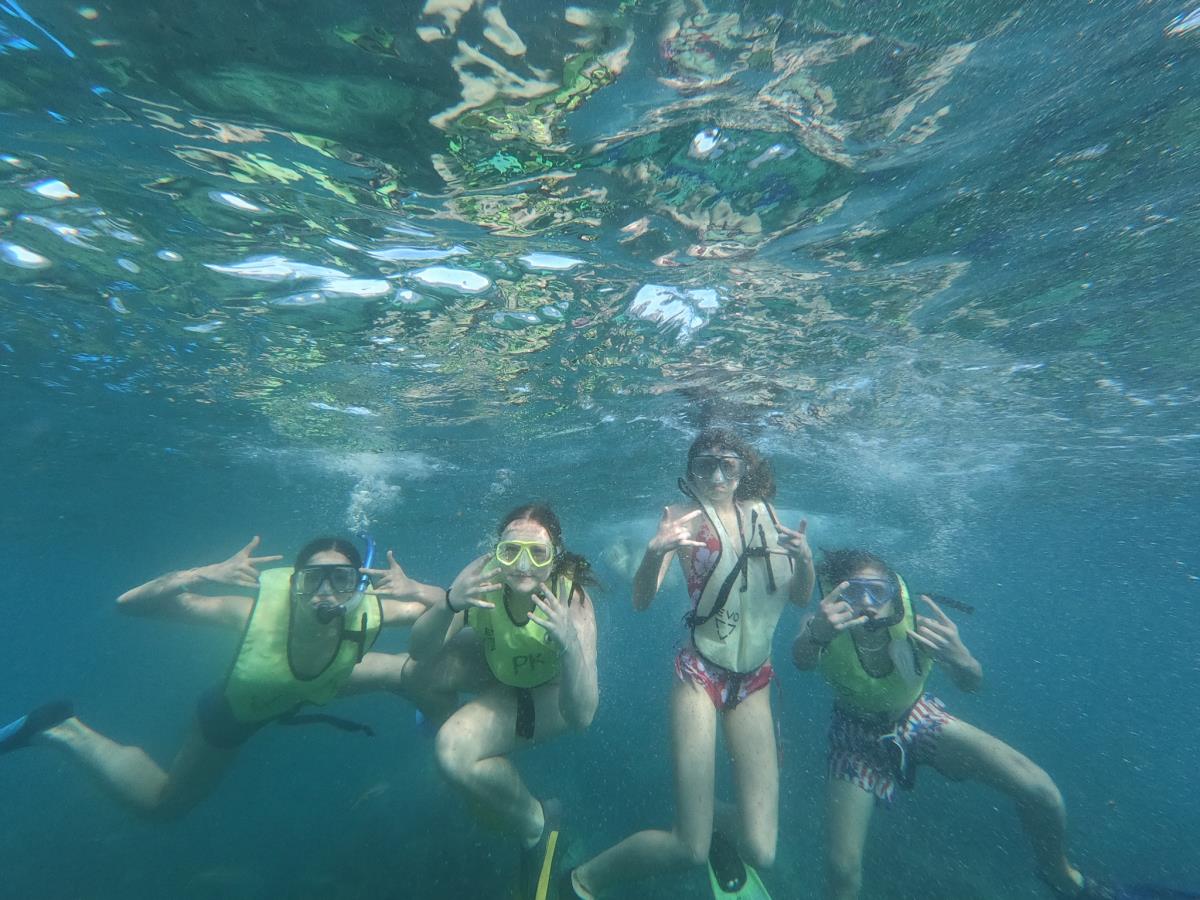
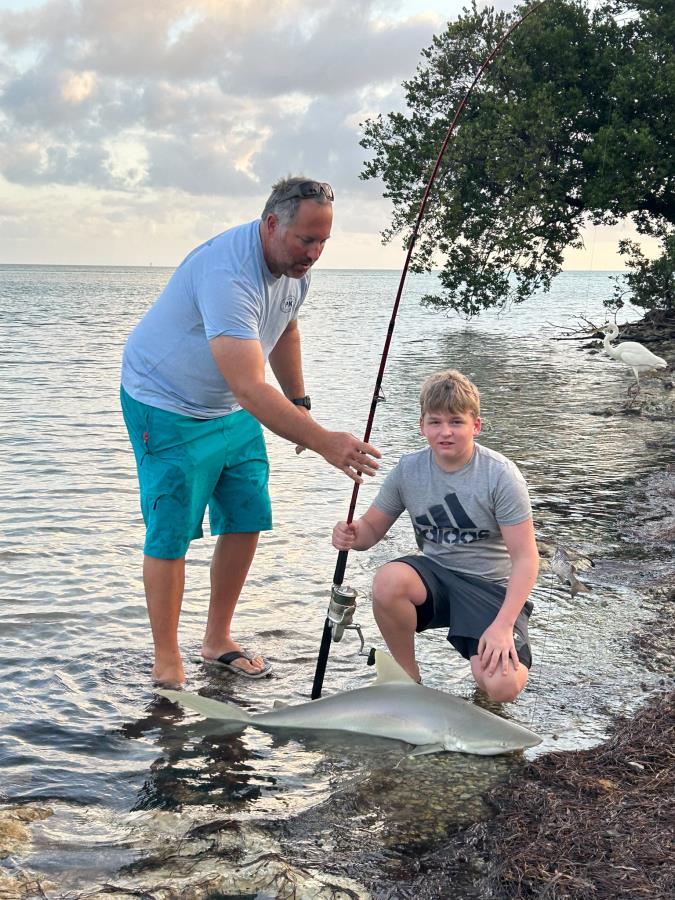
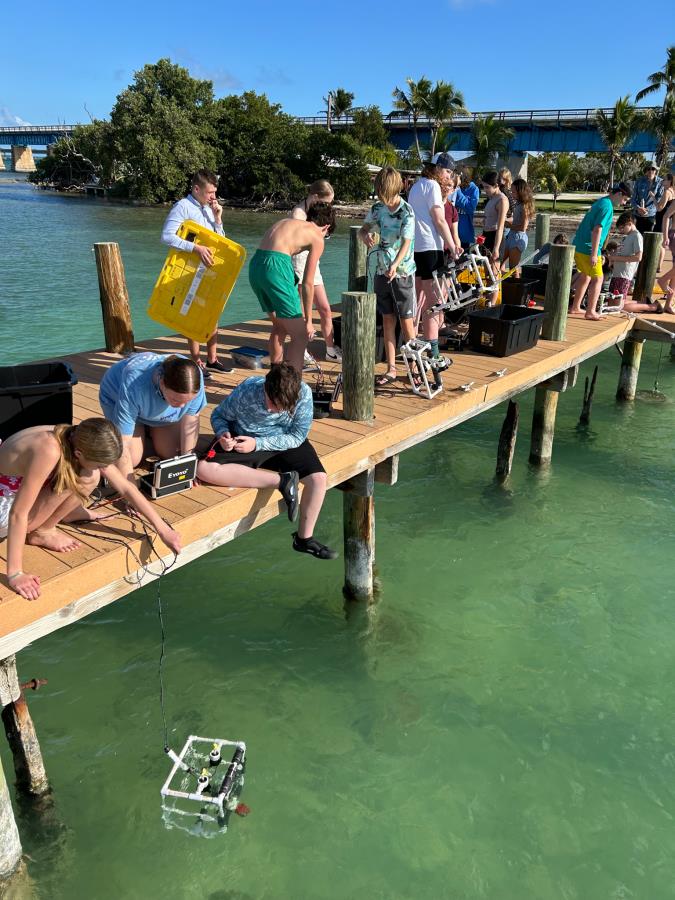
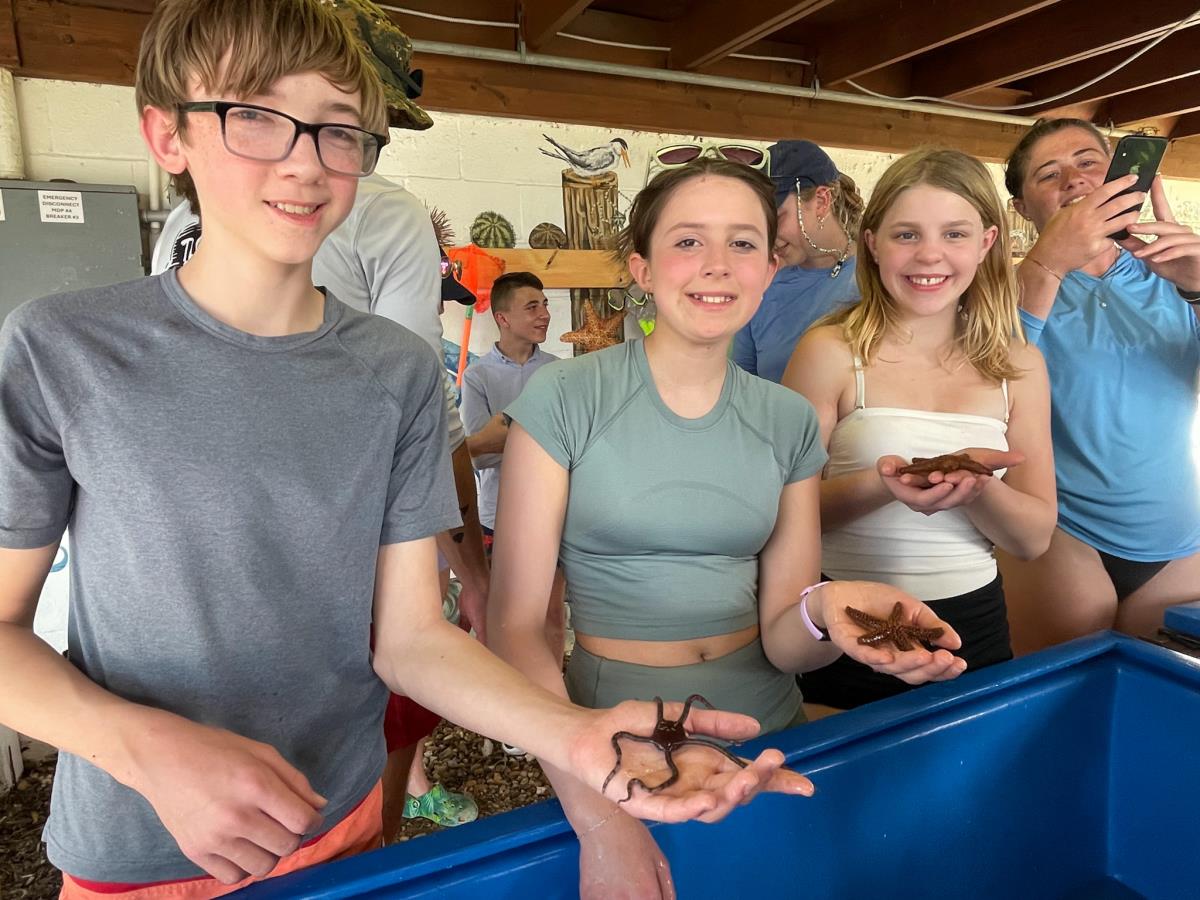
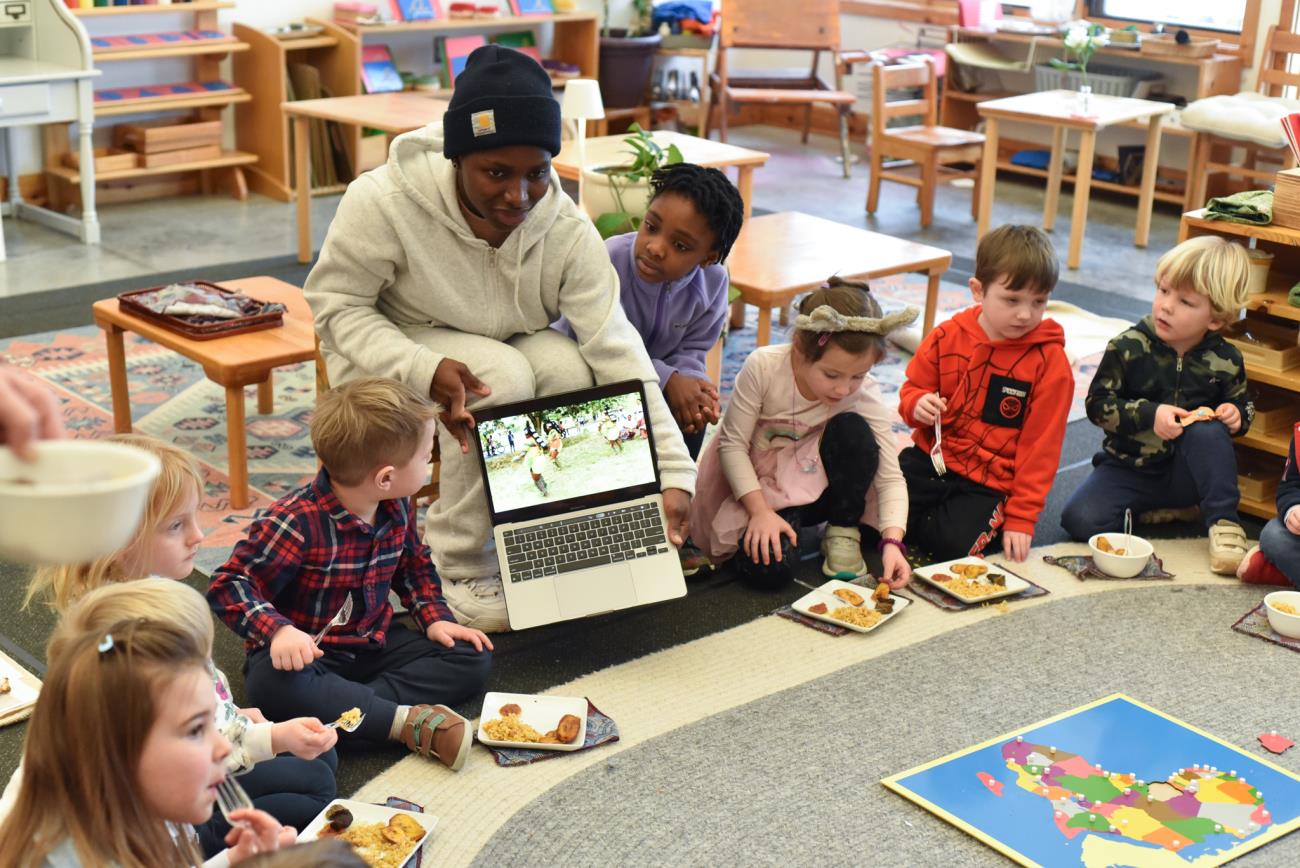
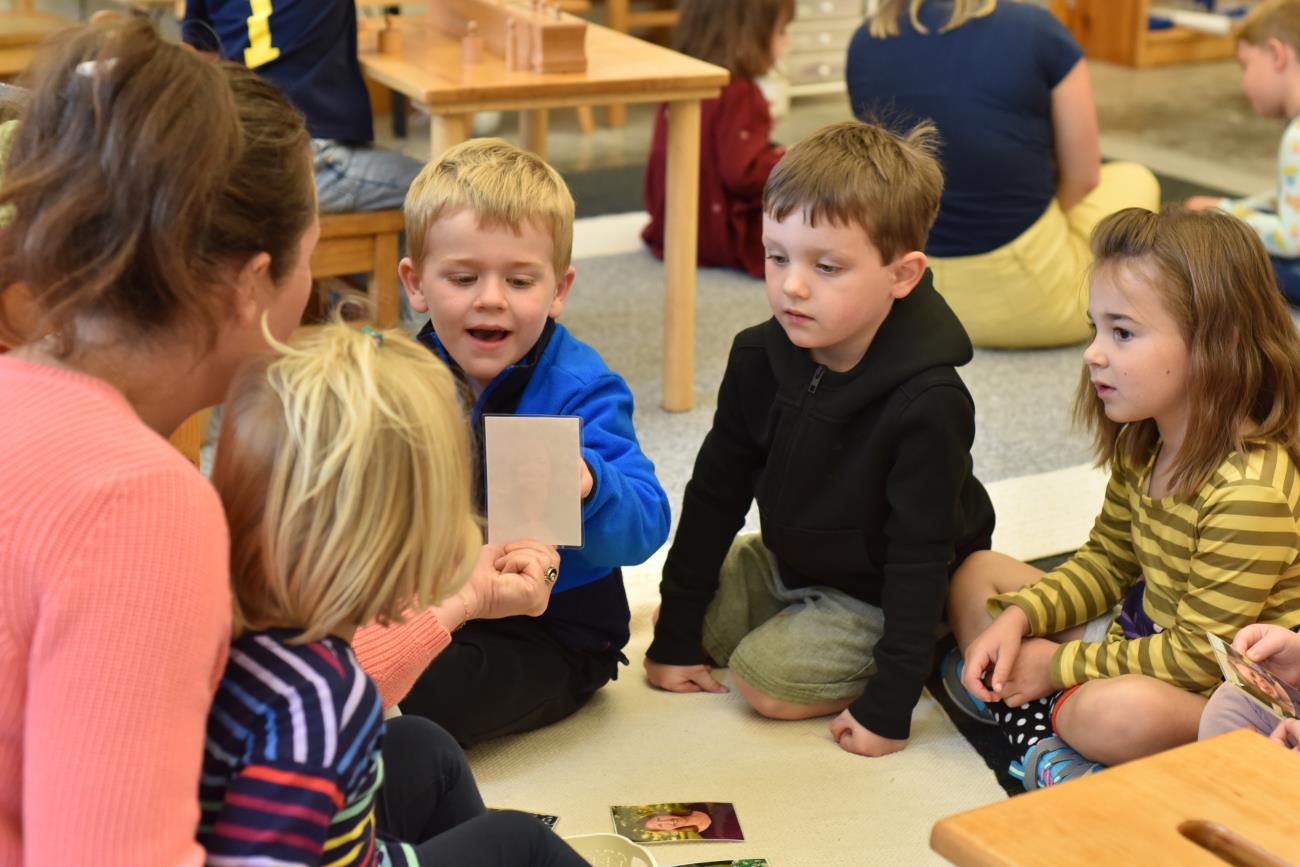
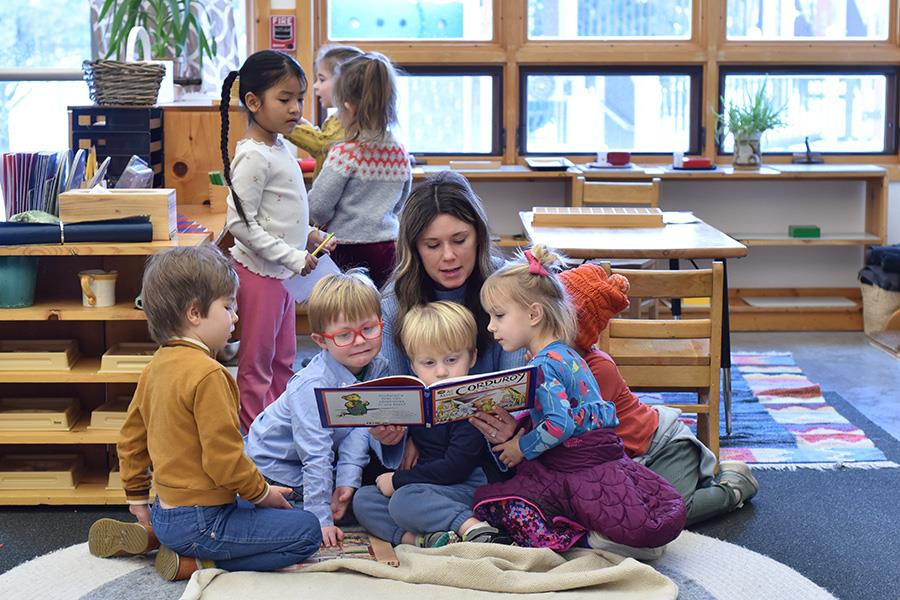
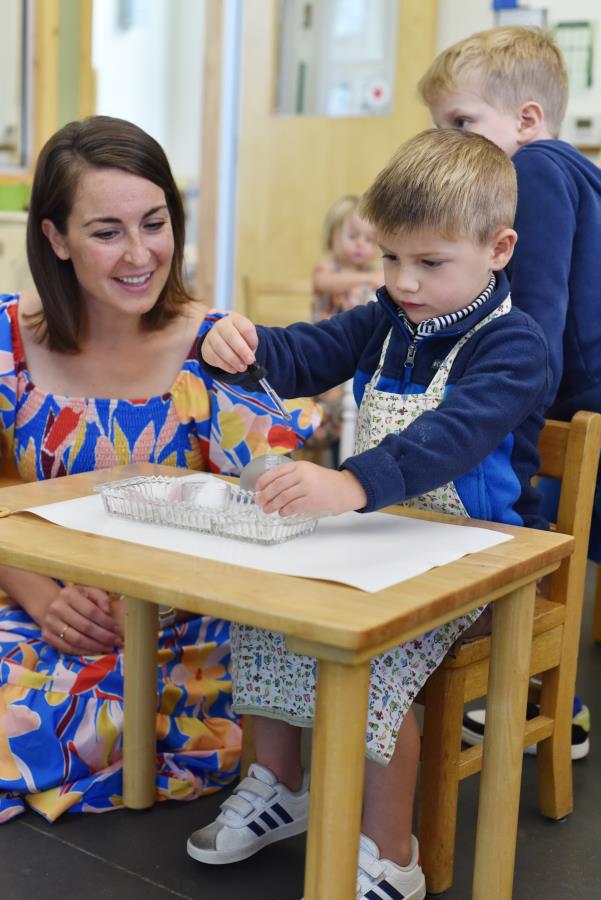
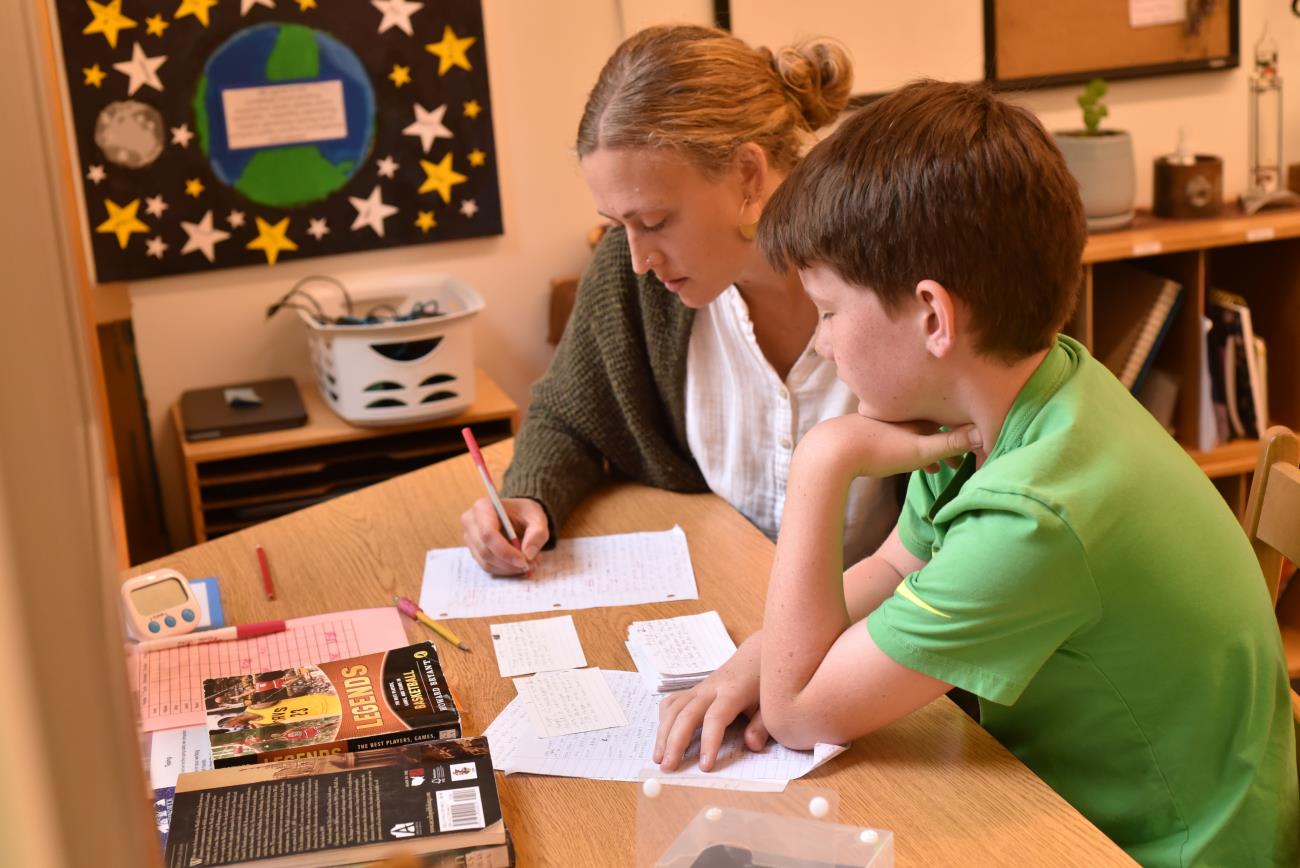
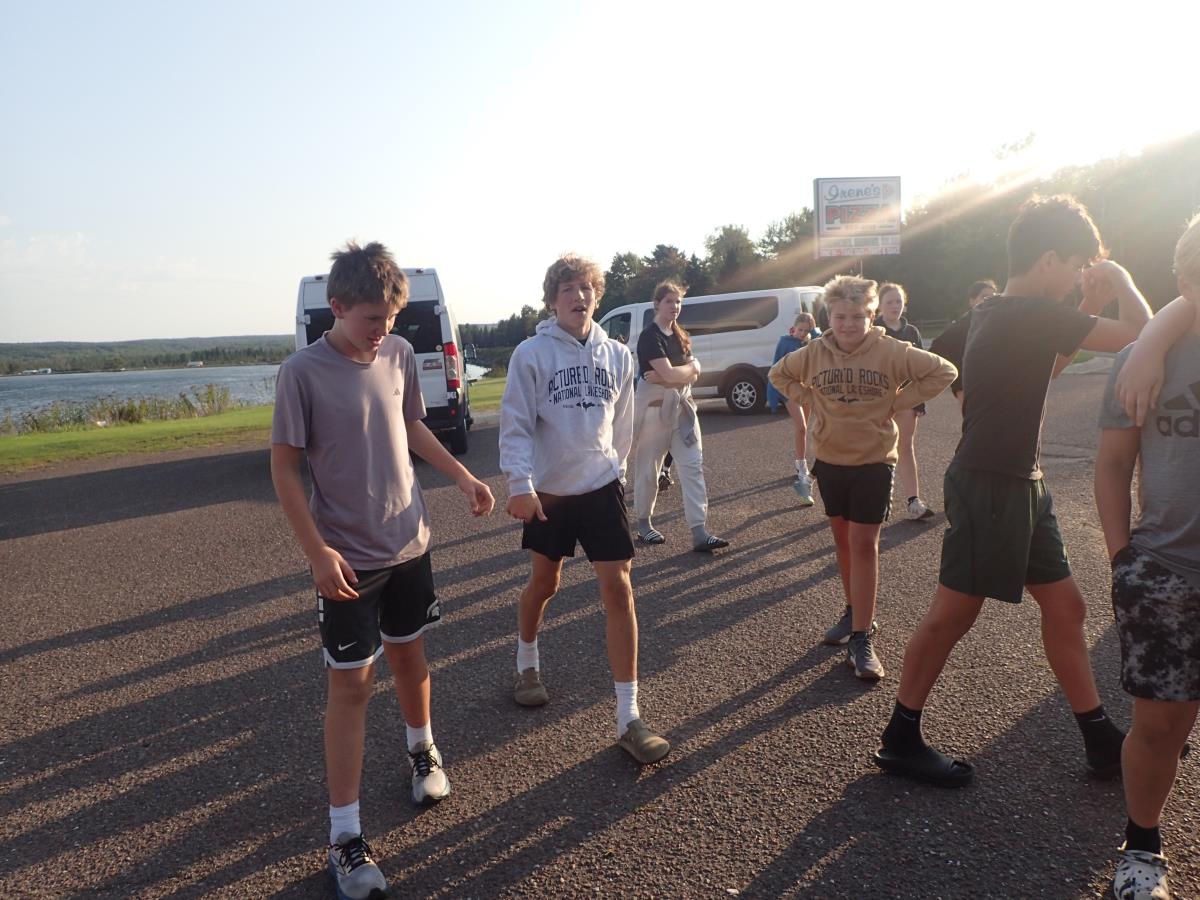
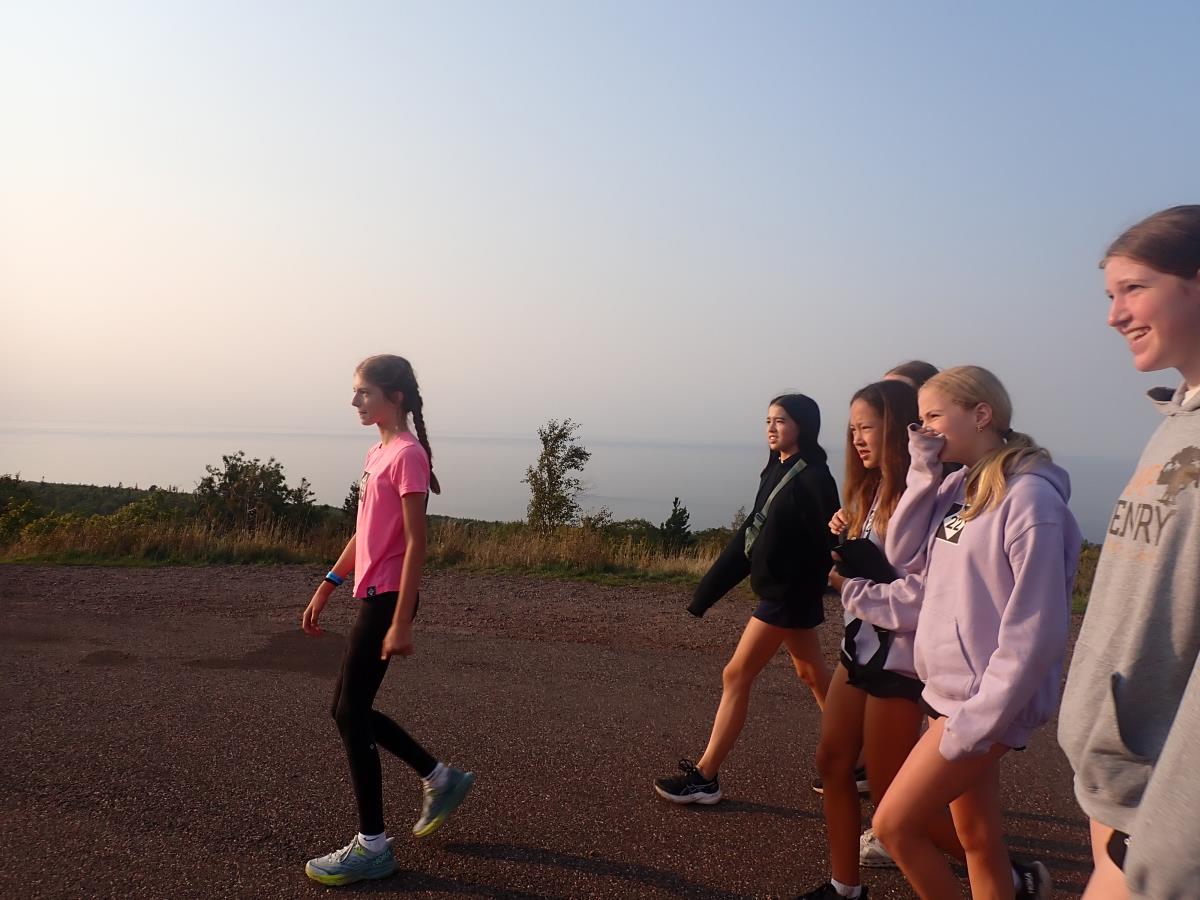
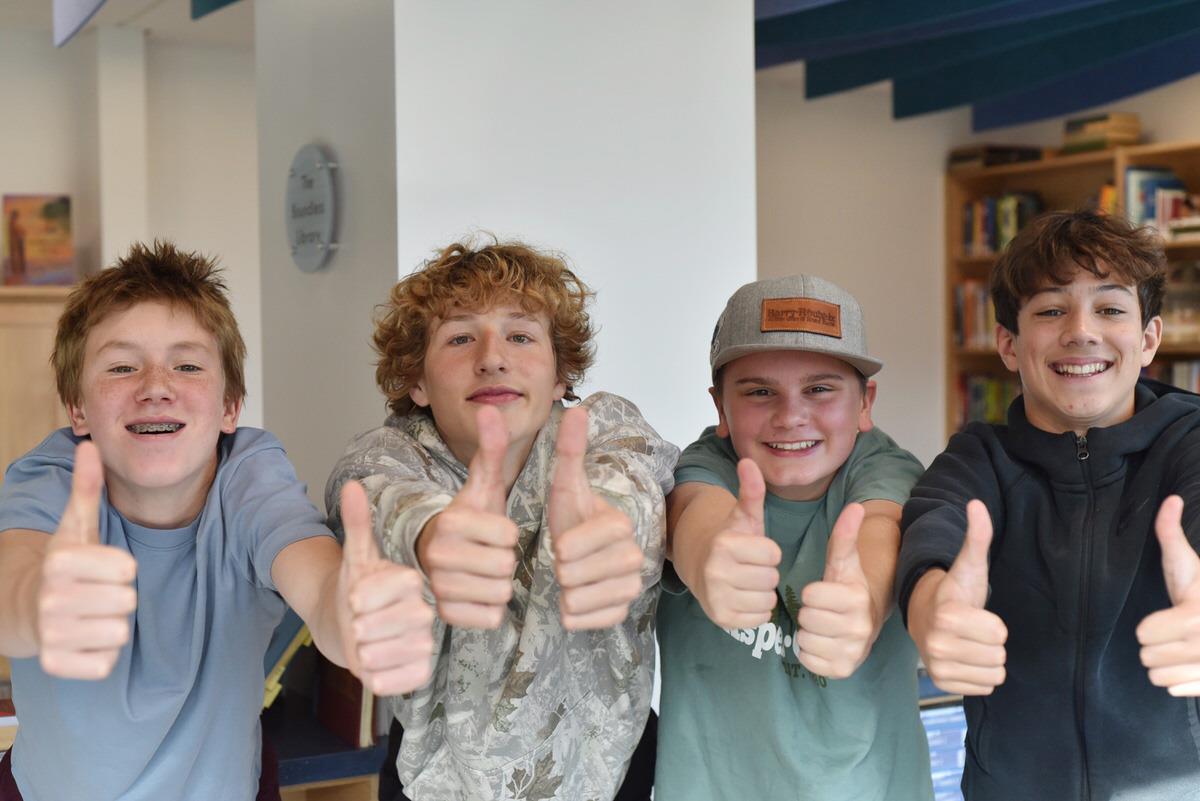
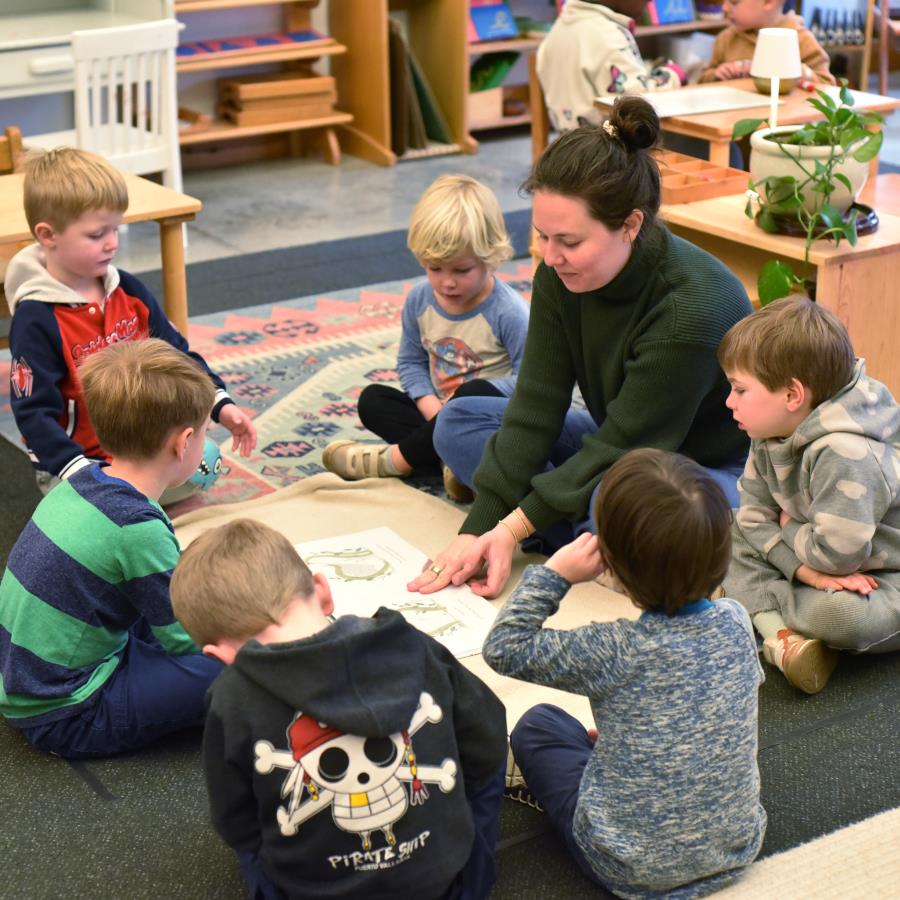
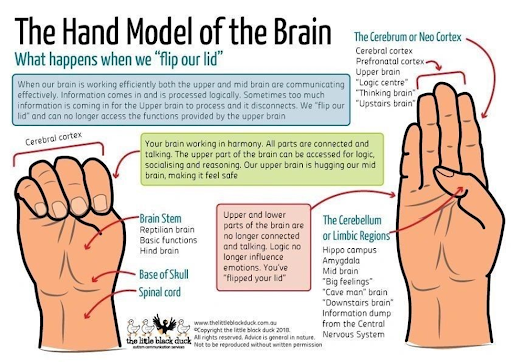

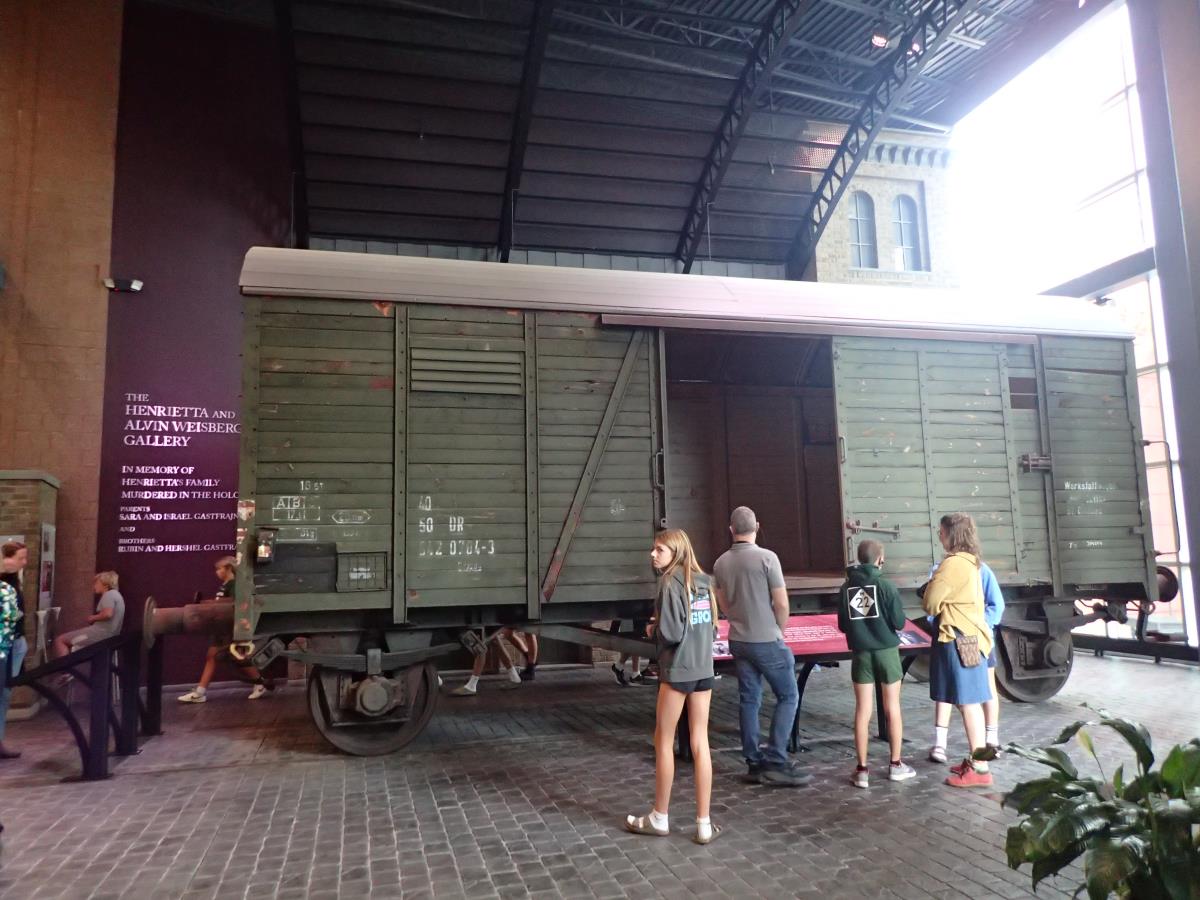

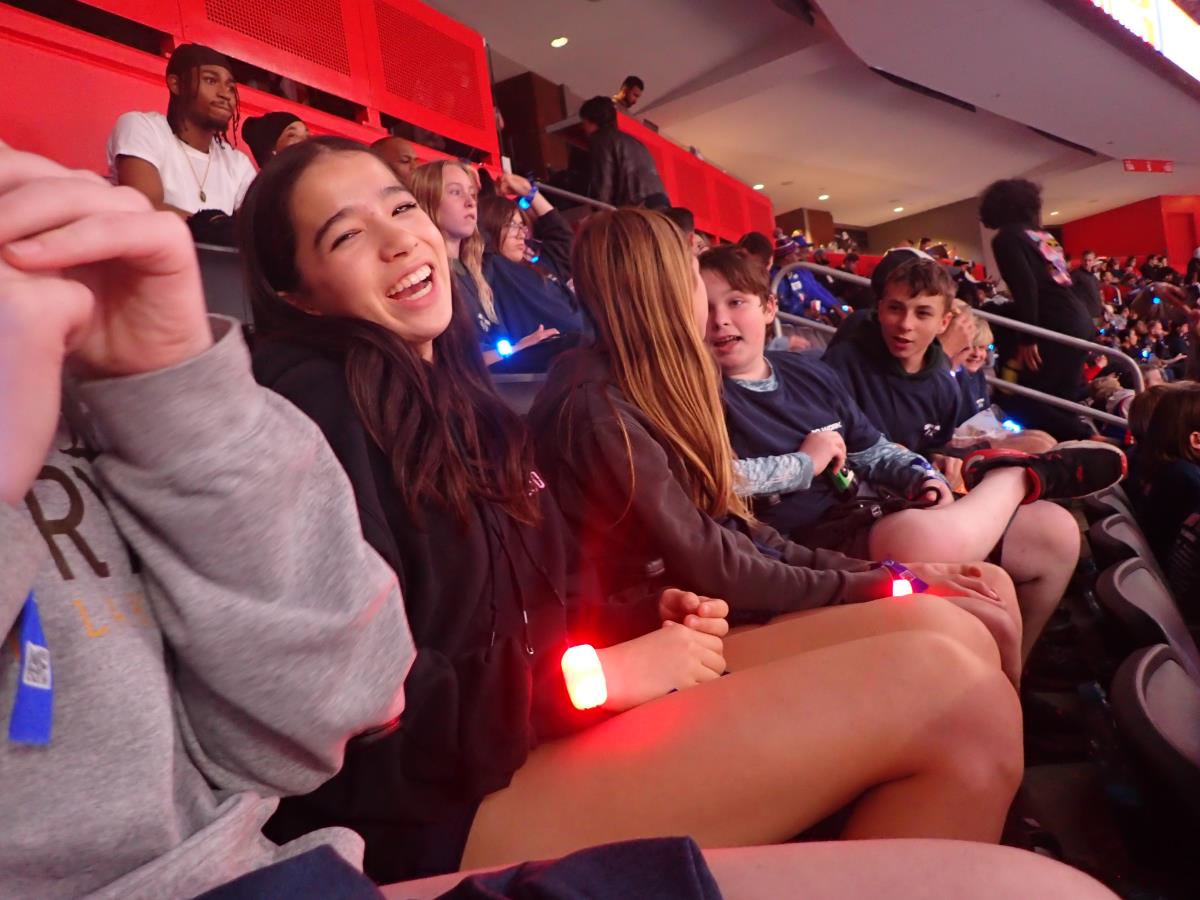
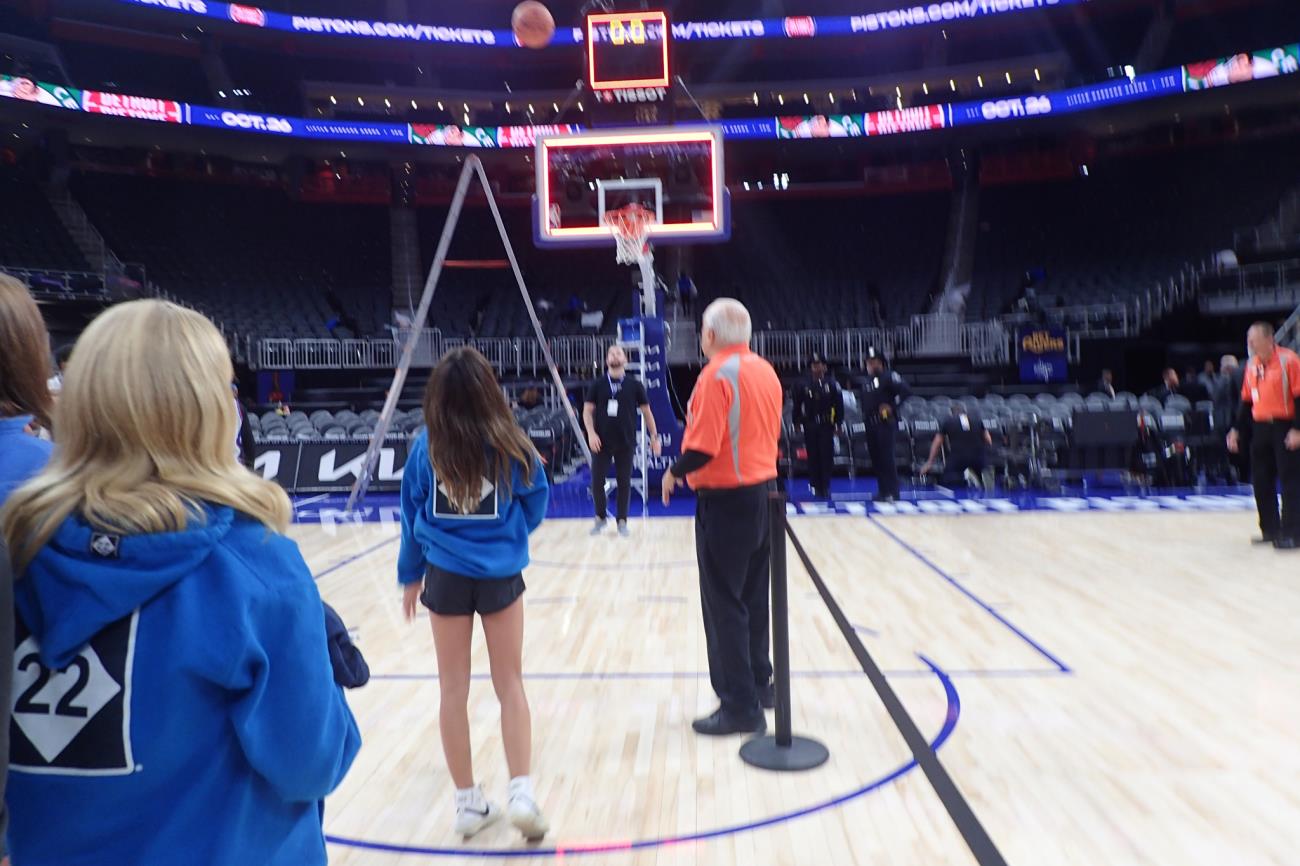
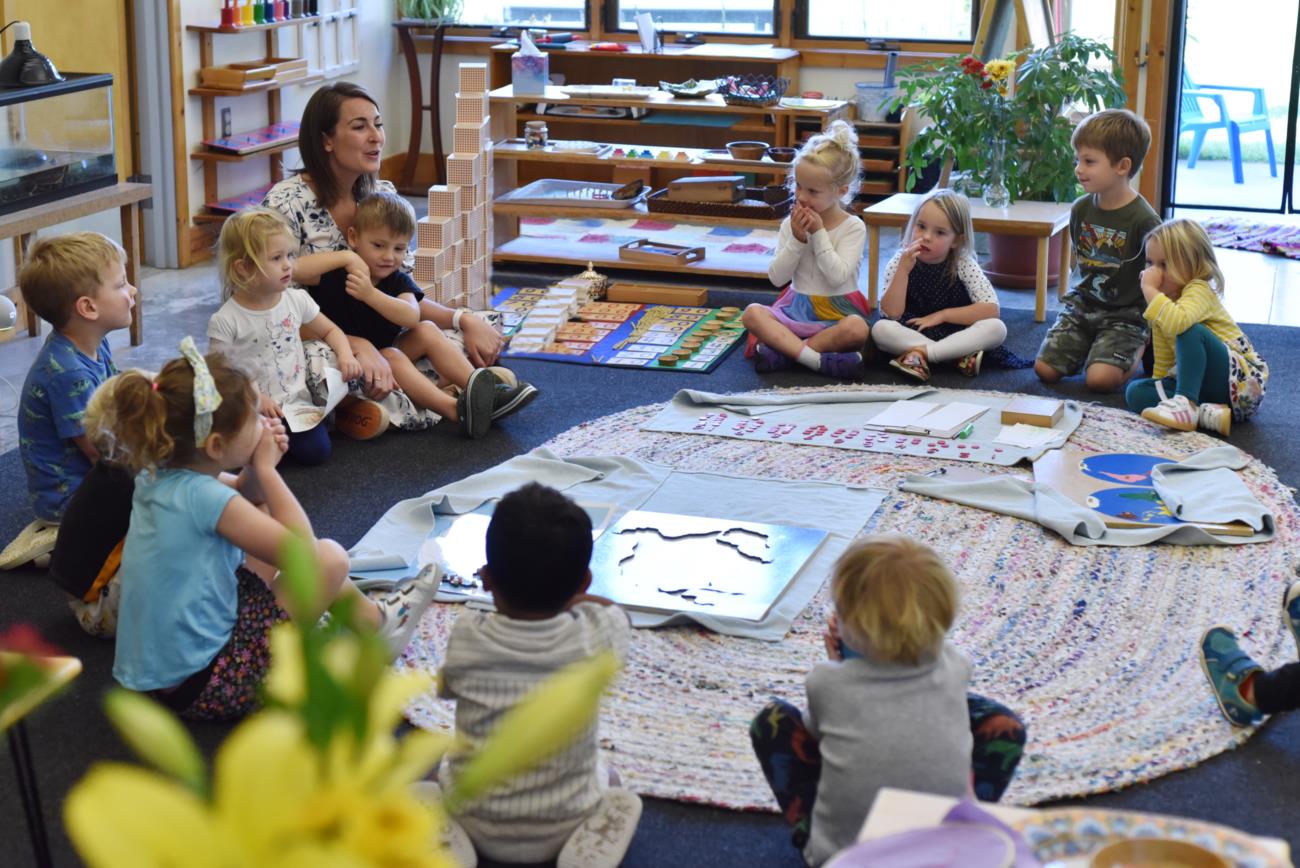
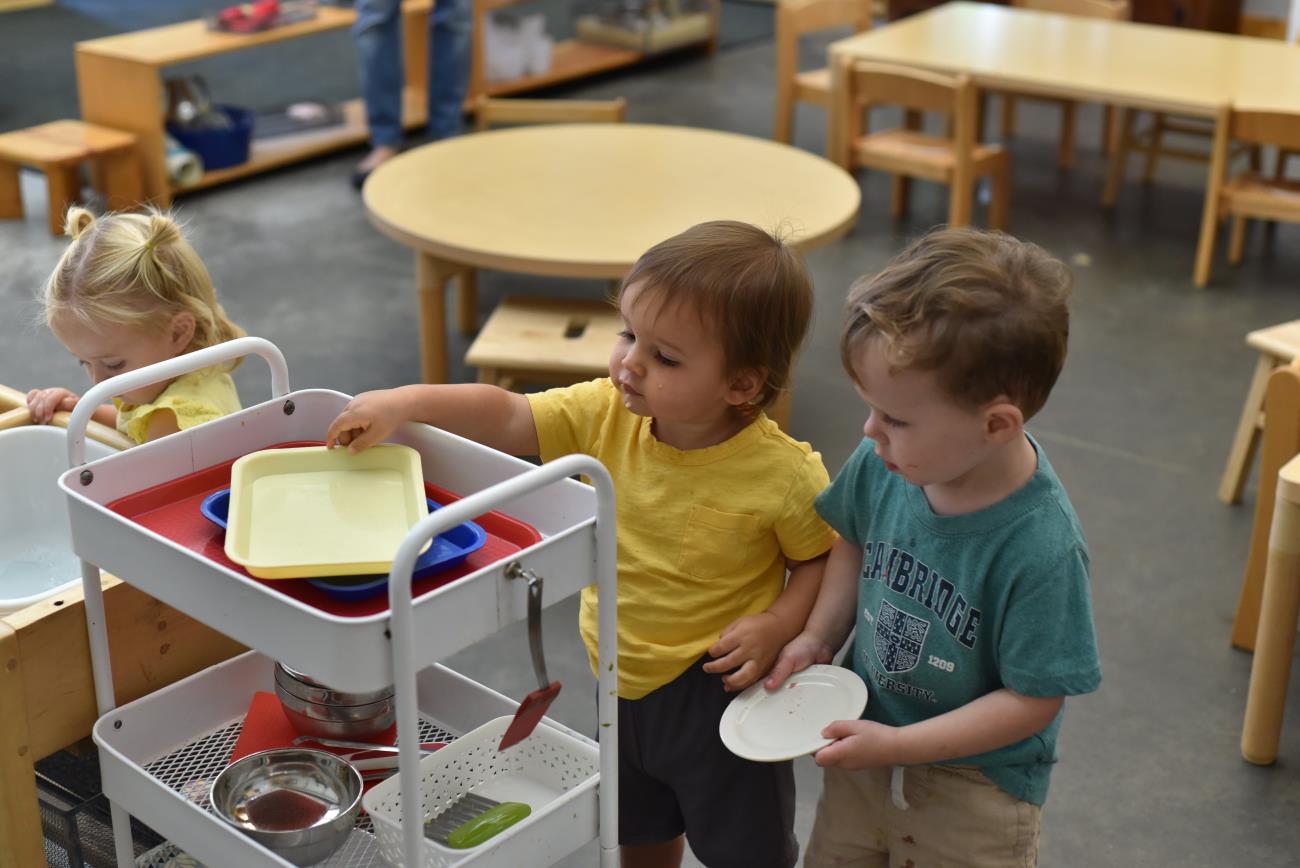
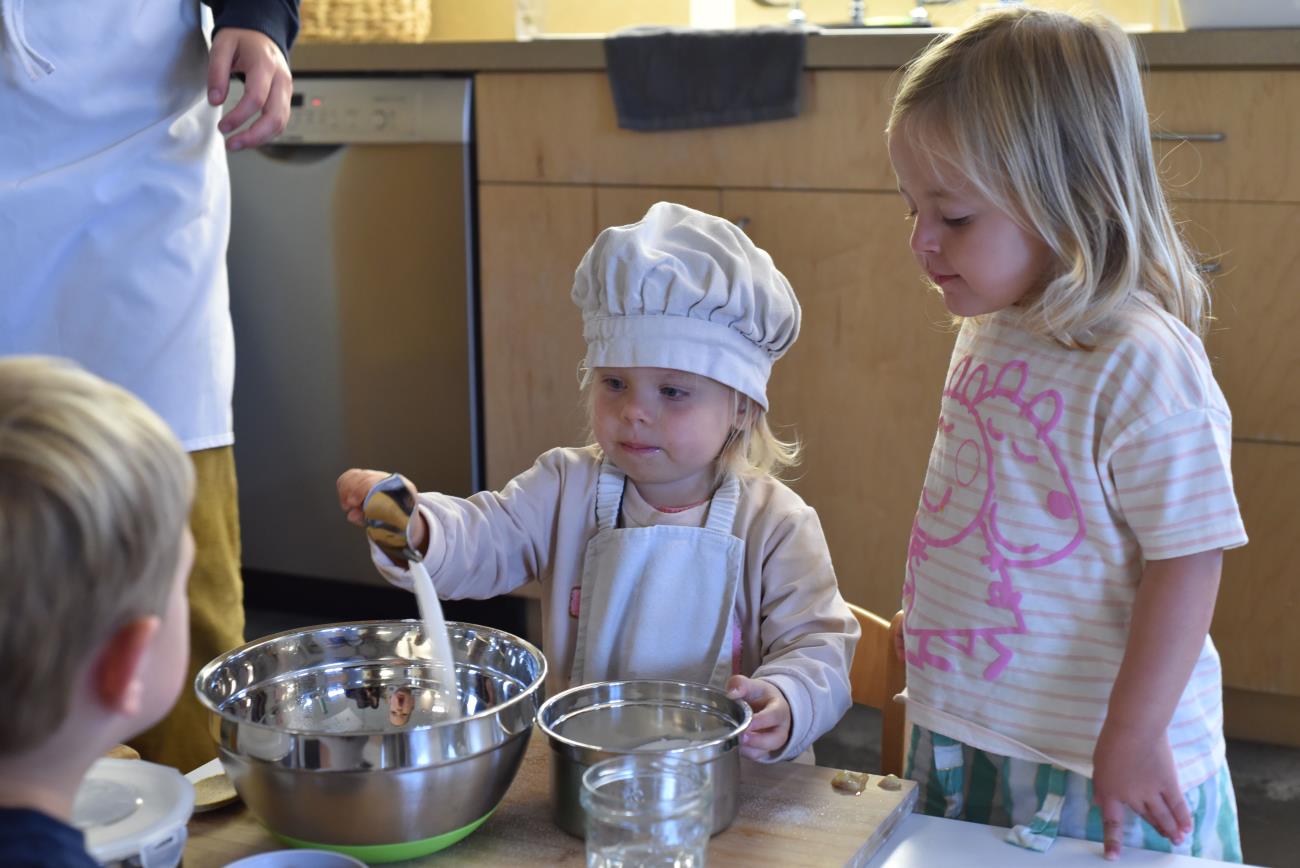
.jpg)
.jpg)
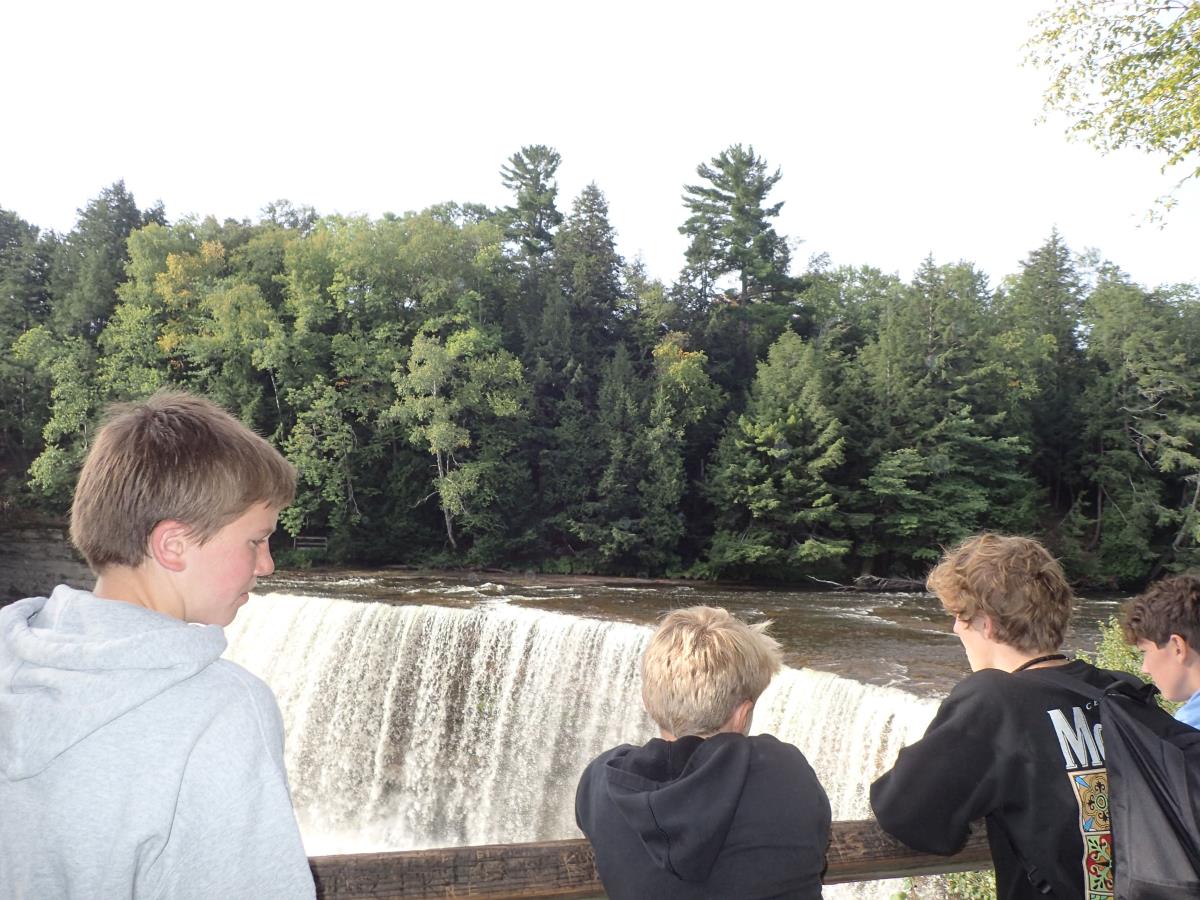

.jpg)
.jpg)
.jpg)
.jpg)
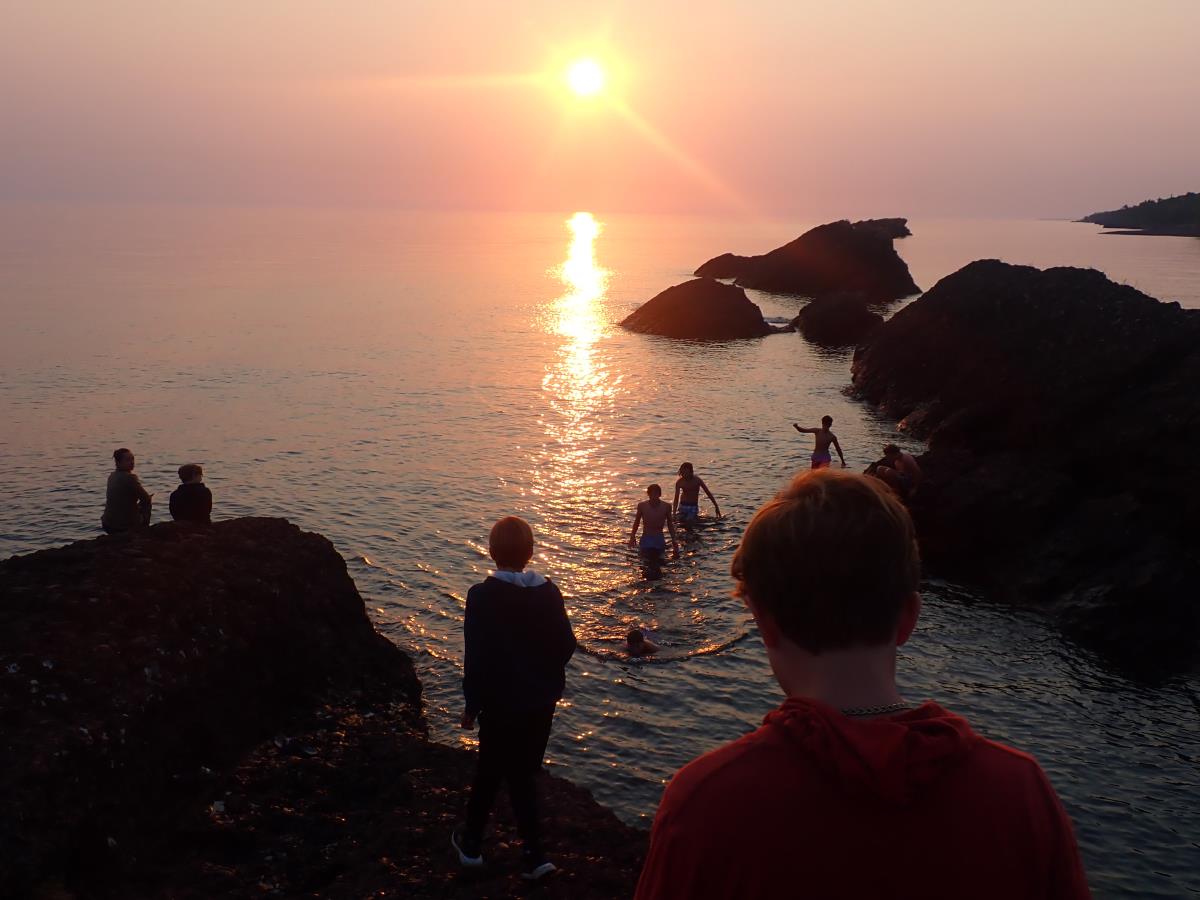
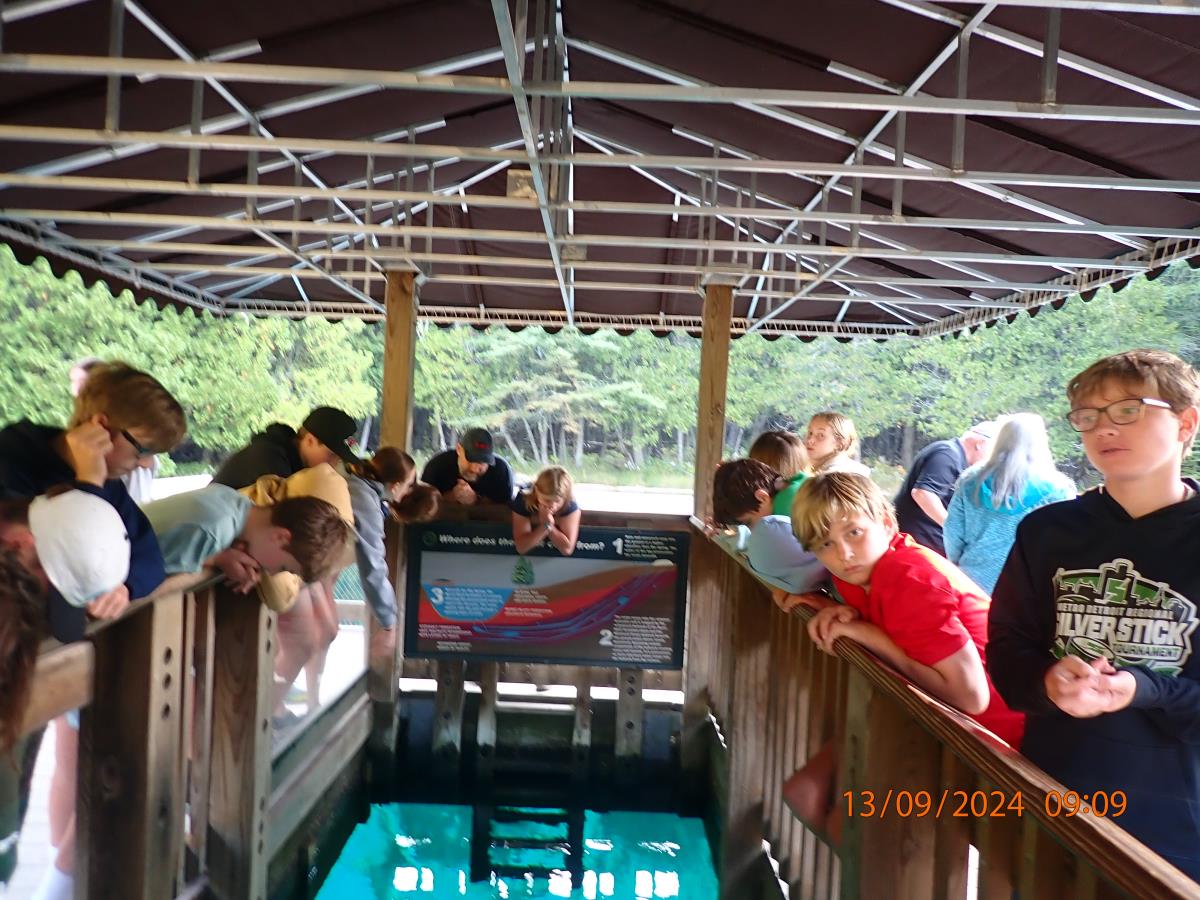
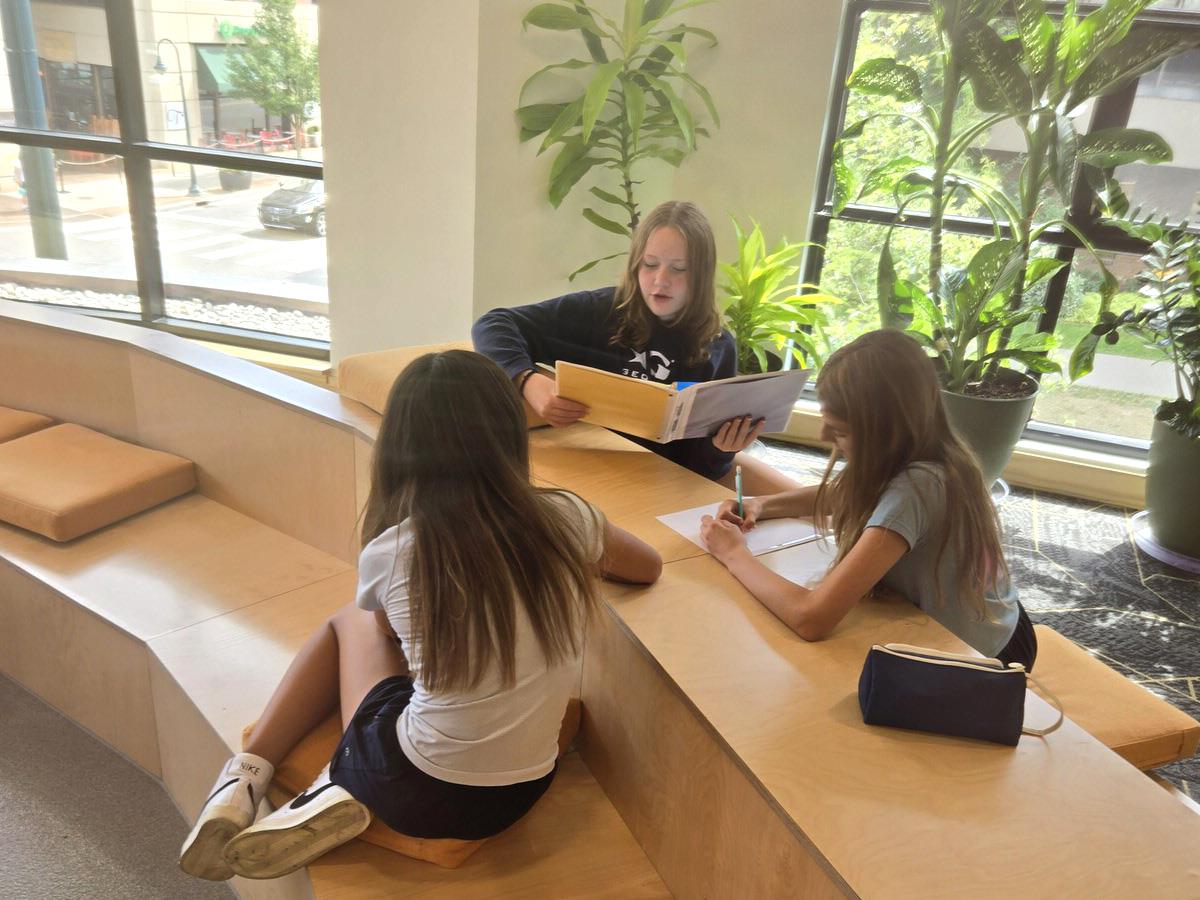
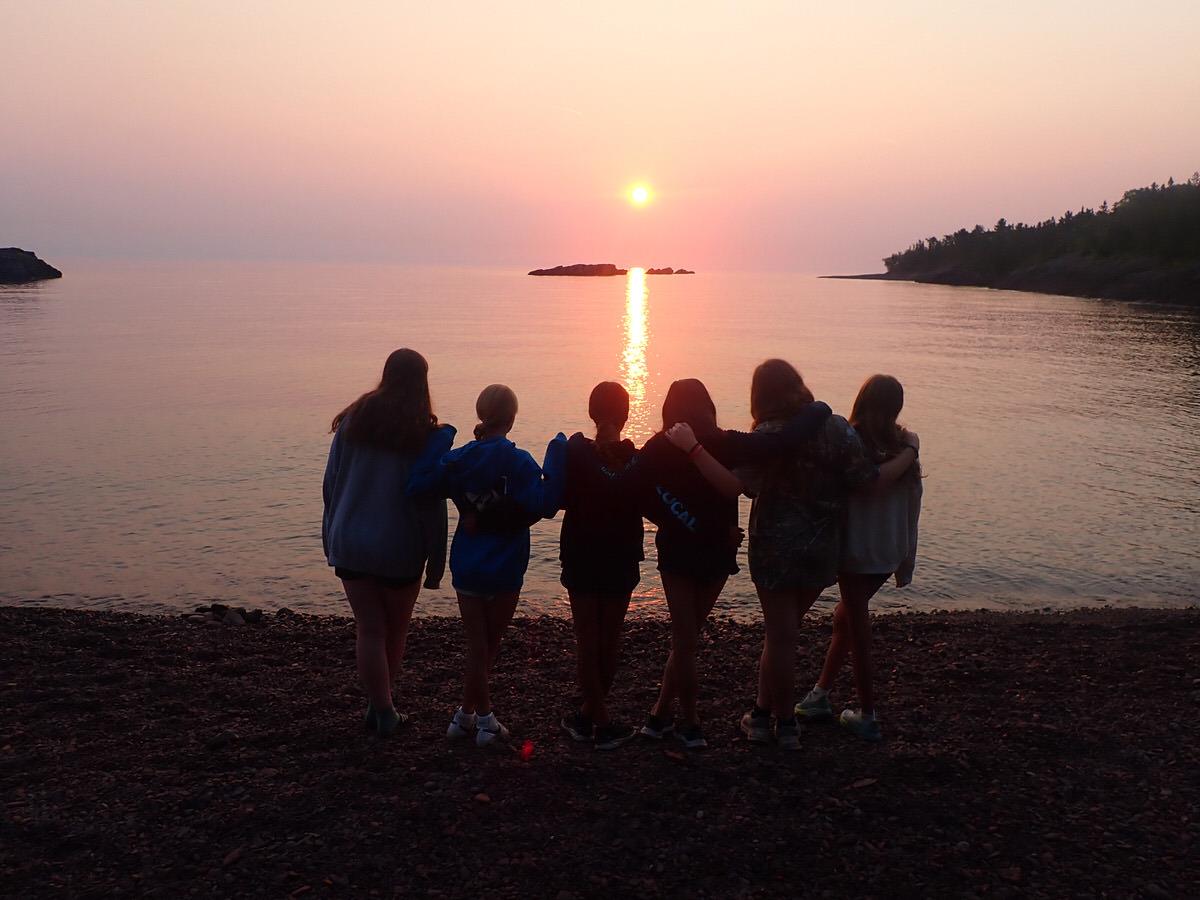
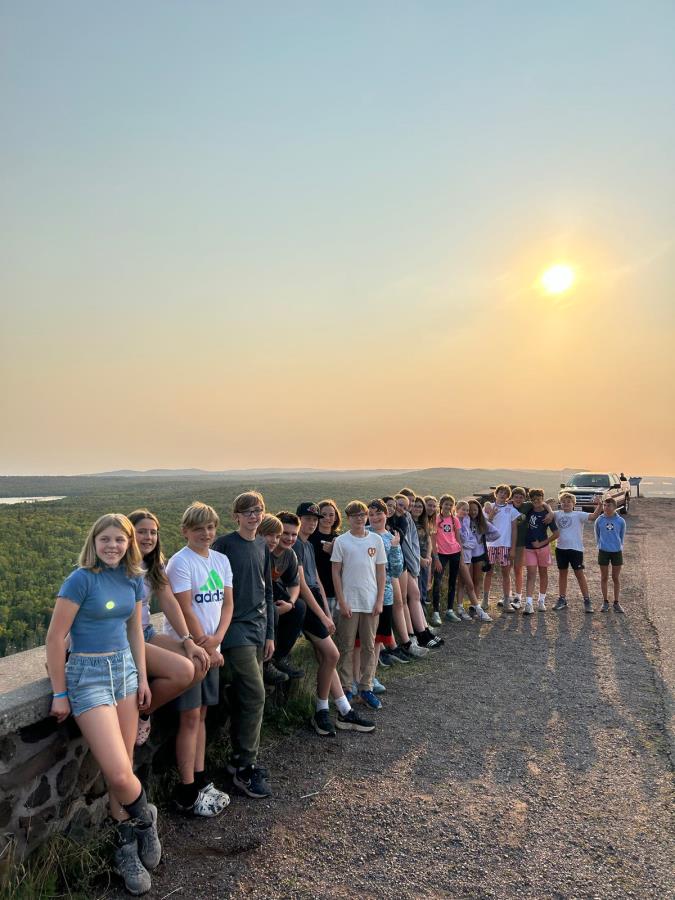
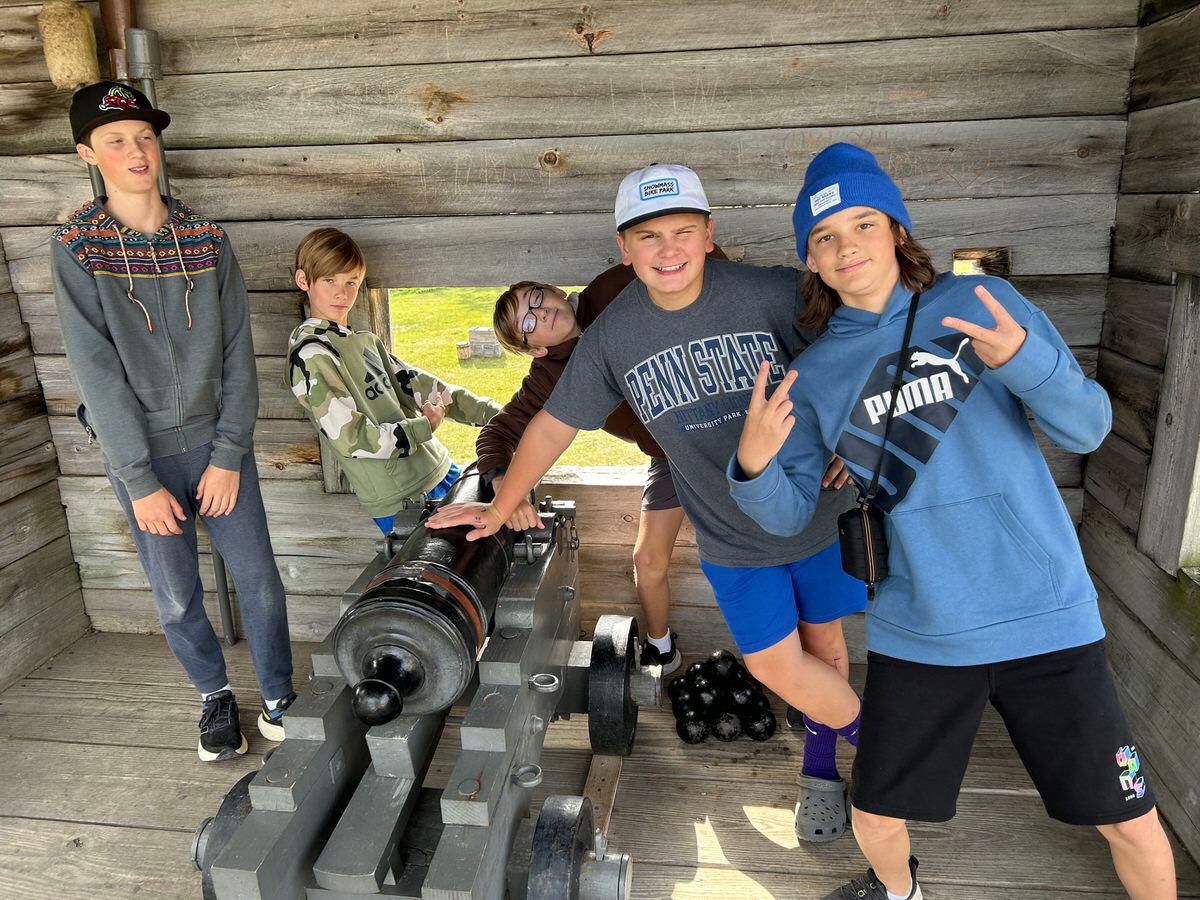
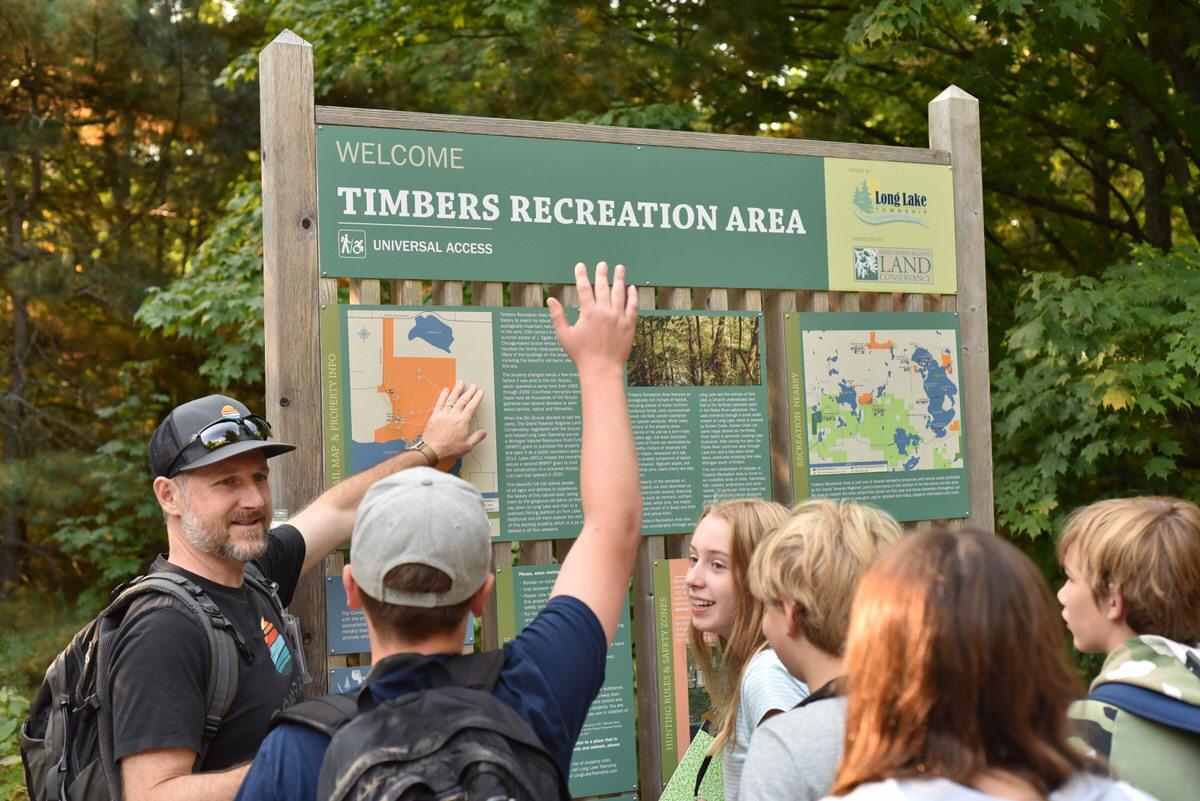
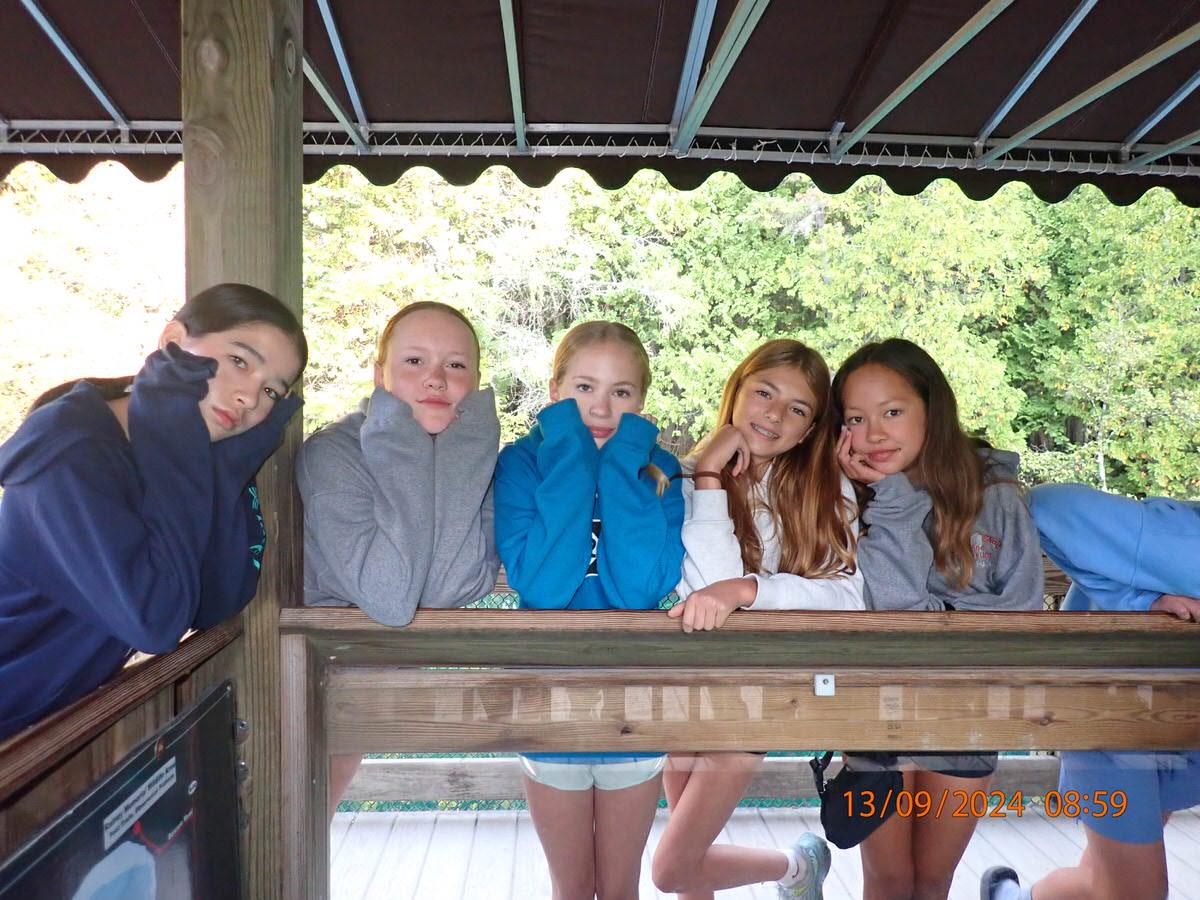
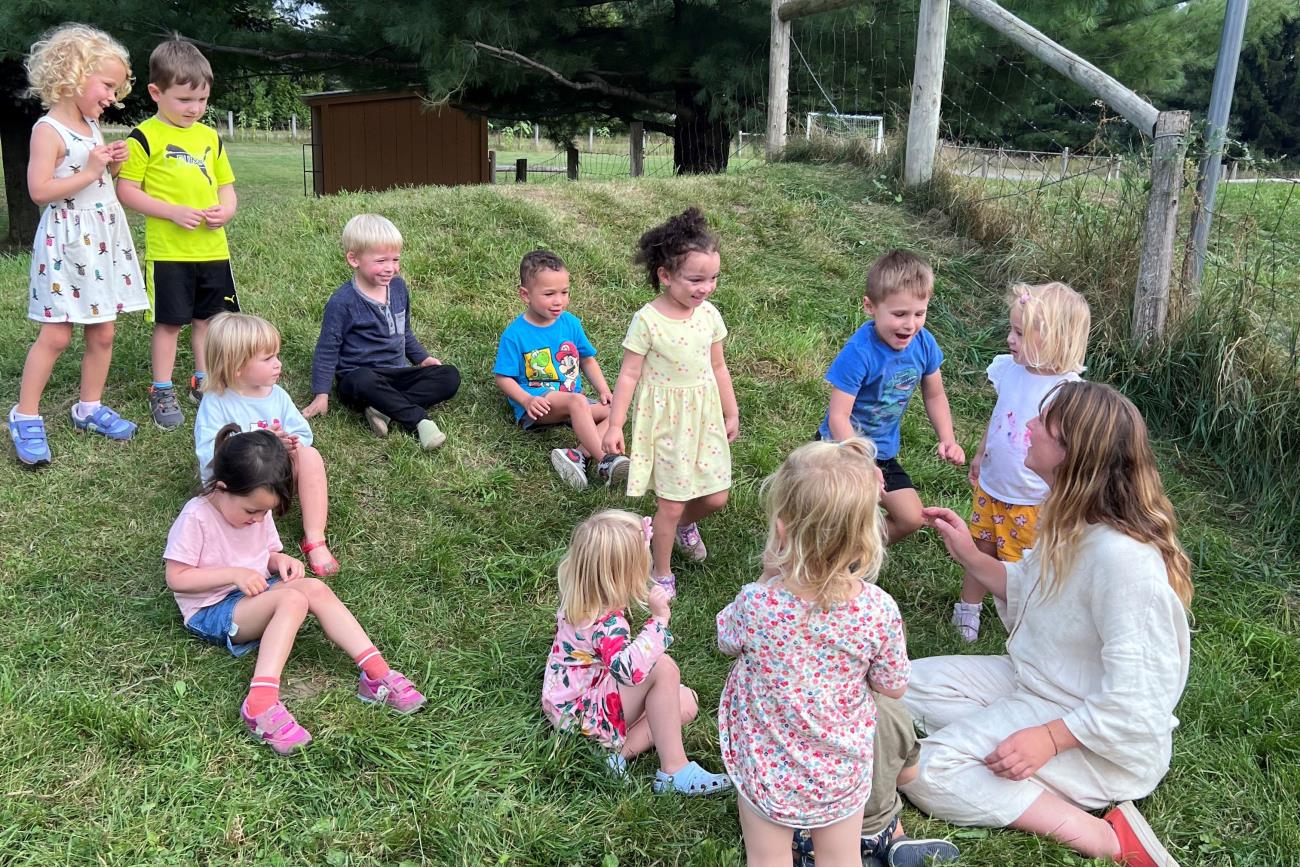
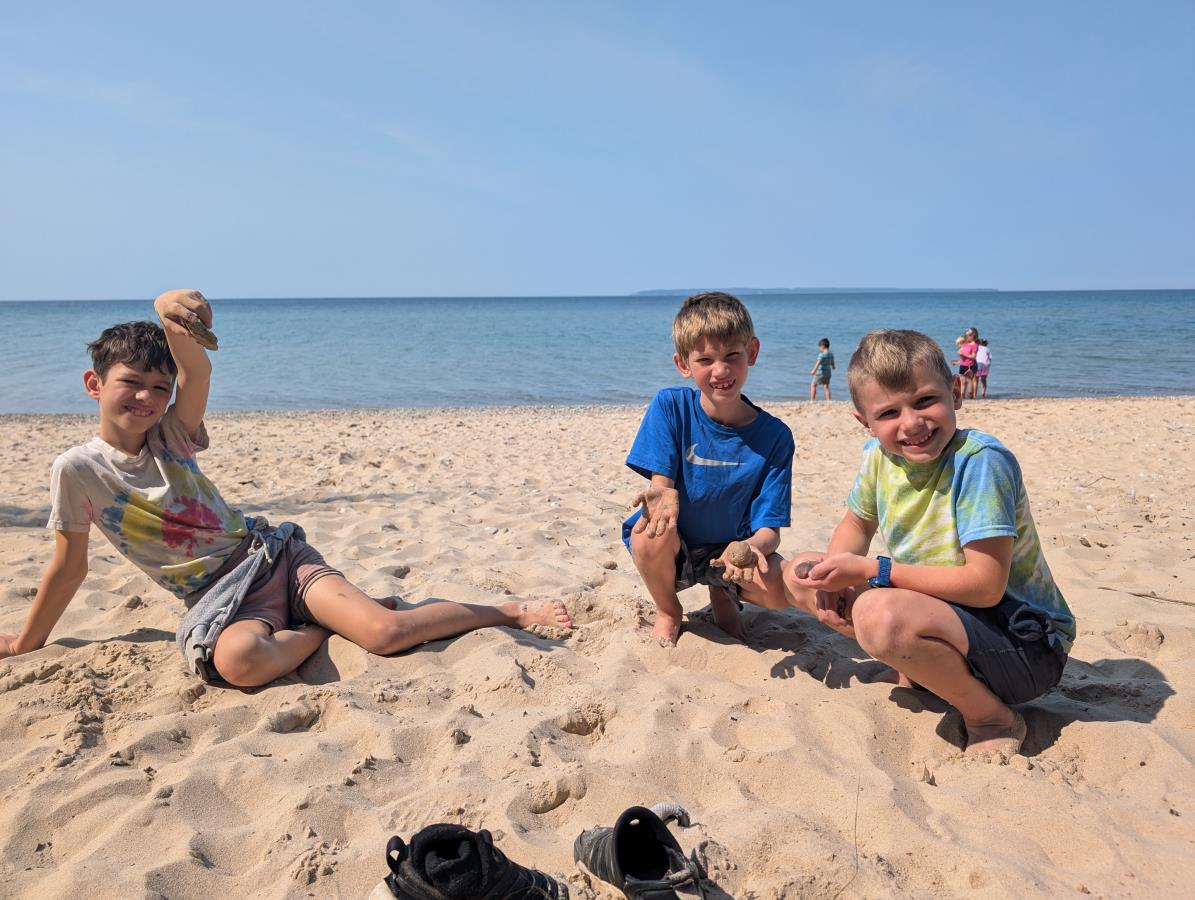
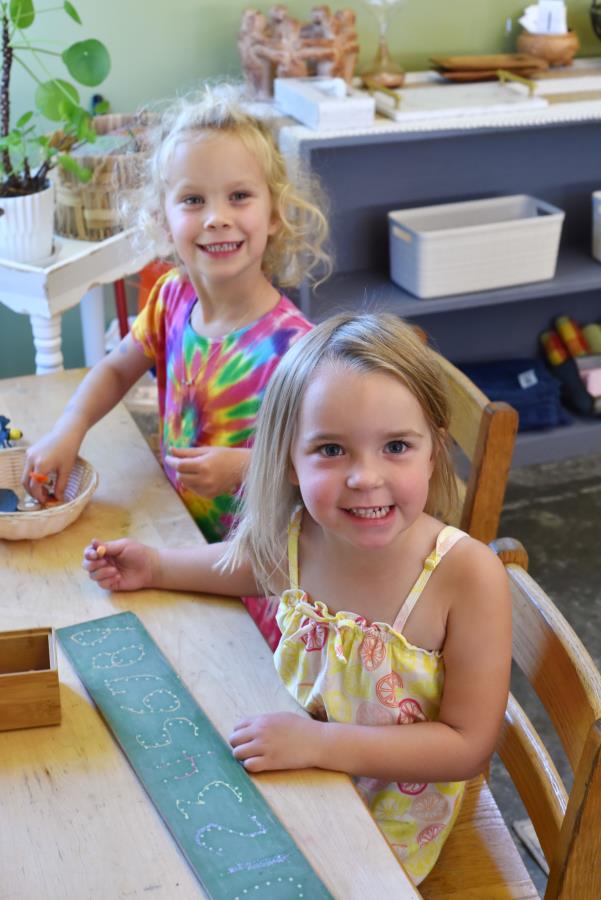
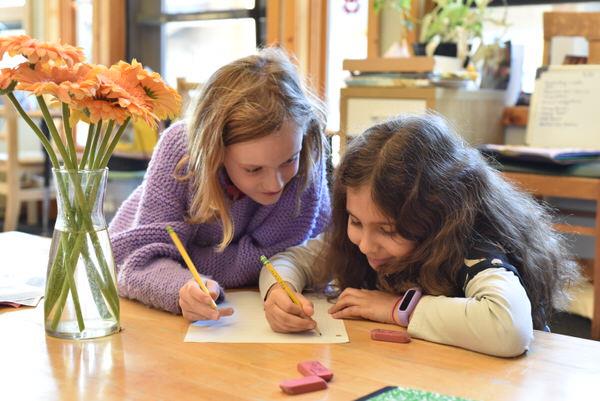

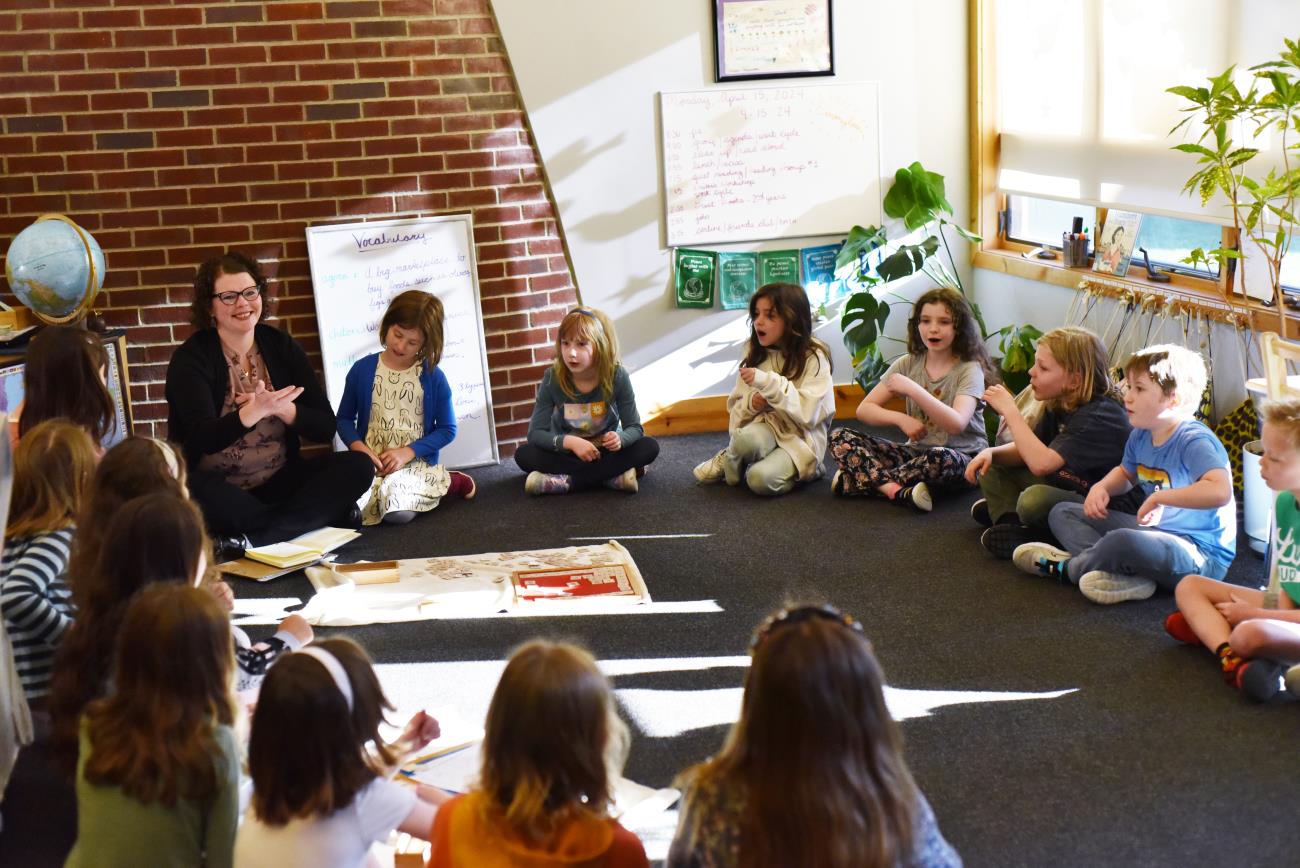

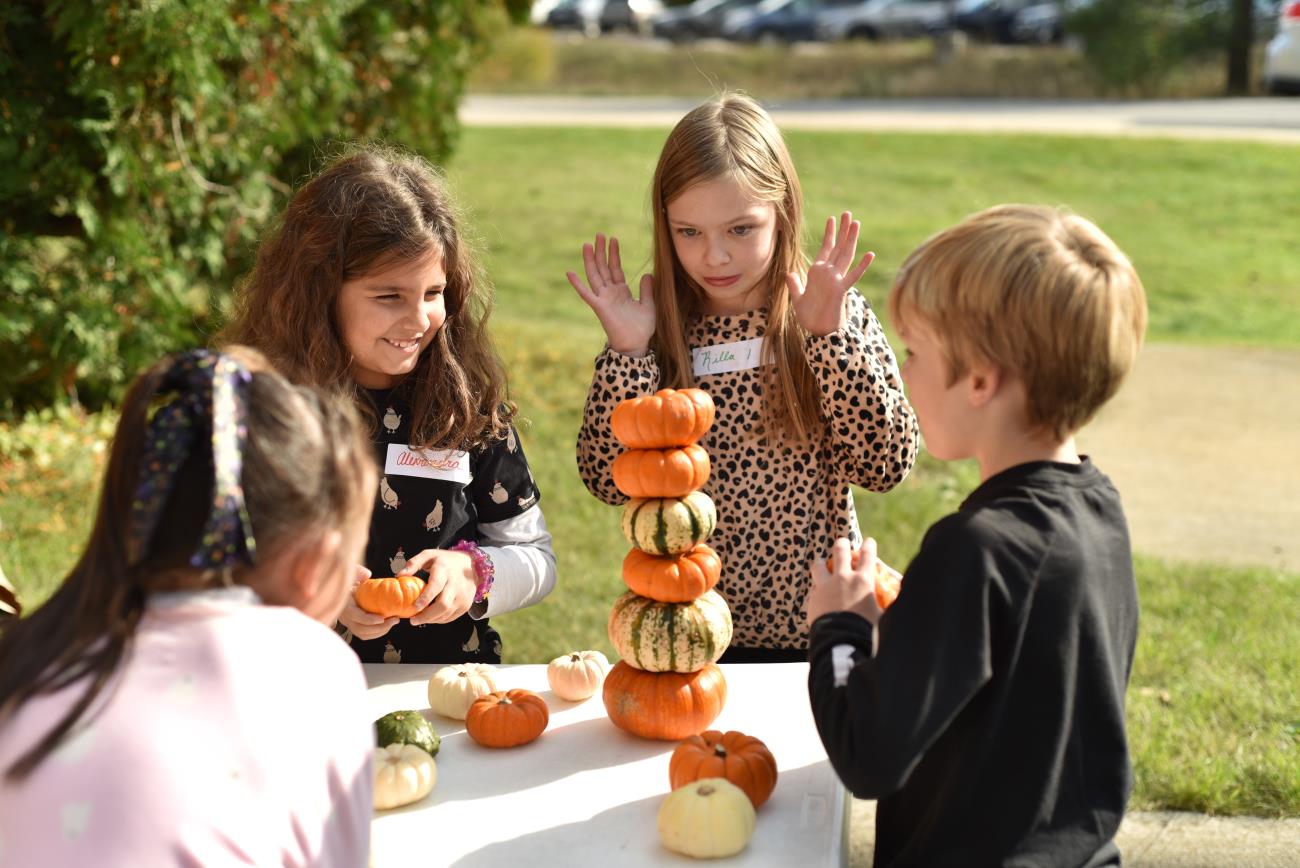


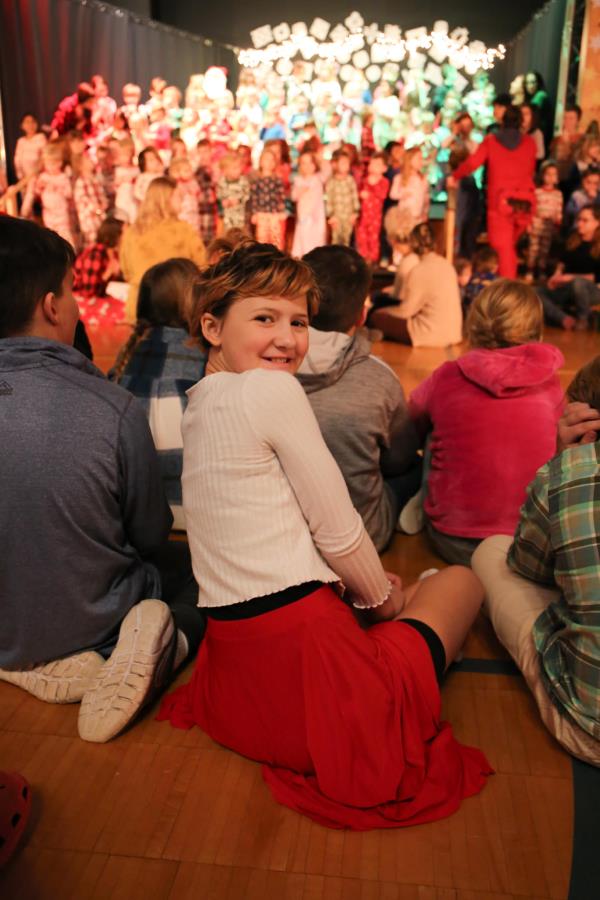

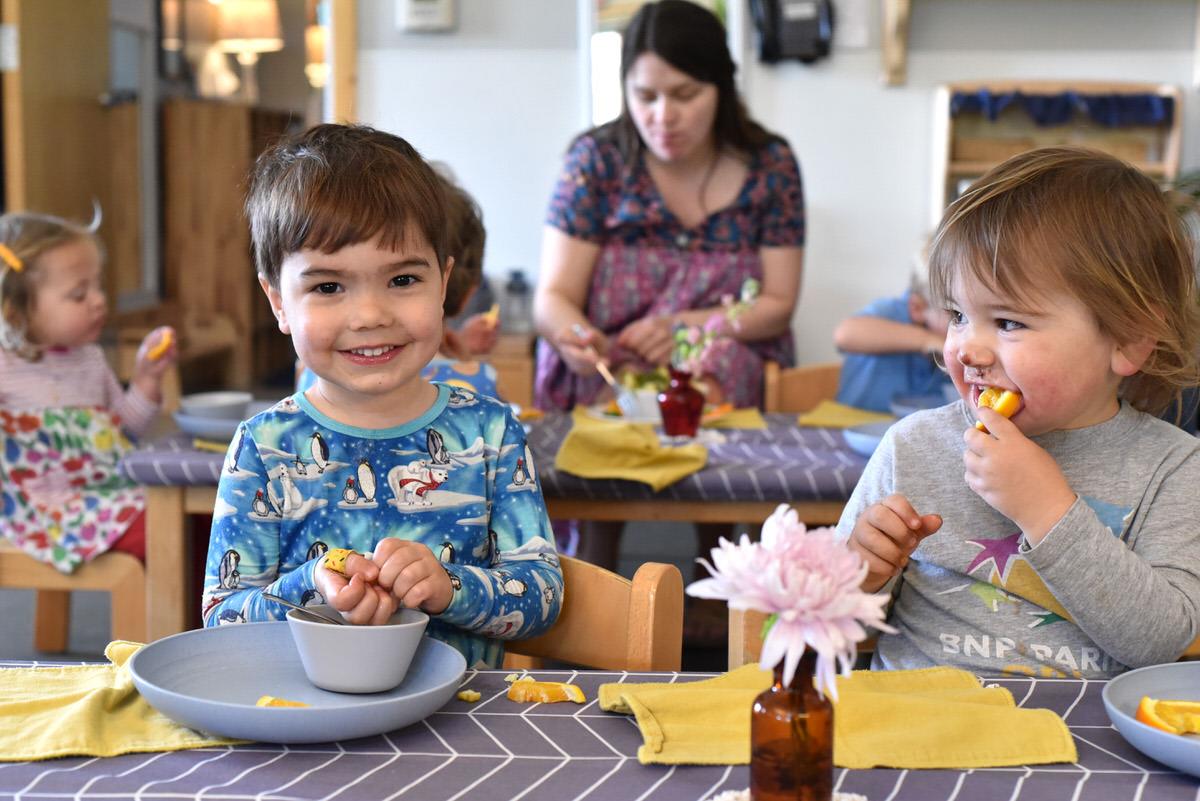
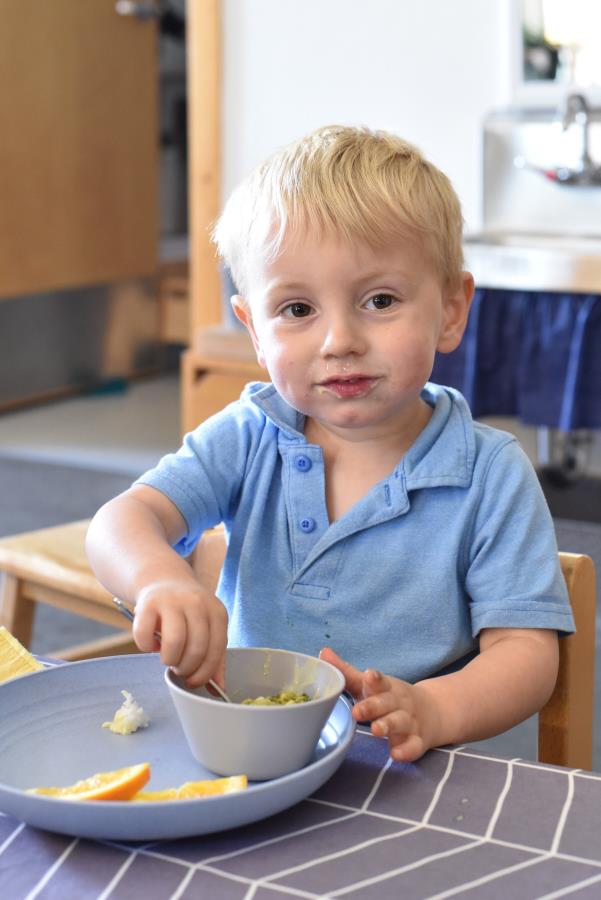
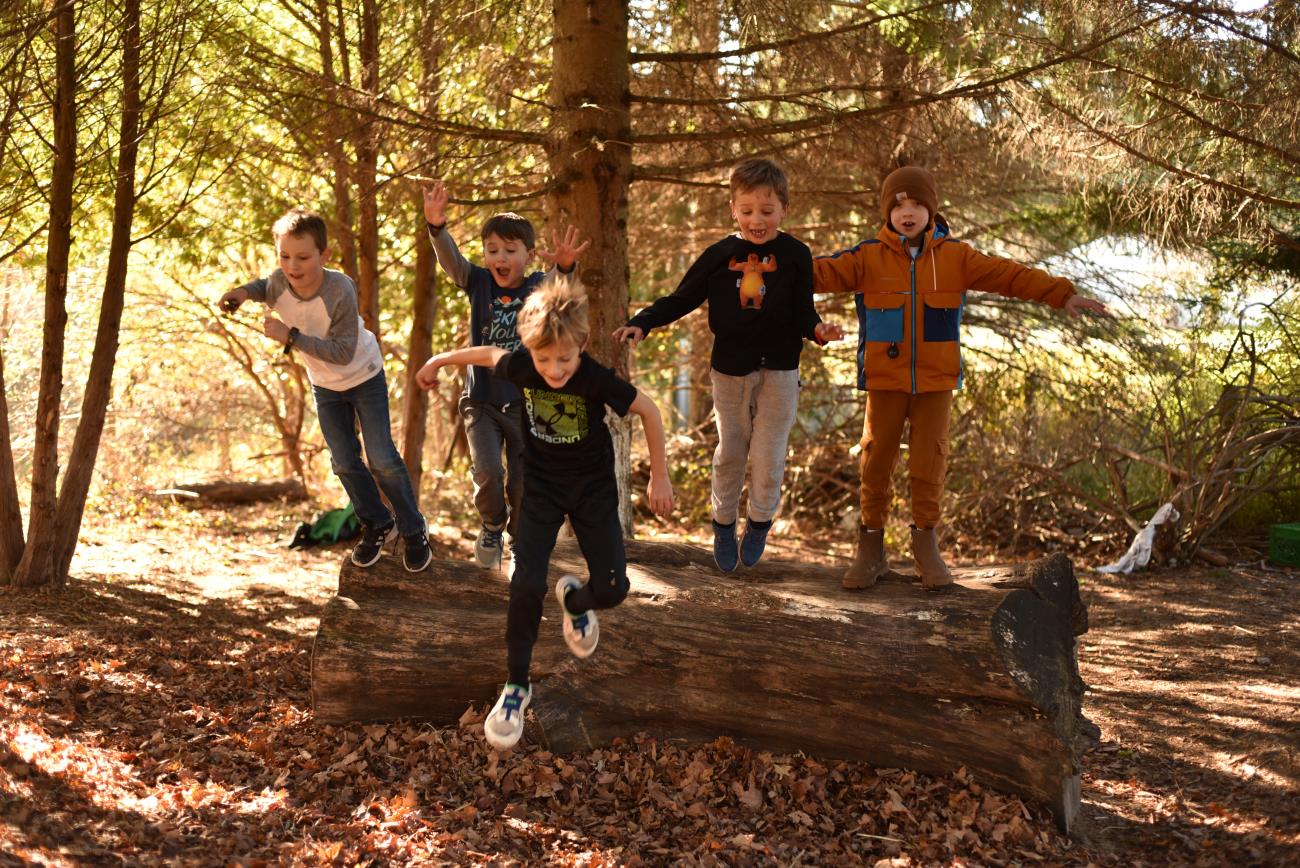
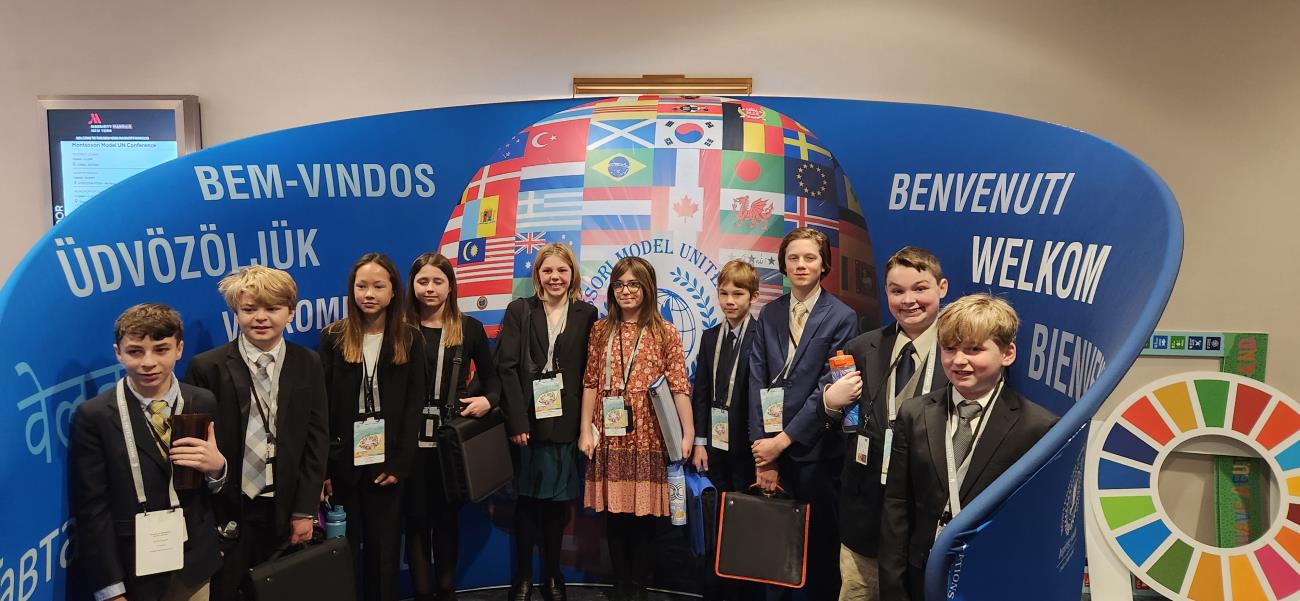
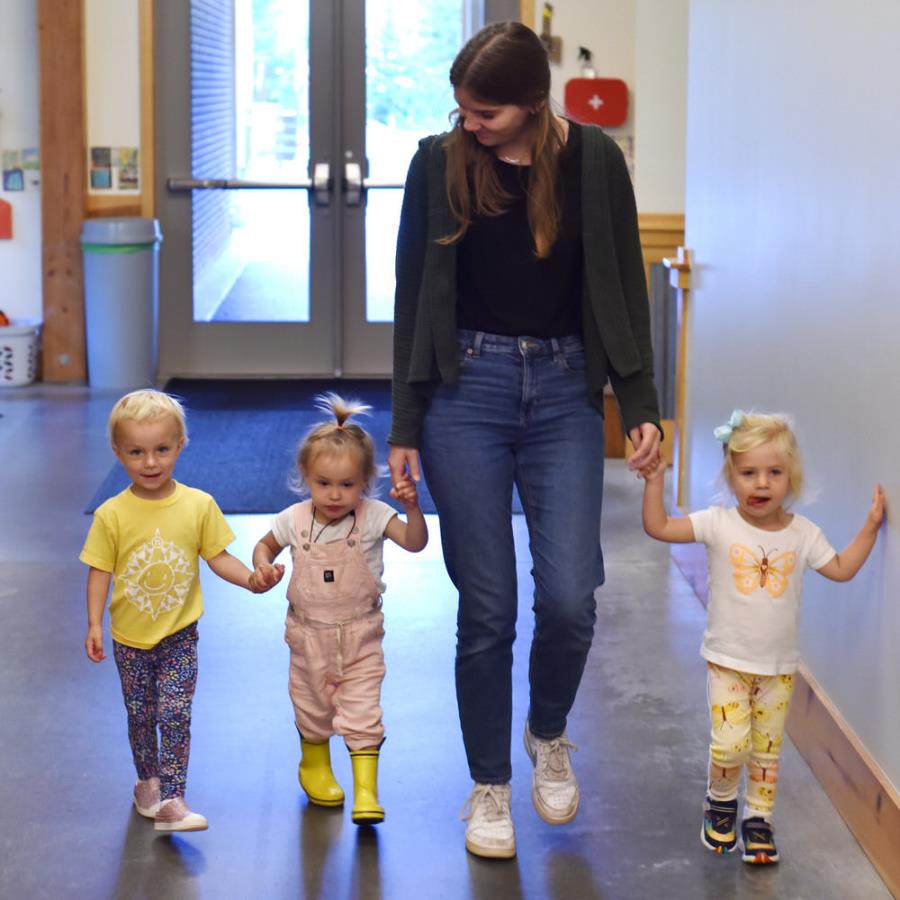
-1.jpg)
-1.jpg)
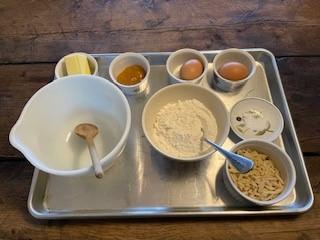
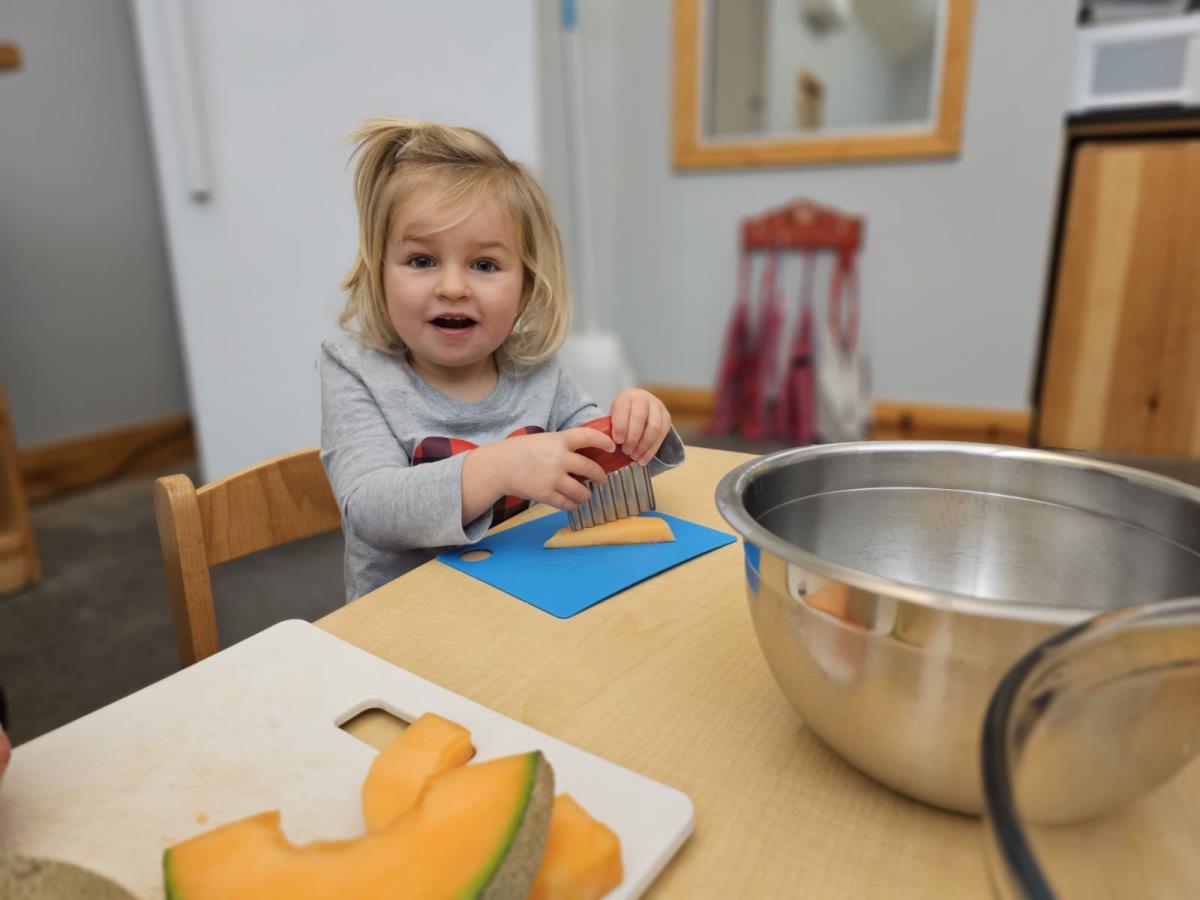
-1.jpg)
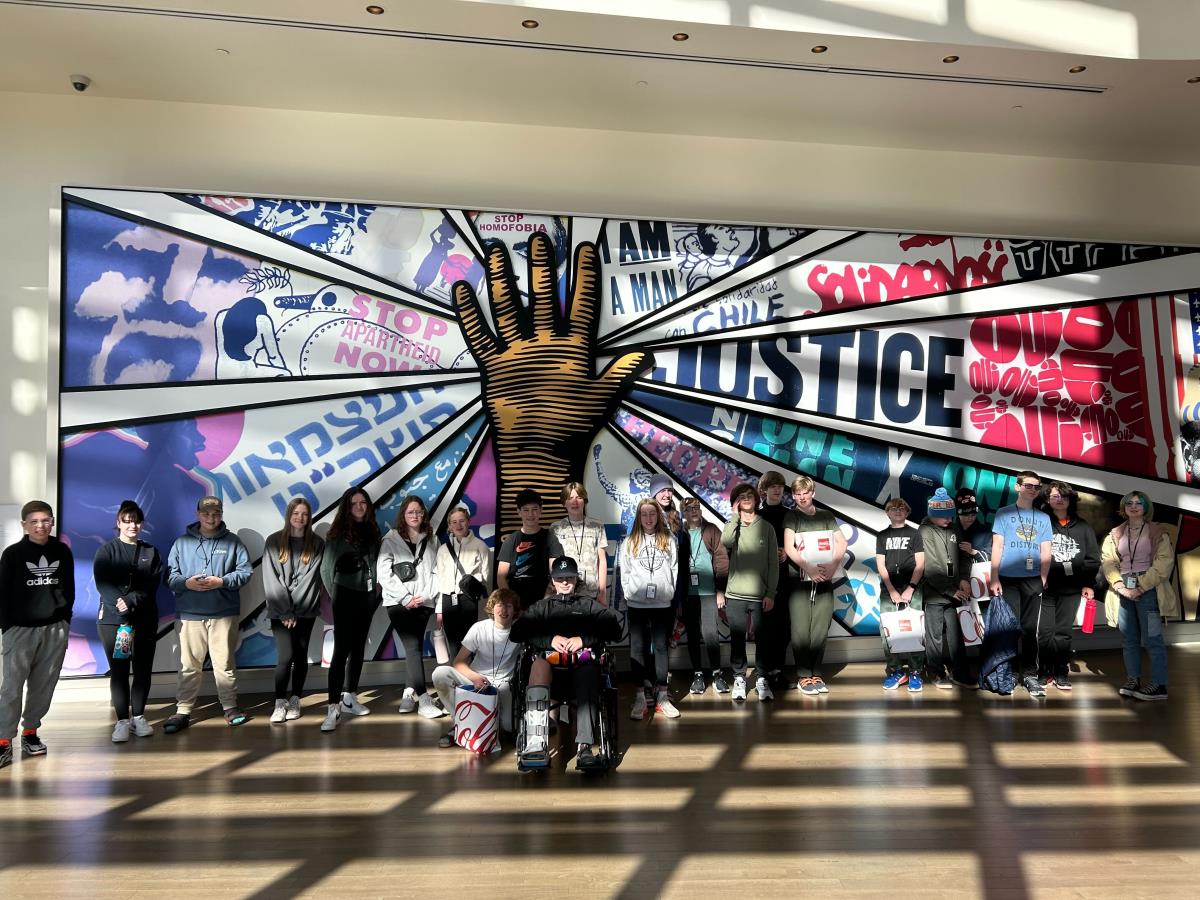
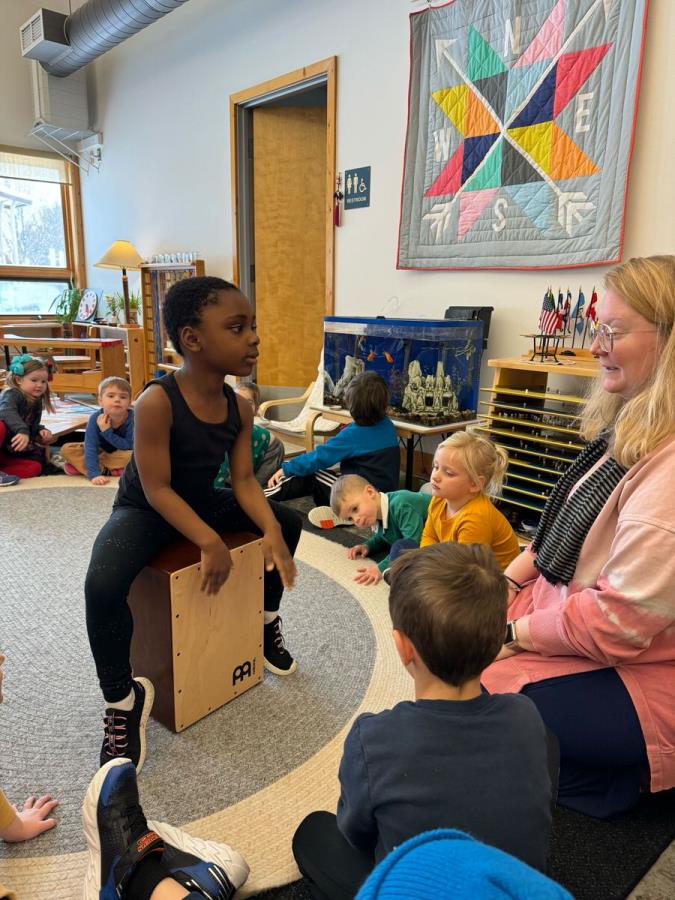
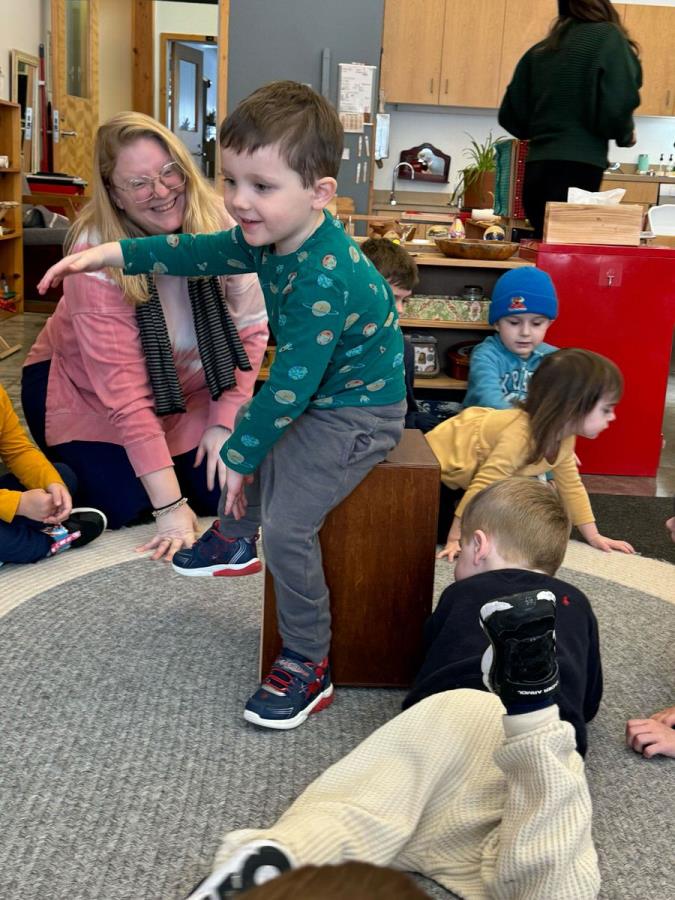
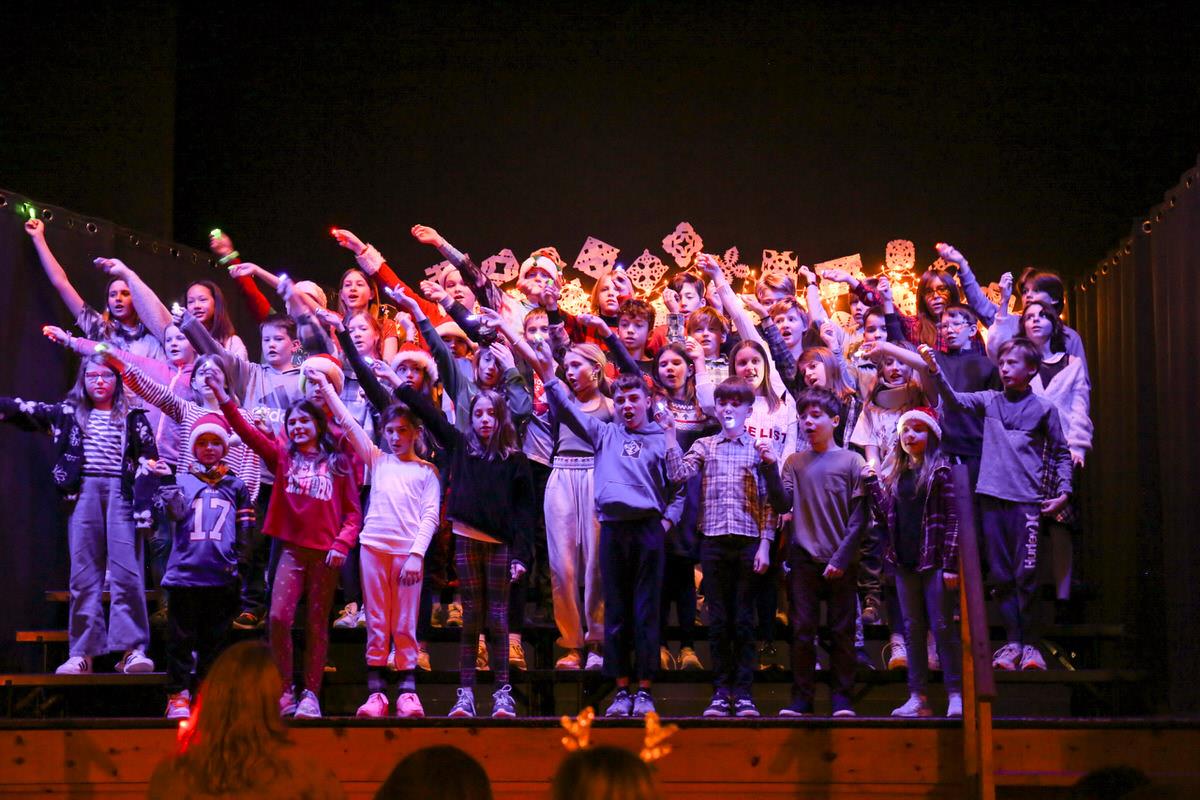
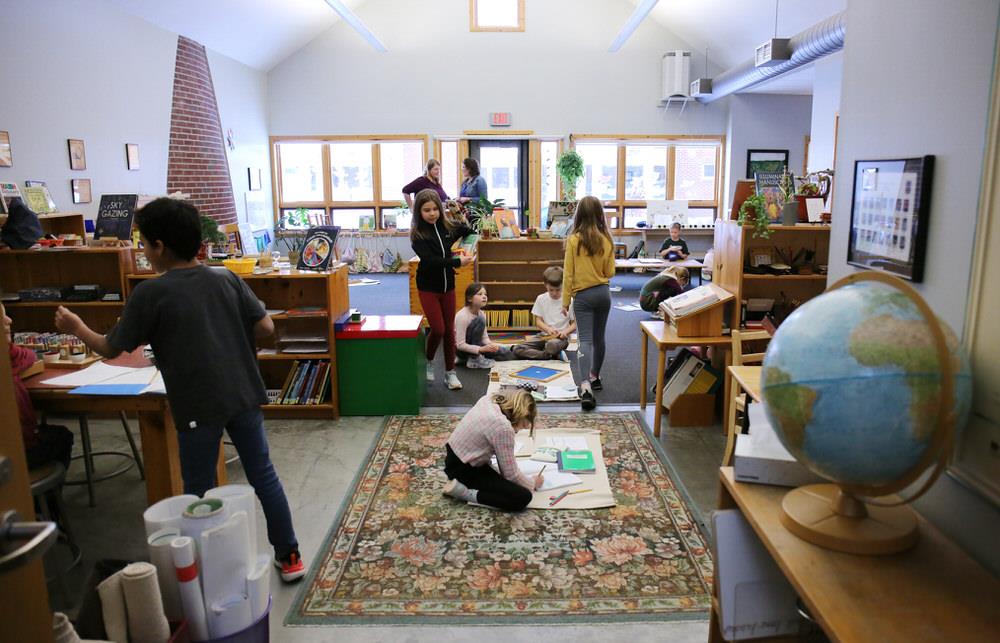
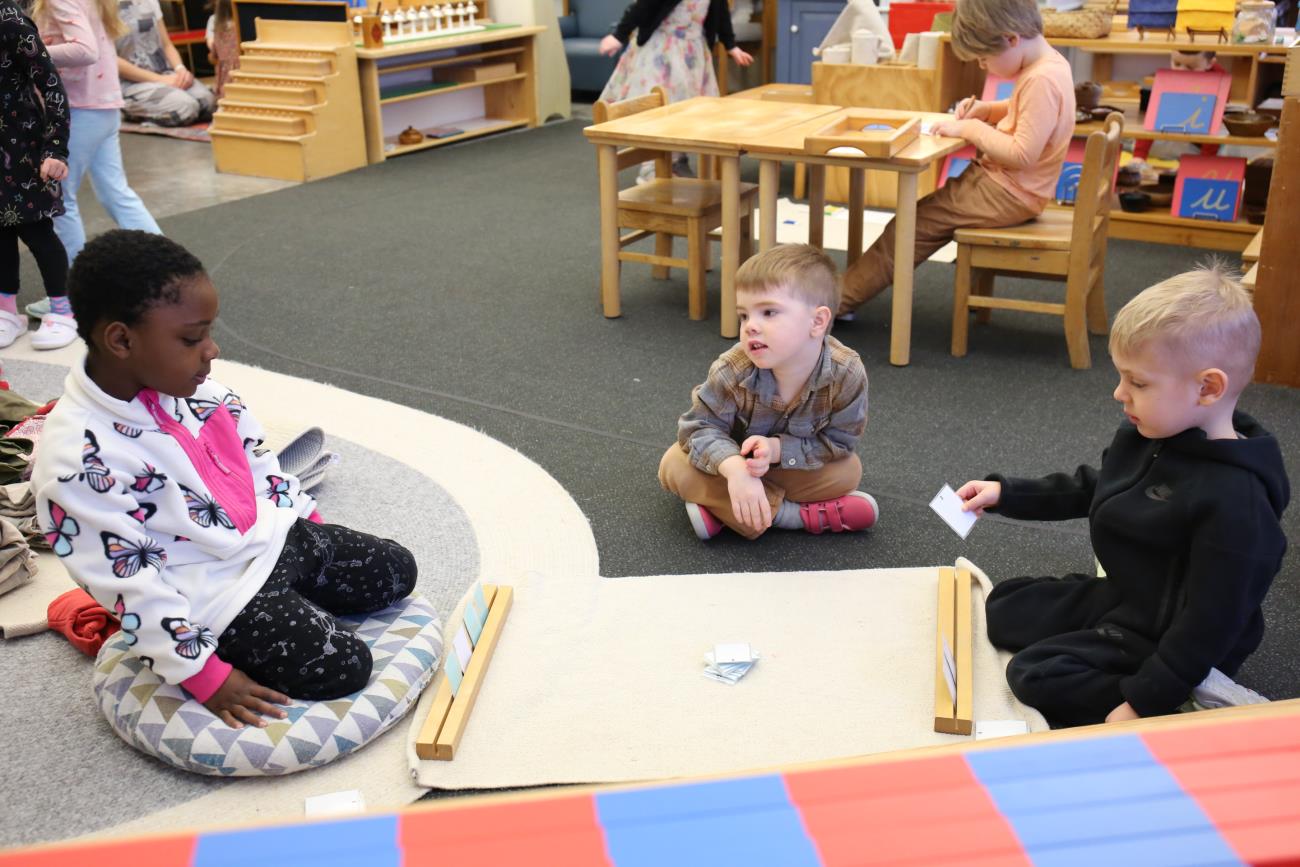
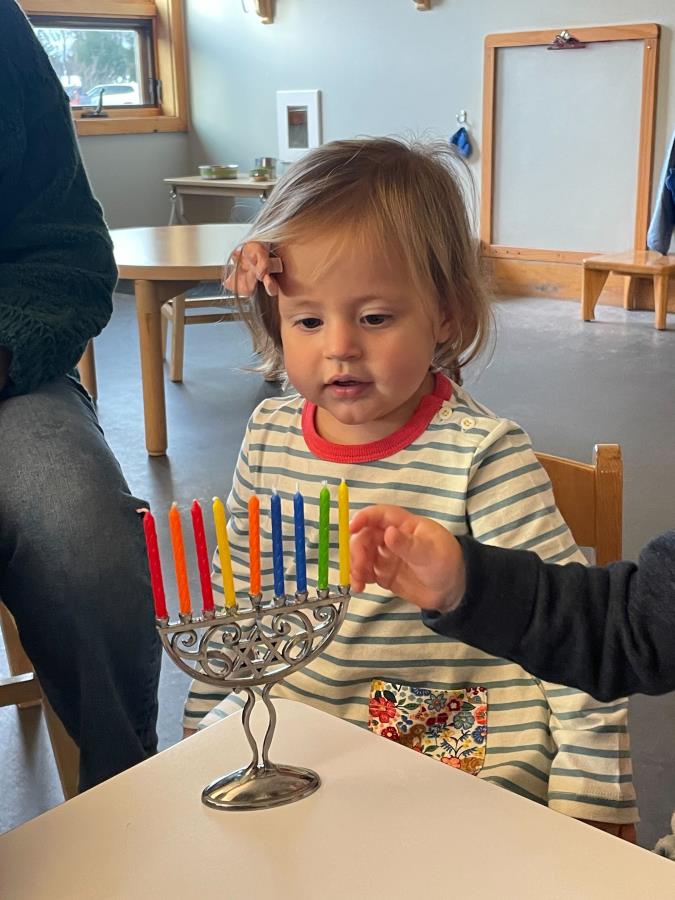

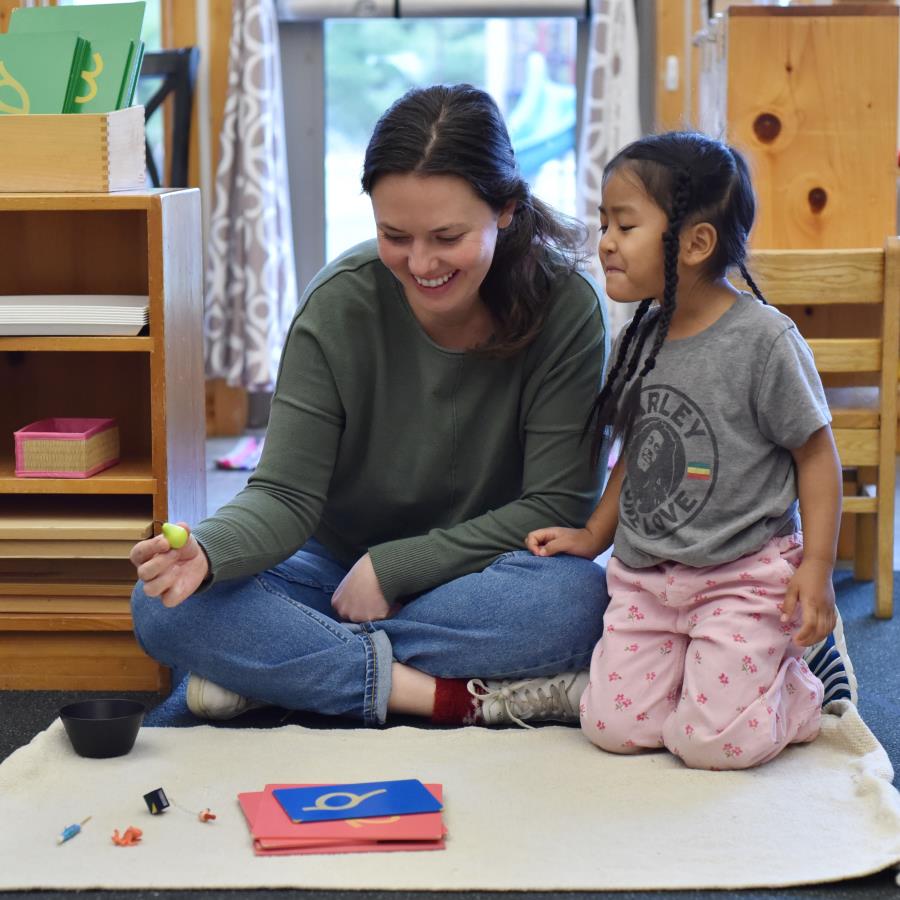
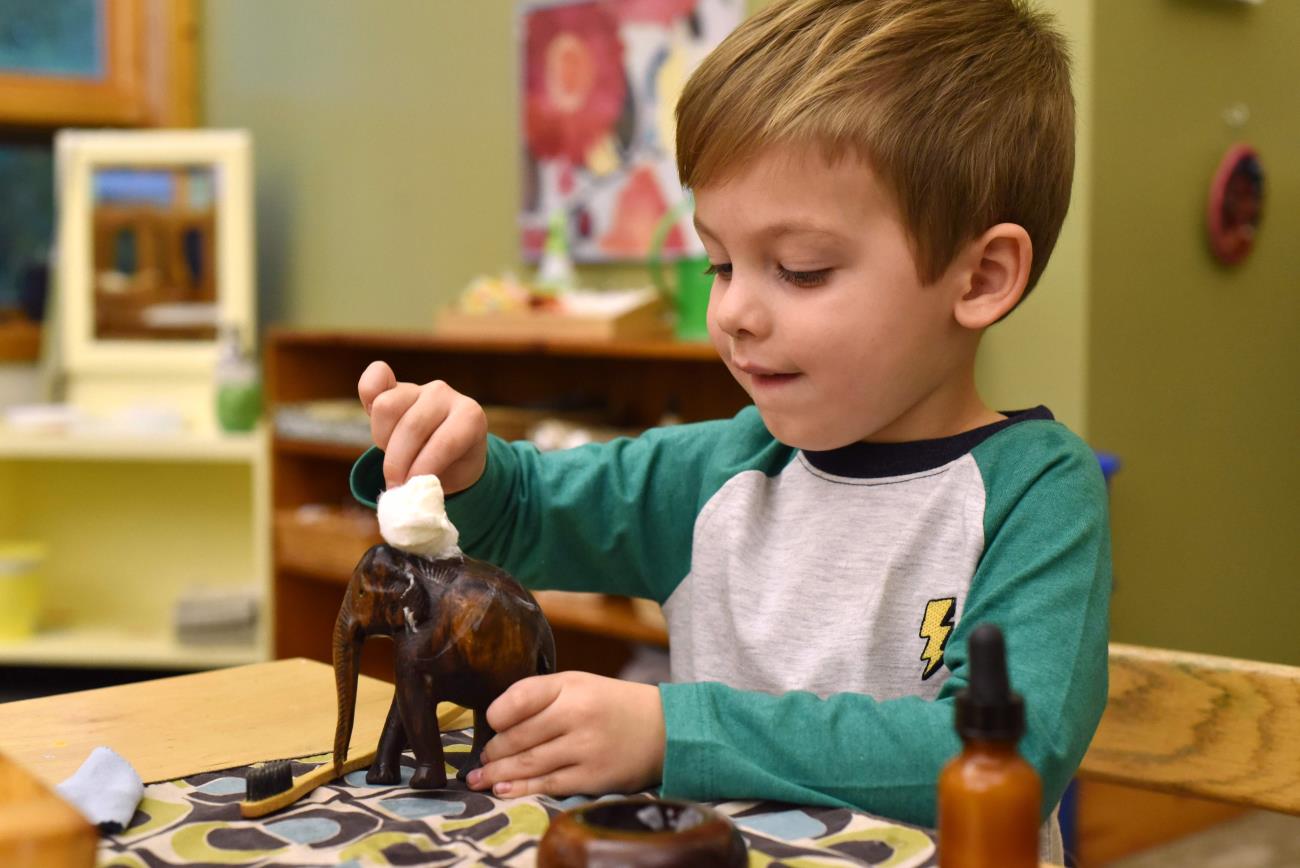

-1.jpg)
-1.jpg)
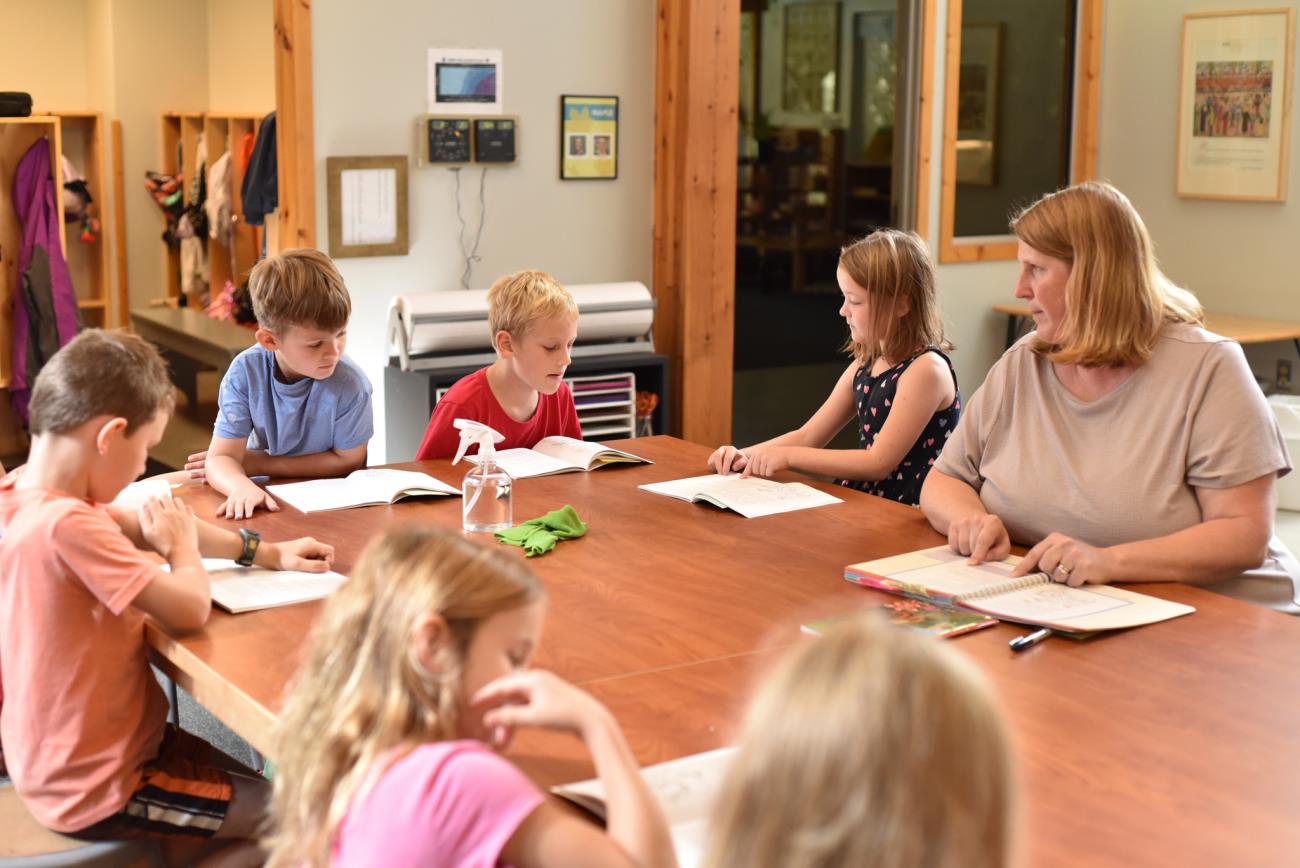
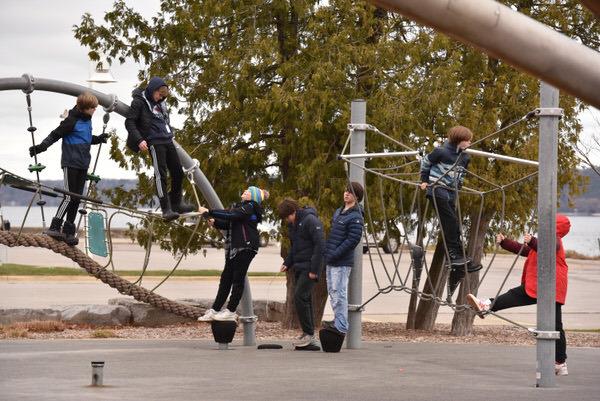
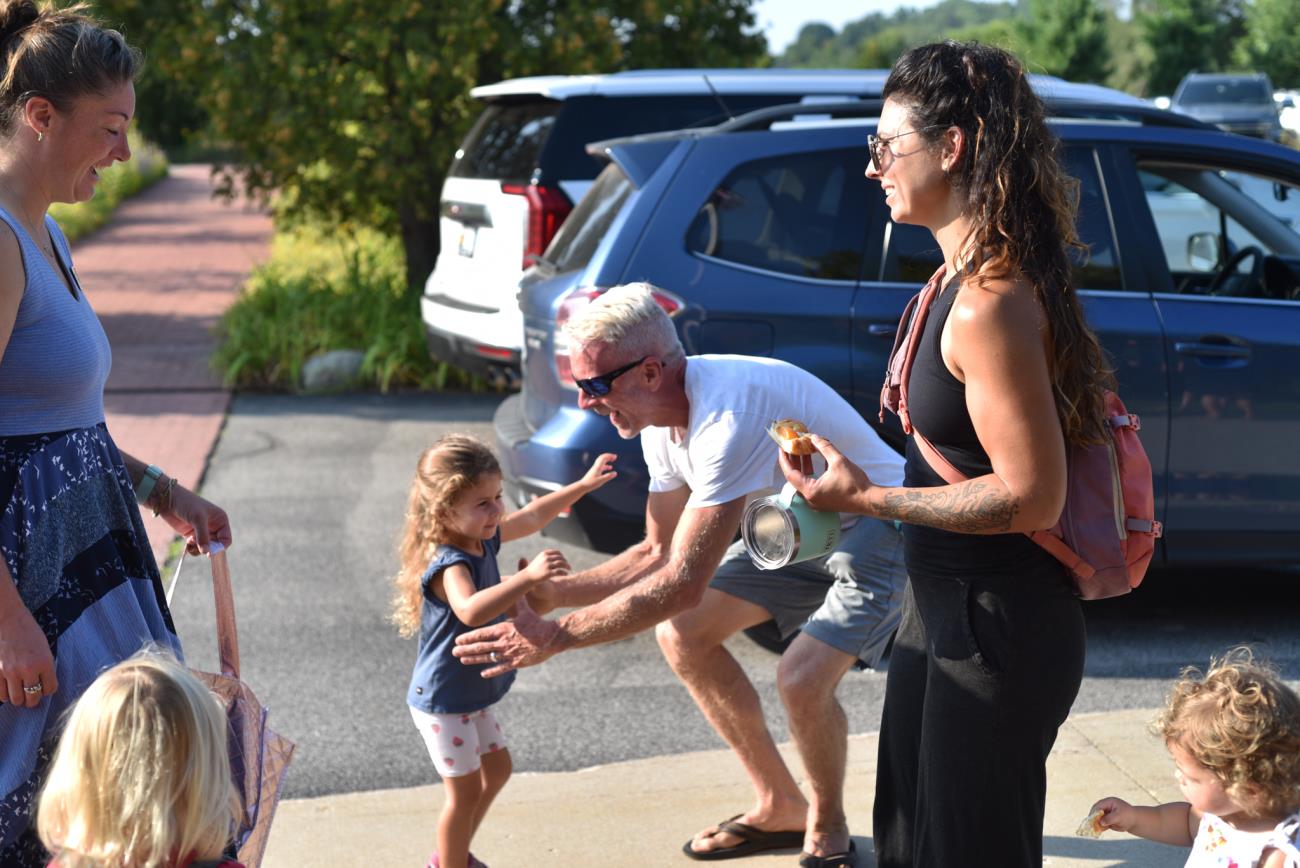
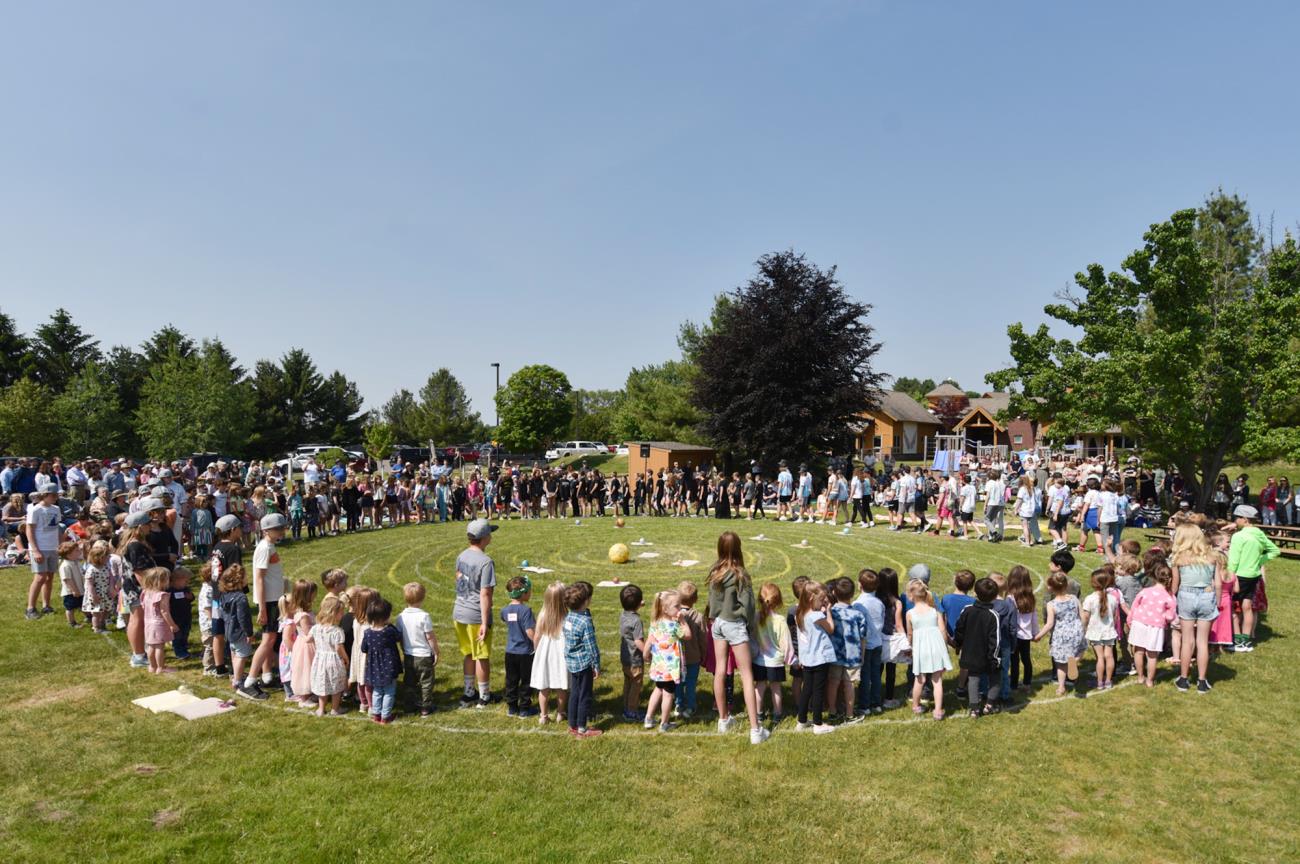
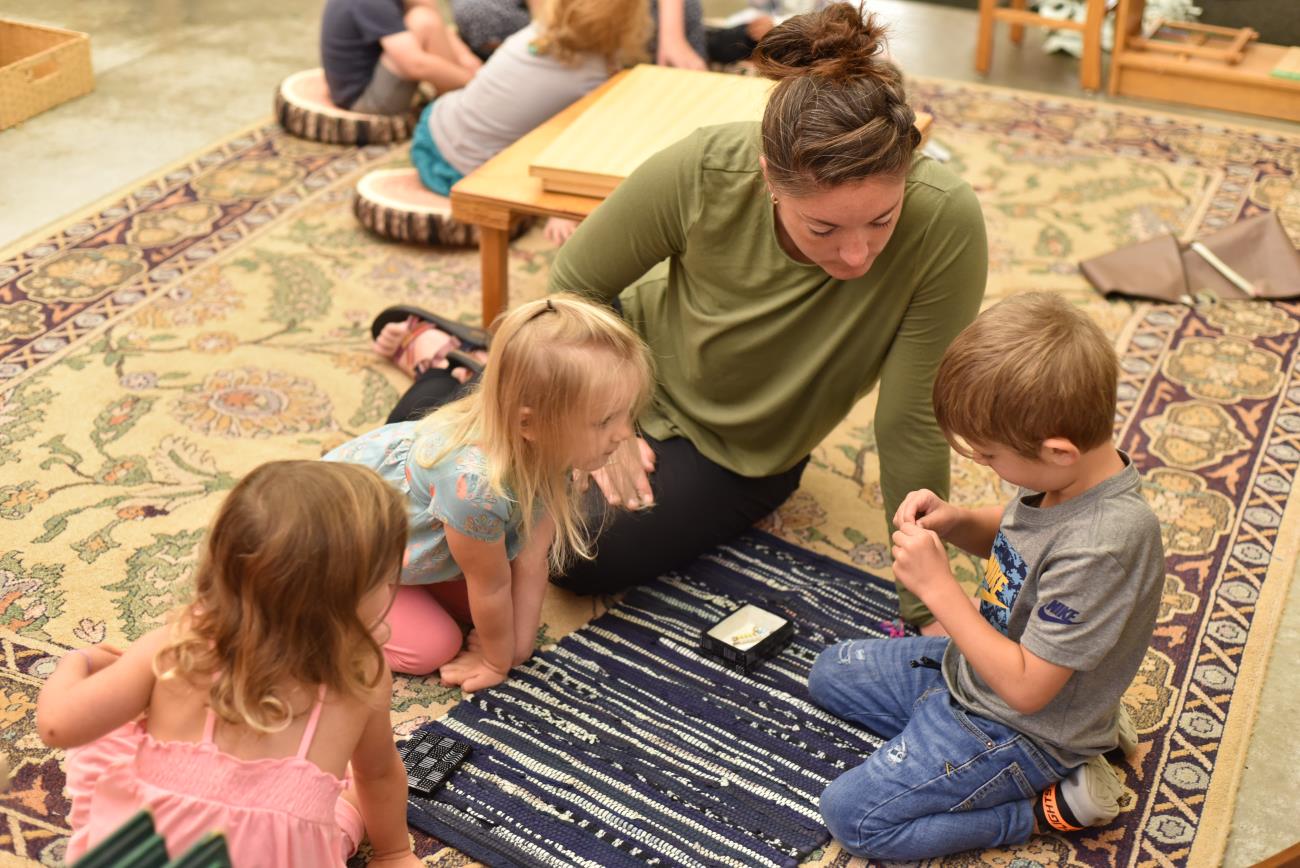
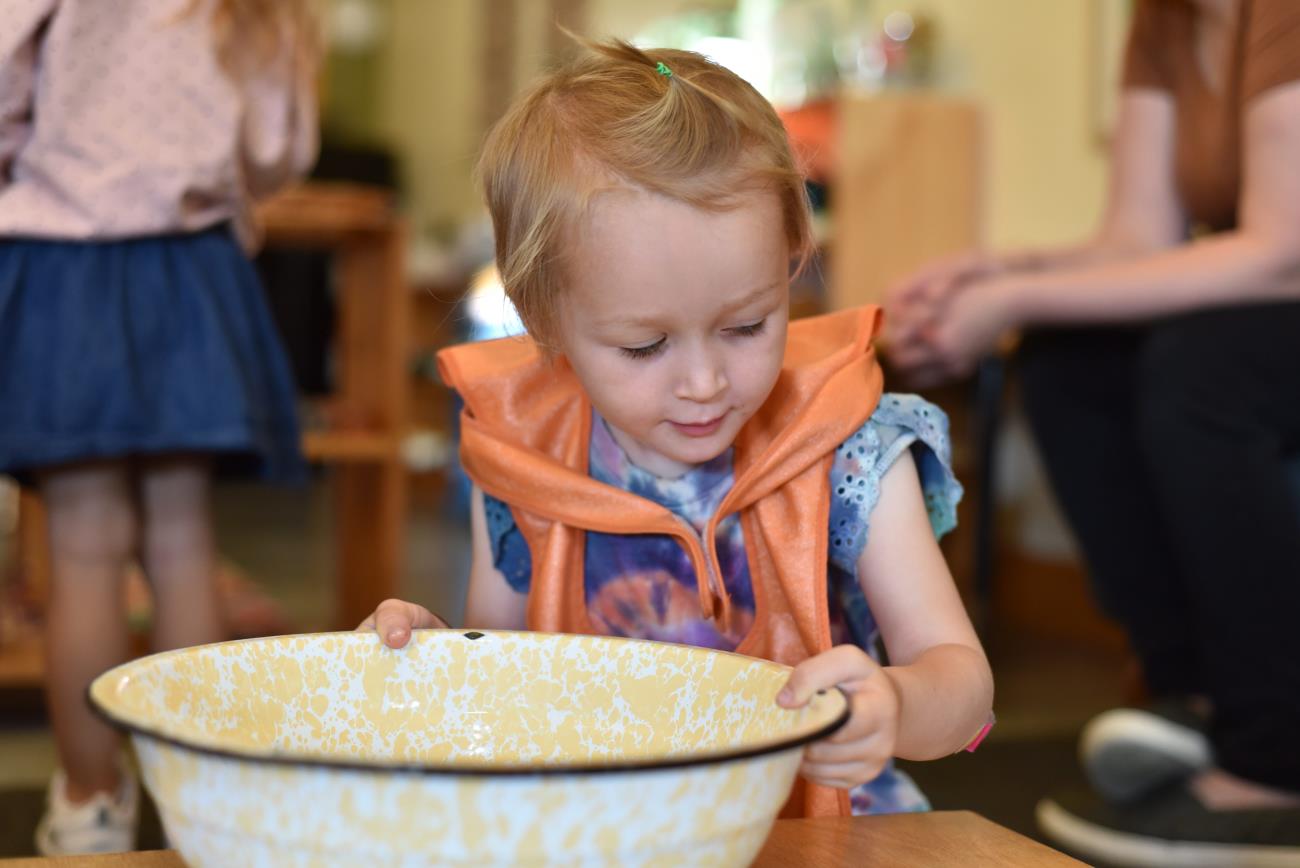
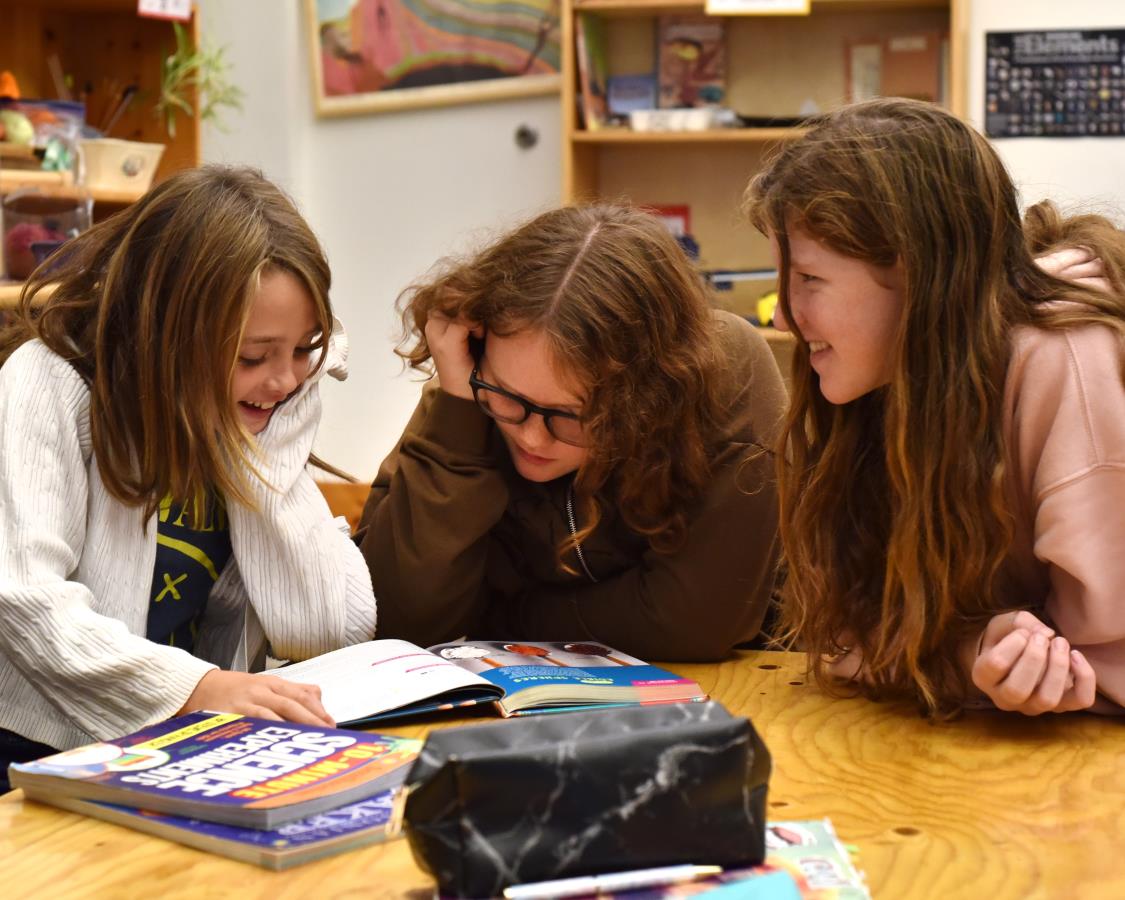
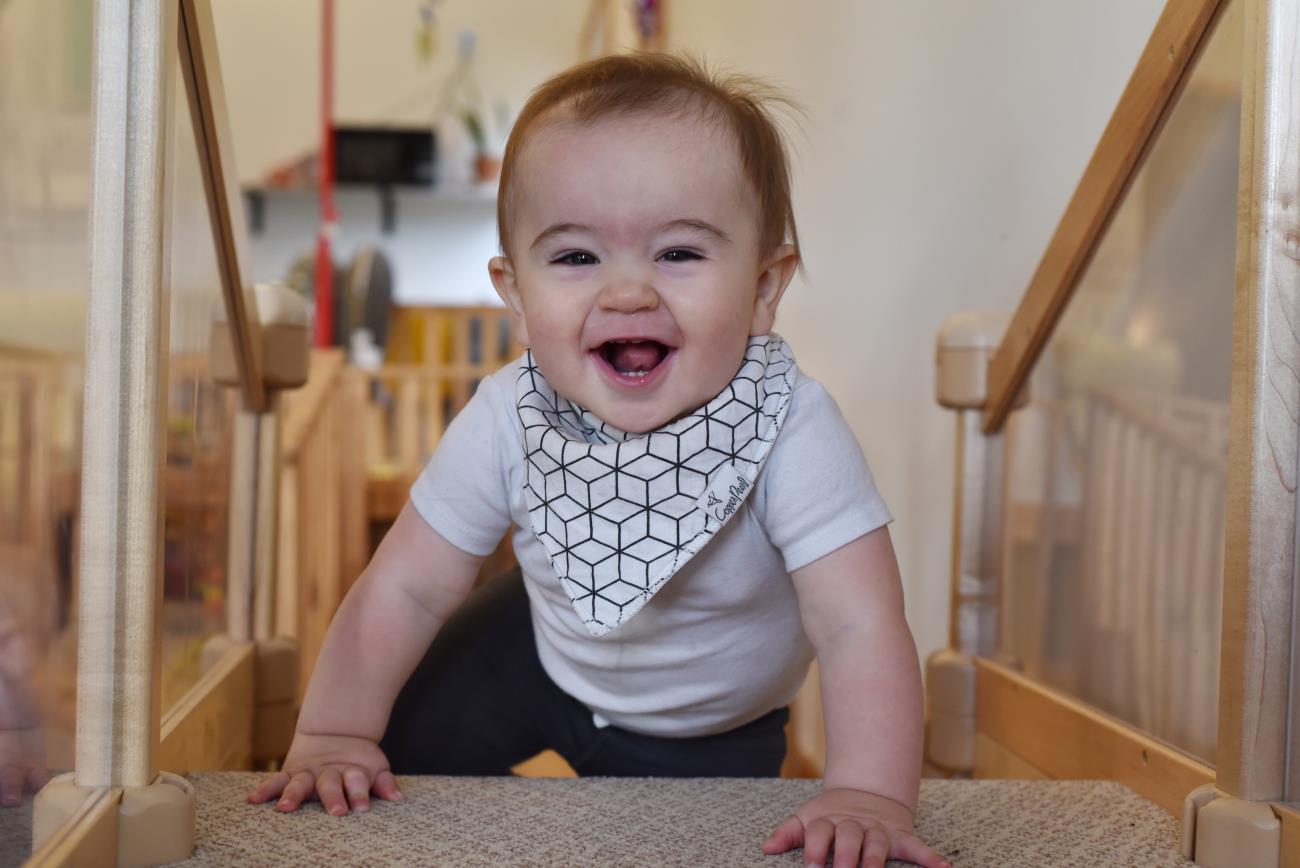
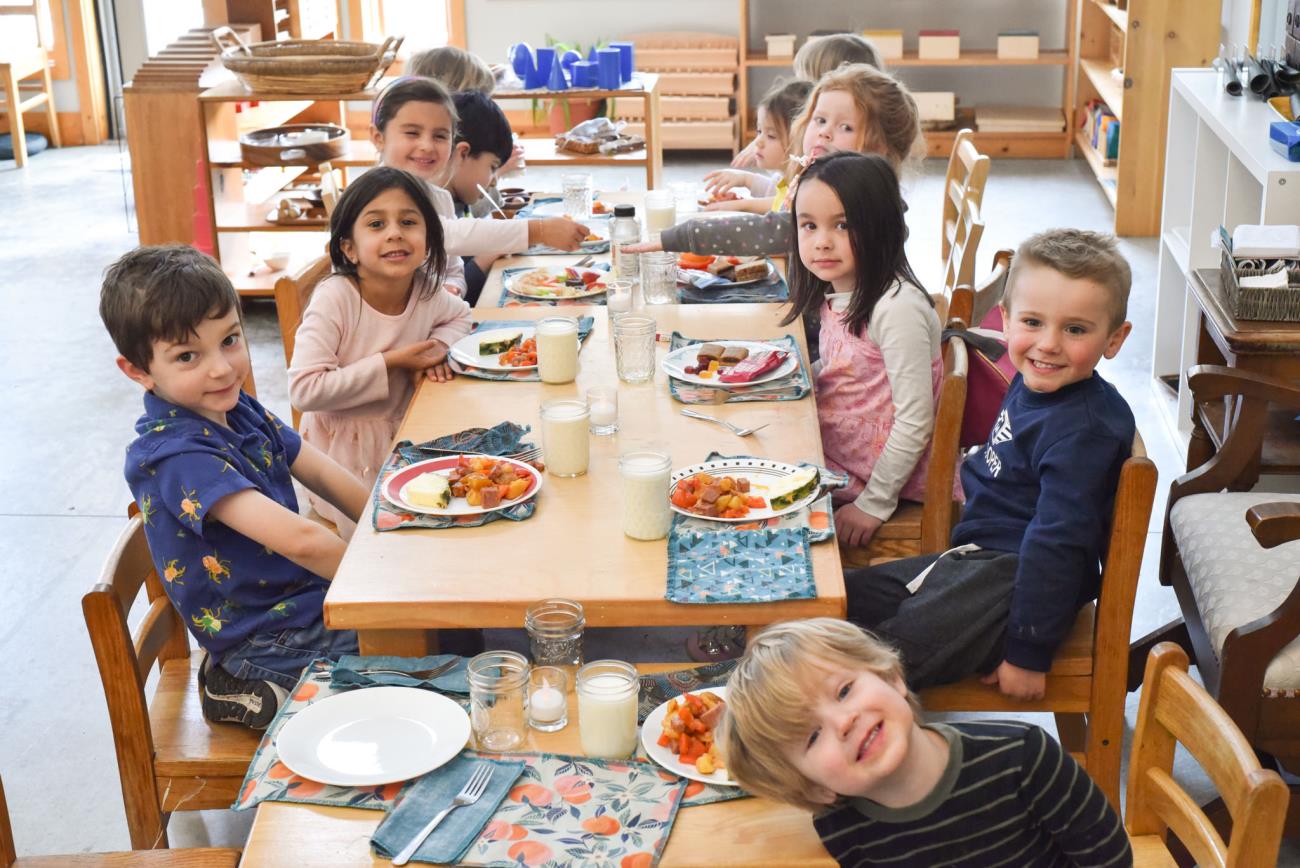
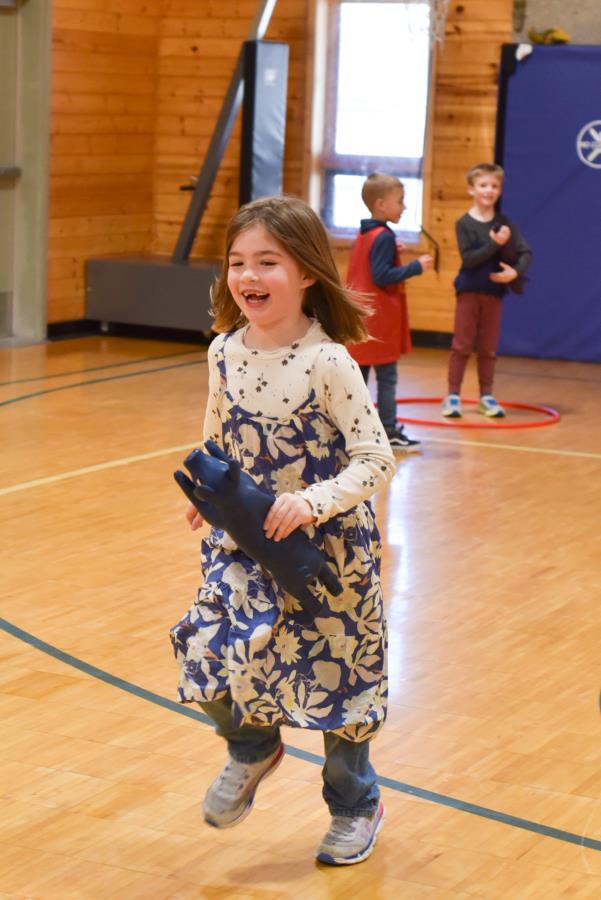
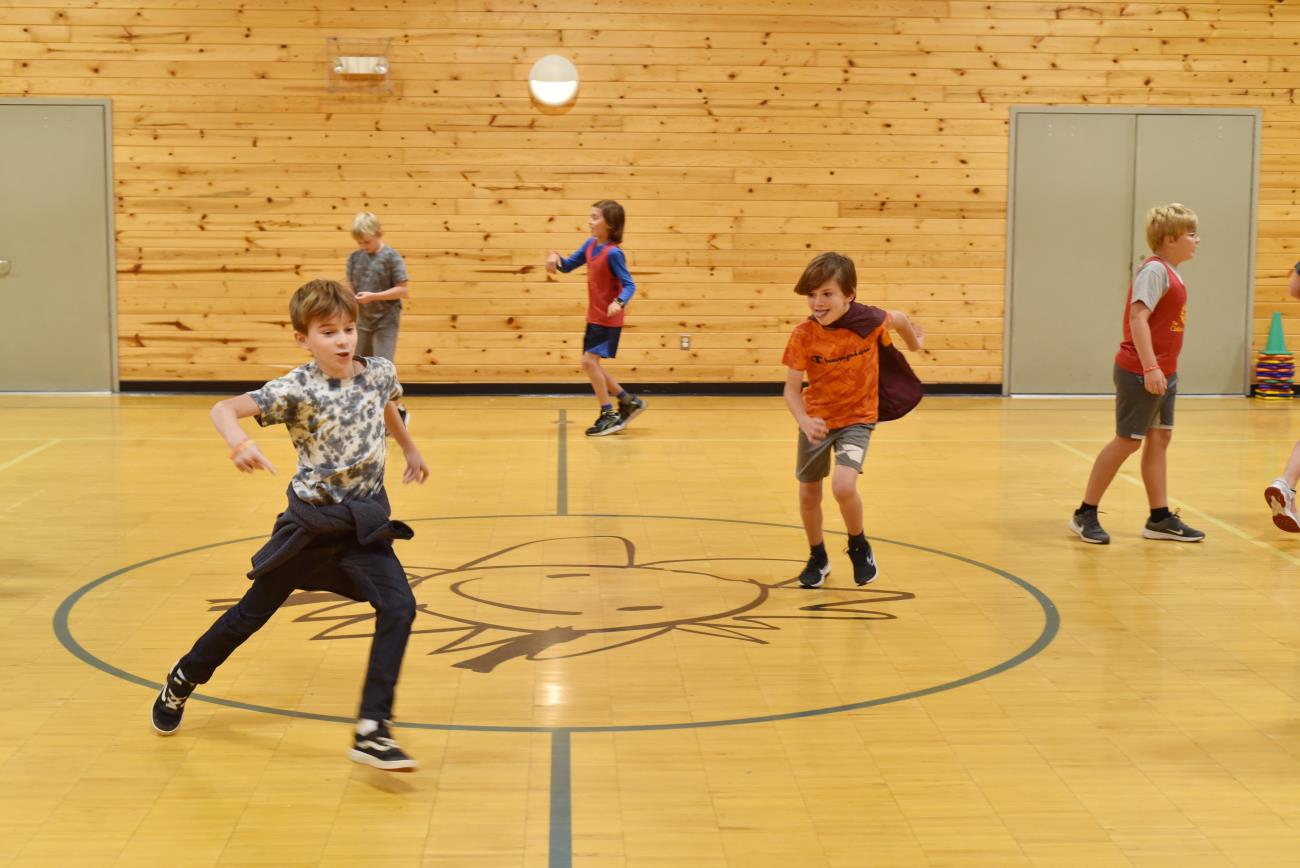
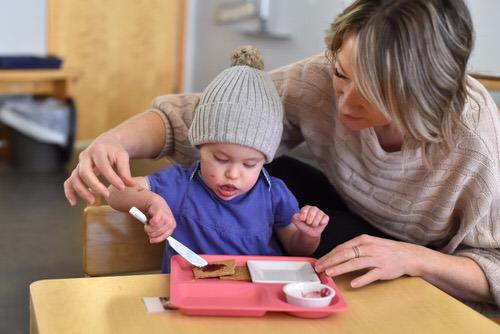
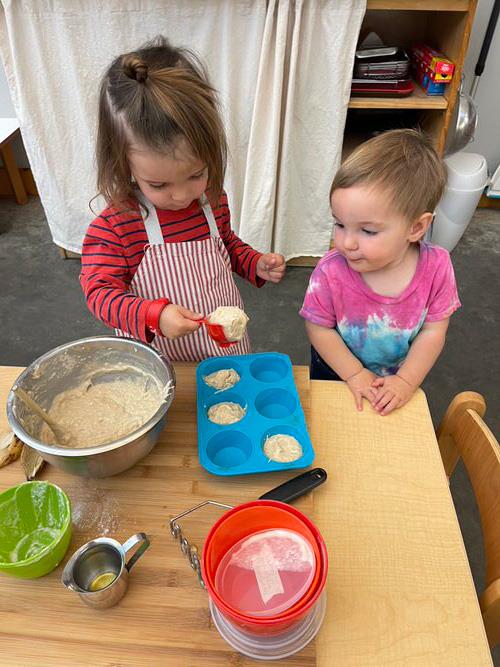
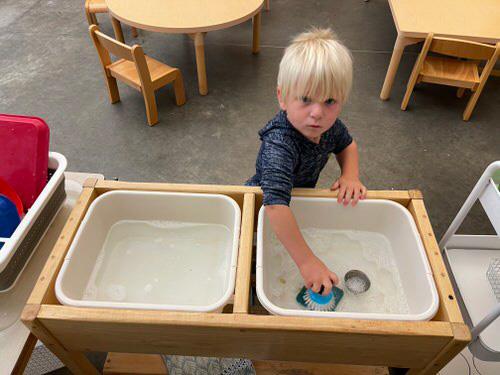
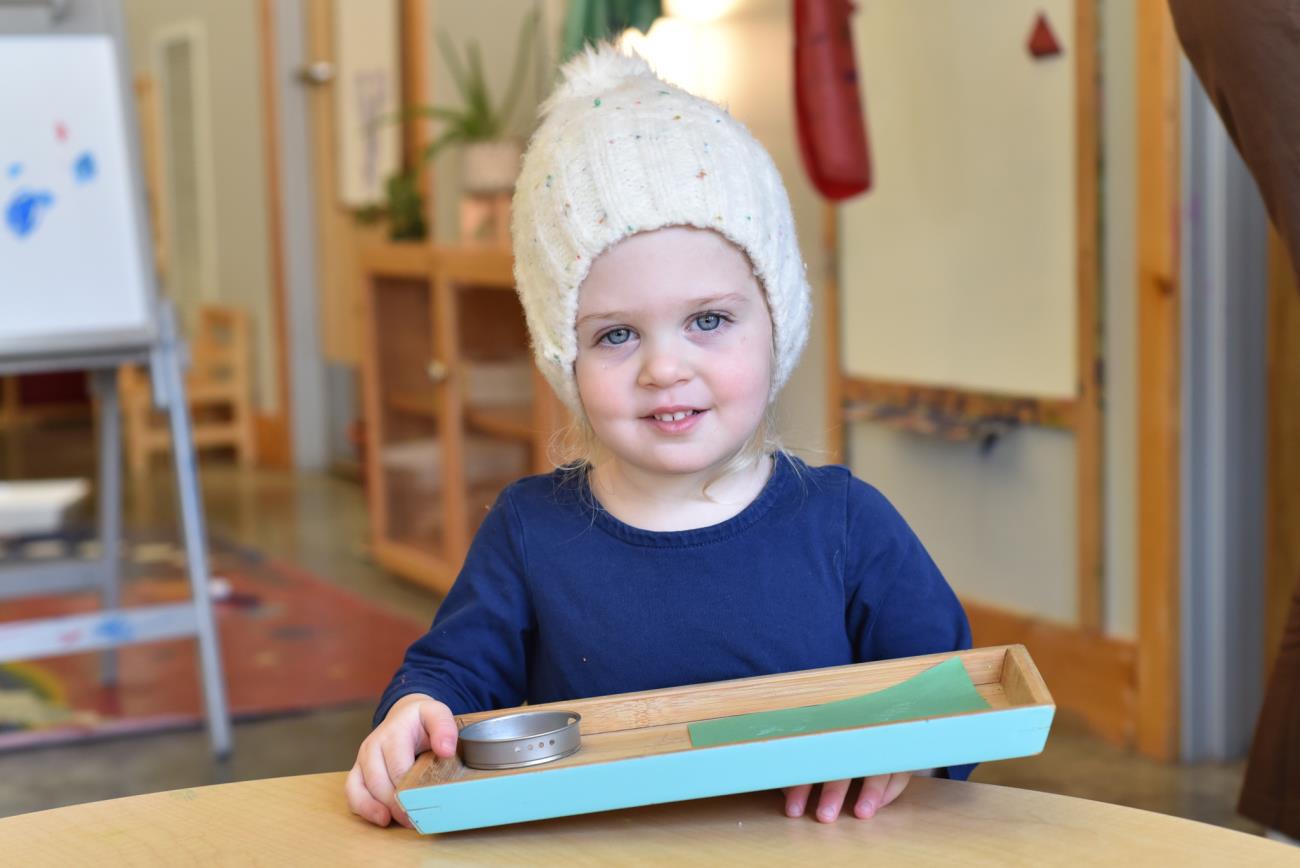
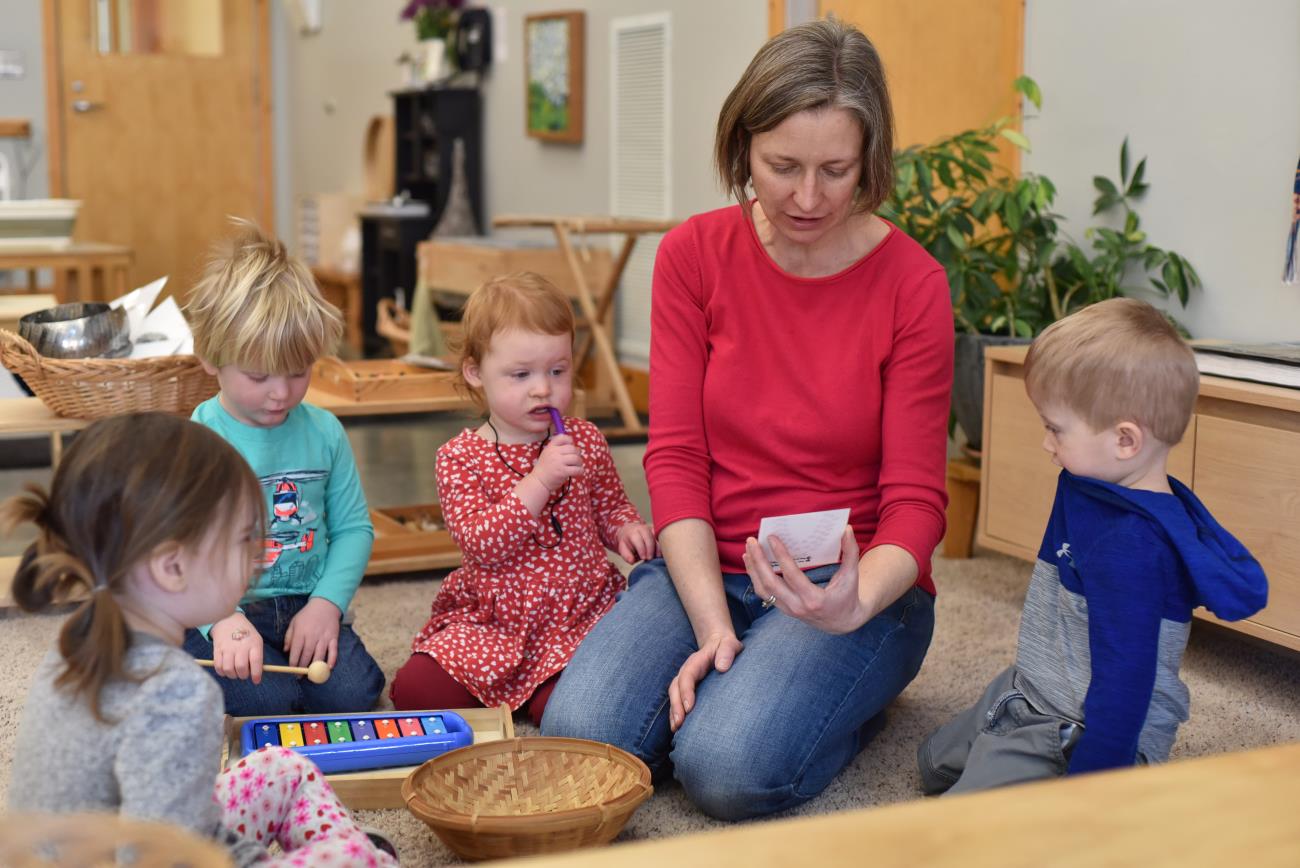
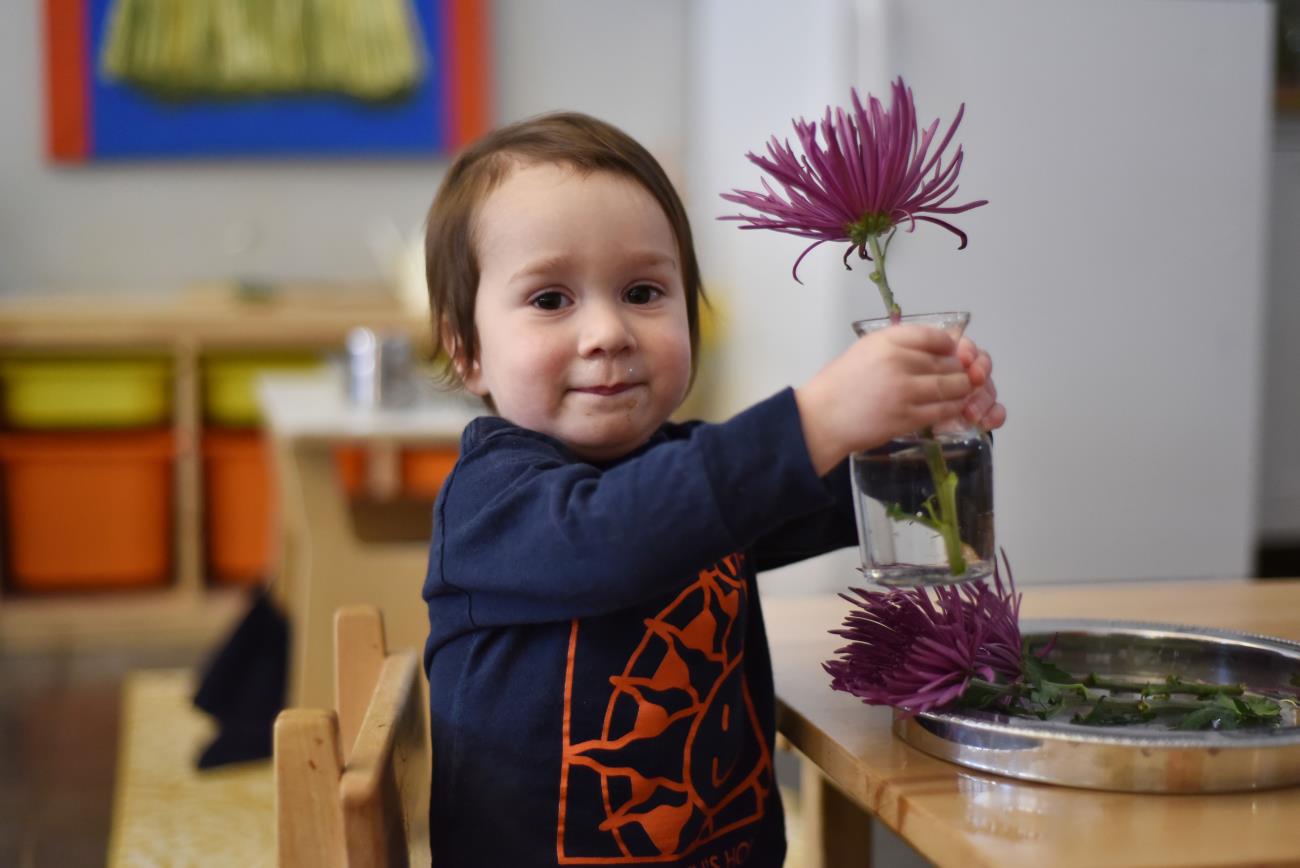
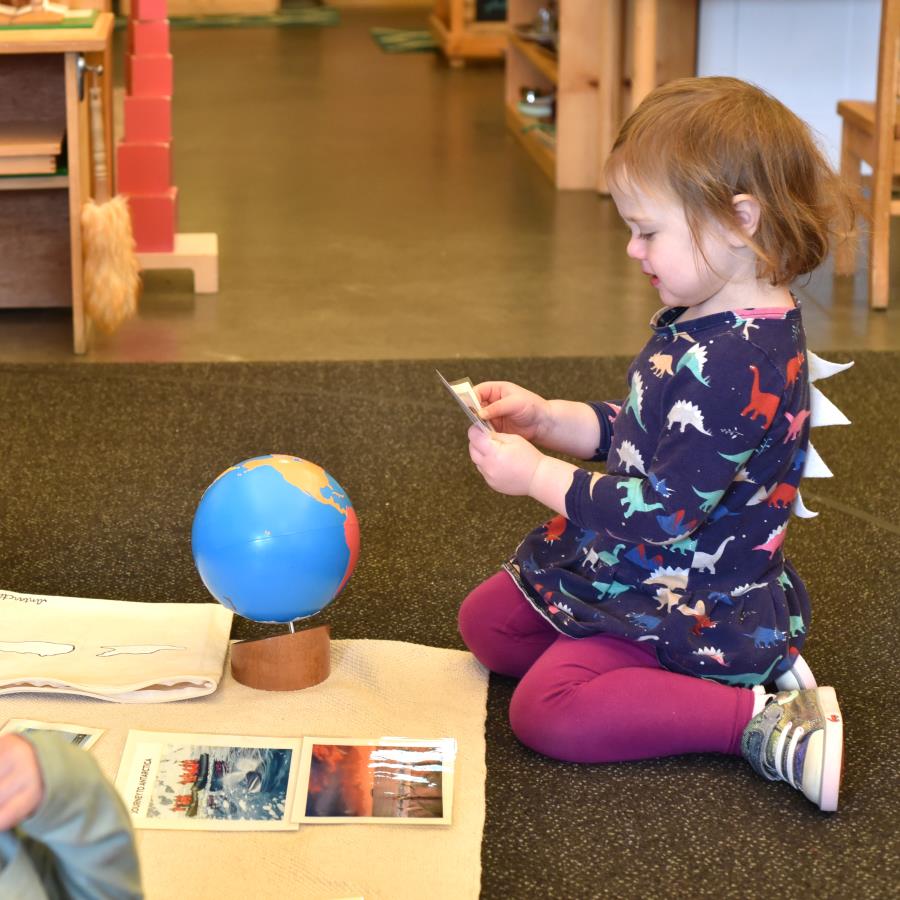
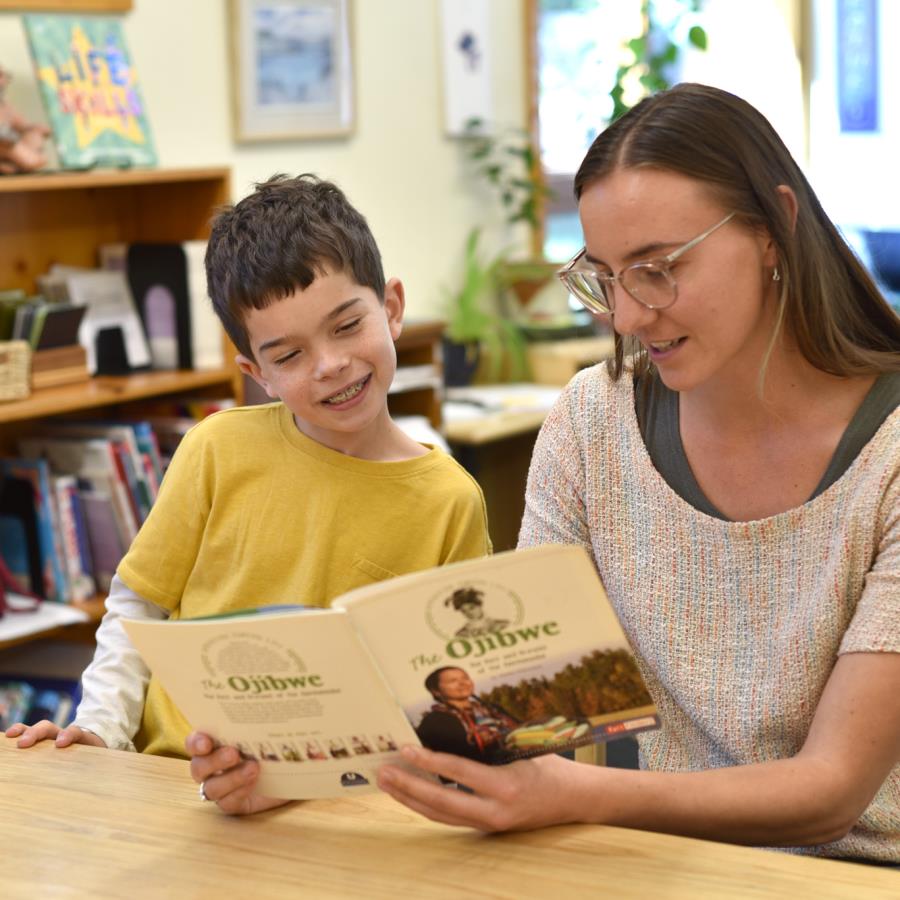
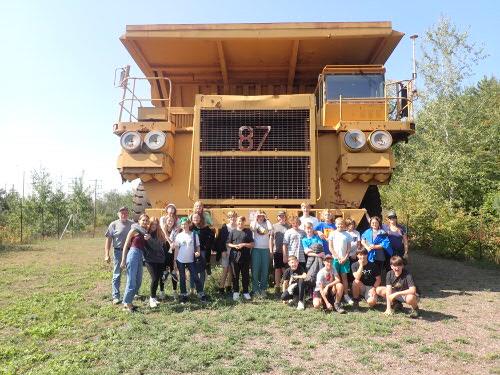
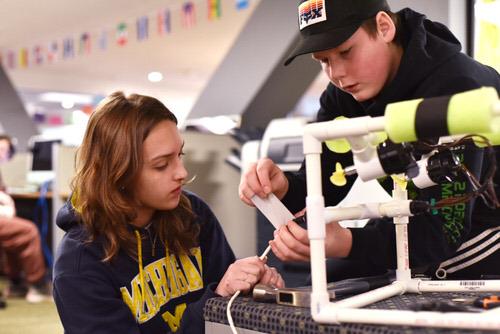
.jpg)
